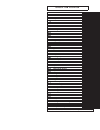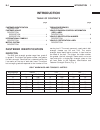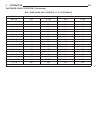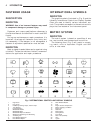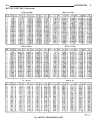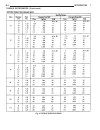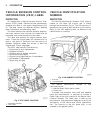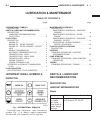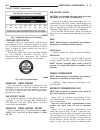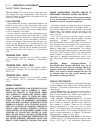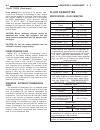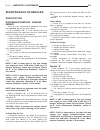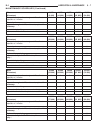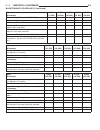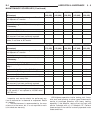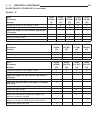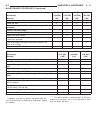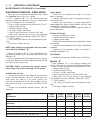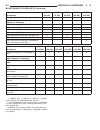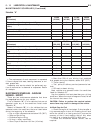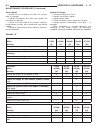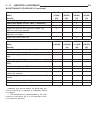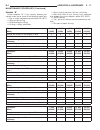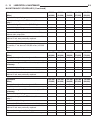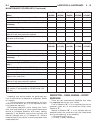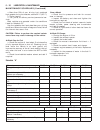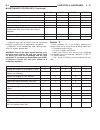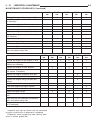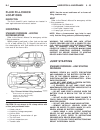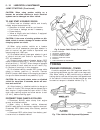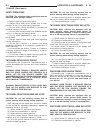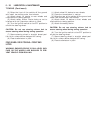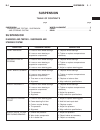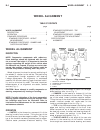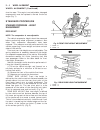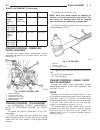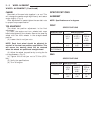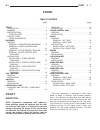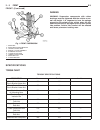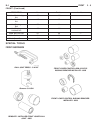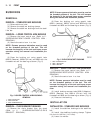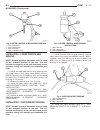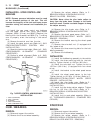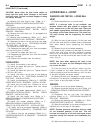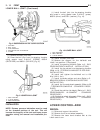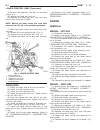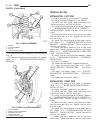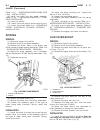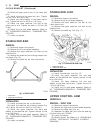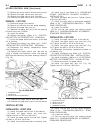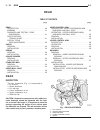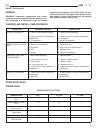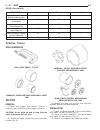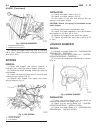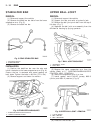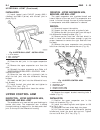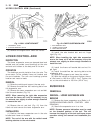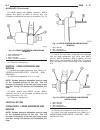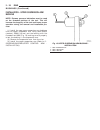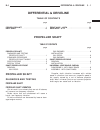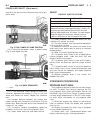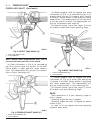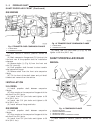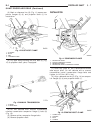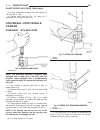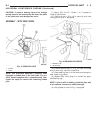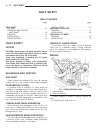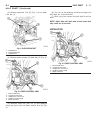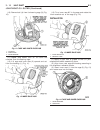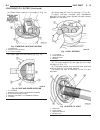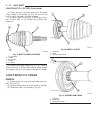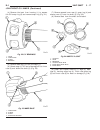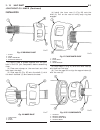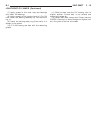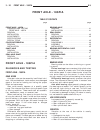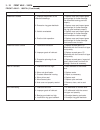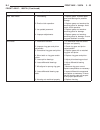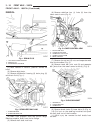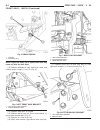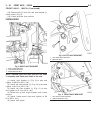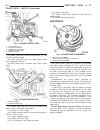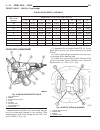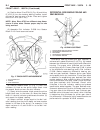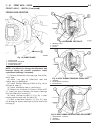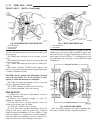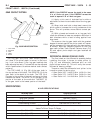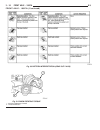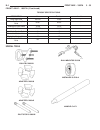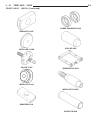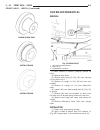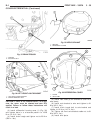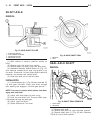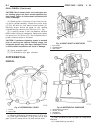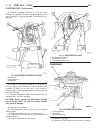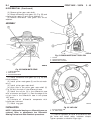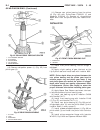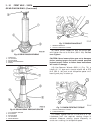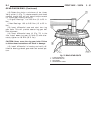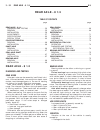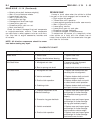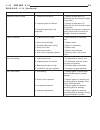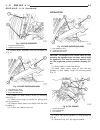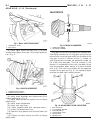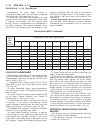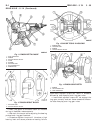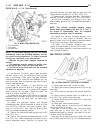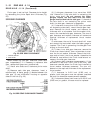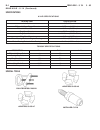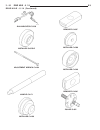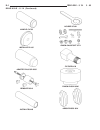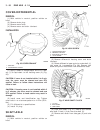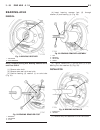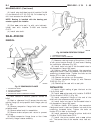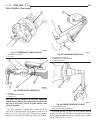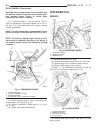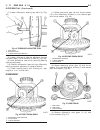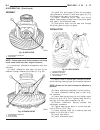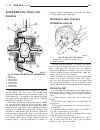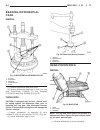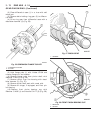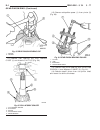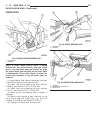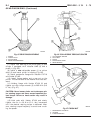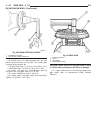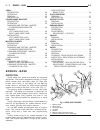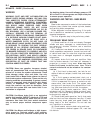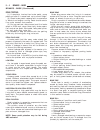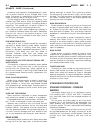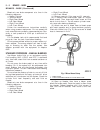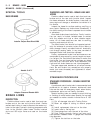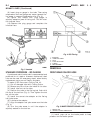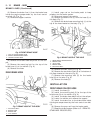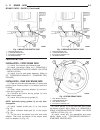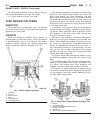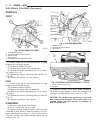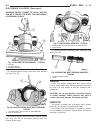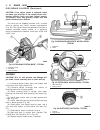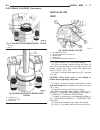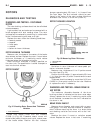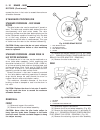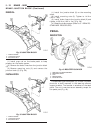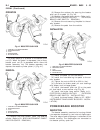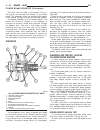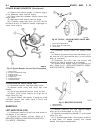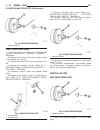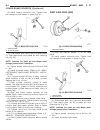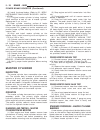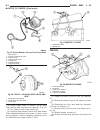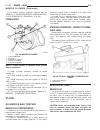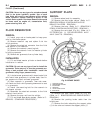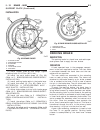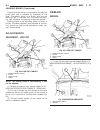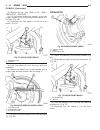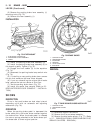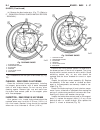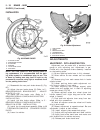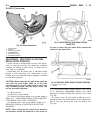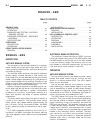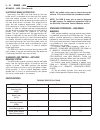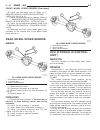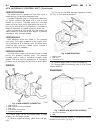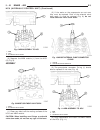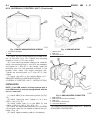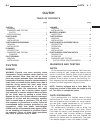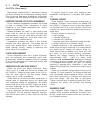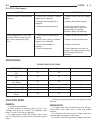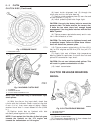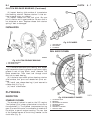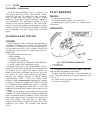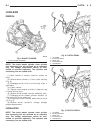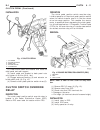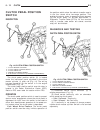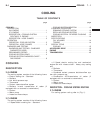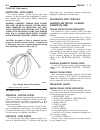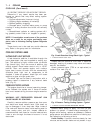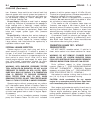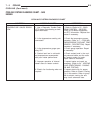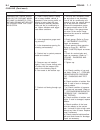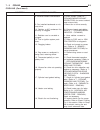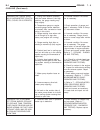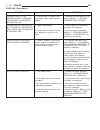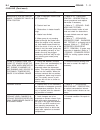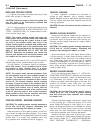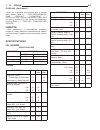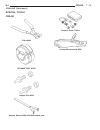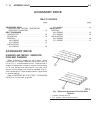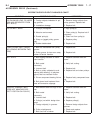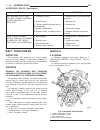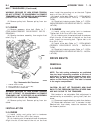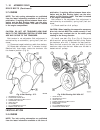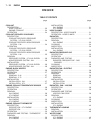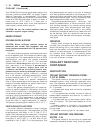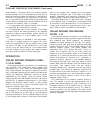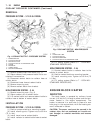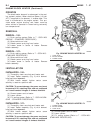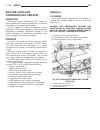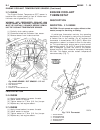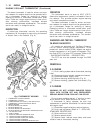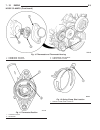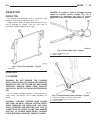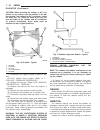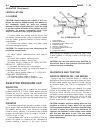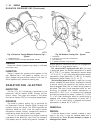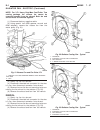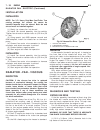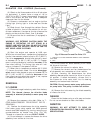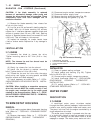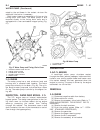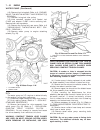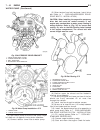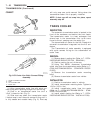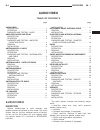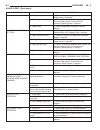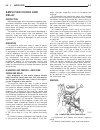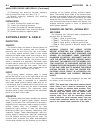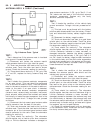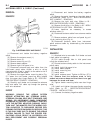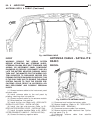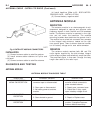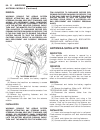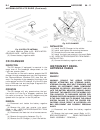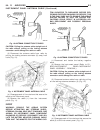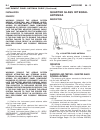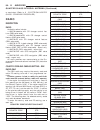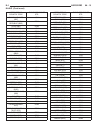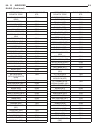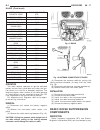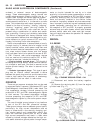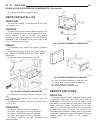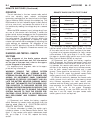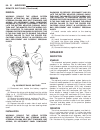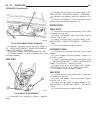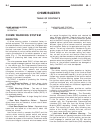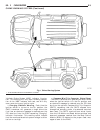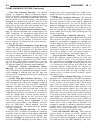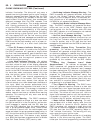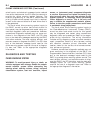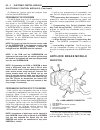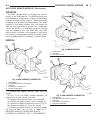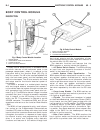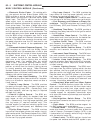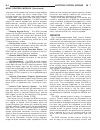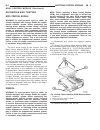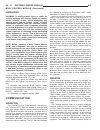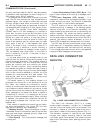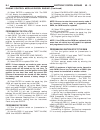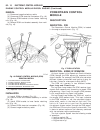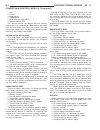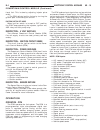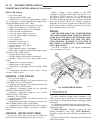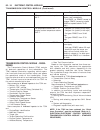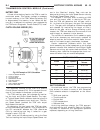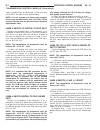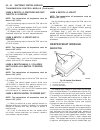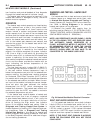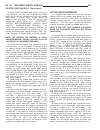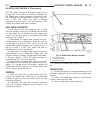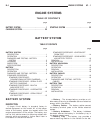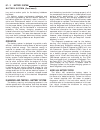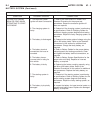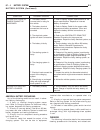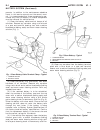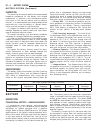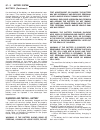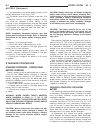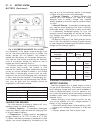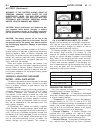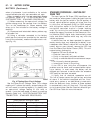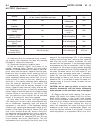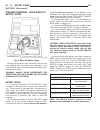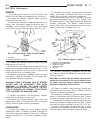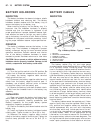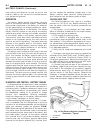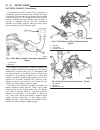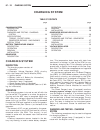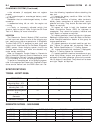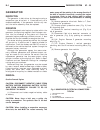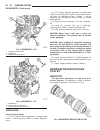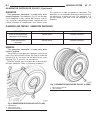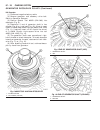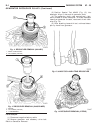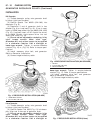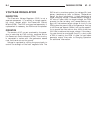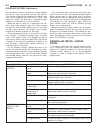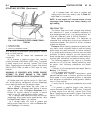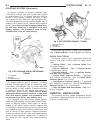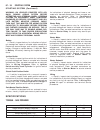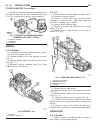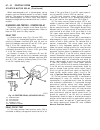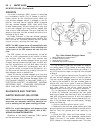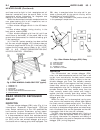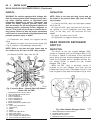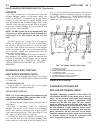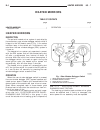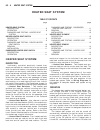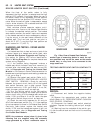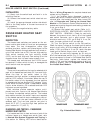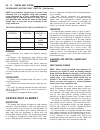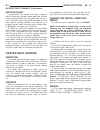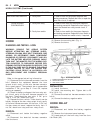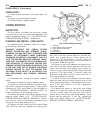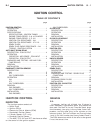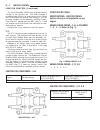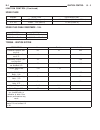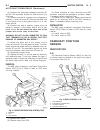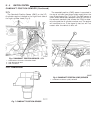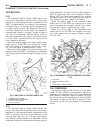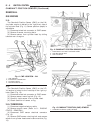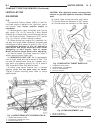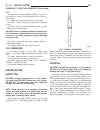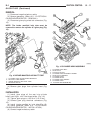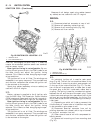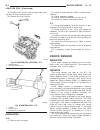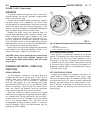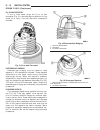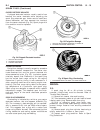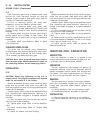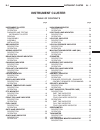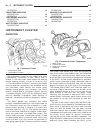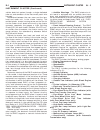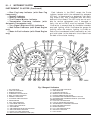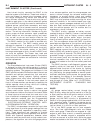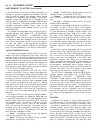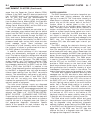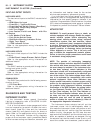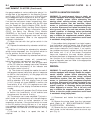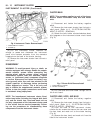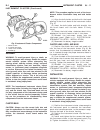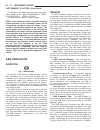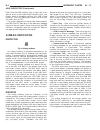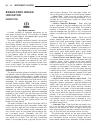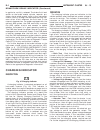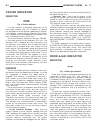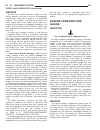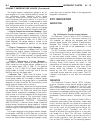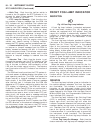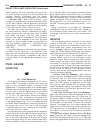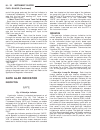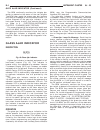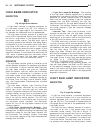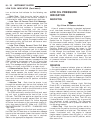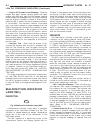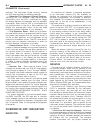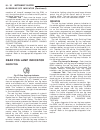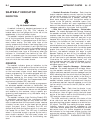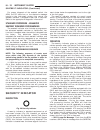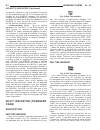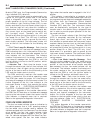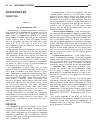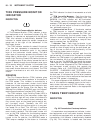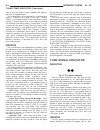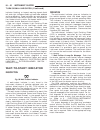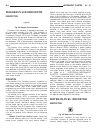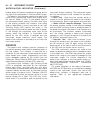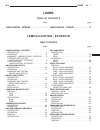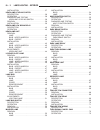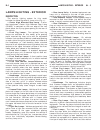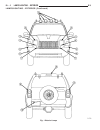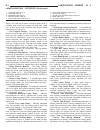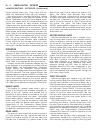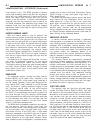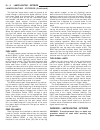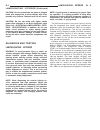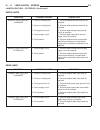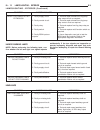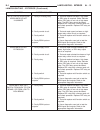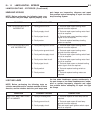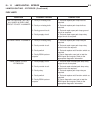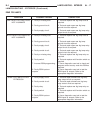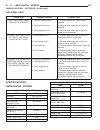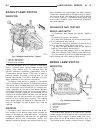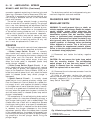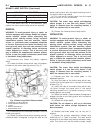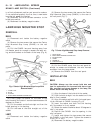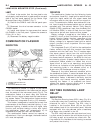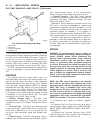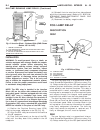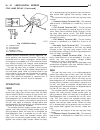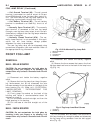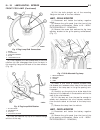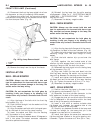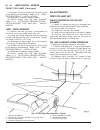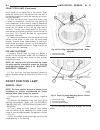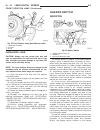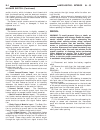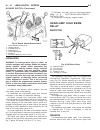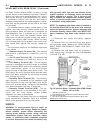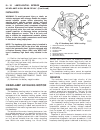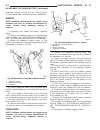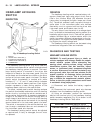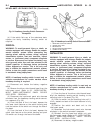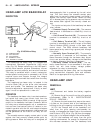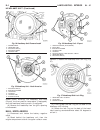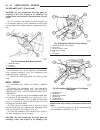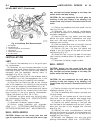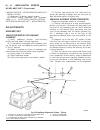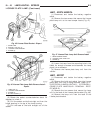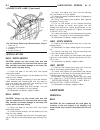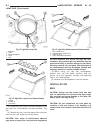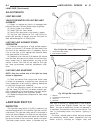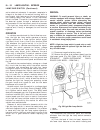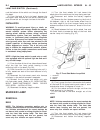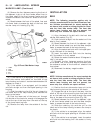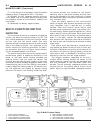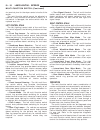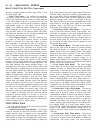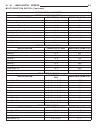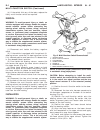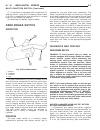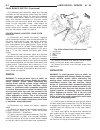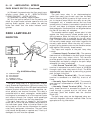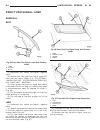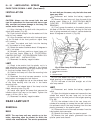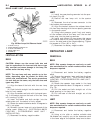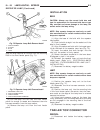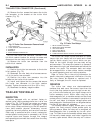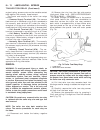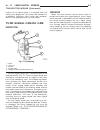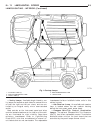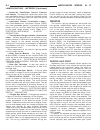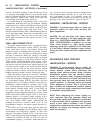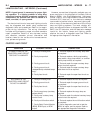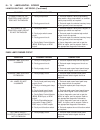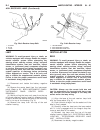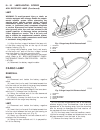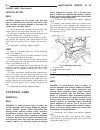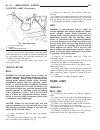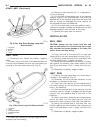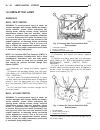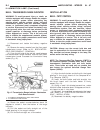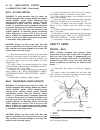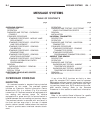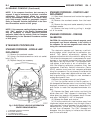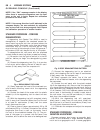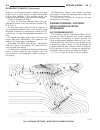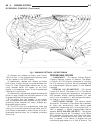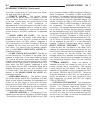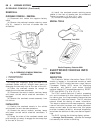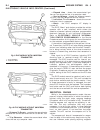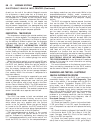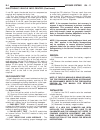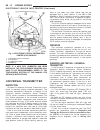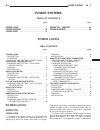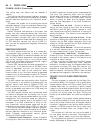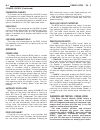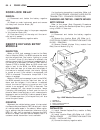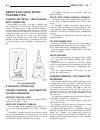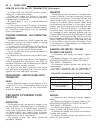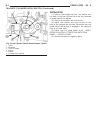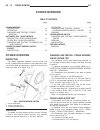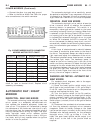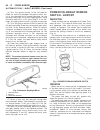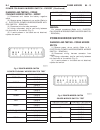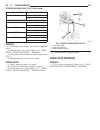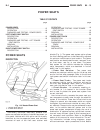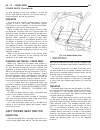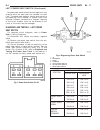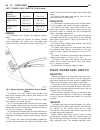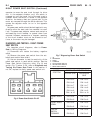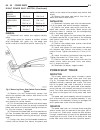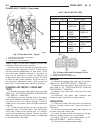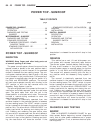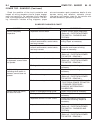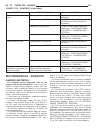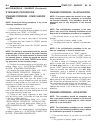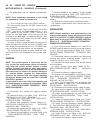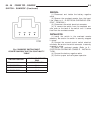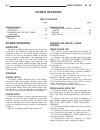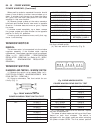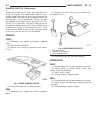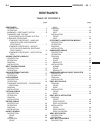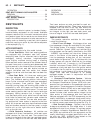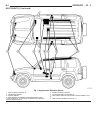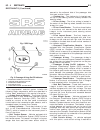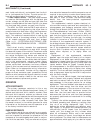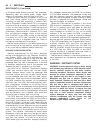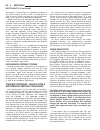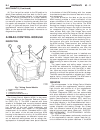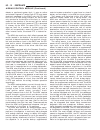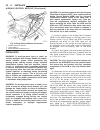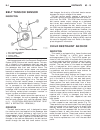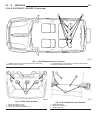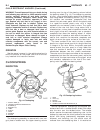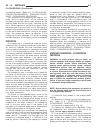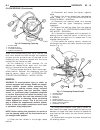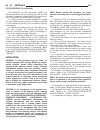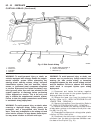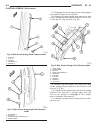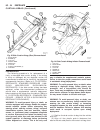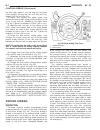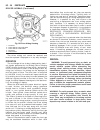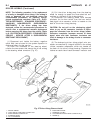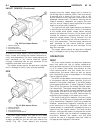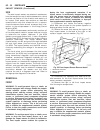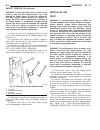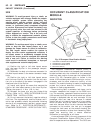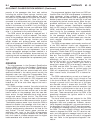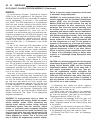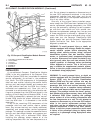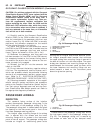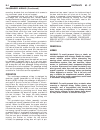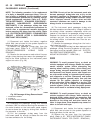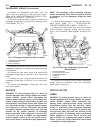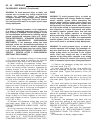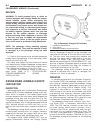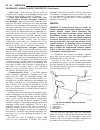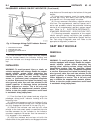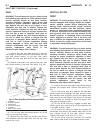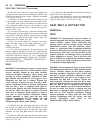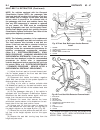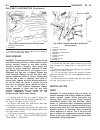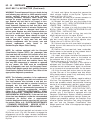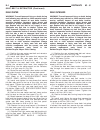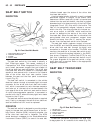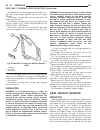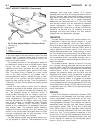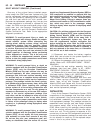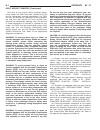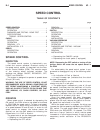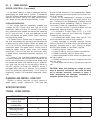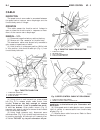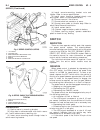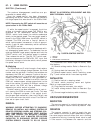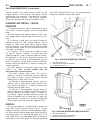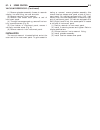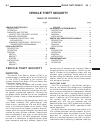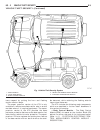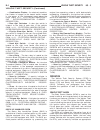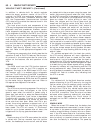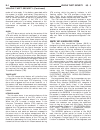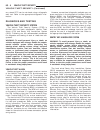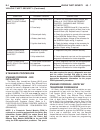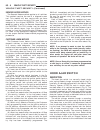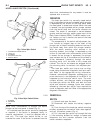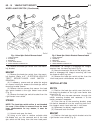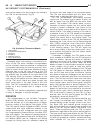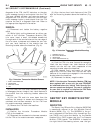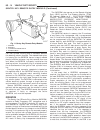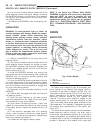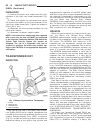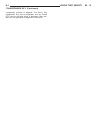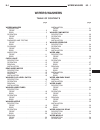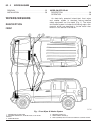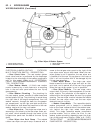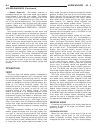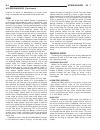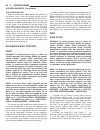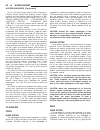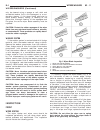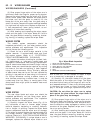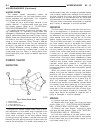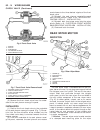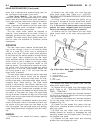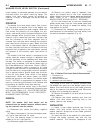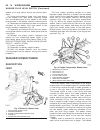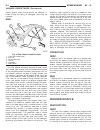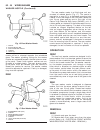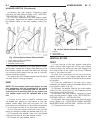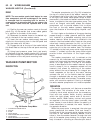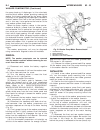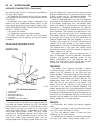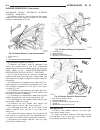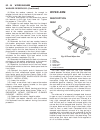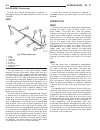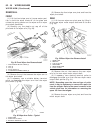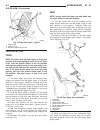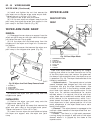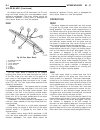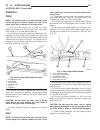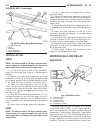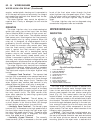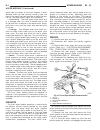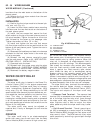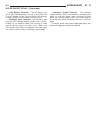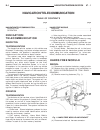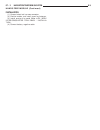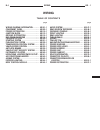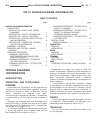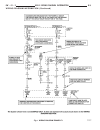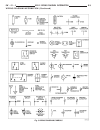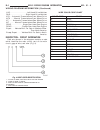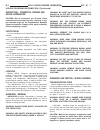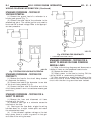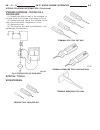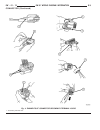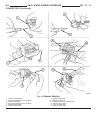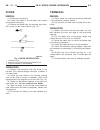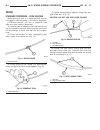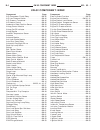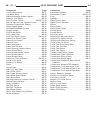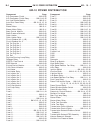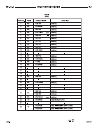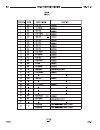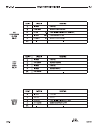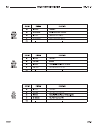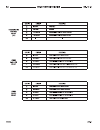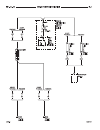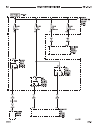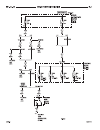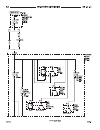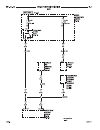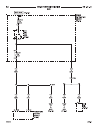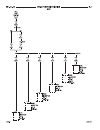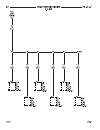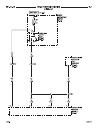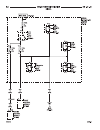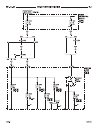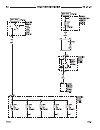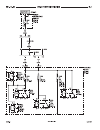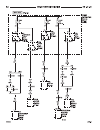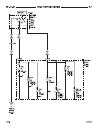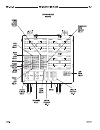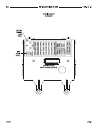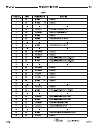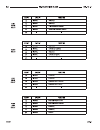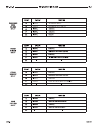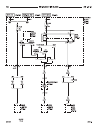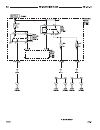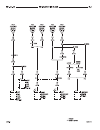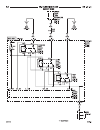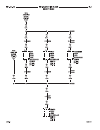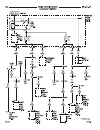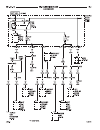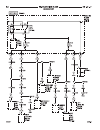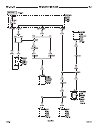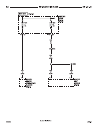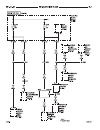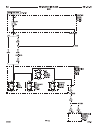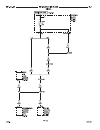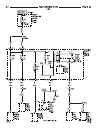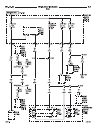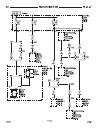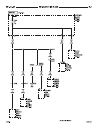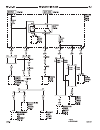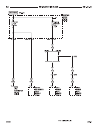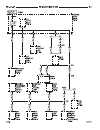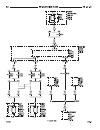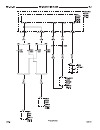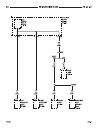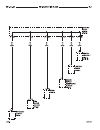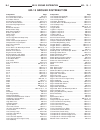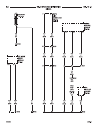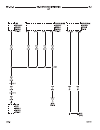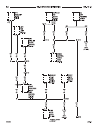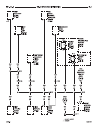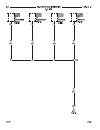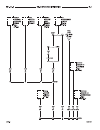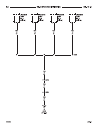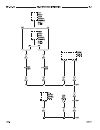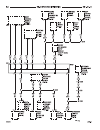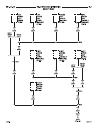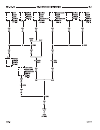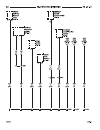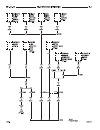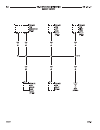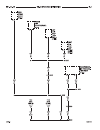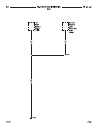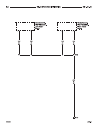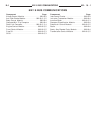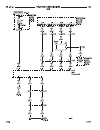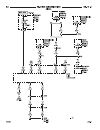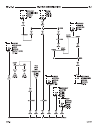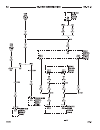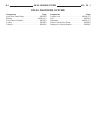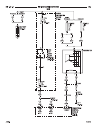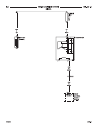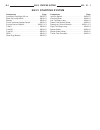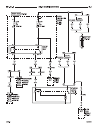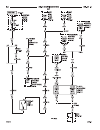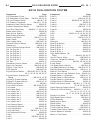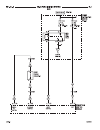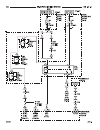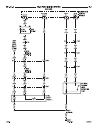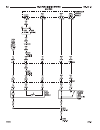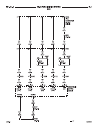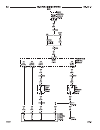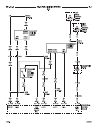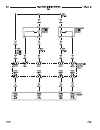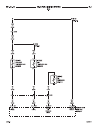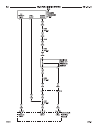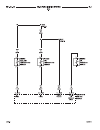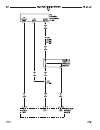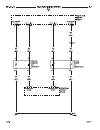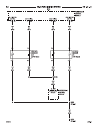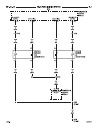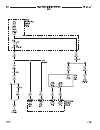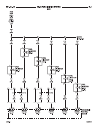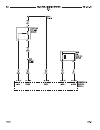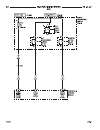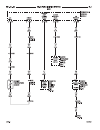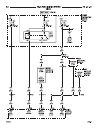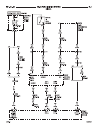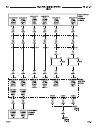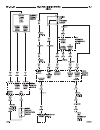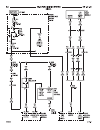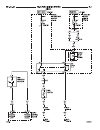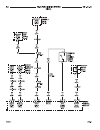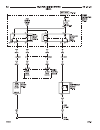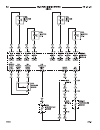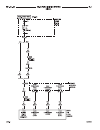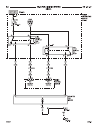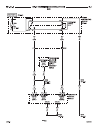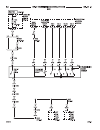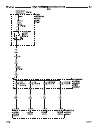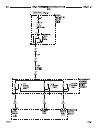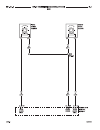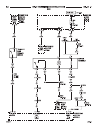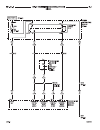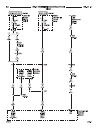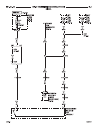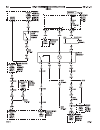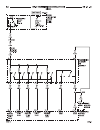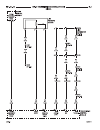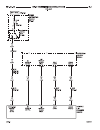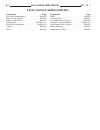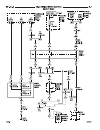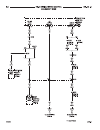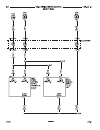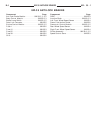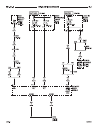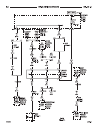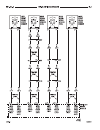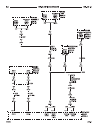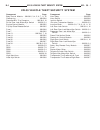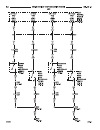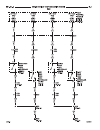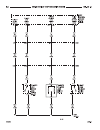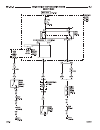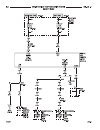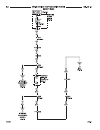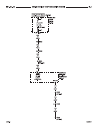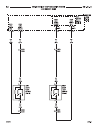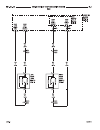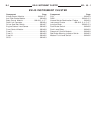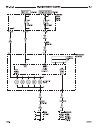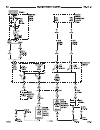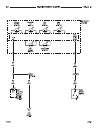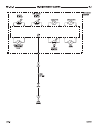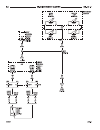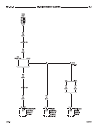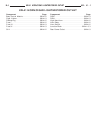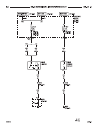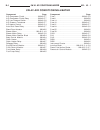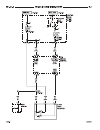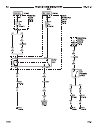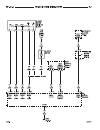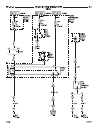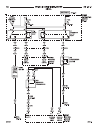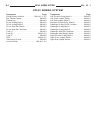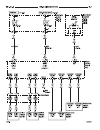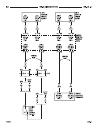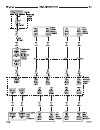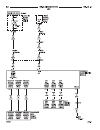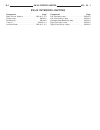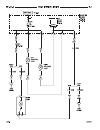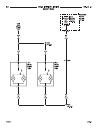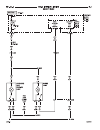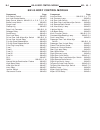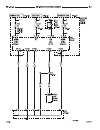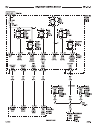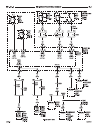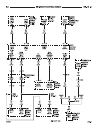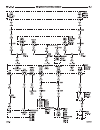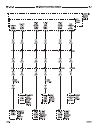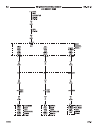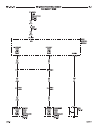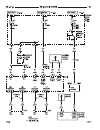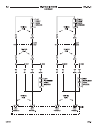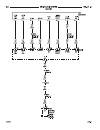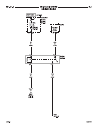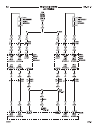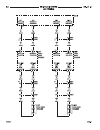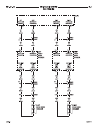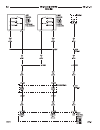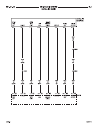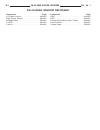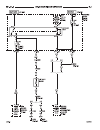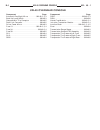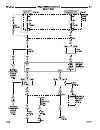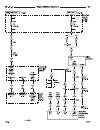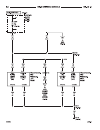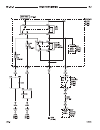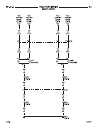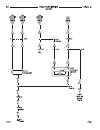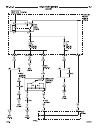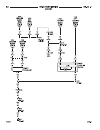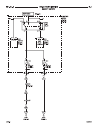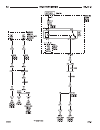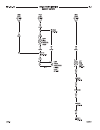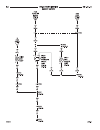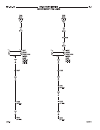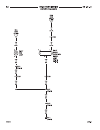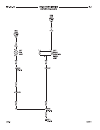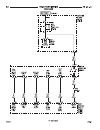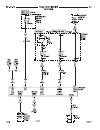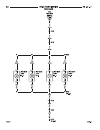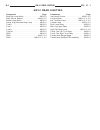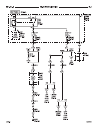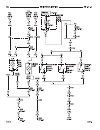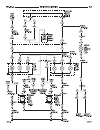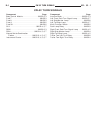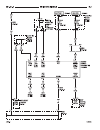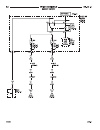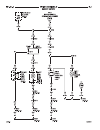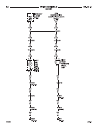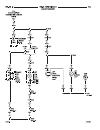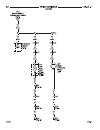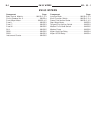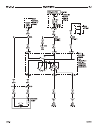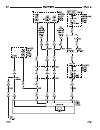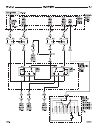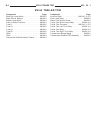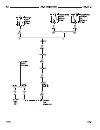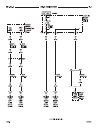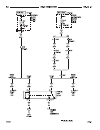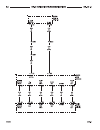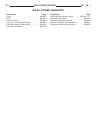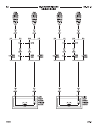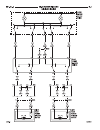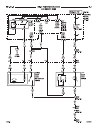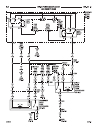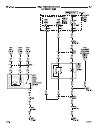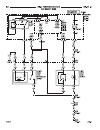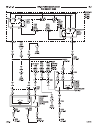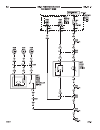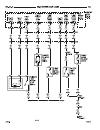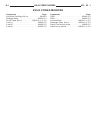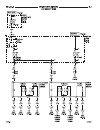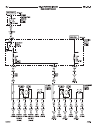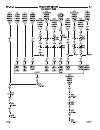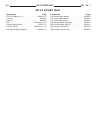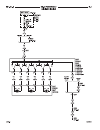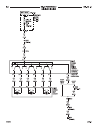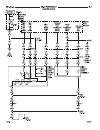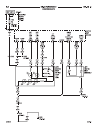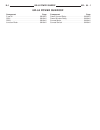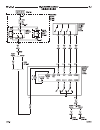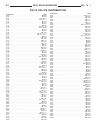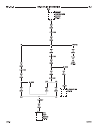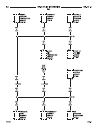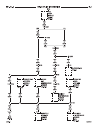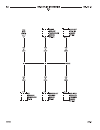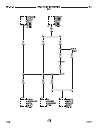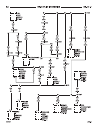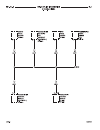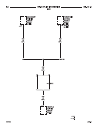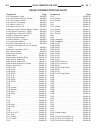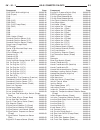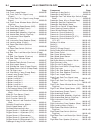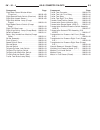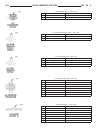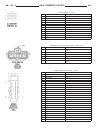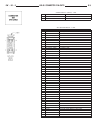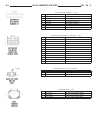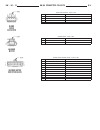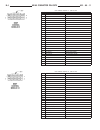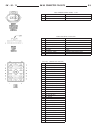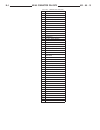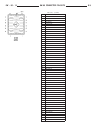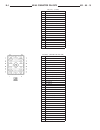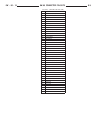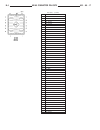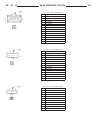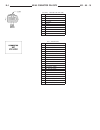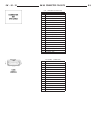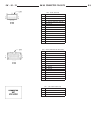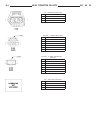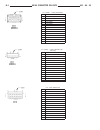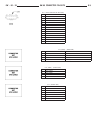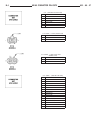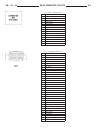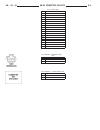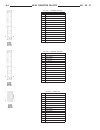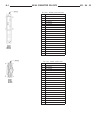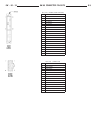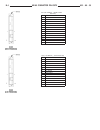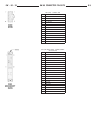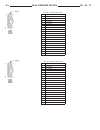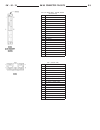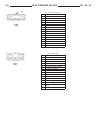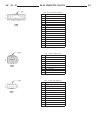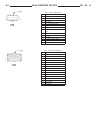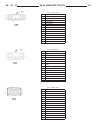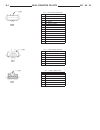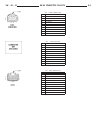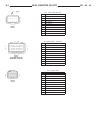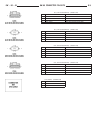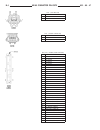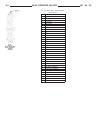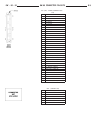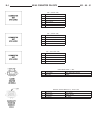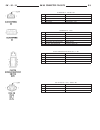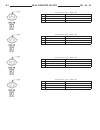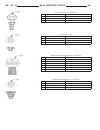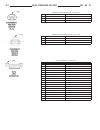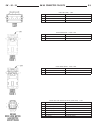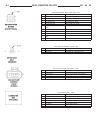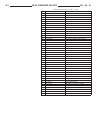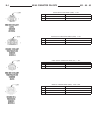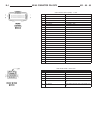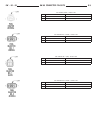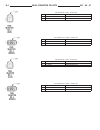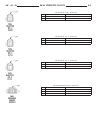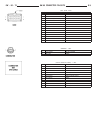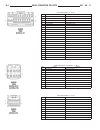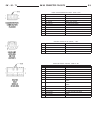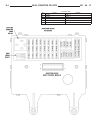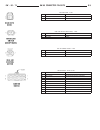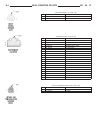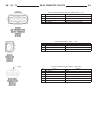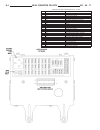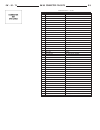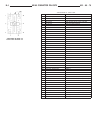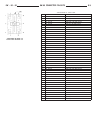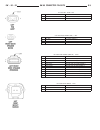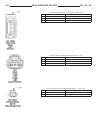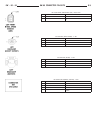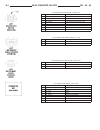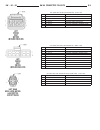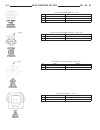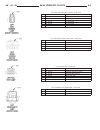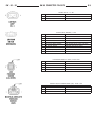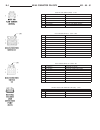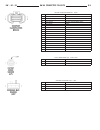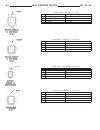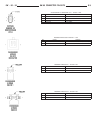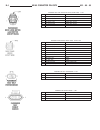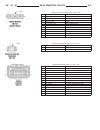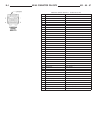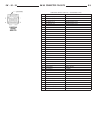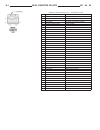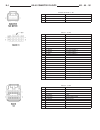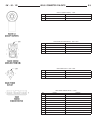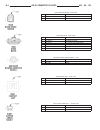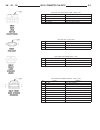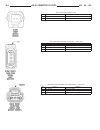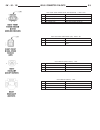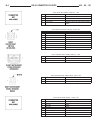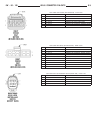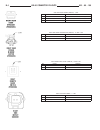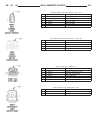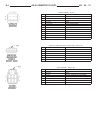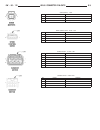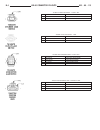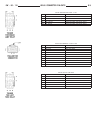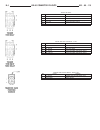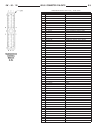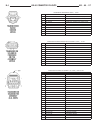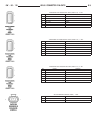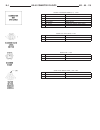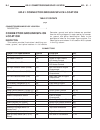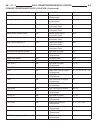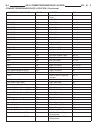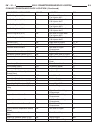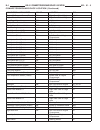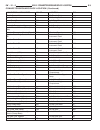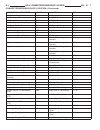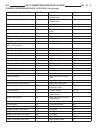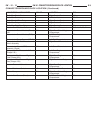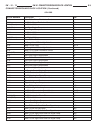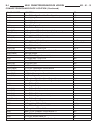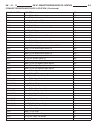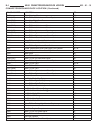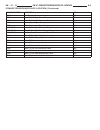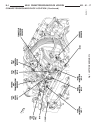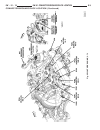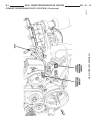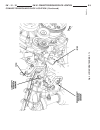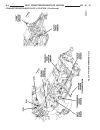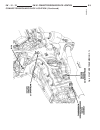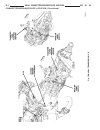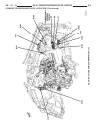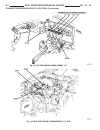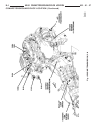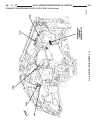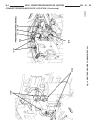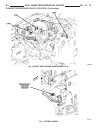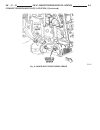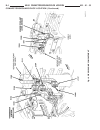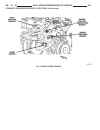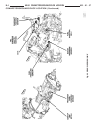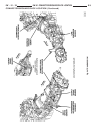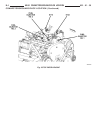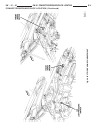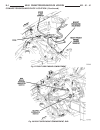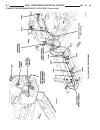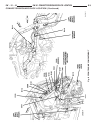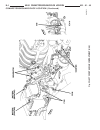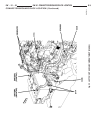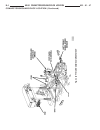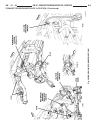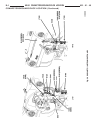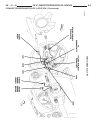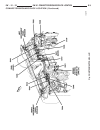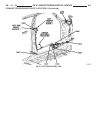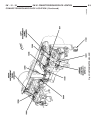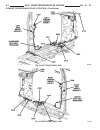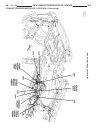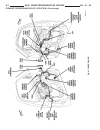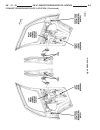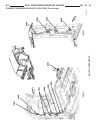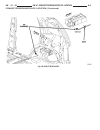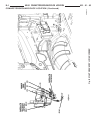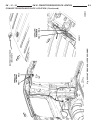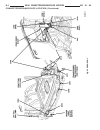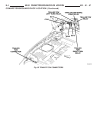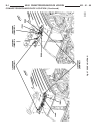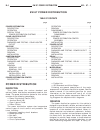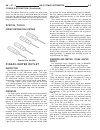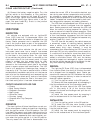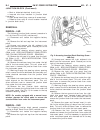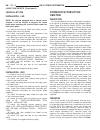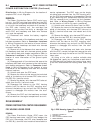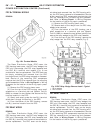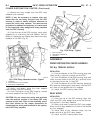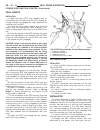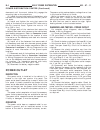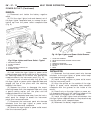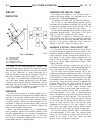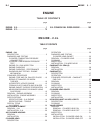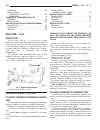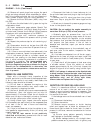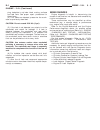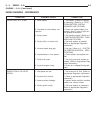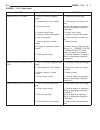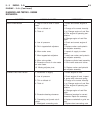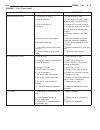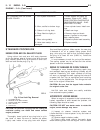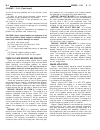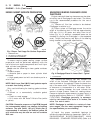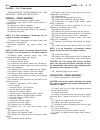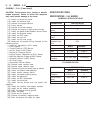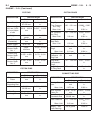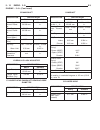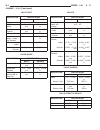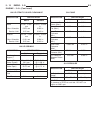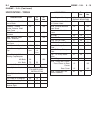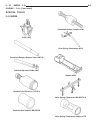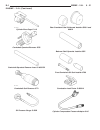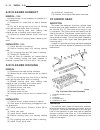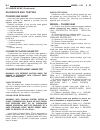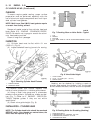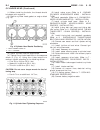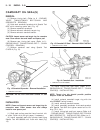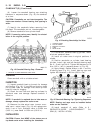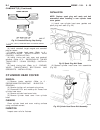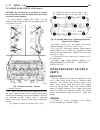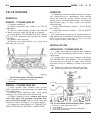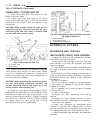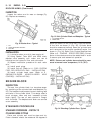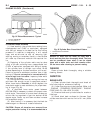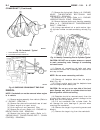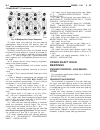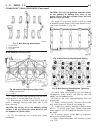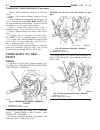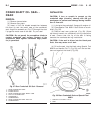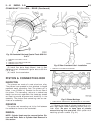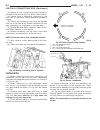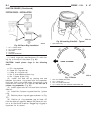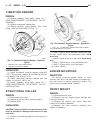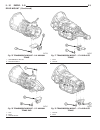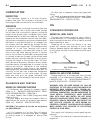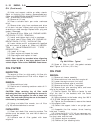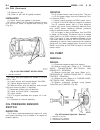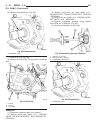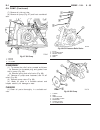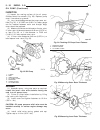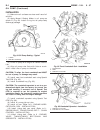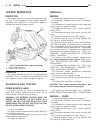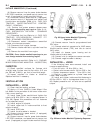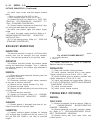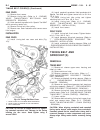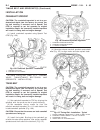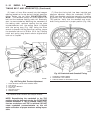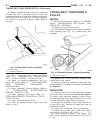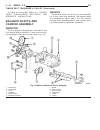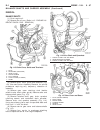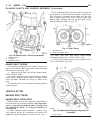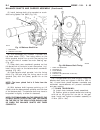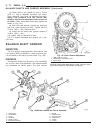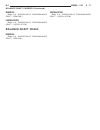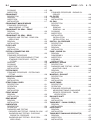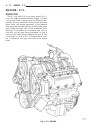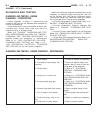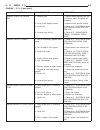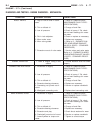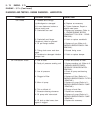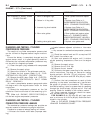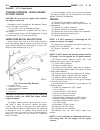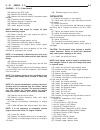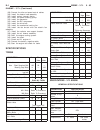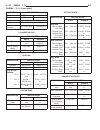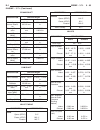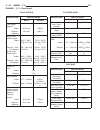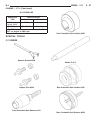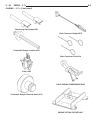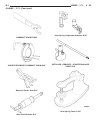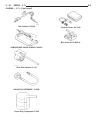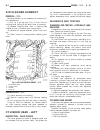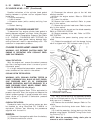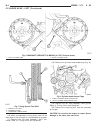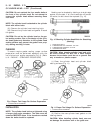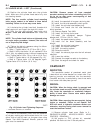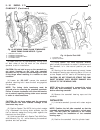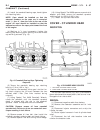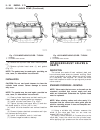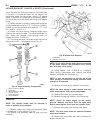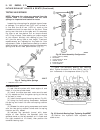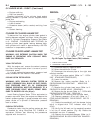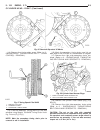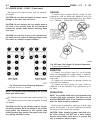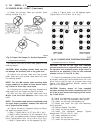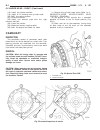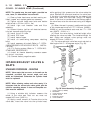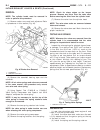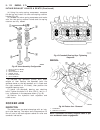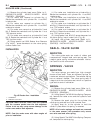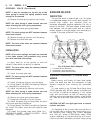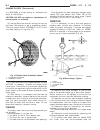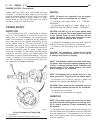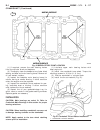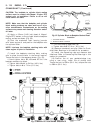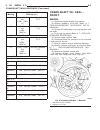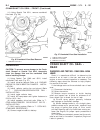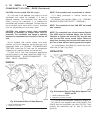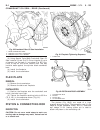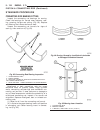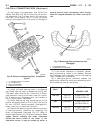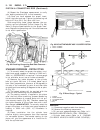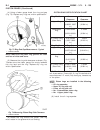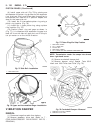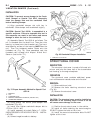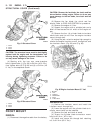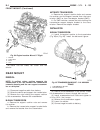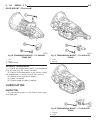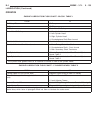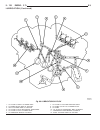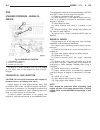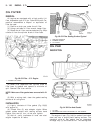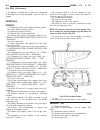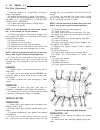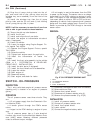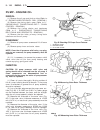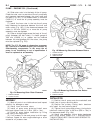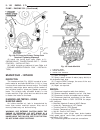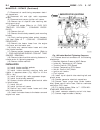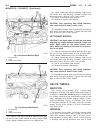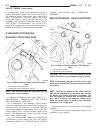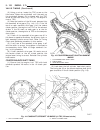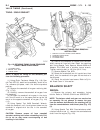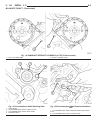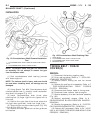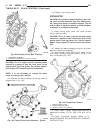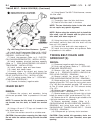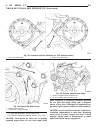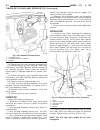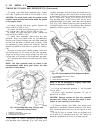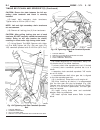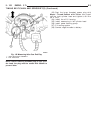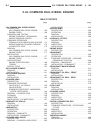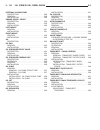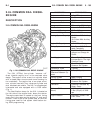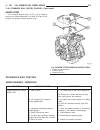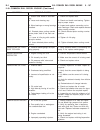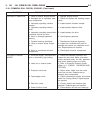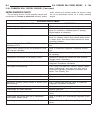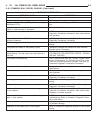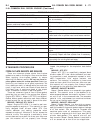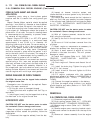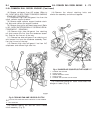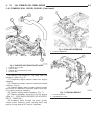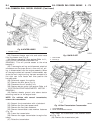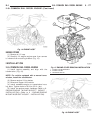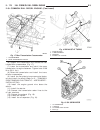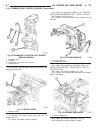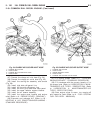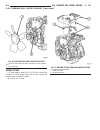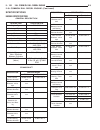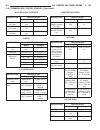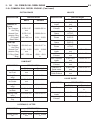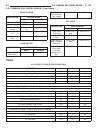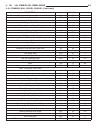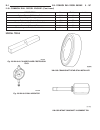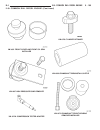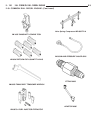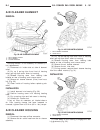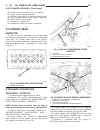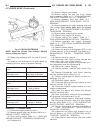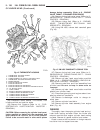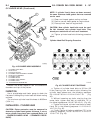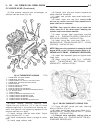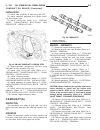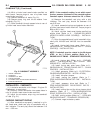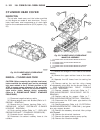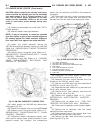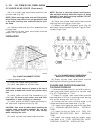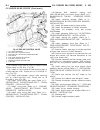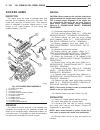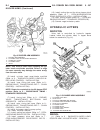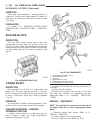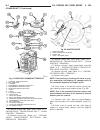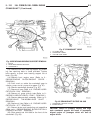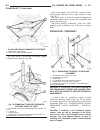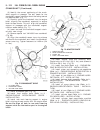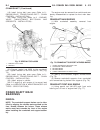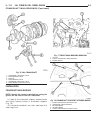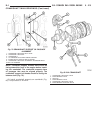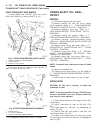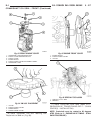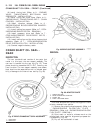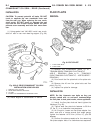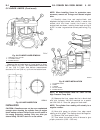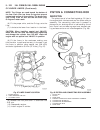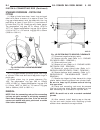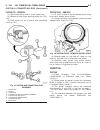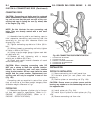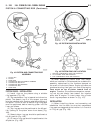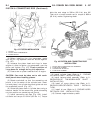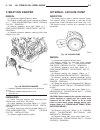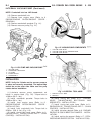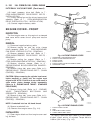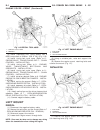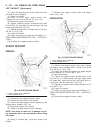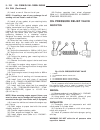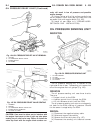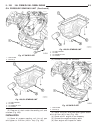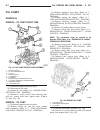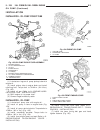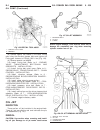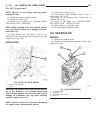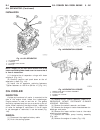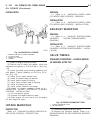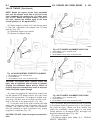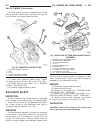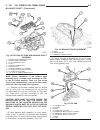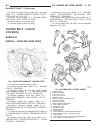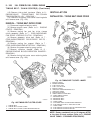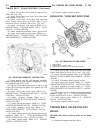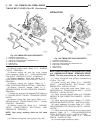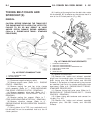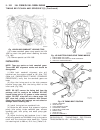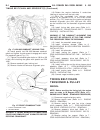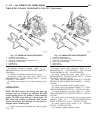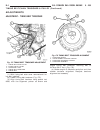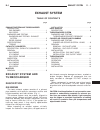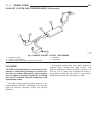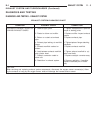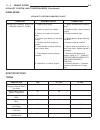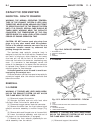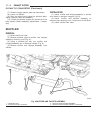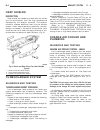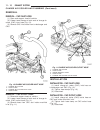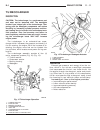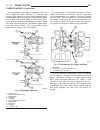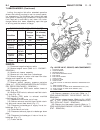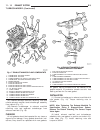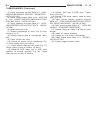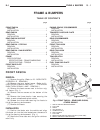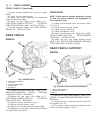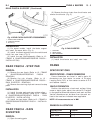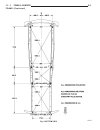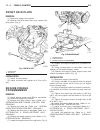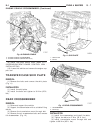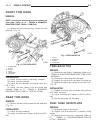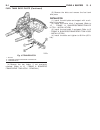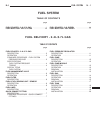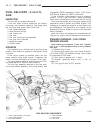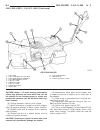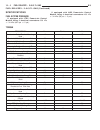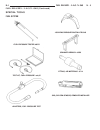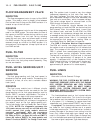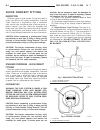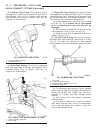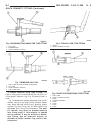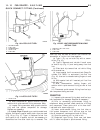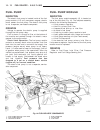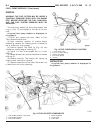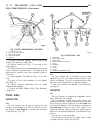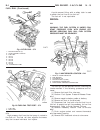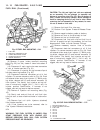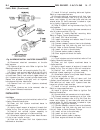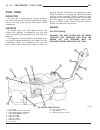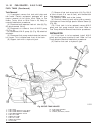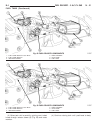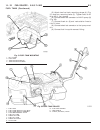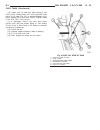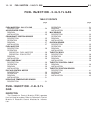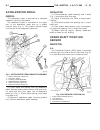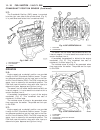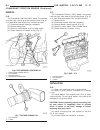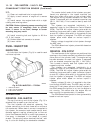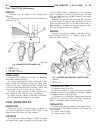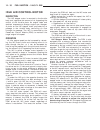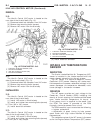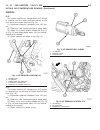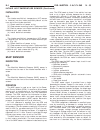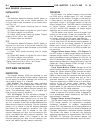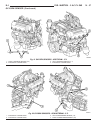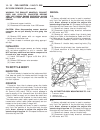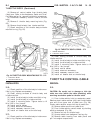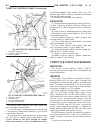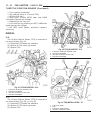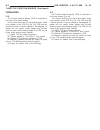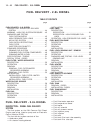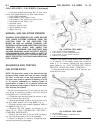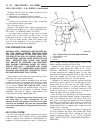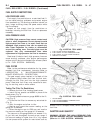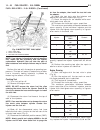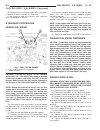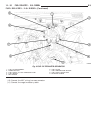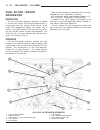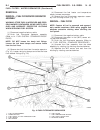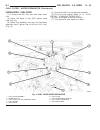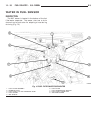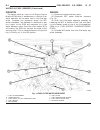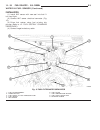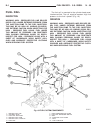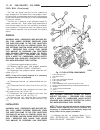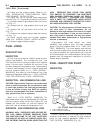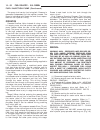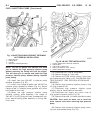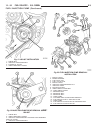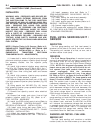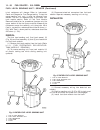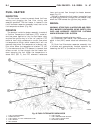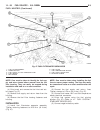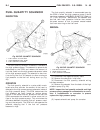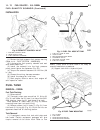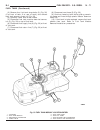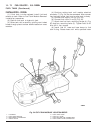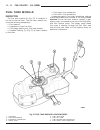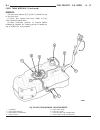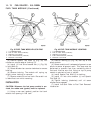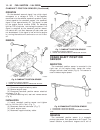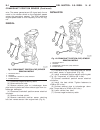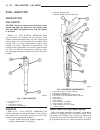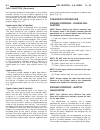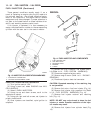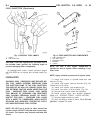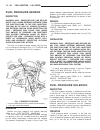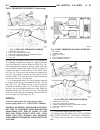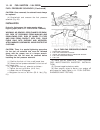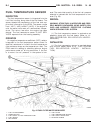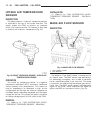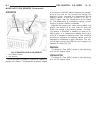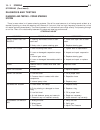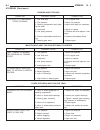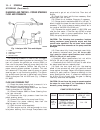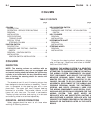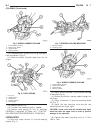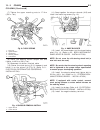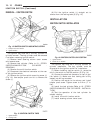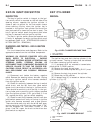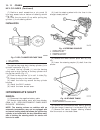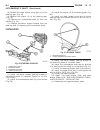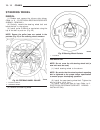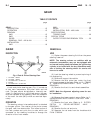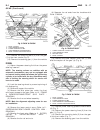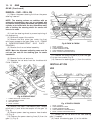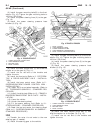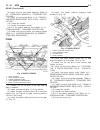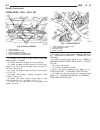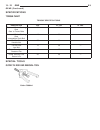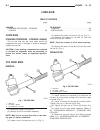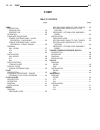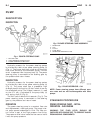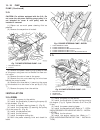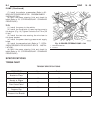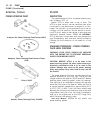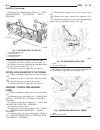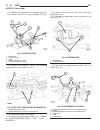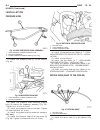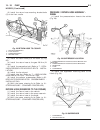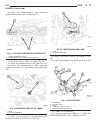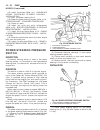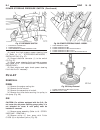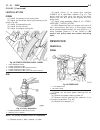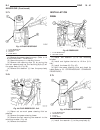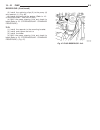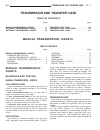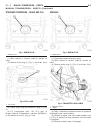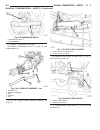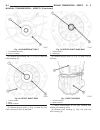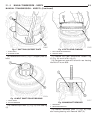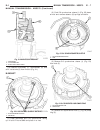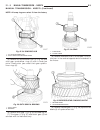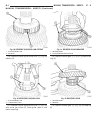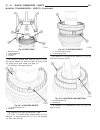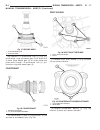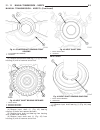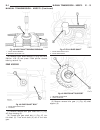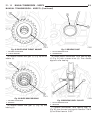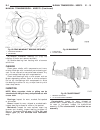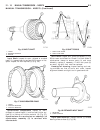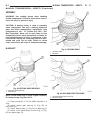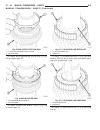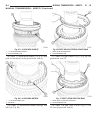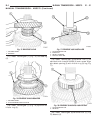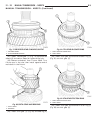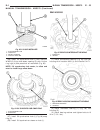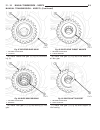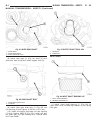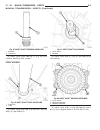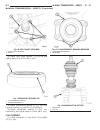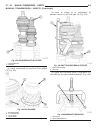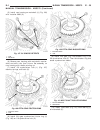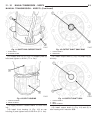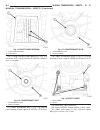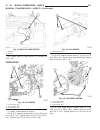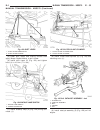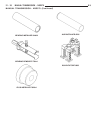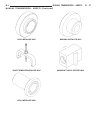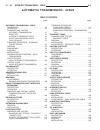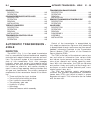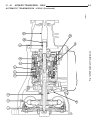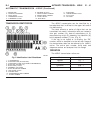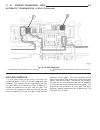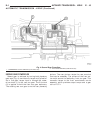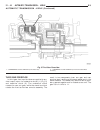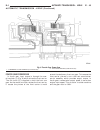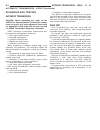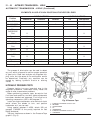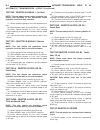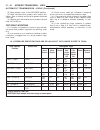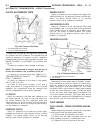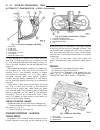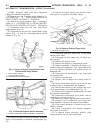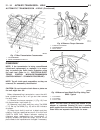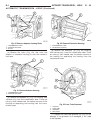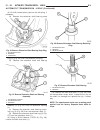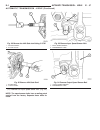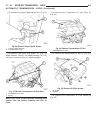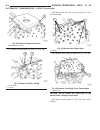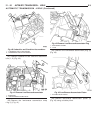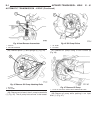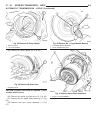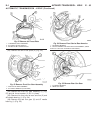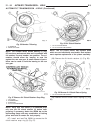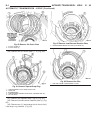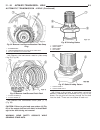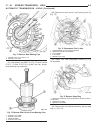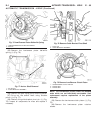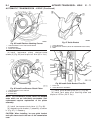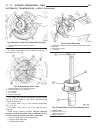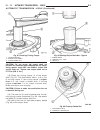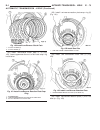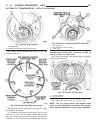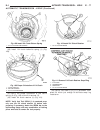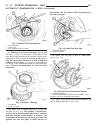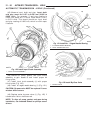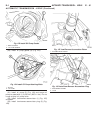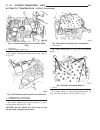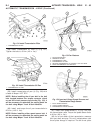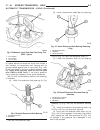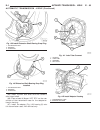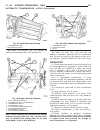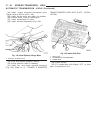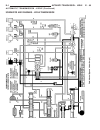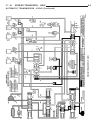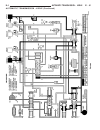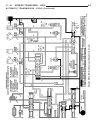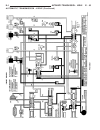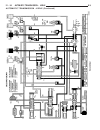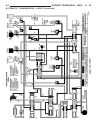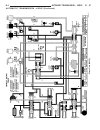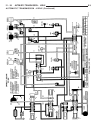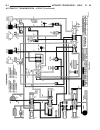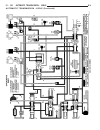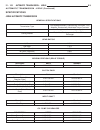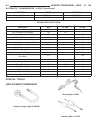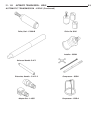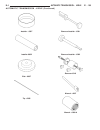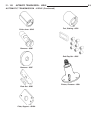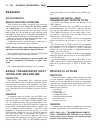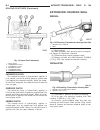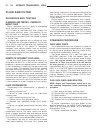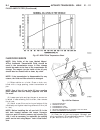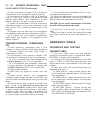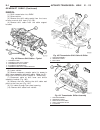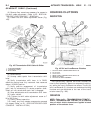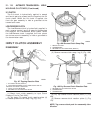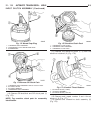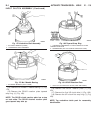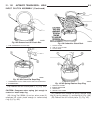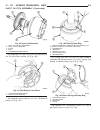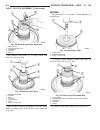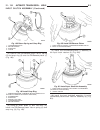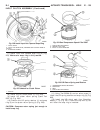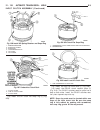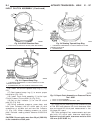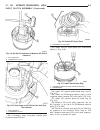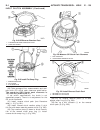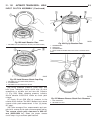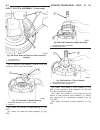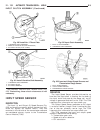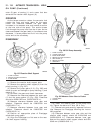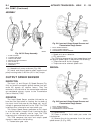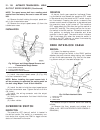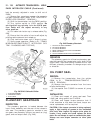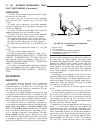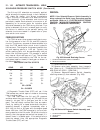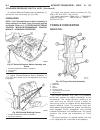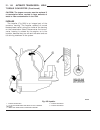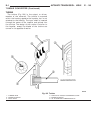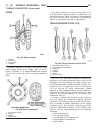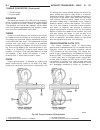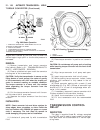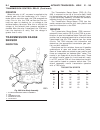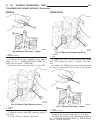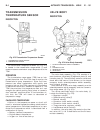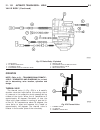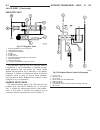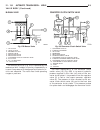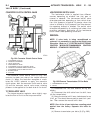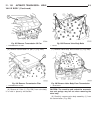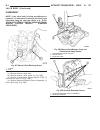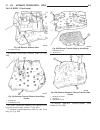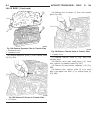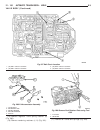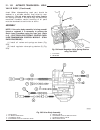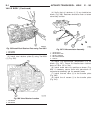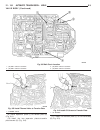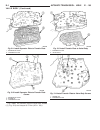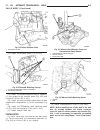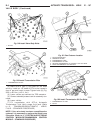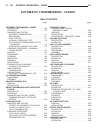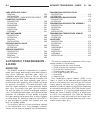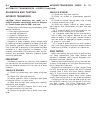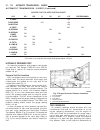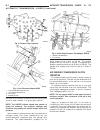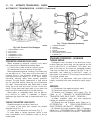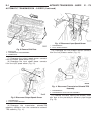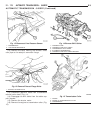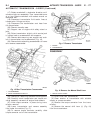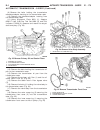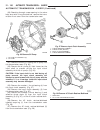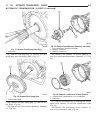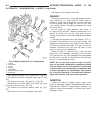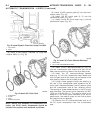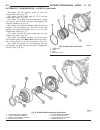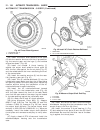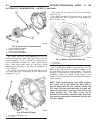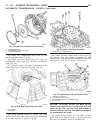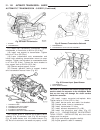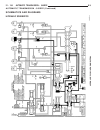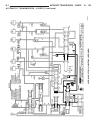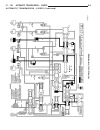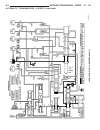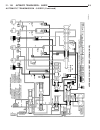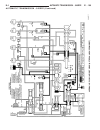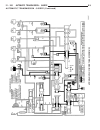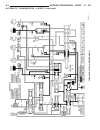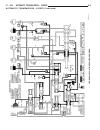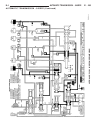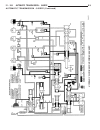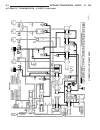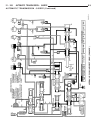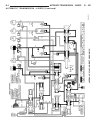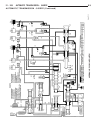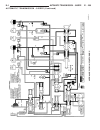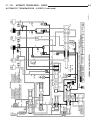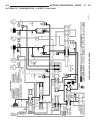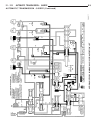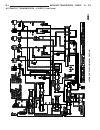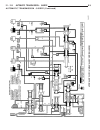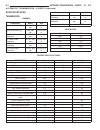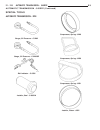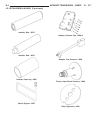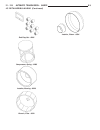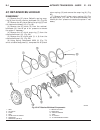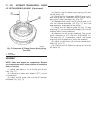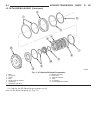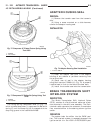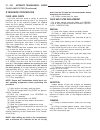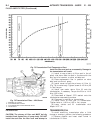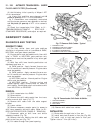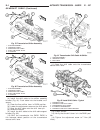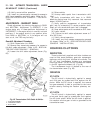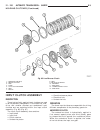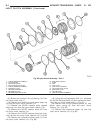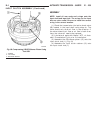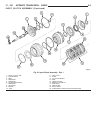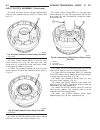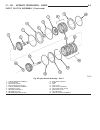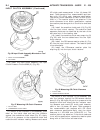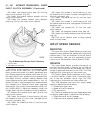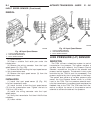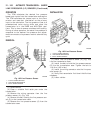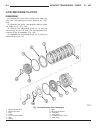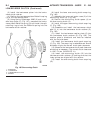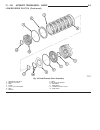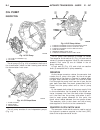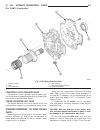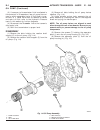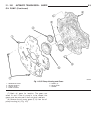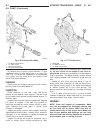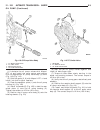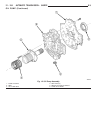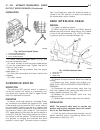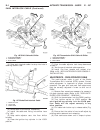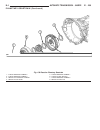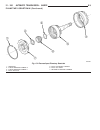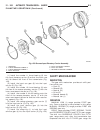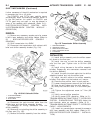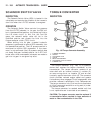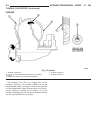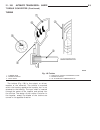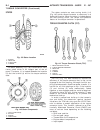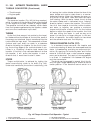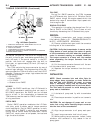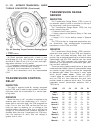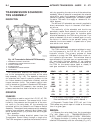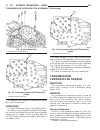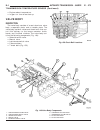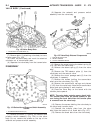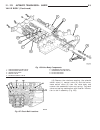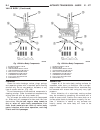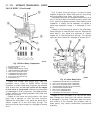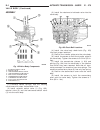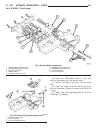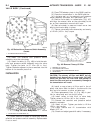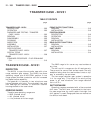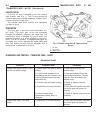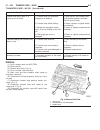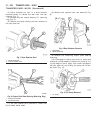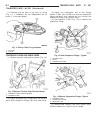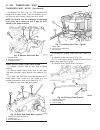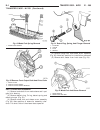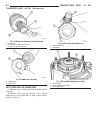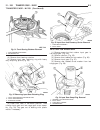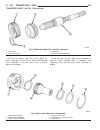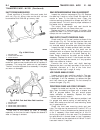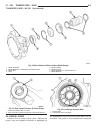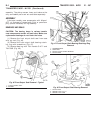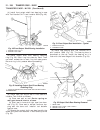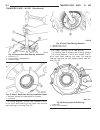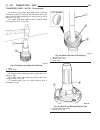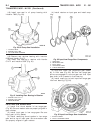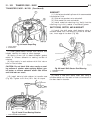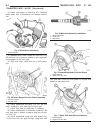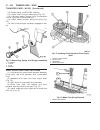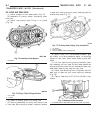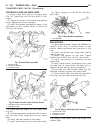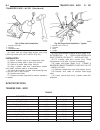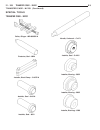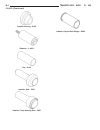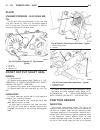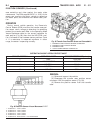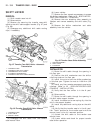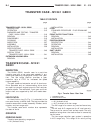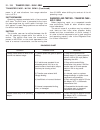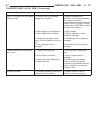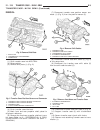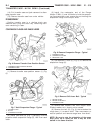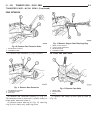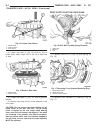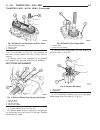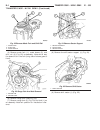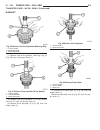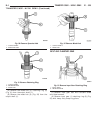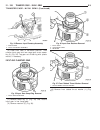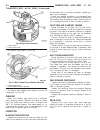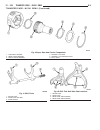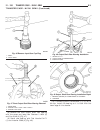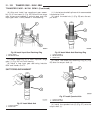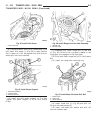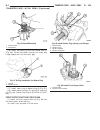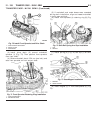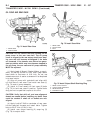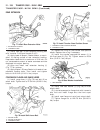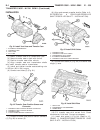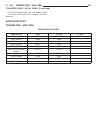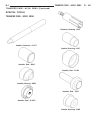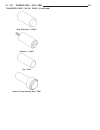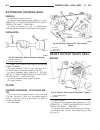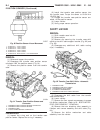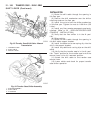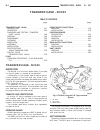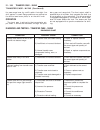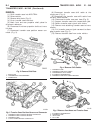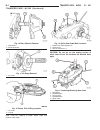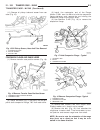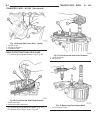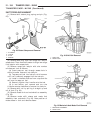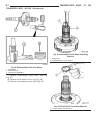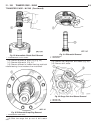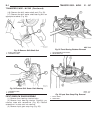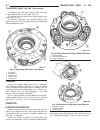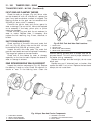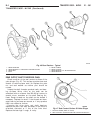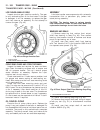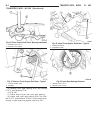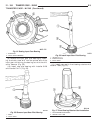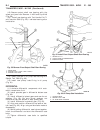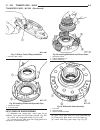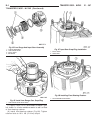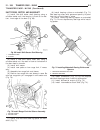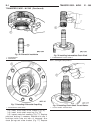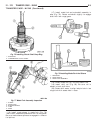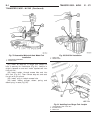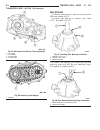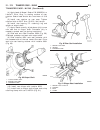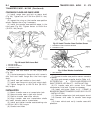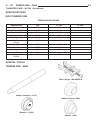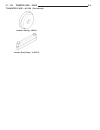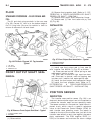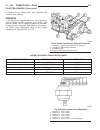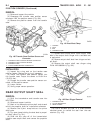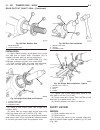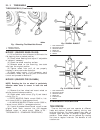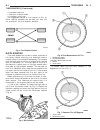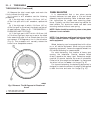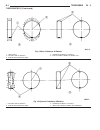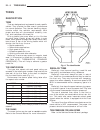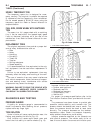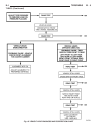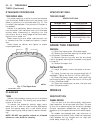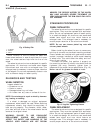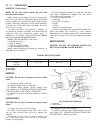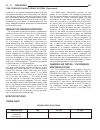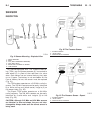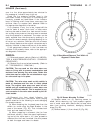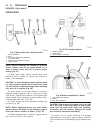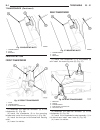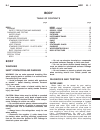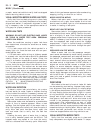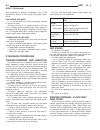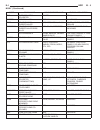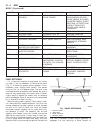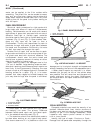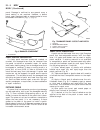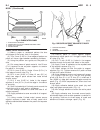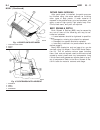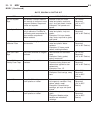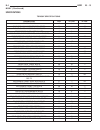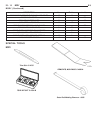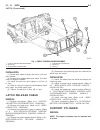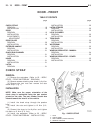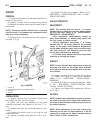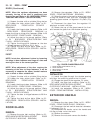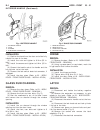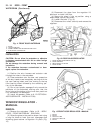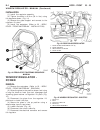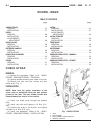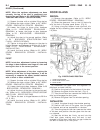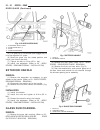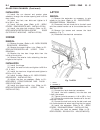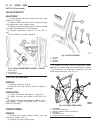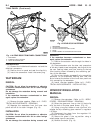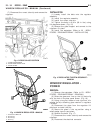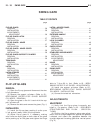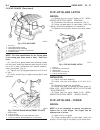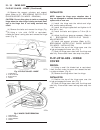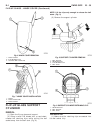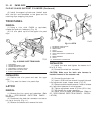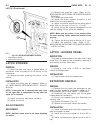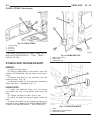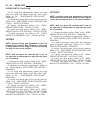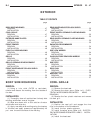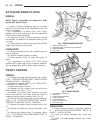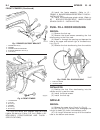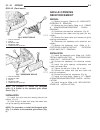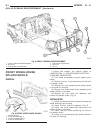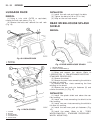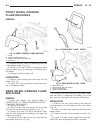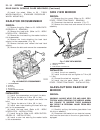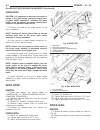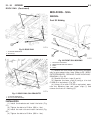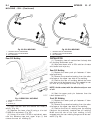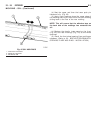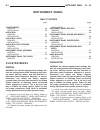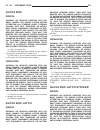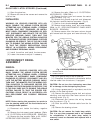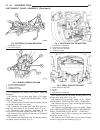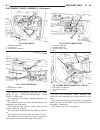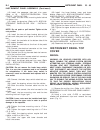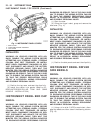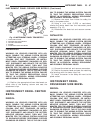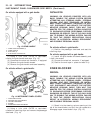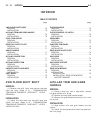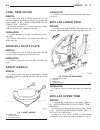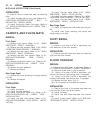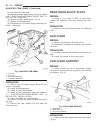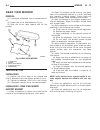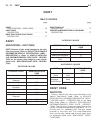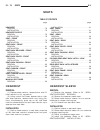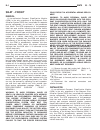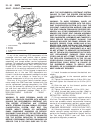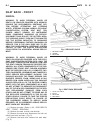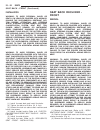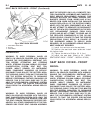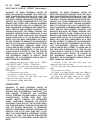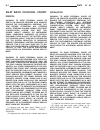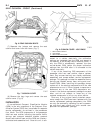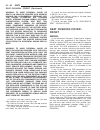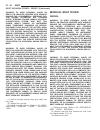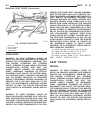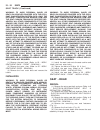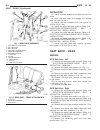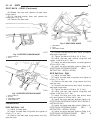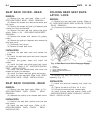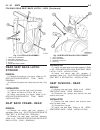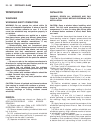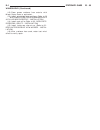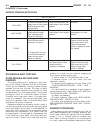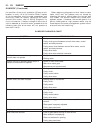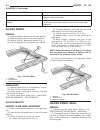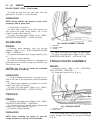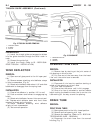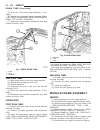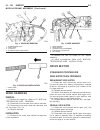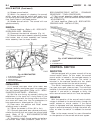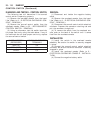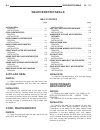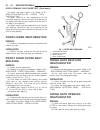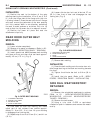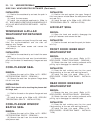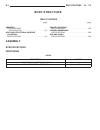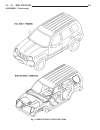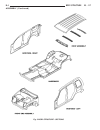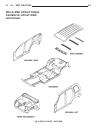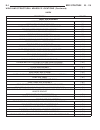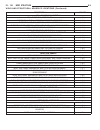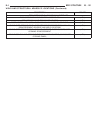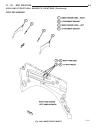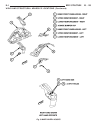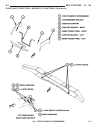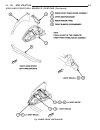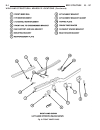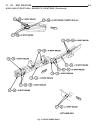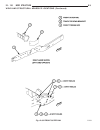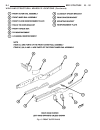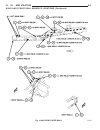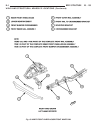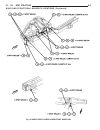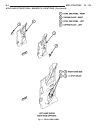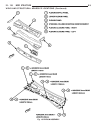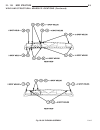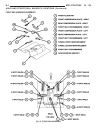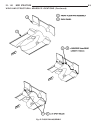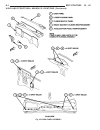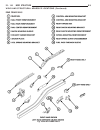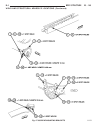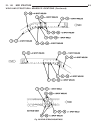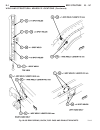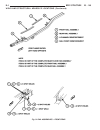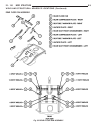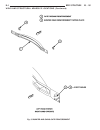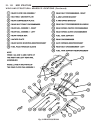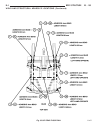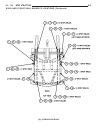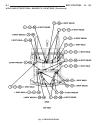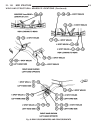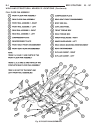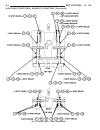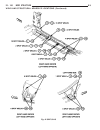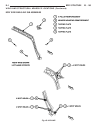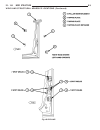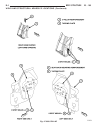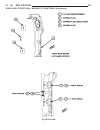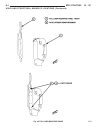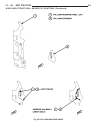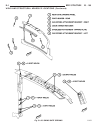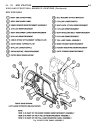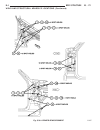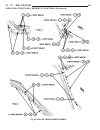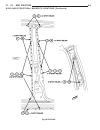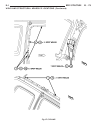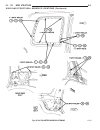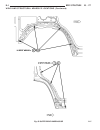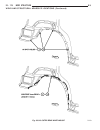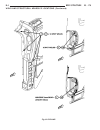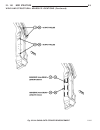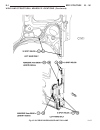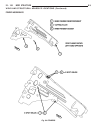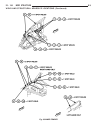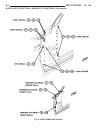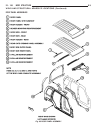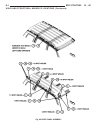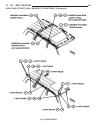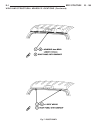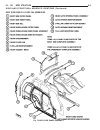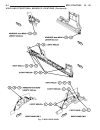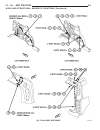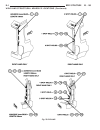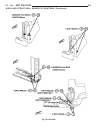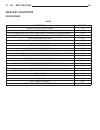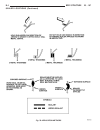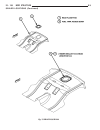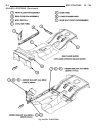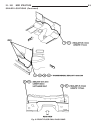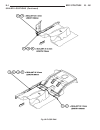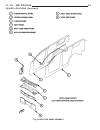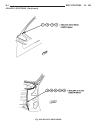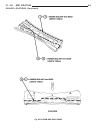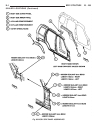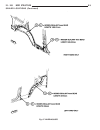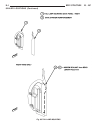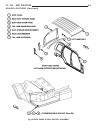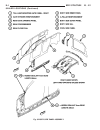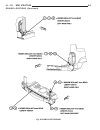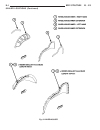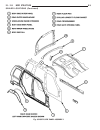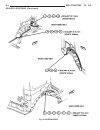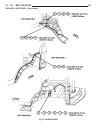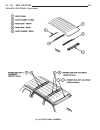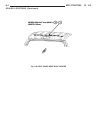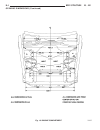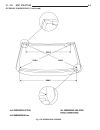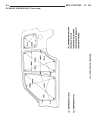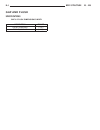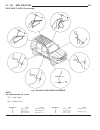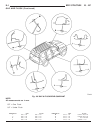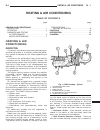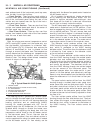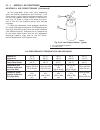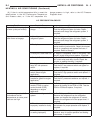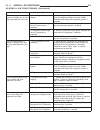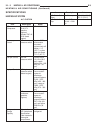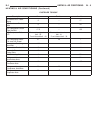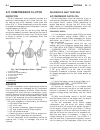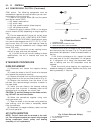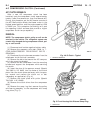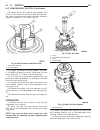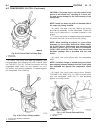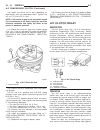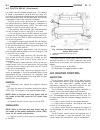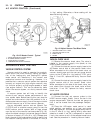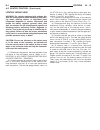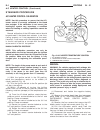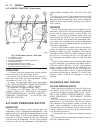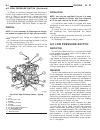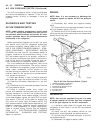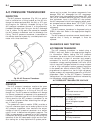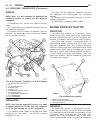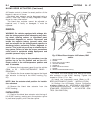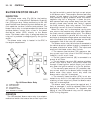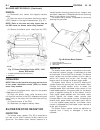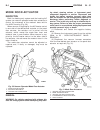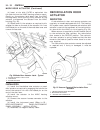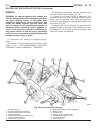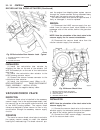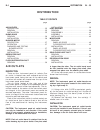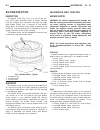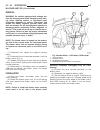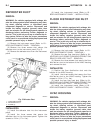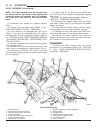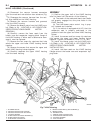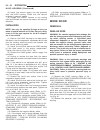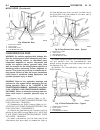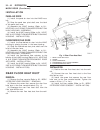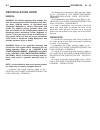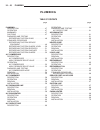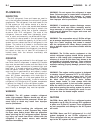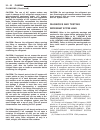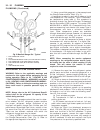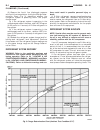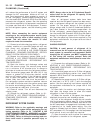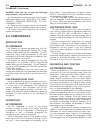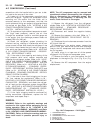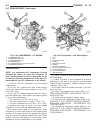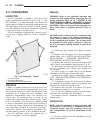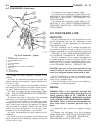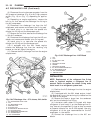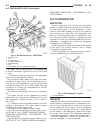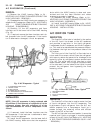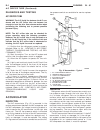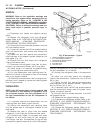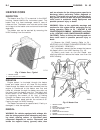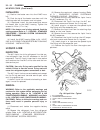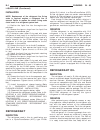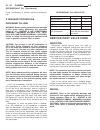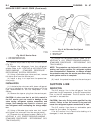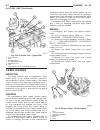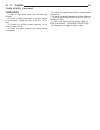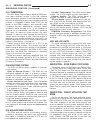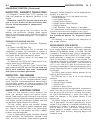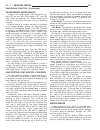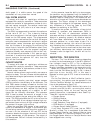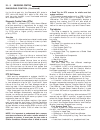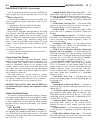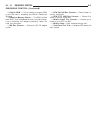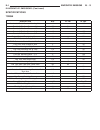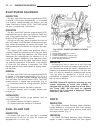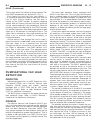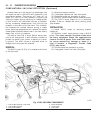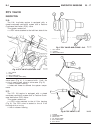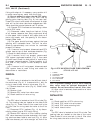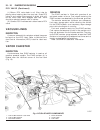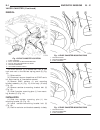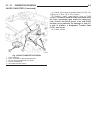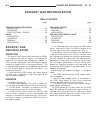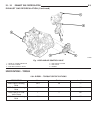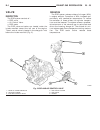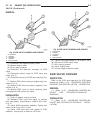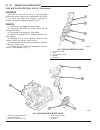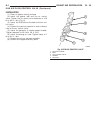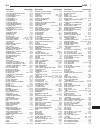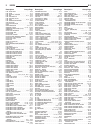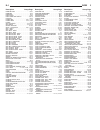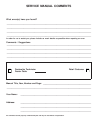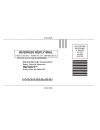- DL manuals
- Jeep
- Automobile
- KJ 2005
- Service Manual
Jeep KJ 2005 Service Manual
Summary of KJ 2005
Page 1
Group tab locator introduction 0 lubrication & maintenance 2 suspension 3 differential & driveline 5 brakes 6 clutch 7 cooling 8a audio/video 8b chime/buzzer 8e electronic control modules 8f engine systems 8g heated systems 8h horn 8i ignition control 8j instrument cluster 8l lamps 8m message system...
Page 2: Introduction
Introduction table of contents page page fastener identification description . . . . . . . . . . . . . . . . . . . . . . . . . . 1 fastener usage description description . . . . . . . . . . . . . . . . . . . . . . . . 4 description . . . . . . . . . . . . . . . . . . . . . . . . 4 international symb...
Page 3
Bolt markings and torques - u. S. Customary bolt markings grade 5 grade 8 bolt dia. N·m ft. Lbs n·m ft. Lbs 1/4 - 20 10 95* 14 125* 1/4 - 28 10 95* 17 150* 5/16 - 18 22 200* 30 270* 5/16 - 24 26 240* 33 300* 3/8 - 16 40 30 55 40 3/8 - 24 47 35 60 45 7/16 - 14 68 50 88 65 7/16 - 20 74 55 95 70 1/2 - ...
Page 4
Fig. 1 fastener strength kj introduction 3 fastener identification (continued).
Page 5: Fastener Usage
Fastener usage description description warning: use of an incorrect fastener may result in component damage or personal injury. Fasteners and torque specifications references in this service manual are identified in metric and sae format. During any maintenance or repair procedures, it is important ...
Page 6
Fig. 3 metric conversion chart kj introduction 5 metric system (continued).
Page 7: Torque References
Conversion formulas and equivalent values multiply by to get multiply by to get in-lbs x 0.11298 = newton meters (n·m) n·m x 8.851 = in-lbs ft-lbs x 1.3558 = newton meters (n·m) n·m x 0.7376 = ft-lbs inches hg (60° f) x 3.377 = kilopascals (kpa) kpa x 0.2961 = inches hg psi x 6.895 = kilopascals (kp...
Page 8
Fig. 4 torque specifications kj introduction 7 torque references (continued).
Page 9: Vehicle Emission Control
Vehicle emission control information (veci) label description all models have a vehicle emission control infor- mation (veci) label. Daimlerchrysler permanently attaches the label in the engine compartment (fig. 5). The label cannot be removed without defacing label information and destroying label....
Page 10: Vehicle Certification
Vehicle identification number decoding chart position interpretation code = description 1 country of origin 1 = manufactured by daimlerchrysler corporation 2 make j = jeep 3 vehicle type 4 = mpv w/o side airbags. 8 = mpv with side airbags. 4 gross vehicle weight rating f = 4001 - 5000 lbs. G = 5001 ...
Page 12: Lubrication & Maintenance
Lubrication & maintenance table of contents page page international symbols description . . . . . . . . . . . . . . . . . . . . . . . . . . 1 parts & lubricant recommendation description lubricant recommendations . . . . . . . . . 1 fluid types . . . . . . . . . . . . . . . . . . . . . . . . . 2 flu...
Page 13: Fluid Types
Body component fluid, lubricant, and genuine part hinges: door & hood mopar t engine oil swing gate mopar t multi-purpose lube nlgi grade 2 ep, gc-lb latches: door, hood/safety catch, swing gate mopar t multi-purpose lube nlgi grade 2 ep, gc-lb seat regulator & track mopar t multi-purpose lube nlgi ...
Page 14
Container identification standard engine oil identification notations have been adopted to aid in the proper selection of engine oil. The identifying notations are located on the front label of engine oil plastic bottles and the top of engine oil cans (fig. 4). This symbol means that the oil has bee...
Page 15
This is normal. Atf+4 also has a unique odor that may change with age. Consequently, odor and color cannot be used to indicate the fluid condition or the need for a fluid change. Fluid additives daimlerchrysler strongly recommends against the addition of any fluids to the transmission, other than th...
Page 16: Fluid Capacities
Must always be a minimum of 44 percent, year- round in all climates. If percentage is lower, engine parts may be eroded by cavitation. Maximum protec- tion against freezing is provided with a 68 percent antifreeze concentration, which prevents freezing down to -67.7°c (-90°f). A higher percentage wi...
Page 17: Maintenance Schedules
Maintenance schedules description maintenance schedules - gasoline engines there are two maintenance schedules that show the required service for your vehicle. First is schedule ( b ( . It is for vehicles that are operated under the conditions that are listed below and at the beginning of the schedu...
Page 18
Miles 3,000 6,000 9,000 12,000 15,000 (kilometers) (5 000) (10 000) (14 000) (19 000) (24 000) change the engine oil and engine oil filter, if not replaced at 3 months. X x x x x rotate the tires. X x inspect the engine air filter element, replace if necessary. X inspect the brake linings. X drain a...
Page 19
Miles 48,000 51,000 54,000 57,000 60,000 (kilometers) (77 000) (82 000) (86 000) (91 000) (96 000) replace the ignition cables (2.4l only). X inspect the brake linings. X x drain and refill the front and rear axle fluid‡ x x drain and refill the automatic transmission fluid, and replace main sump fi...
Page 20
Miles 93,000 96,000 99,000 102,000 105,000 (kilometers) (149 000) (154 000) (158 000) (163 000) (168 000) change the engine oil and engine oil filter, if not replaced at 3 months. X x x x x rotate the tires. X x inspect the engine air filter element, replace if necessary. X inspect the brake linings...
Page 21
Schedule “a” miles 6,000 12,000 18,000 24,000 30,000 (kilometers) (10 000) (19 000) (29 000) (38 000) (48 000) [months] [6] [12] [18] [24] [30] change the engine oil and engine oil filter. X x x x x rotate the tires. X x x x x inspect the engine air filter element, and replace if necessary. X replac...
Page 22
Miles 84,000 90,000 96,000 102,000 (kilometers) (134 000) (144 000) (154 000) (163 000) [months] [84] [90] [96] [102] change the engine oil and engine oil filter. X x x x rotate the tires. X x x x inspect the engine air filter element, and replace if necessary. X replace the spark plugs. X inspect a...
Page 23
Maintenance schedules - diesel engine there are two maintenance schedules that show the required service for your vehicle. First is schedule ( b ( . It is for vehicles that are operated under the conditions that are listed below and at the beginning of the schedule. • day or night temperatures are b...
Page 24
Miles 37,500 43,750 50,000 56,250 62,500 (kilometers) (60 000) (70 000) (80 000) (90 000) (100 000) change the engine oil and engine oil filter. X x x x x inspect the engine air filter element. Replace as necessary. X x x x x replace the engine air filter element. X x x replace the fuel filter/water...
Page 25
Schedule “a” miles 12,500 25,000 37,500 50,000 (kilometers) (20 000) (40 000) (60 000) (80 000) change the engine oil and engine oil filter. X x x x inspect the engine air filter element. Replace as nec- essary. X x x x replace the engine air filter element. X x replace the fuel filter/water separat...
Page 26
Once a month • check the tire pressure and look for unusual wear or damage. • inspect the battery, and clean and tighten the terminals as required. • check the fluid levels of the coolant reservoir, brake master cylinder, and transmission, and add as needed. • check all lights and all other electric...
Page 27
Kilometers 120 000 132 000 144 000 156 000 (miles) (75,000) (82,500) (90,000) (97,500) [months] [60] [66] [72] [78] replace the spark plugs. X inspect and replace the pcv valve, if necessary. L x inspect the brake linings. X inspect the drive belt and replace as needed. Not required if previously re...
Page 28
Schedule “b” follow schedule “b” if you usually operate your vehicle under one or more of the following conditions. • day or night temperatures are below 0°c (32°f). • stop and go driving. • extensive engine idling. • driving in dusty conditions. • short trips of less than 16.2 km (10 miles). • more...
Page 29
Kilometers 77 000 82 000 86 000 91 000 96 000 (miles) (48,000) (51,000) (54,000) (57,000) (60,000) replace the spark plugs. X inspect and replace the pcv valve, if neces- sary. L x replace the ignition cables (2.4l only). X inspect the brake linings. X x drain and refill the front and rear axle flui...
Page 30
Kilometers 149 000 154 000 158 000 163 000 168 000 (miles) (93,000) (96,000) (99,000) (102,000) (105,000) change the engine oil and engine oil filter. X x x x x rotate the tires. X x inspect the engine air filter element, replace if necessary. X inspect the brake linings. X drain and refill the fron...
Page 31
• more than 50% of your driving is at sustained high speeds during hot weather, above 32° c (90° f). • trailer towing. • taxi, police, or delivery service (commercial ser- vice). Most vehicles are operated under the conditions listed for schedule 9 b 9 . Use the schedule that best describes your dri...
Page 32
Kilometers 120 000 km 140 000 km 160 000 km 180 000 km replace the engine air filter element. X x replace the fuel filter/water separator unit. X x x x flush and replace the engine coolant. X inspect the ball joints. X x x x inspect the brake linings. X x drain and refill the automatic transmission ...
Page 33
Kilometers 60 000 km 70 000 km 80 000 km 90 000 km 100 000 km change the engine oil and engine oil filter. X x x x x inspect the engine air filter element. Replace as necessary. X x replace the engine air filter element. X x x replace the fuel filter/water separator unit. X x x inspect the engine ac...
Page 34: Fluid Fill/check
Fluid fill/check locations description the fluid check/fill point locations are located in each applicable service manual section. Hoisting standard procedure - hoisting recommendations refer to the owner’s manual for emergency vehicle lifting procedures. When properly positioned, a floor jack can b...
Page 35: Towing
Caution: when using another vehicle as a booster, do not allow vehicles to touch. Electrical systems can be damaged on either vehicle. To jump start a disabled vehicle: (1) raise hood on disabled vehicle and visually inspect engine compartment for: • generator drive belt condition and tension. • fue...
Page 36
Safety precautions caution: the following safety precautions must be observed when towing a vehicle: • secure loose and protruding parts. • always use a safety chain system that is inde- pendent of the lifting and towing equipment. • do not allow towing equipment to contact the disabled vehicle’s fu...
Page 37
(3) raise the front of the vehicle off the ground and install tow dollies under front wheels. (4) attach wheel lift device to rear wheels and raise vehicle to towing position. (5) attach safety chains. Route chains so not to interfere with tail pipe when vehicle is lifted. (6) turn the ignition swit...
Page 38: Suspension
Suspension table of contents page page suspension diagnosis and testing - suspension and steering system . . . . . . . . . . . . . . . . 1 wheel alignment . . . . . . . . . . . . . . . . . . . . . . 3 front . . . . . . . . . . . . . . . . . . . . . . . . . . . . . . . . . 7 rear . . . . . . . . . . ...
Page 39
Condition possible causes correction vehicle leads or drifts from straight ahead direction on uncrowned road 1. Radial tire lead. 1. Cross front tires. 2. Brakes dragging. 2. Repair brake as necessary. 3. Weak or broken spring. 3. Replace spring. 4. Uneven tire pressure. 4. Adjust tire pressure. 5. ...
Page 40: Wheel Alignment
Wheel alignment table of contents page page wheel alignment description . . . . . . . . . . . . . . . . . . . . . . . . . . 3 operation . . . . . . . . . . . . . . . . . . . . . . . . . . . . 3 standard procedure standard procedure - height measurement . . . . . . . . . . . . . . . . . . . . . . . 4...
Page 41
Sive tire wear. This angle is not adjustable, damaged component(s) must be replaced to correct the thrust angle (fig. 1) standard procedure standard procedure - height measurement ride height note: the suspension is non-adjustable. The vehicle suspension height should be measured before performing w...
Page 42
Measure- ment target minimum maximum front ride height distance ab 66.5 mm z=996.8 - 930.3 mm 56.5 mm 76.5 mm front cross ride height left - right 0.0 mm -10.0 mm 10.0 mm rear ride height distance cd 92.1 mm 82.1 mm 102.1 mm rear cross ride height left - right 0.0 mm -10.0 mm 10.0 mm standard proced...
Page 43
Camber move both of the cam bolts together in or out. This will change the camber angle significantly and caster angle slightly. (fig. 4) after adjustment is made tighten the cam bolt nuts to proper torque specification. Toe adjustment the wheel toe position adjustment is the final adjustment. (1) s...
Page 44: Front
Front table of contents page page front description . . . . . . . . . . . . . . . . . . . . . . . . . . 7 warning . . . . . . . . . . . . . . . . . . . . . . . . . . . . . 8 specifications torque chart . . . . . . . . . . . . . . . . . . . . . . 8 special tools front suspension . . . . . . . . . . ....
Page 45
Warning warning: suspension components with rubber bushings must be tightened with the vehicle at nor- mal ride height. It is important to have the springs supporting the weight of the vehicle when the fas- teners are torqued. If springs are not at their normal ride position, vehicle ride comfort wi...
Page 46
Description n·m ft. Lbs. In. Lbs. Stabilizer bar link upper nut 136 100 — stabilizer bar link lower nut 115 85 — hub/bearing bolt 130 96 — hub/bearing halfshaft nut 135 100 — upper ball joint nut 81 60 — lower ball joint nut 81 60 — wheel speed sensor 13.5 10 — special tools front suspension ball jo...
Page 47: Bushings
Bushings removal removal - stabilizer bar bushings (1) raise vehicle on hoist. (2) remove the stabilizer bushing clamps. (3) remove the stabilizer bushings from the stabi- lizer bar. Removal - lower control arm bushing (1) remove the lower control arm (refer to 2 - suspension/front/lower control arm...
Page 48
Installation - lower control arm bushing note: extreme pressure lubrication must be used on the threaded portions of the tool. This will increase the longevity of the tool and insure proper operation during the removal and installation pro- cess. (1) install the new lower control arm bushings into t...
Page 49: Hub / Bearing
Installation - upper control arm bushings note: extreme pressure lubrication must be used on the threaded portions of the tool. This will increase the longevity of the tool and insure proper operation during the removal and installation pro- cess. (1) install the new upper control arm bushings into ...
Page 50: Lower Ball Joint
Caution: never allow the disc brake caliper to hang from the brake hose. Damage to the brake hose will result. Provide a suitable support to hang the caliper securely. (4) remove the disc brake rotor. (refer to 5 - brakes/hydraulic/mechanical/rotors - removal). (5) remove the wheel speed sensor. (re...
Page 51: Lower Control Arm
(7) remove the ball joint boot. (8) press the ball joint from the steering knuckle using special tools c-4212–f (press), 8859-2 (receiver) and 8859-1 (driver) (fig. 9). Installation note: extreme pressure lubrication must be used on the threaded portions of the tool. This will increase the longevity...
Page 52: Shock
(4) remove the stabilizer link bolt at the lower control arm. (5) remove the lower ball joint nut. (6) separate the lower ball joint from the lower control arm using tool c-4150a. Note: marking the lower control arm pivot bolts front and rear will aid in the assembly procedure. (7) mark the lower co...
Page 53
(12) remove the shock assembly from the vehicle. (fig. 13) (13) remove the spring from the shock (if needed). (refer to 2 - suspension/front/spring - removal). Installation installation - left side (1) install the spring to the shock (if removed). (2) install the shock assembly to the vehicle. (3) i...
Page 54: Spring
(refer to 2 - suspension/front/stabilizer link - installation). (8) install the right tire and wheel assembly. (refer to 22 - tires/wheels/wheels - stan- dard procedure). (9) lower the vehicle. (10) install the cruise control servo mounting nuts. (11) install the airbox (refer to 9 - engine/air inta...
Page 55: Stabilizer Bar
(2) raise the lower control arm to the lower ball joint. (3) install the nut to the lower ball joint. Tighten the nut to 81 n·m (60 ft.Lbs.). (4) install the clevis bracket to the lower control arm. Tighten the bolt to 150 n·m (110 ft.Lbs.). (5) install the lower stabilizer link bolt at the lower co...
Page 56
(7) remove the cruise control servo mounting nuts. (8) remove the upper control arm rear bolt. (9) remove the upper control arm front bolt. (10) remove the upper control arm from the vehicle. Removal - left side (1) raise and support the vehicle. (2) remove the left side tire and wheel assembly. (3)...
Page 57: Rear
Rear table of contents page page rear description . . . . . . . . . . . . . . . . . . . . . . . . . 20 warning . . . . . . . . . . . . . . . . . . . . . . . . . . . . . 21 diagnosis and testing - rear suspension . . . . . . . . . . . . . . . . . . . . . . . . 21 specifications torque chart . . . . ....
Page 58
Warning warning: suspension components with rubber bushings must be tightened with the vehicle at nor- mal ride height. It is important to have the springs supporting the weight of the vehicle when the fas- teners are torqued. If springs are not at their normal ride position, vehicle ride comfort wi...
Page 59: Shock
Description n·m ft. Lbs. In. Lbs. Suspension arms lower body/axle bracket nut 163 120 — control arms to control arm bracket 101 75 — suspension arms lower frame bracket nut 163 120 — control arm bracket to rear differential 135 100 — rear differential damper to rear differential 61 45 — stabilizer b...
Page 60: Spring
(4) tighten the upper mounting nuts to 108 n·m (80 ft. Lbs.). Tighten the lower mounting nuts to 115 n·m (85 ft. Lbs.). Spring removal (1) raise and support the vehicle. Position a hydraulic jack under the axle to support the axle. (2) remove the shock absorber lower bolt from the axle bracket. (3) ...
Page 61: Stabilizer Bar
Stabilizer bar removal (1) raise and support the vehicle. (2) remove the stabilizer bar bolts from the lower suspension arm. (fig. 5). (3) remove the stabilizer bar. Installation (1) position the stabilizer bar over the axle and install the bolts to the lower suspension arm (fig. 6). Ensure the bar ...
Page 62: Upper Control Arm
Installation (1) install special tools c-4212f (press), 8861-1 (receiver) and 8861-2 (driver) with the ball joint in place (fig. 9). (2) press the ball joint in the upper suspension arm. (3) remove the upper suspension arm from the vise. (4) reinstall the upper suspension arm (refer to 2 - suspensio...
Page 63: Lower Control Arm
(5) remove the supports and lower the vehicle. Lower control arm description the lower suspension arms are stamped steel and welded and use voided round bushings at the axle end and solid rubber at the body end of the arm. Operation the bushings provide isolation from the axle. The arms mount to the...
Page 64
(3) install special tools 8862-4 (receiver), 8862-5 (spacer) and 8862-1 or 8862- 2 (driver) with the threaded rod 8839 and the bearing as shown (fig. 13) (4) press out the bushing. Removal - upper suspension arm bushing (1) remove the upper suspension arm (refer to 2 - suspension/rear/upper control ...
Page 65
Installation - upper suspension arm bushing note: extreme pressure lubrication must be used on the threaded portions of the tool. This will increase the longevity of the tool and insure proper operation during the removal and installation pro- cess. (1) install the new upper suspension arm bushings ...
Page 66: Differential & Driveline
Differential & driveline table of contents page page propeller shaft . . . . . . . . . . . . . . . . . . . . . . 1 half shaft . . . . . . . . . . . . . . . . . . . . . . . . . . . 10 front axle - 186fia . . . . . . . . . . . . . . . . . . . . 20 rear axle - 8 1/4 . . . . . . . . . . . . . . . . . . ...
Page 67
Driveline vibration drive condition possible cause correction propeller shaft noise 1. Undercoating or other foreign material on shaft. 1. Clean exterior of shaft and wash with solvent. 2. Loose u-joint clamp screws. 2. Install new clamps and screws and tighten to proper torque. 3. Loose or bent u-j...
Page 68
Positions, the source of the vibration may not be pro- peller shaft. (10) if vibration decreased, install a second clamp (fig. 2) and repeat the test. (11) if the additional clamp causes an additional vibration, separate the clamps (1) (fig. 3) (1/4 inch above and below the mark). Repeat the vibrati...
Page 69
Note: always make measurements from front to rear and from the same side of the vehicle. (4) place inclinometer (1) (fig. 4) on yoke bearing cap (2) or pinion flange ring parallel to the shaft. Center bubble in sight glass and record measure- ment. This measurement will give you the transmis- sion o...
Page 70: Shaft-Propeller Front
Specifications torque specifications description n·m ft. Lbs. In. Lbs. Front shaft - companion flange bolts 30 22 - rear shaft - companion flange bolts 115 85 - special tools shaft-propeller front removal 2.8l diesel (1) with vehicle in neutral, position vehicle on hoist. (2) remove left side exhaus...
Page 71: Shaft-Propeller Rear
Gas engines (1) with vehicle in neutral, position vehicle on hoist. (2) mark companion flanges and c/v joints at the front and rear of the propeller shaft for installation reference. (3) remove bolts (1) (fig. 9) from the front and rear c/v joints (2). (4) push propeller shaft forward to clear trans...
Page 72
(2) mark a reference line (3) (fig. 11) across com- panion flanges (2) (4) and propeller shaft (1) for installation. (3) pry open clamp holding the dust boot (2) (fig. 12) to propeller shaft yoke, if equipped. (4) on 4x2 vehicles with manual transmission remover transmission companion flange (1) bol...
Page 73: Universal Joint-Single
(3) install companion flange bolts and tighten to 115 n·m (85 ft. Lbs.). (4) tighten dust boot (3) (fig. 15) clamp (4) if equipped with clamp c-4975a (1). Universal joint-single cardan disassembly - with snap rings note: this procedure describes a propeller shaft equipped with a cardan joint in the ...
Page 74
Caution: if cross or bearing cap are not straight during removal, the bearing cap will score the walls of the yoke bore and damage can occur. Assembly - with snap rings note: this procedure describes a propeller shaft equipped a cardan joint in the tube yoke. For pro- peller shafts equipped with a c...
Page 75: Half Shaft
Half shaft table of contents page page half shaft caution . . . . . . . . . . . . . . . . . . . . . . . . . . . . . 10 diagnosis and testing half shaft . . . . . . . . . . . . . . . . . . . . . . . . . 10 removal . . . . . . . . . . . . . . . . . . . . . . . . . . . . . 10 installation . . . . . . ....
Page 76
(3) remove stabilizer link (2) (fig. 1) from stabi- lizer bar (1). (4) remove clevis bracket (2) lower bolt (3) (fig. 2). (5) remover lower ball joint nut (3) and separate lower ball joint from the lower control arm (4) (fig. 3). (6) pull out on the steering knuckle and push the half shaft out of th...
Page 77
Note: seperate right half shaft from axle shaft in a vise if necessary and install axle shaft in the axle. (1) apply a light coat of wheel bearing grease on the female splines of the inner c/v joint. (2) install half shaft on the axle shaft spline and push firmly to engage the snap ring. Pull on the...
Page 78: Joint/boot-C/v Outer
Joint/boot-c/v outer removal (1) place shaft in vise with soft jaws and support c/v joint. Caution: do not damage c/v housing or half shaft. (2) remove clamps (2) (4) with a cut-off wheel or grinder (fig. 7). (3) slide the boot down the shaft. (4) remove lubricant to expose the c/v joint snap ring. ...
Page 79
(10) remove ball (4) from the bearing cage (3) (fig. 10). (11) repeat step above until all six balls are removed from the bearing cage. (12) lift cage and inner race (2) upward and out from the housing (1) (fig. 11). (13) turn inner race 90° in the cage and rotate the inner race/hub out of the cage ...
Page 80
(4) rotate inner race/hub in the cage (1) (fig. 14). (5) insert cage into the housing (3) (fig. 15). (6) rotate cage 90° into the housing (1) (fig. 16). (7) apply lubricant included with replacement boot/joint to the ball races. Spread lubricant equally between all the races. (8) tilt inner race/hub...
Page 81: Joint/boot-C/v Inner
(11) push the joint onto the shaft until the snap ring (1) seats in the groove (3) (fig. 18). Pull on the joint to verify the span ring has engaged. (12) position boot on the joint in it’s original posi- tion. Ensure boot is not twisted and remove any excess air. (13) secure both boot clamps (2) (4)...
Page 82
(4) remove lubricant from housing (1) to expose the c/v snap ring (2) and remove snap ring (fig. 21). (5) remove bearings (4) from the cage (1). (6) rotate cage (1) 30° and slide cage off the inner race (2) and down the shaft (3) (fig. 22). (7) remove spread inner race (1) snap ring (4) and remove r...
Page 83
Installation (1) apply a coat of grease supplied with the joint/ boot to the c/v joint components before assembling them. (2) place new clamps on the new boot and slide boot down the shaft. (3) slide cage (2) (fig. 25) onto the shaft (1) with the small diameter (3) end towards the boot. (4) install ...
Page 84
(7) apply grease to the inner race and bearings and install the bearings. (8) apply grease to the housing bore (4) (fig. 28) then install the bearing assembly (2) into the hous- ing (1). (9) install the housing snap ring (3) and verify it is seated in the groove. (10) fill the housing and boot with ...
Page 85: Front Axle - 186Fia
Front axle - 186fia table of contents page page front axle - 186fia diagnosis and testing front axle - 186fia . . . . . . . . . . . . . . . . . 20 removal . . . . . . . . . . . . . . . . . . . . . . . . . . . . . 24 installation . . . . . . . . . . . . . . . . . . . . . . . . . 26 adjustments . . . ...
Page 86
• loose wheel lug nuts. • worn u-joints/cv joint. • loose/broken springs. • damaged axle shaft bearing(s). • loose pinion gear nut. • excessive pinion yoke run out. • bent axle shaft(s). Check for loose or damaged front-end components or engine/transmission mounts. These components can contribute to...
Page 87
Condition possible causes correction differential cracked 1. Improper adjustment of the differential bearings. 1. Replace case and inspect gears and bearings for further damage. Set differential bearing pre-load properly. 2. Excessive ring gear backlash. 2. Replace case and inspect gears and bearing...
Page 88
Condition possible causes correction gear teeth broke 1. Overloading. 1. Replace gears. Examine other gears and bearings for possible damage. 2. Erratic clutch operation. 2. Replace gears and examine the remaining parts for damage. Avoid erratic clutch operation. 3. Ice-spotted pavement. 3. Replace ...
Page 89
Removal (1) with vehicle in neutral, position vehicle on hoist. (2) remove skid plate. (3) remove differential housing (3) drain plug (2) and drain fluid (fig. 1). (4) mark front propeller shaft and pinion flange. Remove propeller shaft from pinion flange. (5) remove half shaft hub nuts. (6) remove ...
Page 90
Note: right half shaft has a splined axle that may come out with the half shaft. (12) remove differential vent hose from cover and remove drain trough (1) nut (2) (fig. 5). (13) support axle with a lift/jack. (14) remove bolts from left front axle bracket (1) and cradle bracket bolt (fig. 6). (15) r...
Page 91
(18) remove bolt (2) from left rear axle bracket (1) frame mount (fig. 8). (19) lower axle and from vehicle. Installation note: separate right axle shaft from the half shaft if necessary and install axle shaft in the axle. (1) install right bracket (1) (fig. 9) to axle and tighten to 88 n·m (65 ft. ...
Page 92
(7) install right front control arm cam bolt (1) (fig. 12) with marks aligned. (8) install lower ball joint into lower control arms (4) and tighten nuts (3). (9) align clevis with knuckles and install clevis bolts. (10) install stabilizer bar (1) (fig. 13) links (2) to lower control arms and install...
Page 93
Pinion gear depth variance original pinion gear depth variance replacement pinion gear depth variance 2 4 2 3 2 2 2 1 0 +1 +2 +3 +4 +4 +0.008 +0.007 +0.006 +0.005 +0.004 +0.003 +0.002 +0.001 0 +3 +0.007 +0.006 +0.005 +0.004 +0.003 +0.002 +0.001 0 2 0.001 +2 +0.006 +0.005 +0.004 +0.003 +0.002 +0.001 ...
Page 94
(4) position arbor disc 6732 (2) (fig. 16) and arbor d-115-3 (3) into the housing bearing cradles. Install differential bearing caps on arbor discs and tighten bolts to 41 n·m (30 ft. Lbs.). Note: arbor discs 6732 has different step diame- ters to fit other axles. Choose proper step for axle being s...
Page 95
Preload shim selection note: it is difficult to salvage the differential side bearings during the removal procedure. Install replacement bearings if necessary. (1) remove differential side bearings from differ- ential case. (2) install ring gear on differential case and tighten bolts to specificatio...
Page 96
(8) with a dead-blow hammer (2) (fig. 22), seat the differential dummy bearings to the ring gear (3) side of the housing (1). (9) thread pilot stud c-3288-b (2) (fig. 23) into rear cover bolt hole below ring gear. (10) attach a dial indicator c-3339 (3) to the pilot stud. Position the dial indicator...
Page 97
The shim thickness required on the pinion side of the axle housing. (25) rotate dial indicator out of the way on pilot stud. (26) remove differential case and dummy bearings from the housing. (27) install side bearings and cups on differential case. (28) install spreader w-129-b with adapter set 698...
Page 98
Gear contact pattern the ring gear and pinion teeth contact patterns will show if the pinion depth is correct in the hous- ing. It will also show if the ring gear backlash has been adjusted correctly. The backlash can be adjusted within specifications to achieve desired tooth contact patterns. The t...
Page 99
Fig. 30 pattern interpretation (gear cut 2 axis) fig. 31 pinion rotating torque 1 - pinion companion flange 2 - torque wrench 3 - 34 front axle - 186fia kj front axle - 186fia (continued).
Page 100
Torque specifications description n·m ft. Lbs. In. Lbs. Ring gear bolts 95-122 70-90 - differential bearing cap bolts 54-67 39-50 - differential cover bolts 19-26 14-19 - pinion nut 217-352 160-260 - left axle bracket bolts 61 45 - front axle bracket bolts 61 45 - right axle bracket bolts 88 65 - ax...
Page 101
Remover c-4307 installer c-4308 puller c-452 installer d-146 remover d-149 dummy bearings d-348 plug sp-3289 spreader w-129-b installer w-162-d installer 6448 3 - 36 front axle - 186fia kj front axle - 186fia (continued).
Page 102
Pinion depth set 6774 spanner wrench 6958 adapter kit 6987b remover 7794-a dummy shims 8107 cup 8109 remover 8420a installer 8681 kj front axle - 186fia 3 - 37 front axle - 186fia (continued).
Page 103: Cover-Differential
Cover-differential removal (1) with vehicle in neutral, position vehicle on hoist. (2) remove skid plate. (3) remove drain plug (2) (fig. 32) from housing (3) and drain fluid. (4) remove oil trough (1) (fig. 33) bolt from axle bracket. (5) remove oil trough nut (2) from differential cover. (6) loose...
Page 104
Caution: if cover is not installed within 3 to 5 min- utes, the cover must be cleaned and new rtv applied. Failure to follow these instructions will result in a leak. (3) install differential housing cover (1) (fig. 36) and tighten bolts in a criss-cross pattern to 19-26 n·m (14-19 ft. Lbs.). (4) in...
Page 105: Shaft-Axle
Shaft-axle removal (1) with vehicle in neutral, position vehicle on hoist. (2) remove right half shaft from vehicle. (3) remove snap ring and o-ring from axle shaft. (4) assemble remover 8420a blocks (3) (fig. 37) with hammer threads (2) on snap ring groove (1) on the shaft. Slide collar (4) over bl...
Page 106: Bearing-Axle
Installation (1) apply a light coat of lubricant on the lip of the shaft seal. (2) install new shaft seal with installer 8806 (2) (fig. 40) and handle c-4171(1). (3) install right axle shaft if removed. (4) install half shaft. Bearing-axle removal (1) remove half shaft. (2) remove axle shaft for rig...
Page 107: Seal-Pinion
Seal-pinion removal (1) with vehicle in neutral, position vehicle on hoist. (2) remove brake calipers and rotors. (3) remove propeller shaft. (4) rotate pinion gear a minimum of ten times and verify the pinion rotates smoothly. (5) record torque to rotate the pinion gear (1) (fig. 43) with a inch po...
Page 108: Differential
Caution: never loosen pinion nut to decrease pin- ion rotating torque and never exceed specified pre- load torque. Failure to follow these instructions will result in damage. (4) rotate pinion a minimum of ten time and ver- ify pinion rotates smoothly. Rotate the pinion shaft (1) (fig. 46) with an i...
Page 109
(5) position spreader w-129-b (3) (fig. 49) onto differential locating holes and install the safety hold- down clamps (2). Tighten spreader turnbuckle (4) fin- ger-tight. (6) install a pilot stud c-3288-b (1) (fig. 50) at the left side of the differential housing. Attach dial indicator c-3339 (2) to...
Page 110
(3) remove pinion gear mate shaft. (4) rotate differential side gears (2) (fig. 52) and remove pinion gears (3) and thrust washers (1). (5) remove differential side gears and thrust washers. Assembly (1) install differential side gears (2) (fig. 53) and thrust washers. (2) install pinion mate gears ...
Page 111: Bearing-Differential
(2) install pilot stud c-3288-b to the left side of the differential housing. Attach dial indicator c-3339 to pilot stud. Load indicator plunger against the opposite side of the housing and zero the indicator. (3) spread housing while measuring the distance with the dial indicator. Caution: never sp...
Page 112: Gear-Pinion/ring
Installation (1) install differential case (2) (fig. 58) bearings (3) with installer c-3716-a (4) and handle c-4171(1). (2) install differential into the housing. Gear-pinion/ring removal note: the ring gear and pinion are serviced as a matched set. Never replace ring gear without replacing the matc...
Page 113
(6) remove pinion companion flange from pinion shaft with spanner wrench 6958 (1) (fig. 61) and remover c-452 (2). (7) remove pinion gear from housing with dead- blow hammer (1) (fig. 62).. (8) remove front pinion bearing cup, bearing, oil slinger and pinion seal with remover c-149 (1) (fig. 63) and...
Page 114
(10) remove collapsible spacer (1) (fig. 65) from pinion gear (3). (11) remove rear pinion bearing from the pinion (4) (fig. 66) with puller/press c-293-pa (1) and adapters c-293-42 (3). Remove oil slinger/pinion depth shim from the pinion shaft and record thick- ness. Installation (1) install front...
Page 115
(9) install pinion a new nut onto the pinion gear and tighten the nut to 216 n·m (160 ft. Lbs.). Do not over-tighten. Caution: never loosen pinion gear nut to decrease pinion rotating torque and never exceed specified preload torque. Failure to follow these instructions will result in damage. (10) u...
Page 116
(12) rotate the pinion a minimum of ten times. Verify pinion (1) (fig. 71) rotates smoothly and check rotating torque with an inch pound torque wrench (2). Pinion gear rotating torque is: • original bearings: 1 to 2.25 n·m (10 to 20 in. Lbs.). • new bearings: 1.69 to 2.82 n·m (15 to 25 in. Lbs.). (1...
Page 117: Rear Axle - 8 1/4
Rear axle - 8 1/4 table of contents page page rear axle - 8 1/4 diagnosis and testing . . . . . . . . . . . . . . . . 52 removal . . . . . . . . . . . . . . . . . . . . . . . . . . . . . 55 installation . . . . . . . . . . . . . . . . . . . . . . . . . 56 adjustments . . . . . . . . . . . . . . . . ...
Page 118
• missing drive shaft balance weight(s). • worn or out-of-balance wheels. • loose wheel lug nuts. • worn u-joints/cv joint. • loose/broken springs. • damaged axle shaft bearing(s). • loose pinion gear nut. • excessive pinion yoke run out. • bent axle shaft(s). Check for loose or damaged front-end co...
Page 119
Condition possible causes correction differential gears scored 1. Insufficient lubrication. 1. Replace scored gears. Fill differential with the correct fluid type and quantity. 2. Improper grade of lubricant. 2. Replace scored gears. Fill differential with the correct fluid type and quantity. 3. Exc...
Page 120
Condition possible causes correction axle noise 1. Insufficient lubricant. 1. Fill differential with the correct fluid type and quantity. 2. Improper ring gear and pinion adjustment. 2. Check ring gear and pinion contact pattern. Adjust backlash or pinion depth. 3. Unmatched ring gear and pinion. 3....
Page 121
(9) remove shock absorbers from axle brackets (2) (fig. 3). (10) loosen all lower control arms (2) mounting bolts (fig. 4). (11) lower axle enough to remove coil springs and spring insulators. (12) remove lower control arm bolts from the axle brackets (1). (13) lower and remove the axle. Installatio...
Page 122
(5) install upper control arm ball joint (1) into axle bracket and tighten pinch bolt (2) to torque specifica- tion (fig. 7). (6) install shock absorbers and tighten bolts (2) to torque specification (fig. 8). (7) install stabilizer bar and tighten nuts to torque specification. (8) install brake com...
Page 123
Compensation for pinion depth variance is achieved with select shims (4). The shims are placed behind the rear pinion bearing (fig. 10). If installing a new gear, note the depth variance number of the original and replacement pinion. Add or subtract this number from the original depth shim/oil sling...
Page 124
• mark the gears so the same teeth are meshed during all backlash measurements. • maintain the torque while adjusting the bearing preload and ring gear backlash. • excessive adjuster torque will introduce a high bearing load and cause premature bearing failure. Insufficient adjuster torque can resul...
Page 125
Note: the differential bearing cups will not always immediately follow the threaded adjusters as they are moved during adjustment. To ensure accurate bearing cup responses to the adjustments: • maintain the gear teeth engaged (meshed) as marked. • the bearings must be seated by rapidly rotat- ing th...
Page 126
By moving ring away from the pinion gear using the adjusters. Ring gear is too far away from the pinion gear, drive side heel (1) coast side heel (2) (fig. 19). Decrease backlash by moving ring gear closer to the pinion gear using the adjusters. Ring gear is too close to the pinion gear, drive side ...
Page 127
Pinion gear is set too high. Decrease pinion height by decreasing the pinion depth shim thickness (fig. 22). Side gear clearance when measuring side gear clearance, check each gear independently. If it necessary to replace a side gear, replace both gears as a matched set. (1) install axle shafts and...
Page 128
Specifications axle specifications description specification axle ratio 3.55, 3.73, 4.10 differential case flange runout 0.076 mm (0.003 in.) differential case clearance 0.12 mm (0.005 in.) ring gear diameter 209.5 mm (8.25 in.) ring gear backlash 0.12-0.20 mm (0.005-0.008 in.) ring gear runout 0.12...
Page 129
Dial indicator c-3339 installer c-4076-b adjustment wrench c-4164 handle c-4171 installer c-4198 remover c-4307 installer c-4308 installer c-4340 remover c-4345 puller c-452 3 - 64 rear axle - 8 1/4 kj rear axle - 8 1/4 (continued).
Page 130
Handle c-4735 installer d-130 adapter plug sp-3289 remover 6310 installer 6448 holder 6719a pinion gauge set 6774 fixture 8138 pinion block 8540 arbor discs 8541 kj rear axle - 8 1/4 3 - 65 rear axle - 8 1/4 (continued).
Page 131: Cover-Differential
Cover-differential removal (1) with vehicle in neutral, position vehicle on hoist. (2) remove drain plug. (3) remove cover bolts. (4) remove cover and drain lubricant. Installation (1) apply a bead of orange mopar axle rtv seal- ant (1) or equivalent to the housing cover (2) (fig. 25). Caution: if c...
Page 132: Seal-Axle Shaft
Installation (1) lubricate bearing bore and seal lip with gear lubricant. (2) install axle shaft through seal, bearing and engage into side gear splines. (3) install c-lock in axle shaft end, then push axle shaft outward to seat c-lock in side gear. (4) install pinion mate shaft (1) into differentia...
Page 133: Bearing-Axle
Bearing-axle removal note: remove bearing with bearing remover 6310 and foot 6310-9. (1) remove axle shaft. (2) remove axle seal with seal pick. (3) position bearing (2) receiver (1) on axle tube (fig. 31). (4) insert bearing remover foot (3) through receiver (2) and bearing (1) (fig. 32). (5) tight...
Page 134: Seal-Pinion
(2) install axle shaft bearing with installer c-4198 (1) and handle c-4171 (2) (fig. 34). Drive bearing in until tool contacts the axle tube. Note: bearing is installed with the bearing part number against the installer. (3) coat new axle seal lip with axle lubricant. Install seal with installer c-4...
Page 135
Caution: do not exceed the minimum tightening torque when installing the companion flange retain- ing nut at this point. Failure to heed caution may result in damage. (8) hold companion flange with holder 6719 (2) and with a torque wrench (3) tighten pinion nut to 285 n·m (210 ft. Lbs.) (fig. 39). R...
Page 136: Differential
Caution: never loosen pinion nut to decrease pin- ion bearing rotating torque and never exceed spec- ified preload torque. Failure to follow these instructions will result in damage. (10) if rotating torque is low use holder 6719 to hold the companion flange and tighten pinion nut in 6.8 n·m (5 ft. ...
Page 137
(7) loosen differential bearing cap bolts (2) (fig. 43). (8) loosen differential bearing adjusters through the axle tubes (1) with wrench c-4164 (3) (fig. 44). (9) hold differential case while removing bearing caps and adjusters. (10) remove differential case and tag differential bearing cups and ad...
Page 138
Assembly note: if same gears and thrust washers are being used, install them into their original locations. (1) lubricate all differential components with axle lubricant. (2) install differential side gears (2) and thrust washers through differential window (1) (fig. 48). (3) install first pinion ge...
Page 139: Differential-Trac-Lok
Differential-trac-lok operation this differentials clutches are engaged by two con- current forces. The first being the preload force exerted through belleville spring washers within the clutch packs (6). The second is the separating forces generated by the side gears (7) as torque is applied throug...
Page 140: Bearing-Differential
Bearing-differential case removal (1) remove differential case from axle. (2) remove differential bearings (3) from the case with puller/press c-293-pa (1) and adapters c-293-48 (2) and plug sp-3289 (5) (fig. 53). Installation caution: if equipped with vari-lok t , plenum must be seated against the ...
Page 141
(2) place differential case (1) in a vise with soft metal jaw. (3) remove bolts holding ring gear (2) to differen- tial case. (4) drive ring gear from differential case with a dead-blow hammer (3) (fig. 55). (5) hold flange yoke (1) with holder 6719a and remove flange nut and washer. (6) remove flan...
Page 142
(11) remove rear bearing cup with remover c-4307 (1) and handle c-4171 (2) (fig. 59). (12) remove collapsible spacer (1) from pinion (3) (fig. 60). (13) remove rear pinion bearing with puller/press c-293-pa (1) and adapters c-293-47 (3) (fig. 61). (14) remove depth shims from the pinion shaft and re...
Page 143
Installation note: a pinion depth shim/oil baffle is placed between the rear pinion bearing cone and pinion gear. If ring and pinion gears are reused, the origi- nal pinion depth shim/oil baffle can be used. Refer to adjustments (pinion gear depth) to select the proper shim thickness if ring and pin...
Page 144
(7) install rear bearing (4) on pinion gear (3) and slinger if equipped, with installer 6448 (2) and a press (1) (fig. 65). (8) install a new collapsible spacer (1) on pinion shaft (3) and install pinion in housing (fig. 66). (9) install companion flange with installer c-3718 and holder 6719a. (10) ...
Page 145
(13) check pinion (1) rotating torque with an inch pound torque wrench (2) (fig. 68). The pinion gear rotating torque should be: • original bearings: 1 to 2 n·m (10 to 20 in. Lbs.). • new bearings: 1 to 5 n·m (10 to 30 in. Lbs.). (14) install ring gear (3) on differential case (4) and start two ring...
Page 146: Brakes
Brakes table of contents page page brakes - base . . . . . . . . . . . . . . . . . . . . . . . . . . . 1 brakes - abs . . . . . . . . . . . . . . . . . . . . . . . . . . . 41 brakes - base table of contents page page brakes - base description . . . . . . . . . . . . . . . . . . . . . . . . . . 2 war...
Page 147: Brakes - Base
Pedal description . . . . . . . . . . . . . . . . . . . . . . . . . 22 operation . . . . . . . . . . . . . . . . . . . . . . . . . . . 23 removal . . . . . . . . . . . . . . . . . . . . . . . . . . . . . 23 installation . . . . . . . . . . . . . . . . . . . . . . . . . 23 power brake booster descrip...
Page 148
Warning warning: dust and dirt accumulating on brake parts during normal use may con- tain asbestos fibers from aftermarket linings. Breathing excessive concentra- tions of asbestos fibers can cause seri- ous bodily harm. Exercise care when servicing brake parts. Do not clean brake parts with compre...
Page 149
Road testing (1) if complaint involved low brake pedal, pump pedal and note if it comes back up to normal height. (2) check brake pedal response with transmission in neutral and engine running. Pedal should remain firm under constant foot pressure. (3) during road test, make normal and firm brake st...
Page 150
A common and frequently misdiagnosed pull condi- tion is where direction of pull changes after a few stops. The cause is a combination of brake drag fol- lowed by fade at one of the brake units. As the dragging brake overheats, efficiency is so reduced that fade occurs. Since the opposite brake unit...
Page 151
Bleed only one brake component at a time in the following sequence: • master cylinder • junction block • right rear wheel • left rear wheel • right front wheel • left front wheel follow the manufacturers instructions carefully when using pressure equipment. Do not exceed the tank manufacturers press...
Page 152
Specifications brake components specifications description specification disc brake rotor diameter front 288 x 28 mm (11.3 x 1.102 in) disc brake rotor diameter rear 285 x 12 mm (11 x 0.472 in) disc brake rotor ventilated front max. Runout 0.102 mm (0.004 in.) disc brake rotor solid rear max. Runout...
Page 153: Brake Lines
Special tools base brakes brake lines description flexible rubber hose is used at both front and rear brakes and at the rear axle junction block. Double walled steel tubing is used to connect the master cyl- inder to the major hydraulic braking components and then to the flexible rubber hoses. Doubl...
Page 154
(8) insert plug on gauge in the tube. Then swing compression disc over gauge and center tapered flar- ing screw in recess of compression disc (fig. 3). (9) tighten tool handle until plug gauge is squarely seated on jaws of flaring tool. This will start the inverted flare. (10) remove the plug gauge ...
Page 155
(2) remove the brake line (1) from the brake hose inside the engine compartment by the front control arm bolt (2) (fig. 5). (3) raise and support vehicle. (4) remove the brake hose banjo bolt at the cali- per. (5) remove the mounting bolt for the top of the brake hose (1) at the vehicle (fig. 6). (6...
Page 156: Brake Pads / Shoes
Installation - rear brake hose (1) install the hose. (2) install the mounting bolt for the brake hose at the axle (fig. 8). (3) install the two brake lines at the bottom of the hose located at the axle (fig. 8). (4) install the vent tube (fig. 8). (5) install the brake hose mounting bolt at the top ...
Page 157
Installation installation - front brake pads (1) install the inboard and outboard pads. (2) install the caliper (refer to 5 - brakes/hy- draulic/mechanical/disc brake calipers - installation). (3) install the tire and wheel assembly. (refer to 22 - tires/wheels/wheels - standard pro- cedure). Instal...
Page 158: Disc Brake Calipers
(10) apply brakes several times to seat caliper pis- tons and brake shoes and obtain firm pedal. (11) top off master cylinder fluid level. Disc brake calipers description the calipers are a single piston type. The calipers are free to slide laterally, this allows continuous com- pensation for lining...
Page 159
Removal front (1) install prop rod on the brake pedal to keep pressure on the brake system. (2) raise and support vehicle. (3) remove front wheel and tire assembly. (4) remove the brake hose banjo bolt (4) if replac- ing caliper (fig. 16). (5) remove the caliper mounting slide pin bolts (2) (fig. 16...
Page 160
Warning: never attempt to catch the pis- ton as it leaves the bore. This may result in personal injury. (5) remove caliper piston dust boot with suitable pry tool (fig. 20). (6) remove caliper piston seal with wood or plastic tool (fig. 21). Do not use metal tools as they will scratch piston bore. (...
Page 161
Caution: if the caliper piston is replaced, install the same type of piston in the caliper. Never inter- change phenolic resin and steel caliper pistons. The pistons, seals, seal grooves, caliper bore and piston tolerances are different. The bore can be lightly polished with a brake hone to remove v...
Page 162
Installation front (1) install caliper (1) to the caliper adapter. (2) coat the caliper mounting slide pin bolts (2) with silicone grease. Begin with the bolt closet to the bleeder screws (top), then install and tighten the bolts to 15 n·m (11 ft. Lbs.). (3) install the brake hose banjo bolt (4) if ...
Page 163: Disc Brake Caliper
Rear (1) install the brake pads if removed. (2) lubricate ant-rattle clips (2) for the disc brake pads (fig. 30). (3) install caliper to the caliper adapter. (4) coat the caliper mounting slide pin bolts (1) with silicone grease. Then install and tighten the bolts to 15 n·m (11 ft. Lbs.). (5) instal...
Page 164: Rotors
Rotors diagnosis and testing diagnosis and testing - disc brake rotor the rotor braking surfaces should not be refinished unless necessary. Light surface rust and scale can be removed with a lathe equipped with dual sanding discs. The rotor surfaces can be restored by machining in a disc brake lathe...
Page 165
Causes the drum in hat rotor to exceed the maximum allowable diameter. Standard procedure standard procedure - disc brake rotor the disc brake rotor can be machined if scored or worn. The lathe must machine both sides of the rotor simultaneously with dual cutter heads. The rotor mounting surface mus...
Page 166: Brake Junction Block
Installation front (1) install the disc brake rotor (1) to the hub. (2) install the caliper mounting adapter (2) (fig. 36). (refer to 5 - brakes/hydraulic/mechani- cal/disc brake caliper adapter - instal- lation). (3) install the tire and wheel assembly. (refer to 22 - tires/wheels/wheels - standard...
Page 167: Pedal
Removal (1) install prop rod on the brake pedal to keep pressure on the brake system. (2) remove the brake lines from the junction block (2). (3) remove mounting nuts (3) and remove the junction block (3) (fig. 38). Installation (1) install the junction block (2) on the mounting studs. (2) install m...
Page 168: Power Brake Booster
Operation the brake pedal(4) is attached to the booster push rod (5). When the pedal is depressed, the primary booster push rod (5) is depressed which move the booster secondary rod. The booster secondary rod depress the master cylinder piston (1) (fig. 41). Removal (1) remove the knee blocker under...
Page 169
Two push rods are used in the booster. The pri- mary push rod connects the booster to the brake pedal. The secondary push rod connects the booster to the master cylinder to stroke the cylinder pistons. The booster assembly is of the tie-bar design. This means the structural support of the assembly i...
Page 170
(3) observe the vacuum supply. If vacuum supply is not adequate, repair vacuum supply. (4) clamp hose shut between vacuum source and check valve. (5) stop engine and observe vacuum gauge. (6) if vacuum drops more than one inch hg (33 millibars) within 15 seconds, booster diaphragm or check valve is ...
Page 171
Right hand drive (rhd) (1) remove the air box (refer to 9 - engine/air intake system/air cleaner element - removal). (2) relocate the cruise control servo to gain access to the booster for removal. (3) remove the brake lines from the master cylin- der. (4) remove the master cylinder (refer to 5 - br...
Page 172
(2) install booster mounting nuts. Tighten nuts just enough to hold booster in place (fig. 51). (3) slide booster push rod (2) onto the brake pedal (1). Then secure push rod to pedal pin with retaining clip (fig. 52). Note: lubricate the pedal pin with mopar multi- mileage grease before installation...
Page 173: Master Cylinder
(6) install the knee blocker, (refer to 23 - body/ instrument panel/knee blocker - instal- lation). (7) if original master cylinder is being installed, check condition of seal at rear of master cylinder. Replace seal if cut, or torn. (8) clean cylinder mounting surface of brake booster. Use shop tow...
Page 174
(2) attach bleed tubes to cylinder outlet ports. Then position each tube end into reservoir (fig. 57). (3) fill reservoir with fresh brake fluid. (4) press cylinder pistons inward with wood dowel. Then release pistons and allow them to return under spring pressure. Continue bleeding operations until...
Page 175: Fluid
(7) if master cylinder reservoir requires service, (refer to 5 - brakes/hydraulic/mechanical/ fluid reservoir - removal). (fig. 58) installation note: if master cylinder is replaced, bleed cylinder before installation. (1) clean cylinder mounting surface of brake booster (2). (2) install master cyli...
Page 176: Fluid Reservoir
Caution: never use any type of a petroleum-based fluid in the brake hydraulic system. Use of such type fluids will result in seal damage of the vehicle brake hydraulic system causing a failure of the vehicle brake system. Petroleum based fluids would be items such as engine oil, transmission fluid, ...
Page 177: Parking Brake
Installation (1) install support plate on axle flange. Tighten attaching bolts to 115 n·m (85 ft. Lbs.). (2) install the park brake shoes (2) (fig. 62), (refer to 5 - brakes/parking brake/shoes - installation). (3) install parking brake cable in the brake lever. (4) install axle shaft (3), (fig. 63)...
Page 178: Cables
A parking brake switch is mounted on the parking brake lever and is actuated by movement of the lever. The switch, which is in circuit with the red warning light in the dash, will illuminate the warn- ing light whenever the parking brakes are applied. Parking brake is self-adjusting when the lever i...
Page 179
(2) remove the rear seat (refer to 23 - body/ seats/seat - removal). (3) pull the carpet forward far enough in the rear to gain access to the two parking brake cables thru the floor (fig. 66). (4) disconnect the two cables (1) from the front mount (fig. 67). (5) push the cables (2) thru the floor wi...
Page 180: Lever
(5) lay the carpet (2) back down in the rear (fig. 71). (6) install the rear seat (refer to 23 - body/ seats/seat - installation). (7) remove the lock out device (2) on the lever (1) (fig. 72). (8) adjust the park brake shoes (refer to 5 - brakes/parking brake/shoes - adjust- ments). (9) test the pa...
Page 181: Shoes
(5) remove the parking brake lever assembly (1) mounting bolts (fig. 75). (6) remove the lever assembly (1). Installation (1) install the parking brake lever assembly (2). (2) install the parking brake lever assembly (2) to the mounting bolts. Tighten (fig. 75). (3) engage the front cables (3) to th...
Page 182
(4) remove the disc brake rotor, (fig. 77), (refer to 5 - brakes/hydraulic/mechanical/rotors - removal). (5) disassemble the rear park brake shoes (2) (fig. 78). Cleaning - rear drum in hat brake clean the individual brake components, including the support plate exterior, with a water dampened cloth...
Page 183
Installation note: on a new vehicle or after parking brake lin- ing replacement, it is recommended that the park- ing brake system be conditioned prior to use. This is done by making one stop from 25 mph on dry pavement or concrete using light to moderate force on the parking brake lever. (1) reasse...
Page 184
Adjustment - rear drum in hat park brake (rotor removed) under normal circumstances, the only time adjust- ment is required is when the shoes are replaced, removed for access to other parts, or when one or both rotors are replaced. Adjustment can be made with a standard brake gauge or with adjusting...
Page 185
(7) reduce the inside diameter measurement of the brake drum that was taken using special tool c-3919 (2) by 1/64 of an inch. Reset gauge, brake shoe, special tool c-3919 (2) or the equivalent used, so that the outside measurement jaws are set to the reduced measurement (fig. 85). (8) place gauge, b...
Page 186: Brakes - Abs
Brakes - abs table of contents page page brakes - abs description . . . . . . . . . . . . . . . . . . . . . . . . . 41 operation . . . . . . . . . . . . . . . . . . . . . . . . . . . 41 diagnosis and testing - antilock braking system . . . . . . . . . . . . . . . . . . . . 42 standard procedure - ab...
Page 187
Electronic brake distribution upon entry into ebd the inlet valve for the rear brake circuit is switched on so that the fluid supply from the master cylinder is shut off. In order to decrease the rear brake pressure the outlet valve for the rear brake circuit is pulsed. This allows fluid to enter th...
Page 188: Electrical
Electrical description three wheel speed sensors are used. The front sen- sors are mounted to the steering knuckles. The rear sensor is mounted at the top of the rear axle differ- ential carrier. Tone wheels are mounted to the out- board ends of the front axle shafts. The gear type tone wheel serves...
Page 189: Rear Wheel Speed Sensor
(6) install the disc brake rotor (3) (refer to 5 - brakes/hydraulic/mechanical/rotors - installation) (fig. 2). (7) install the disc brake caliper adapter. (refer to 5 - brakes/hydraulic/mechanical/disc brake caliper adapter - installation). (8) install the tire and wheel assembly (refer to 22 - tir...
Page 190
Pressure decrease the outlet valve is opened and the inlet valve is closed during the pressure decrease cycle. A pressure decrease cycle is initiated when speed sen- sor signals indicate high wheel slip at one or more wheels. At this point, the abm closes the inlet then opens the outlet valve, which...
Page 191
(2) separate the abm module (1) from the hcu (2) (fig. 8). Assembly (1) clean any debris off the mating surfaces of the hcu and abm module. Caution: when installing new o-rings or solenoid valve stem seals, do not use any type of lubricant. (2) if the seals on the components are not new, they must b...
Page 192
(5) install the four screws attaching the abm mod- ule to the hcu (fig. 12). Tighten the mounting screws to 2 n·m (17 in. Lbs.) torque. (6) if the mounting bracket needs to be installed, install the mounting pins in the hcu as necessary and tighten to 11 n·m (97 in. Lbs.) torque. Insert the mounting...
Page 194: Clutch
Clutch table of contents page page clutch warning . . . . . . . . . . . . . . . . . . . . . . . . . . . . . 1 diagnosis and testing clutch . . . . . . . . . . . . . . . . . . . . . . . . . . . . . 1 specifications . . . . . . . . . . . . . . . . . . . . . . . . 5 clutch disc removal . . . . . . . . ...
Page 195
Road splash contamination is dirt/water entering the clutch housing due to loose bolts, housing cracks. Driving through deep water puddles can force water/ road splash into the housing through such openings. Improper release or clutch engagement clutch release or engagement problems are caused by we...
Page 196
Diagnosis chart condition possible causes correction disc facing worn out 1. Normal wear. 1. Replace cover and disc. 2. Driver frequently rides (slips) the clutch. Results in rapid overheating and wear. 2. Replace cover and disc. 3. Insufficient clutch cover diaphragm spring tension. 3. Replace cove...
Page 197
Condition possible causes correction clutch disc binds on input shaft splines. 1. Clutch disc hub splines damaged during installation. 1. Clean, smooth, and lubricate hub splines if possible. Replace disc if necessary. 2. Input shaft splines rough, damaged, or corroded. 2. Clean, smooth, and lubrica...
Page 198: Clutch Disc
Condition possible causes correction contact surface of release bearing damaged. 1. Clutch cover incorrect or release fingers bent or distorted. 1. Replace clutch cover and release bearing. 2. Release bearing defective or damaged. 2. Replace the release bearing. 3. Release bearing misaligned. 3. Che...
Page 199: Clutch Release Bearing
Note: disc must slide freely on transmission input shaft splines. (4) with the disc on the input shaft, check face runout with dial indicator. Check runout at disc hub 6 mm (1/4 in.) from outer edge of facing. Obtain another clutch disc if runout exceed 0.5 mm (0.020 in.). (5) position clutch disc o...
Page 200: Flywheel
(3) inspect bearing slide surface of transmission front bearing retainer. Replace retainer if slide sur- face is scored, worn, or cracked. (4) inspect release fork and fork pivot. Be sure pivot is secure and in good condition. Be sure fork is not distorted or worn. Replace release fork retainer spri...
Page 201: Pilot Bearing
The dual mass flywheel (fig. 6) is used on the 2.4l engine and 2.8l diesel. The flywheel incorpo- rates the ring gear (5) around the outer circumfer- ence to mesh with the starter to permit engine cranking. The primary flywheel (6) side is bolted to the crankshaft. The secondary flywheel (3) side se...
Page 202: Linkage
Linkage removal note: the clutch master cylinder, slave cylinder and connecting line are serviced as an assembly only. The linkage components cannot be over- hauled or serviced separately. The cylinders and connecting line are sealed units. (1) with vehicle in neutral, position vehicle on hoist. (2)...
Page 203: Master Cylinder
(1) tighten master cylinder reservoir cap to avoid spills. (2) position clutch linkage components in vehicle. Work connecting line and slave cylinder downward past engine and adjacent to clutch housing. (3) position clutch master cylinder (1) on dash panel. (4) attach clutch master cylinder actuator...
Page 204: Clutch Switch Override
Installation (1) place clutch pedal and bracket over studs on dash panel and cowl support. (2) install pedal and bracket to dash panel nuts and tighten to 39 n·m (29 ft. Lbs.). (3) engage captured bushing (4) and actuator on brake pedal pivot (3) (fig. 12). (4) connect clutch pedal position switch w...
Page 205: Clutch Pedal Position
Clutch pedal position switch description the clutch pedal position switch (2) is located under the instrument panel, attached to the clutch master cylinder (1) push rod (fig. 14). The wiring harness connection for the switch is in the engine compartment (fig. 14). The clutch pedal position switch ov...
Page 206: Cooling
Cooling table of contents page page cooling description 2.4l engine . . . . . . . . . . . . . . . . . . . . . . . . . . 1 3.7l engine . . . . . . . . . . . . . . . . . . . . . . . . . . 1 description - cooling system routing 3.7l engine . . . . . . . . . . . . . . . . . . 1 description - hose clamps...
Page 207
Fig. 1 engine cooling system 3.7l engine 1 - lh cyl. Head 2 - air bleed 3 - thermostat location 4 - rh cyl. Head 5 - rh bank cyl. Block 6 - lh bank cyl. Block 7 - coolant temp. Sensor 7 - 2 cooling kj cooling (continued).
Page 208
Description - hose clamps the cooling system utilizes spring type hose clamps. If a spring type clamp replacement is neces- sary, replace with the original mopar t equipment spring type clamp. Warning: constant tension hose clamps are used on most cooling system hoses. When removing or installing, u...
Page 209
(2) recent service or accident repair: determine if any recent service has been per- formed on vehicle that may effect cooling system. This may be: • engine adjustments (incorrect timing) • slipping engine accessory drive belt(s) • brakes (possibly dragging) • changed parts. Incorrect water pump, or...
Page 210
Tem. However, there could be an internal leak that does not appear with normal system test pressure. If it is certain that coolant is being lost and leaks can- not be detected, inspect for interior leakage or per- form internal leakage test. Drops slowly: indicates a small leak or seepage is occurri...
Page 211
Cooling system diagnosis chart - gas engine cooling system diagnosis chart condition possible causes correction temperature gauge reads low 1. Has a diagnostic trouble code (dtc) been set indicating a stuck open thermostat? 1. Refer to (refer to 25 - emis- sions control - descrip- tion) for on-board...
Page 212
Condition possible causes correction temperature gauge reads high or the coolant warn- ing lamp illuminates. Cool- ant may or may not be lost or leaking from the cool- ing system. 1. Trailer is being towed, a steep hill is being climbed, vehicle is operated in slow moving traffic, or engine is being...
Page 213
Condition possible causes correction 8. Incorrect coolant concentration 8. Check coolant. (refer to 7 - cooling/engine/coolant - description) for correct coolant/ water mixture ratio. 9. Fan installed backwards on vis- cous drive. 9. Mount fan on drive correctly. 10. Radiator or a/c condenser fins a...
Page 214
Condition possible causes correction temperature gauge read- ing is inconsistent (fluctu- ates, cycles or is erratic) 1. During cold weather operation, with the heater blower in the high position, the gauge reading may drop slightly. 1. A normal condition. No correc- tion is necessary. 2. Temperatur...
Page 215
Condition possible causes correction coolant loss to the ground without pressure cap blowoff. Gauge read- ing high or hot 1. Coolant leaks in radiator, cool- ing system hoses, water pump or engine. 1. Pressure test and repair as nec- essary. (refer to 7 - cooling - diagnosis and testing). Detonation...
Page 216
Condition possible causes correction inadequate heater perfor- mance. Thermostat failed in open position 1. Has a diagnostic trouble code (dtc) been set? 1. (refer to 25 - emissions control - description) for correct procedures and replace thermostat if necessary 2. Coolant level low 2. (refer to 7 ...
Page 217
Condition possible causes correction fan runs all the time 1. Fan control sensors inoperative. 1. Check for dtc’s. Verify sensor readings. 2. Fan control solenoid stuck 9 on 9 . 2. Check fan operation speeds. Refer to fan speed operation table. 3. Fan control solenoid harness damaged. 3. Check for d...
Page 218
Refilling cooling system (1) tighten the radiator draincock and the cylinder block drain plug(s) (if removed). Caution: failure to purge air from the cooling sys- tem can result in an overheating condition and severe engine damage. (2) fill cooling system with the antifreeze mixture (refer to lubric...
Page 219
Install the thermostat and housing with a replace- ment gasket (refer to 7 - cooling/engine/en- gine coolant thermostat - installation). Connect the radiator hoses. Refill the cooling system with the correct antifreeze/water mixture (refer to 7 - cooling - standard pro- cedure). Inspection after per...
Page 220
Special tools cooling pliers 6094 release tool 8875a adapter pins 8346 spanner wrench 6958 with 8346 adapter pins pressure tester 7700–a coolant refractometer 8286 kj cooling 7 - 15 cooling (continued).
Page 221: Accessory Drive
Accessory drive table of contents page page accessory drive diagnosis and testing - serpentine drive belt diagnosis . . . . . . . . . . . . . . . . 16 belt tensioners description . . . . . . . . . . . . . . . . . . . . . . . . . 18 operation . . . . . . . . . . . . . . . . . . . . . . . . . . . 18 r...
Page 222
Serpentine drive belt diagnosis chart condition possible causes correction rib chunking (one or more ribs has separated from belt body) 1. Foreign objects imbedded in pul- ley grooves. 1. Remove foreign objects from pulley grooves. Replace belt. 2. Installation damage. 2. Replace belt. Rib or belt w...
Page 223: Belt Tensioners
Condition possible causes correction belt broken (note: iden- tify and correct problem before new belt is installed) 1. Excessive tension. 1. Replace belt and automatic belt tensioner. 2. Incorrect belt. 2. Replace belt. 3. Tensile member damaged during belt installation. 3. Replace belt. 4. Severe ...
Page 224: Drive Belts
Warning: because of high spring tension, do not attempt to disassemble automatic tensioner. Unit is serviced as an assembly (except for pulley on tensioner). (3) remove pulley bolt. Remove pulley from ten- sioner. 3.7l engine (1) remove accessory drive belt (refer to 7 - cooling/accessory drive/driv...
Page 225
3.7l engine note: the belt routing schematics are published from the latest information available at the time of publication. If anything differs between these sche- matics and the belt routing label, use the sche- matics on belt routing label. This label is located in the engine compartment. Cautio...
Page 226
(3) with the drive belt installed, inspect the belt wear indicator. On 2.4l engines the gap between the tang and the housing stop ( measurement a ) must not exceed 24 mm (.94 inches). 3.7l engine note: the belt routing schematics are published from the latest information available at the time of pub...
Page 227: Engine
Engine table of contents page page coolant description hoat coolant . . . . . . . . . . . . . . . . . . . . . . 23 engine coolant . . . . . . . . . . . . . . . . . . . . 24 operation . . . . . . . . . . . . . . . . . . . . . . . . . . . 24 coolant recovery container description coolant recovery pres...
Page 228: Coolant
Description - water pump bypass - 3.7l . . . . . . . . . . . . . . . . . . . . . . . . . . . . . . . . 41 operation 2.4l/3.7l engines . . . . . . . . . . . . . . . . . . . . 41 removal 2.4l engine . . . . . . . . . . . . . . . . . . . . . . . . . 41 3.7l . . . . . . . . . . . . . . . . . . . . . . ....
Page 229: Coolant Recovery
Year/100,000 mile formula (glycol base coolant with corrosion inhibitors called hoat, for hybrid organic additive technology) is recommended. This coolant offers the best engine cooling without corrosion when mixed with 50% distilled water to obtain to obtain a freeze point of -37°c (-35°f). If it l...
Page 230
Ated pressure. The bottle acts as a reserve coolant source to keep air out of the system but must have a specified minimum amount of coolant in the bottle at all times. The expansion and contraction of the cool- ant in the pressurized closed coolant loop allows the reserve bottle to accept and give ...
Page 231: Engine Block Heater
Removal pressure system - 3.7l/2.8l diesel (1) remove pressure cap from bottle (fig. 1). (2) siphon coolant from pressure bottle into a con- taminant free container. (3) disconnect coolant bottle to radiator hose at coolant bottle. (4) disconnect lower hose at coolant bottle. (5) remove mounting nut...
Page 232
Operation the block heater element is submerged in the cool- ing system’s coolant. When electrical power (110 volt a.C.) is applied to the element, it creates heat. This heat is transferred to the engine coolant. This pro- vides easier engine starting and faster warm-up when vehicle is operated in a...
Page 233: Engine Coolant
Engine coolant temperature sensor description the engine coolant temperature (ect) sensor is used to sense engine coolant temperature. The sensor protrudes into an engine water jacket. The ect sensor is a two-wire negative thermal coefficient (ntc) sensor. Meaning, as engine coolant temperature incr...
Page 234: Engine Coolant
3.7l engine the engine coolant temperature (ect) sensor is installed into a water jacket at front of intake mani- fold near rear of generator (fig. 6). Warning: hot, pressurized coolant can cause injury by scalding. Cooling system must be partially drained before remov- ing the coolant temperature s...
Page 235
The same thermostat is used for winter and sum- mer seasons. An engine should not be operated with- out a thermostat, except for servicing or testing. Operating without a thermostat causes other prob- lems. These are: longer engine warmup time, unreli- able warmup performance, increased exhaust emis...
Page 236: Hose Clamps
(6) remove thermostat housing mounting bolts, thermostat housing and thermostat (fig. 10). Installation 2.4l engine (1) clean all gasket sealing surfaces. (2) place a new gasket (dipped in clean water) on the coolant outlet connector surface. Position thermo- stat with air bleed at 12 o’clock positi...
Page 237
Fig. 10 thermostat and thermostat housing 1 - thermostat housing 2 - thermostat location 3 - thermostat and gasket 4 - timing chain cover fig. 11 thermostat position 1 - locator notch 2 - air bleed fig. 12 spring clamp size location 1 - spring clamp size location 7 - 32 engine kj hose clamps (contin...
Page 238: Radiator
Radiator description all vehicles are equipped with a cross flow type radiator with plastic side tanks (fig. 13). Plastic tanks, while stronger than brass, are sub- ject to damage by impact, such as from tools or wrenches. Handle radiator with care. Removal 2.4l engine warning: do not remove the cyl...
Page 239
Caution: when removing the radiator or a/c con- denser for any reason, note the location of all radi- ator-to-body and radiator-to-a/c condenser rubber air seals (fig. 16). These are used at the top, bot- tom and sides of the radiator and a/c condenser. To prevent overheating, these seals must be in...
Page 240: Radiator Pressure Cap
Installation 2.4l engine caution: before installing the radiator or a/c con- denser, be sure the radiator-to-body and radiator-to- a/c condenser rubber air seals are properly fastened to their original positions. These are used at the top, bottom and sides of the radiator and a/c condenser. To preve...
Page 241: Radiator Fan - Electric
Cleaning clean the radiator pressure cap using a mild soap and water only. Inspection visually inspect the pressure valve gasket on the cap. Replace cap if the gasket is swollen, torn or worn. Inspect the area around radiator filler neck for white deposits that indicate a leaking cap. Radiator fan -...
Page 242
Note: for 3.7l heavy duty/max cool/trailer tow cooling package, the viscous fan cannot be removed separate from the shroud. Both fan and shroud must be removed together. (1) disconnect battery negative cable. (2) using special tool 6958 spanner wrench and 8346 adapters, remove the viscous fan from t...
Page 243: Radiator - Fan - Viscous
Installation installation note: for 3.7l heavy duty/max cool/trailer tow cooling package, the viscous fan cannot be installed separate from the shroud. Both fan and shroud must be installed together. (1) gently lay viscous fan into shroud. (2) install fan shroud assembly into the vehicle. Tighten fa...
Page 244
(2) obtain a dial thermometer with an 8 inch stem (or equivalent). It should have a range of -18° to 105°c (0° to 220° f). Insert thermometer through the hole in the shroud. Be sure that there is adequate clearance from the fan blades. (3) connect a tachometer and an engine ignition timing light (ti...
Page 245: Thermostat Housing
Caution: if fan blade assembly is replaced because of mechanical damage, water pump and viscous fan drive should also be inspected. These components could have been damaged due to excessive vibration. (1) remove fan blade assembly from viscous fan drive unit (four bolts). (2) lay fan on a flat surfa...
Page 246
Cated by the antifreeze in the coolant mixture. No additional lubrication is necessary. Both heater hoses are connected to fittings on the timing chain front cover. The water pump is also mounted directly to the timing chain cover and is equipped with a non serviceable integral pulley (fig. 27). 2.4...
Page 247
(10) remove the timing belt (refer to 9 - engine/ valve timing/timing belt and sprocket(s) - removal). (11) remove timing belt idler pulley. (12) hold camshaft sprocket with special tool c-4687 and adaptor c-4687-1 while removing bolt. Remove both cam sprockets. (13) remove the timing belt rear cove...
Page 248
(11) remove water pump and gasket. Discard gasket. Cleaning clean the gasket mating surface. Use caution not to damage the gasket sealing surface. Inspection inspect the water pump assembly for cracks in the housing, water leaks from shaft seal, loose or rough turning bearing or impeller rubbing eit...
Page 249
(3) spin water pump to be sure that pump impel- ler does not rub against timing chain case/cover. (4) connect radiator lower hose to water pump. (5) relax tension from belt tensioner. Install drive belt (refer to 7 - cooling/accessory drive/ drive belts - installation). Caution: when installing the ...
Page 250: Transmission
Transmission table of contents page page transmission standard procedure - transmission cooler line quick connect fitting disassembly/assembly . . . . . . . . . . . . . . 45 trans cooler description . . . . . . . . . . . . . . . . . . . . . . . . . 46 removal . . . . . . . . . . . . . . . . . . . . ...
Page 251: Trans Cooler
Connect (1) align transmission cooler line with quick con- nect fitting while pushing straight into the fitting. (2) push in on transmission cooler line until a “click” is heard or felt (fig. 2). (3) slide dust cap down the transmission cooler line and snap it over the quick connect fitting until it...
Page 252: Audio/video
Audio/video table of contents page page audio/video description . . . . . . . . . . . . . . . . . . . . . . . . . . 1 operation . . . . . . . . . . . . . . . . . . . . . . . . . . . . 2 diagnosis and testing - audio . . . . . . . . . . 2 amplifier choke and relay description . . . . . . . . . . . . ...
Page 253
• speakers certain functions and features of the audio system rely upon resources shared with other electronic modules in the vehicle over the programmable com- munication interface (pci) bus network. The data bus network allows the sharing of sensor informa- tion. For diagnosis of these electronic ...
Page 254
Condition possible causes correction 3. Wiring faulty. 3. Check for battery voltage at radio connector. Repair wiring, if required. 4. Radio ground faulty. 4. Check for continuity between radio chassis and a known good ground. There should be continuity. Repair ground, if required. 5. Radio faulty. ...
Page 255: Amplifier Choke And
Amplifier choke and relay description vehicles equipped with the premium speaker pack- age have a amplifier choke and relay. The amplifier choke and relay is mounted to the lower instrument panel above the pedals and towards the instrument panel center stack. The amplifier choke and relay should be ...
Page 256: Antenna Body & Cable
(3) disconnect the electrical harness connector from the amplifier choke and relay (fig. 1). (4) remove mounting fasteners and amplifier choke and relay (1). Installation (1) install the amplifier choke and relay. (2) install the mounting fasteners. (3) connect the electrical harness connector. (4) ...
Page 257
Test 1 test 1 determines if the antenna mast is insulated from ground. Proceed as follows: (1) disconnect and isolate the antenna coaxial cable connector behind the right side kick panel. (2) touch one ohmmeter test lead to the tip of the antenna mast. Touch the other test lead to known ground. Chec...
Page 258
Removal domestic (1) disconnect and isolate the battery negative cable. (2) remove the antenna mast (1). (3) remove cover (2). (4) remove mounting nut (3). (5) remove bezel adapter. (6) remove right kick panel trim. (7) disconnect antenna body and cable from the instrument panel cable. Attach a wire...
Page 259: Antenna Cable - Satellite
Export warning: disable the airbag system before attempting any steering wheel, steering column, seat belt tensioner, side airbag, or instrument panel component diagnosis or service. Disconnect and iso- late the battery negative (ground) cable, then wait two minutes for the airbag sys- tem capacitor...
Page 260: Antenna Module
Installation (1) connect antenna cable to satellite receiver. (2) install antenna cable retainers to c-pillar and roof panel. (3) connect antenna cable to satellite antenna. (4) install headliner (refer to 23 - body/interi- or/headliner - installation). (5) connect battery negative cable. Antenna mo...
Page 261: Antenna-Satellite Radio
Removal warning: disable the airbag system before attempting any steering wheel, steering column, seat belt tensioner, side airbag, or instrument panel component diagnosis or service. Disconnect and iso- late the battery negative (ground) cable, then wait two minutes for the airbag sys- tem capacito...
Page 262: Cd Changer
(4) install headliner (refer to 23 - body/interi- or/headliner - installation). (5) connect battery negative cable. Cd changer description the cd changer (if equipped) is mounted in the cargo area of the passenger compartment on the right rear quarter panel. The controls on the radio receiver operat...
Page 263
Caution: pulling the antenna cable straight out of the radio without pulling on the locking antenna connector could damage the cable or radio. (3) disconnect the antenna cable from radio by pulling the locking antenna connector (2) away from radio (fig. 10). (4) disengage each of the retainers that ...
Page 264: Quarter Glass Integral
Installation domestic warning: disable the airbag system before attempting any steering wheel, steering column, seat belt tensioner, side airbag, or instrument panel component diagnosis or service. Disconnect and iso- late the battery negative (ground) cable, then wait two minutes for the airbag sys...
Page 265: Radio
Or equivalent (refer to 8 - electrical/heated glass - standard procedure). Radio description radio available radios include: • am/fm/cassette with cd changer control fea- ture (rbb sales code) • am/fm/cassette/cd/ with cd changer control feature (raz sales code) • am/fm/cd with cd changer control fe...
Page 266
International country code radio broadcast std. Cayman islands (8bf) usa central african republic (8bg) row chad (8bj) row chile (8bk) usa china mainland (8bl) row colombia (8bm) usa comoros (8bn) row congo (8bp) row costa rica (8bs) usa croatia (8g7) eur cuba (8bt) usa cyprus (8bb) eur czech. Repub...
Page 267
International country code radio broadcast std. Malagasy/madasgar (8dw) row malawi (8dx) row malaysia (8dy) row maldive (8dz) row mali (8d1) row malta & gozo (8d2) row marshall islands (8d4) row martinique (8d5) row mauritania (8d6) row mauritius (8d7) row mayotte (8hl) row mexico (8d9) usa micrones...
Page 268: Radio Noise Suppression
International country code radio broadcast std. Tunisia (8gg) eur turkey (8gh) row turkmenistan (8hv) eur turks & caicao island (8gj) usa tuvalu (8cm) row uganda (8gk) row ukraine (8fc) eur united arab emirates (8gl) row united kingdom (8cn) eur uruguay (8gn) usa uzbekistan (8hw) eur vanuatu (8gp) r...
Page 269
On-board or external source of electromagnetic energy. These electromagnetic energy sources can radiate electromagnetic signals through the air, or conduct them through the vehicle electrical system. When the audio system converts rfi or emi to an audible acoustic wave form, it is referred to as rad...
Page 270
(3) remove the retaining nut (2) from the plenum (fig. 18). 2.5l engine (1) disconnect and isolate the battery negative cable. (2) remove the retaining bolt (2) from the engine cylinder head (fig. 19). (3) remove the retaining nut (2) from the plenum (fig. 20). 3.7l engine (1) disconnect and isolate...
Page 271: Receiver-Satellite
(3) connect the battery negative cable. Receiver-satellite description the satellite receiver is located behind the right rear quarter trim. Operation the satellite receiver module receives signals from the roof mounted antenna and processes this infor- mation before it is sent to the radio. The mod...
Page 272
Operation the six switches in the two remote radio switch units are normally open, resistor multiplexed momentary switches that are hard wired to the body control module (bcm) through the clockspring. The bcm sends a five volt reference signal to both switch units on one circuit, and senses the stat...
Page 273: Speaker
Removal warning: disable the airbag system before attempting any steering wheel, steering column, seat belt tensioner, side airbag, or instrument panel component diagnosis or service. Disconnect and iso- late the battery negative (ground) cable, then wait two minutes for the airbag sys- tem capacito...
Page 274
Nector repair procedures, details of wire harness routing and retention, connector pin-out information and location views for the various wire harness con- nectors, splices and grounds. Diagnosis and testing - speaker any diagnosis of the audio system should begin with the use of scan tool. For info...
Page 275
(3) remove instrument panel top cover (refer to 23 - body/instrument panel/instrument panel top cover - removal). (4) remove speaker mounting fasteners (fig. 28). (5) remove speaker (1) and disconnect the wire harness connector. Rear door (1) disconnect and isolate the battery negative cable. (2) re...
Page 276: Chime/buzzer
Chime/buzzer table of contents page page chime warning system description . . . . . . . . . . . . . . . . . . . . . . . . . . 1 operation . . . . . . . . . . . . . . . . . . . . . . . . . . . . 1 diagnosis and testing chime warning system . . . . . . . . . . . . . . 5 chime warning system descriptio...
Page 277
“antilock brake system (abs)” indicator illumina- tion. This warning will only occur following comple- tion of the “abs” indicator bulb test, and will only occur once during any ignition cycle. • charging indicator warning - each time the ignition switch is turned to the on position, the emic transd...
Page 278
• door ajar indicator warning - on vehicles without an electronic vehicle information center (evic), the emic transducer will generate one short chime for each of three display sequences when the ignition switch is in the on position, and electronic messages are received over the pci data bus from t...
Page 279
Indicator illumination. The chime will only occur a second time during the same ignition cycle if another electronic message has been received from the pcm indicating that there is an increase in the fuel level equal to about 3 liters (0.8 gallon), then a subsequent electronic message from the pcm r...
Page 280
Wired inputs, and electronic message inputs received from other modules over the pci data bus network to provide the chime warning system features. The internal programming of the emic determines the priority of each chime request input that is received, as well as the rate and duration of each chim...
Page 282: Electronic Control Modules
Electronic control modules table of contents page page electronic control modules standard procedure - pcm/skreem programming . . . . . . . . . . . . . . . . . . . . . . . 1 antilock brake module description . . . . . . . . . . . . . . . . . . . . . . . . . . 2 operation . . . . . . . . . . . . . . ...
Page 283: Antilock Brake Module
(3) replace all ignition keys and program them into the new skreem/wcm. Programming the pcm/skreem the skis secret key is an id code that is unique to each skreem/wcm. This code is programmed and stored in the skreem/wcm, the pcm, and each ignition key transponder chip. When the pcm or skreem/wcm is...
Page 284
Operation the abm voltage source is through the ignition switch in the run position. The abm contains dual microprocessors. A logic block in each microprocessor receives identical sensor signals. These signals are processed and compared simultaneously. The abm contains a self check program that illu...
Page 285
Installation note: if the abm module (1) is being replaced with a new abm module it must be reprogrammed with the use of a scan tool. (1) install abm module (1) to the abm unit (3) (fig. 5) (refer to 5 - brakes/hydraulic/me- chanical/hcu (hydraulic control unit) - assembly). (2) install mounting scr...
Page 286: Body Control Module
Body control module description a body control module (bcm) is concealed behind the driver side end of the instrument panel in the passenger compartment, where it is secured to the fuse panel side of the junction block (jb) (fig. 8) with four screws. The jb is the interface between the body, the ins...
Page 287
• electronic pinion factor - on vehicles with- out the optional antilock brake system (abs) the bcm provides a source voltage to the rear wheel speed sensor and monitors a returned vehicle speed signal input. The bcm is able to use the vehicle speed signal input to accurately calculate vehicle speed...
Page 288
Vide control of the power lock motors through outputs to the lock, unlock, and driver unlock relays. This includes support for rolling door locks (also known as automatic door locks) and a door lock inhibit mode. • programmable features - the bcm provides support for several standard and optional pr...
Page 289
Will store a diagnostic trouble code (dtc) in elec- tronic memory for any failure it detects. These dtcs can be retrieved and diagnosed using a diagnostic scan tool. Refer to the appropriate diagnostic infor- mation. Input and output circuits hard wired inputs the hard wired inputs to the bcm includ...
Page 290
Diagnosis and testing body control module warning: to avoid personal injury or death, on vehicles equipped with airbags, disable the supple- mental restraint system before attempting any steering wheel, steering column, airbag, occupant classification system, seat belt tensioner, impact sensor, or i...
Page 291: Communication
Installation warning: to avoid personal injury or death, on vehicles equipped with airbags, disable the supple- mental restraint system before attempting any steering wheel, steering column, airbag, occupant classification system, seat belt tensioner, impact sensor, or instrument panel component dia...
Page 292: Data Link Connector
The only dominant node for the pci data bus system. A standard node terminates the bus through an 11 kw resistor and a 330 pf capacitor. The modules bias the bus when transmitting a mes- sage. The pci bus uses low and high voltage levels to generate signals. Low voltage is around zero volts and the ...
Page 293: Front Control Module
Operation the data link connector (dlc) is an industry- standard 16-way connector that permits the connec- tion of a diagnostic scan tool to the programmable communications interface (pci) data bus for inter- facing with, configuring, and retrieving diagnostic trouble code (dtc) data from the electr...
Page 294: Engine Control Module-
Engine control module- diesel engine description the ecm is located in the left side of engine com- partment attached to the left inner fender behind the battery. The ecm also incorporates the barometric pressure sensor in it’s housing (fig. 15). Operation the ecm has been programmed to monitor diff...
Page 295
Identify problems. Although most subsytems of the engine control module are either directly or indirectly monitored, there may be occasions when diagnostic trouble codes are not immediately identified. For a trouble code to set, a specific set of conditions must occur and unless these conditions occ...
Page 296
(3) select enter to update the vin. The drb iii t will display the updated vin. (4) if the engine is equipped with air conditioning, the ecm a/c function must be enabled. Enable the ecm a/c function as follows: • using the drb iii t select engine, miscel- laneous, then enable/disable a/c • push 1 to...
Page 297: Powertrain Control
Removal (1) disconnect negative battery cable. (2) disconnect ecm electrical connectors (fig. 16). (3) remove ecm bracket to inner fender retaining nuts (fig. 16). (4) remove ecm and bracket assembly from vehi- cle (fig. 16). (5) separate ecm from bracket. Installation (1) install ecm on bracket (fi...
Page 298
• idle • cruise • acceleration • deceleration • wide open throttle (wot) • ignition switch off the ignition switch on, engine start-up (crank), engine warm-up, acceleration, deceleration and wide open throttle modes are open loop modes. The idle and cruise modes, (with the engine at operating tem- p...
Page 299
• battery voltage • park/neutral switch (gear indicator signal—auto. Trans. Only) • oxygen sensors based on these inputs, the following occurs: • voltage is applied to the fuel injectors with the asd relay via the pcm. The pcm will then control injection sequence and injector pulse width by turn- in...
Page 300
Tional fuel. This is done by adjusting injector pulse width. • the pcm adjusts ignition timing by turning the ground path to the coil(s) on and off. Ignition switch off mode when ignition switch is turned to off position, the pcm stops operating the injectors, ignition coil, asd relay and fuel pump ...
Page 301
Note: pcm outputs: • a/c clutch relay • auto shutdown (asd) relay • j1850 bus (+/-) circuits for: speedometer, voltme- ter, fuel gauge, oil pressure gauge/lamp, engine temp. Gauge and speed control warn. Lamp • clutch pedal position switch override relay • data link connection for drb scan tool • eg...
Page 302: Transmission Control
Installation use the drb scan tool to reprogram the new powertrain control module (pcm) with the vehicles original iden- tification number (vin) and the vehi- cles original mileage. If this step is not done, a diagnostic trouble code (dtc) may be set. (1) install pcm and 3 mounting bolts to vehicle....
Page 303
Some examples of indirect inputs to the tcm are: • engine/body identification • manifold pressure • target idle • torque reduction confirmation • speed control on/off switch • engine coolant temperature • ambient/battery temperature • brake switch status • drb t iii communication based on the inform...
Page 304
Certain mechanical problems within the input clutch assembly (broken return springs, out of posi- tion snap rings, excessive clutch pack clearance, improper assembly, etc.) can cause inadequate or out- of-range element volumes. Also, defective input/out- put speed sensors and wiring can cause these ...
Page 305
Schedule condition expected operation hot oil temperature at start-up above 80° f – normal operation (upshift, kick- downs, and coastdowns) – full emcc, no pemcc except to engage femcc (except at closed throttle at speeds above 70-83 mph) overheat oil temperature above 240° f or engine coolant tempe...
Page 306
Battery feed a fused, direct battery feed to the tcm is used for continuous power. This battery voltage is necessary to retain memory in the tcm. When the battery (b+) is disconnected, this memory is lost. When the bat- tery (b+) is restored, this memory loss is detected by the tcm and a diagnostic ...
Page 307
Schedule condition expected operation extreme cold oil temperature below -16° f -park, reverse, neutral and 1st and 3rd gear only in d position, 2nd gear only in manual 2 or l -no emcc super cold oil temperature between -12° f and 10° f - delayed 2-3 upshift - delayed 3-4 upshift - early 4-3 coastdo...
Page 308
Learn procedure can be performed to fine tune any shifts which are particularly objectionable. Note: it is not necessary to perform the complete drive learn procedure every time the tcm is quick learned. Perform only the portions which target the objectionable shift. Learn a smooth 1st neutral to dr...
Page 309: Heated Seat Module
Learn a smooth 4-3 coastdown and part throttle 4-3 kickdown note: the transmission oil temperature must be above 110°f (43°c). Use the following steps to have the tcm learn the ud shift volume. (1) at a vehicle speed between 64-97 km/h (40-60 mph), perform repeated 4-3 kickdown shifts. (2) repeat st...
Page 310
Tem functions and provide feedback of that diagnosis through the heated seat switch indicator lamps. The heated seat module cannot be repaired. If the heated seat module is damaged or faulty, the entire module must be replaced. Operation the heated seat module operates on fused battery current recei...
Page 311
(2) back-probe the heated seat module wire har- ness connector (fig. 24), do not disconnect. Check cavity #3 for battery voltage when the right heated seat switch is turned “on”, voltage should be present, if ok go to step 3 if not ok, test the right heated seat switch (refer to 8 - electrical/ heat...
Page 312
Not ok, repair the open or shorted 5v supply circuit as required. If ok check for continuity between the left heated seat cushion connector and control mod- ule connector on the temperature sensor input cir- cuit. If not ok, repair the open or shorted temperature sensor input circuit as required. If...
Page 314: Engine Systems
Engine systems table of contents page page battery system . . . . . . . . . . . . . . . . . . . . . . . . . 1 charging system . . . . . . . . . . . . . . . . . . . . . . . 22 starting system . . . . . . . . . . . . . . . . . . . . . . . 32 battery system table of contents page page battery system de...
Page 315
Tery and an anchor point for the battery holddown hardware. For battery system maintenance schedules and jump starting procedure, see the owner’s manual in the vehicle glove box. Optionally, refer to the lubri- cation and maintenance section of this manual for the recommended battery maintenance sch...
Page 316
Battery system diagnosis condition possible causes correction the battery seems weak or dead when attempting to start the engine. 1. The electrical system ignition-off draw is excessive. 1. Refer to the ignition-off draw test standard procedure for the proper test procedures. Repair the excessive ig...
Page 317
Battery system diagnosis condition possible causes correction the battery state of charge cannot be maintained. 1. The battery has an incorrect size or rating for this vehicle. 1. Refer to battery system specifications for the proper specifications. Replace an incorrect battery, as required. 2. The ...
Page 318
Ponents. In addition to the maintenance schedules found in this service manual and the owner’s man- ual, it is recommended that these procedures be per- formed any time the battery or related components must be removed for vehicle service. (1) clean the battery cable terminal clamps of all corrosion...
Page 319: Battery
Inspection the following information details the recommended inspection procedures for the battery and related components. In addition to the maintenance sched- ules found in this service manual and the owner’s manual, it is recommended that these procedures be performed any time the battery or rela...
Page 320
Straps to the negative terminal post. Each plate con- sists of a stiff mesh framework or grid coated with lead dioxide (positive plate) or sponge lead (negative plate). Insulators or plate separators made of a non- conductive material are inserted between the positive and negative plates to prevent ...
Page 321
The terminals of the battery, an electrochemical reac- tion occurs. This reaction causes the battery to dis- charge electrical current from its terminals. As the battery discharges, a gradual chemical change takes place within each cell. The sulfuric acid in the elec- trolyte combines with the plate...
Page 322
• the temperature corrected specific gravity of the battery electrolyte is less than 1.235. • the battery open-circuit voltage is less than 12.4 volts. A battery that will not accept a charge is faulty, and must be replaced. Further testing is not required. A fully-charged battery must be load teste...
Page 323
Erly connected. If the battery state-of-charge is too low for the polarity-sensing circuitry to detect, the battery charger will not operate. This makes it appear that the battery will not accept charging cur- rent. See the instructions provided by the manufac- turer of the battery charger for detai...
Page 324
Warning: if the battery shows signs of freezing, leaking, loose posts or low electrolyte level, do not test, assist- boost, or charge. The battery may arc internally and explode. Personal injury and/or vehicle damage may result. Caution: always disconnect and isolate the bat- tery negative cable bef...
Page 325
Discharged battery. Electrolyte is nearly pure water in a completely discharged battery. At first, the charging current (amperage) will be low. As the bat- tery charges, the specific gravity of the electrolyte will gradually rise. The battery charging time table gives an indica- tion of the time req...
Page 326
Refer to diagnosis and testing for alternate methods of determining the battery state-of-charge. Specific gravity is a comparison of the density of the battery electrolyte to the density of pure water. Pure water has a specific gravity of 1.000, and sulfu- ric acid has a specific gravity of 1.835. S...
Page 327
When a hydrometer is not available, or for mainte- nance-free batteries with non-removable cell caps. Before proceeding with this test, completely charge the battery (refer to 8 - electrical/battery system/battery - standard procedure). (1) before measuring the open-circuit voltage, the surface char...
Page 328
Electronic module ignition-off draw (iod) table module time out? (if yes, interval and wake-up input) iod iod after time out radio no 1 to 3 milliamperes n/a audio power amplifier no up to 1 milliampere n/a body control module (bcm) no 4.75 milliamperes (max.) n/a powertrain control module (pcm) no ...
Page 329
Standard procedure - using micro 420 battery tester always use the micro 420 instruction manual that was supplied with the tester as a reference. If the instruction manual is not available the following pro- cedure can be used: warning: always wear appropriate eye protection and use extreme caution ...
Page 330
Removal (1) turn the ignition switch to the off position. Be certain that all electrical accessories are turned off. (2) loosen the battery negative cable terminal clamp pinch-bolt hex nut. (3) disconnect the battery negative cable terminal clamp from the battery negative terminal post. If necessary...
Page 331: Battery Holddown
Battery holddown description the battery holddown hardware includes a plastic holddown bracket and retaining bolt. The battery holddown bracket meshes with the battery tray to secure the battery to the battery tray. When installing a battery into the battery tray, it is important that the holddown h...
Page 332
Ness routing and retention, as well as pin-out and location views for the various wire harness connec- tors, splices and grounds. Operation the battery cables connect the battery terminal posts to the vehicle electrical system. These cables also provide a path back to the battery for electrical curr...
Page 333
(2) connect the positive lead of the voltmeter to the battery positive terminal post. Connect the nega- tive lead of the voltmeter to the battery positive cable terminal clamp (fig. 16). Rotate and hold the ignition switch in the start position. Observe the voltmeter. If voltage is detected, correct...
Page 334: Battery Tray
Battery tray description the battery is placed in a molded plastic tray located in the left front corner of the engine compart- ment (fig. 19). The battery hold down hardware is contained within the battery tray. Refer to battery hold down for more information on hold down hard- ware. Operation the ...
Page 335: Charging System
Charging system table of contents page page charging system description . . . . . . . . . . . . . . . . . . . . . . . . . 22 operation . . . . . . . . . . . . . . . . . . . . . . . . . . . 22 diagnosis and testing - charging system . . . . . . . . . . . . . . . . . . . . . . . . . . . . 22 specifica...
Page 336
• the voltmeter (if equipped) does not register properly • an undercharged or overcharged battery condi- tion occurs. Remember that an undercharged battery is often caused by: • accessories being left on with the engine not running • a faulty or improperly adjusted switch that allows a lamp to stay ...
Page 337: Battery Temperature
Special tools battery temperature sensor description the battery temperature sensor (bts) is attached to the battery tray located under the battery. Operation the bts is used to determine the battery temper- ature and control battery charging rate. This temper- ature data, along with data from monit...
Page 338: Generator
Generator description the generator is belt-driven by the engine using a serpentine type drive belt. It is serviced only as a complete assembly. If the generator fails for any rea- son, the entire assembly must be replaced. Operation as the energized rotor begins to rotate within the generator, the ...
Page 339: Generator Decoupler
Installation gasoline powered engines (1) 2.4l engine: position generator to engine and install 2 mounting bolts. Refer to torque specifica- tions. (2) 3.7l engine: position generator to engine and install 3 mounting bolts. Tighten 2 horizontal mount- ing bolts to specified torque. Tighten 1 verticl...
Page 340
Operation the generator decoupler is used only with certain engines. The decoupler (fig. 5) is a one-way clutch designed to help reduce belt tension fluctua- tion, vibration, reduce fatigue loads, improve belt life, reduce hubloads on components, and reduce noise. Dry operation is used (no grease or...
Page 341
Ina decoupler (1) disconnect negative battery cable. (2) remove generator and accessory drive belt. Refer to generator removal. (3) position special tool #8823 (vm.1048) into decoupler (fig. 8). (4) determine if end of generator shaft is hex shaped (fig. 9) or is splined (fig. 10). If hex is used, i...
Page 342
Litens decoupler (1) disconnect negative battery cable. (2) remove generator and accessory drive belt. Refer to generator removal. (3) position special tool #8433 (fig. 13) into decoupler. Align to hex end of generator shaft. (4) the generator shaft uses conventional right- hand threads to attach de...
Page 343
Installation ina decoupler (1) thread decoupler pulley onto generator shaft by hand (right-hand threads). (2) position special tool #8823 (vm.1048) into decoupler (fig. 8). (3) determine if end of generator shaft is hex shaped (fig. 9) or is splined (fig. 10). If hex is used, insert a 10mm deep sock...
Page 344: Voltage Regulator
Voltage regulator description the electronic voltage regulator (evr) is not a separate component. It is actually a voltage regulat- ing circuit located within the powertrain control module (pcm). The evr is not serviced separately. If replacement is necessary, the pcm must be replaced. Operation the...
Page 345: Starting System
Starting system table of contents page page starting system description . . . . . . . . . . . . . . . . . . . . . . . . . 32 operation . . . . . . . . . . . . . . . . . . . . . . . . . . . 32 diagnosis and testing - starting system . . . . . . . . . . . . . . . . . . . . . . . . . . . . 33 inspectio...
Page 346
Neutral position switch is installed in series between the starter relay coil ground terminal and ground. This normally open switch prevents the starter relay from being energized and the starter motor from operating unless the automatic transmission gear selector is in the neutral or park positions...
Page 347
Starting system diagnosis condition possible cause correction starter engages, spins out before engine starts. 1. Starter ring gear faulty. 1. Refer to starter motor removal and installation. Remove starter motor to inspect starter ring gear. Replace starter ring gear if required. 2. Starter motor f...
Page 348
With automatic transmission, place gearshift selector lever in park position. (4) verify that all lamps and accessories are turned off. (5) to prevent a gasoline engine from starting, remove automatic shutdown (asd) relay. To prevent a diesel engine from starting, remove fuel pump relay. These relay...
Page 349
(1) connect positive lead of voltmeter to negative battery cable terminal post. Connect negative lead of voltmeter to negative battery cable clamp (fig. 2). Rotate and hold ignition switch in start position. Observe voltmeter. If voltage is detected, correct poor contact between cable clamp and term...
Page 350
(4) connect voltmeter to measure between nega- tive battery terminal post and a good clean ground on engine block (fig. 5). Rotate and hold ignition switch in start position. Observe voltmeter. If read- ing is above 0.2 volt, clean and tighten negative bat- tery cable attachment on engine block. Rep...
Page 351
Warning: on vehicles equipped with air- bags, disable airbag system before attempting any steering wheel, steering column, or instrument panel component diagnosis or service. Disconnect and iso- late battery negative (ground) cable, then wait two minutes for airbag system capacitor to discharge befo...
Page 352: Starter Motor
Starter motor - gas powered starter motor and solenoid manufacturer mitsubishi engine application 2.4l / 3.7l power rating 1.4 kilowatt (1.9 horsepower) voltage 12 volts ** number of permanent magnets 6 number of brushes 4 drive type planetary gear reduction free running test voltage 11.2 volts free...
Page 353
(4) check for continuity between solenoid terminal and solenoid case (fig. 8). There should be continuity. If not ok, replace faulty starter motor assembly. Removal 2.4l 4–cylinder (1) disconnect and isolate negative battery cable. (2) raise and support vehicle. (3) remove solenoid wire from solenoi...
Page 354: Starter Motor Relay
(2) install battery cable and nut to stud on starter solenoid. Refer to torque specifications. (3) install solenoid wire connector to solenoid ter- minal. (4) lower vehicle. (5) connect negative battery cable. 3.7l v-6 (1) position front of starter towards rear of vehicle with solenoid position rota...
Page 355
When electromagnetic coil is de-energized, spring pressure returns movable contact to normally closed position. The resistor or diode is connected in parallel with electromagnetic coil within relay, and helps to dissipate voltage spikes produced when coil is de-en- ergized. Diagnosis and testing - s...
Page 356
Removal the starter relay is located in the power distribu- tion center (pdc) (fig. 14). Refer to label on pdc cover for relay location. (1) remove pdc cover. (2) remove relay from pdc. (3) check condition of relay terminals and pdc connector terminals for damage or corrosion. Repair if necessary be...
Page 358: Heated Systems
Heated systems table of contents page page heated glass . . . . . . . . . . . . . . . . . . . . . . . . . . . 1 heated mirrors . . . . . . . . . . . . . . . . . . . . . . . . . 7 heated seat system . . . . . . . . . . . . . . . . . . . . . 8 heated glass table of contents page page heated glass desc...
Page 359
Operation the electric backlight (ebl) system is controlled by a momentary switch (fig. 2) located in the a/c- heater control on the instrument panel. When the rear window defogger switch is pressed to the on position, the body control module (bcm) energizes the rear window defogger (ebl) relay, whi...
Page 360: Rear Window Defogger
And fuses must be tight in their receptacles and all electrical connections must be secure. Refer to the appropriate wiring information for diagnosis and testing of the iso-standard relay. When the above steps have been completed and the rear glass heating grid is still inoperative, one or more of t...
Page 361: Rear Window Defogger
Removal warning: on vehicles equipped with airbags, dis- able the airbag system before attempting any steer- ing wheel, steering column, or instrument panel component diagnosis or service. Disconnect and isolate the battery negative (ground) cable, then wait two minutes for the airbag system capacit...
Page 362: Heated Glass
Operation an led indicator will illuminate when the rear window defogger switch is activated. When the switch is activated, it energizes the timing circuit integral to the body control module (bcm), which then activates the rear window defogger (ebl) relay. The ebl relay controls the current flow to...
Page 363
Repair of the rear glass heating grid lines, bus bars or terminals can be accomplished using the mopar t rear window defogger repair kit (part number 04549275) or equivalent. (1) mask the repair area with masking tape so that the conductive epoxy can be applied neatly (fig. 8). Extend the epoxy appl...
Page 364: Heated Mirrors
Heated mirrors table of contents page page heated mirrors description . . . . . . . . . . . . . . . . . . . . . . . . . . 7 operation . . . . . . . . . . . . . . . . . . . . . . . . . . . . 7 heated mirrors description the optional heated mirror system is controlled by the momentary rear window defo...
Page 365: Heated Seat System
Heated seat system table of contents page page heated seat system description . . . . . . . . . . . . . . . . . . . . . . . . . . 8 operation . . . . . . . . . . . . . . . . . . . . . . . . . . . . 8 diagnosis and testing - heated seat system . . . . . . . . . . . . . . . . . . . . . . . . . . . . ....
Page 366: Driver Heated Seat
Ignition switch is turned back “on” until a heated seat switch is depressed again. The heated seat module monitors inputs from the heated seat sensors and the heated seat switches. In response to these inputs the heated seat module uses its internal programming to control outputs to the heated seat ...
Page 367
When the front of the switch rocker is fully depressed, the high position is selected and the high position led indicator illuminates. When the rear of the switch rocker is fully depressed, the low position is selected and the low position led indicator illumi- nates. When the switch rocker is depre...
Page 368: Passenger Heated Seat
Installation (1) gently rock the switch back and forth in to its mounting location. (2) connect the heated seat switch electrical con- nector. (3) install the appropriate seat cushion side shield. Refer to the body section of the service manual for the procedure. (4) connect the negative battery cab...
Page 369: Heated Seat Element
Note: any resistance values (ohms v ) given in the following text are supplied using the automatic range generated by a fluke t automotive meter. If another type of measuring device is used, the val- ues generated may not be the same as the results shown here, or may have to be converted to the rang...
Page 370: Heated Seat Sensor
Seat back element (1) disconnect and isolate the battery negative cable. Disconnect the green heated seat back element wire harness connector from the power seat wire har- ness. The power seat wire harness connectors for the seat cushion heating elements are secured to a bracket located under the se...
Page 372: Horn
Horn table of contents page page horn system description . . . . . . . . . . . . . . . . . . . . . . . . . . 1 operation . . . . . . . . . . . . . . . . . . . . . . . . . . . . 1 diagnosis and testing - horn system . . . 1 horn diagnosis and testing - horn . . . . . . . . . . 2 removal . . . . . . ....
Page 373: Horn
Condition possible causes correction one horn inoperative 1. Faulty horn. 1. Refer to horn for the proper diagnosis and testing procedures. Replace the horn or repair the open horn circuit, if required. Horn sounds continuously 1. Faulty horn relay. 1. Refer to horn relay for the proper diagnosis an...
Page 374: Horn Switch
Installation (1) locate proper connector, and press relay into position. (2) install instrument panel end cap. (3) connect battery negative cable. Horn switch description the horn switch is molded into the driver airbag. The horn switch can not be serviced separately. For service procedures, (refer ...
Page 376: Ignition Control
Ignition control table of contents page page ignition control description . . . . . . . . . . . . . . . . . . . . . . . . . . 1 operation . . . . . . . . . . . . . . . . . . . . . . . . . . . . 1 specifications specifications - ignition timing . . . . . . . 2 engine firing order - 2.4l 4-cylinder . ...
Page 377
The auto shutdown (asd) relay provides battery voltage to the ignition coil. The pcm provides a ground contact (circuit) for energizing the coil. When the pcm breaks the contact, the energy in the coil primary transfers to the secondary causing a spark. The pcm will de-energize the asd relay if it d...
Page 378
Spark plugs engine plug type electrode gap 2.4l re16mc (champion #) 1.24 to 1.37 mm (0.048 to 0.053 in.) 3.7l v-6 zfr6f - 11g (ngk #) 1.1 mm (0.042 in.) spark plug cable resistance - 2.4l minimum maximum 250 ohms per inch 1000 ohms per inch 3000 ohms per foot 12,000 ohms per foot torque - ignition s...
Page 379: Auto Shut Down Relay
Auto shut down relay description - pcm output the 5–pin, 12–volt, automatic shutdown (asd) relay is located in the power distribution center (pdc). Refer to label on pdc cover for relay location. Operation operation - asd sense - pcm input a 12 volt signal at this input indicates to the pcm that the...
Page 380: Camshaft Position
(4) connect the ohmmeter between terminals 87 and 30. The ohmmeter should not show continuity at this time. (5) connect one end of a jumper wire (16 gauge or smaller) to relay terminal 85. Connect the other end of the jumper wire to the ground side of a 12 volt power source. (6) connect one end of a...
Page 381
3.7l the camshaft position sensor (cmp) on the 3.7l 6–cylinder engine is bolted to the right-front side of the right cylinder head (fig. 6). 2.8l turbodiesel the camshaft position (cmp) sensor is mounted in the top of cylinder head cover/intake manifold at the rear of the engine (fig. 7) (fig. 8) th...
Page 382
Operation 2.4l the camshaft position sensor (cmp) sensor con- tains a hall effect device referred to as a sync signal generator. A rotating target wheel (tonewheel) for the cmp is located behind the exhaust valve-camshaft drive gear (fig. 9). The target wheel is equipped with a cutout (notch) around...
Page 383
Removal gas engines 2.4l the camshaft position sensor (cmp) on the 2.4l 4-cylinder engine is bolted to the right-front side of the cylinder head (fig. 11). Sensor position (depth) is adjustable. (1) disconnect electrical connector at cmp sensor. (2) remove 2 sensor mounting bolts. (3) remove sensor ...
Page 384
Installation gas engines 2.4l the camshaft position sensor (cmp) on the 2.4l 4-cylinder engine is bolted to the right-front side of the cylinder head. Sensor position (depth) is adjustable. (1) remove plastic, upper timing belt cover (timing gear cover) (fig. 14) by removing 3 bolts. Before attempti...
Page 385: Glow Plug
3.7l the camshaft position sensor (cmp) on the 3.7l v-6 engine is bolted to the front/top of the right cyl- inder head. (1) clean out machined hole in cylinder head. (2) apply a small amount of engine oil to sensor o-ring. (3) install sensor into cylinder head with a slight rocking and twisting acti...
Page 386
Removal (1) disconnect negative battery cable. (2) remove generator (refer to 8 - electrical/ charging/generator - removal). (3) disconnect glow plug electrical connectors (fig. 19). Note: the intake manifold inlet tube must be removed to remove the cylinder # 3 glow plug (fig. 18). (4) remove glow ...
Page 387: Glow Plug Module
Glow plug module description caution: the glow plug system is a 7 volt system. Do not attempt to test the glow plug system with a 12v power source or damage will occur. The glow plug module is mounted to the inner fender between the battery and the master cylinder in the engine compartment. For an e...
Page 388: Ignition Coil
Removal (1) disconnect the negative battery cable. (2) disconnect the glow plug wiring harness con- nector (fig. 22). (3) remove the module from the inner wheel well (fig. 22). Installation (1) connect the glow plug wiring harness connec- tor (fig. 22). (2) secure the relay onto the inner fender wel...
Page 389
Pcm will de-energize the asd relay if it does not receive the crankshaft position sensor and camshaft position sensor inputs. Base ignition timing is not adjustable. By con- trolling the coil ground circuit, the pcm is able to set the base timing and adjust the ignition timing advance. This is done ...
Page 390: Knock Sensor
(5) carefully pull up coil from cylinder head open- ing with a slight twisting action. (6) remove coil from vehicle. Installation 2.4l (1) position coil to engine. (2) install 4 mounting bolts. Refer to torque speci- fications. (3) install secondary cables. (4) install electrical connector at rear o...
Page 391: Spark Plug
Knock retard uses its own short term and long term memory program. Long term memory stores previous detonation information in its battery-backed ram. The maxi- mum authority that long term memory has over tim- ing retard can be calibrated. Short term memory is allowed to retard timing up to a preset...
Page 392
Operation to prevent possible pre-ignition and/or mechanical engine damage, the correct type/heat range/number spark plug must be used. Always use the recommended torque when tighten- ing spark plugs. This is especially true when plugs are equipped with tapered seats. Incorrect torque can distort th...
Page 393
Oil or ash encrusted if one or more spark plugs are oil or oil ash encrusted (fig. 31), evaluate engine condition for the cause of oil entry into that particular combustion chamber. Electrode gap bridging electrode gap bridging may be traced to loose deposits in the combustion chamber. These deposit...
Page 394
Chipped electrode insulator a chipped electrode insulator usually results from bending the center electrode while adjusting the spark plug electrode gap. Under certain conditions, severe detonation can also separate the insulator from the center electrode (fig. 34). Spark plugs with this condition m...
Page 395: Ignition Coil Capacitor
3.7l each individual spark plug is located under each ignition coil. Each individual ignition coil must be removed to gain access to each spark plug. Refer to ignition coil removal/installation. (1) prior to removing ignition coil, spray com- pressed air around coil base at cylinder head. (2) prior ...
Page 396: Instrument Cluster
Instrument cluster table of contents page page instrument cluster description . . . . . . . . . . . . . . . . . . . . . . . . . . 2 operation . . . . . . . . . . . . . . . . . . . . . . . . . . . . 5 diagnosis and testing instrument cluster . . . . . . . . . . . . . . . . . 8 removal . . . . . . . ....
Page 397: Instrument Cluster
Operation . . . . . . . . . . . . . . . . . . . . . . . . . . . 38 trans temp indicator description . . . . . . . . . . . . . . . . . . . . . . . . . 38 operation . . . . . . . . . . . . . . . . . . . . . . . . . . . 39 turn signal indicator description . . . . . . . . . . . . . . . . . . . . . . . ...
Page 398
Vehicle electrical system through a single dedicated take out and connector of the instrument panel wire harness. Sandwiched between the rear cover and the lens, hood and mask unit is the cluster housing. The molded plastic cluster housing serves as the carrier for the cluster circuit board and circ...
Page 399
• rear fog lamp indicator (with rear fog lamps only) • seatbelt indicator • security indicator • tire pressure monitor indicator • transmission overtemp indicator (with automatic transmission only) • turn signal (right and left) indicators • wait-to-start indicator (with diesel engine only) • water-...
Page 400
Hard wired circuitry connects the emic to the electrical system of the vehicle. These hard wired cir- cuits are integral to several wire harnesses, which are routed throughout the vehicle and retained by many different methods. These circuits may be con- nected to each other, to the vehicle electric...
Page 401
Of the coils has a fixed current flowing through it to maintain a constant magnetic field strength. Current flow through the second coil changes, which causes changes in its magnetic field strength. The current flowing through the second coil is changed by the emic circuitry in response to messages ...
Page 402
Sages from the powertrain control module (pcm); however, if the emic loses pci data bus communica- tion, the emic circuitry will automatically turn the mil on until pci data bus communication is restored. The emic uses pci data bus messages from the body control module (bcm), the electronic vehicle ...
Page 403
Input and output circuits hard wired inputs the hard wired inputs to the emic include the fol- lowing: • bcm wake up input • fused b(+) - ignition-off draw • fused ignition switch output (run-start) • fused park lamp relay output • left turn signal • low coolant fluid level sense - with die- sel eng...
Page 404
The gauge needles at various calibration points, illu- minate each of the segments in the vacuum-fluores- cent display (vfd) unit, and turn all of the pci data bus message-controlled indicators on and off again. Successful completion of the actuator test will con- firm that the instrument cluster is...
Page 405
(4) pull the instrument cluster rearward far enough to access and disconnect the instrument panel wire harness connector from the connector receptacle on the back of the cluster housing. (5) remove the instrument cluster from the instru- ment panel. Disassembly warning: to avoid personal injury or d...
Page 406
Assembly warning: to avoid personal injury or death, on vehicles equipped with airbags, disable the supple- mental restraint system before attempting any steering wheel, steering column, airbag, occupant classification system, seat belt tensioner, impact sensor, or instrument panel component diagnos...
Page 407: Abs Indicator
(4) reinstall the cluster bezel onto the instrument panel. (refer to 23 - body/instrument panel/ cluster bezel - installation). (5) reconnect the battery negative cable. Note: if the instrument cluster has been replaced, certain indicators in this instrument cluster will be automatically configured ...
Page 408: Airbag Indicator
Each time the abs indicator fails to light due to an open or short in the cluster abs indicator circuit, the cluster sends a message notifying the cab of the condition, then the instrument cluster and the cab will each store a dtc. For proper diagnosis of the antilock brake system, the cab, the pci ...
Page 409: Brake/park Brake
Brake/park brake indicator description a brake indicator is standard equipment on all instrument clusters (fig. 9). This indicator is located near the lower edge of the speedometer gauge dial face in the instrument cluster. The brake indicator consists of stencil-like cutouts of the text “brake” and...
Page 410: Charging Indicator
Is applied or not fully released. The brake fluid level switch on the brake master cylinder reservoir pro- vides a hard wired ground input to the instrument cluster circuitry through the red brake warning indi- cator driver circuit whenever the fluid level in the reservoir becomes low. On models equ...
Page 411: Coolant Low Indicator
Instrument cluster circuitry that controls the indica- tor, (refer to 8 - electrical/instrument cluster - diagnosis and testing). For proper diagnosis of the charging system, the pci data bus, or the electronic message inputs to the instrument cluster that control the charging indica- tor, a diagnos...
Page 412: Cruise Indicator
Cruise indicator description a cruise indicator is standard equipment on all instrument clusters (fig. 12). However, on vehicles not equipped with the optional speed control system, this indicator is electronically disabled. This indica- tor is located within the odometer/trip odometer vac- uum fluo...
Page 413: Engine Temperature
Operation the door ajar indicator gives an indication to the vehicle operator that one or more of the passenger compartment doors may be open or not completely latched. This indicator is controlled by the instru- ment cluster logic circuit based upon cluster pro- gramming and electronic messages rec...
Page 414: Etc Indicator
The engine coolant temperature gauge is an air core magnetic unit that receives battery current on the instrument cluster electronic circuit board through the fused ignition switch output (run-start) circuit whenever the ignition switch is in the on or start positions. The cluster is programmed to m...
Page 415: Front Fog Lamp Indicator
• bulb test - each time the ignition switch is turned to the on position the etc indicator is illu- minated for about fifteen seconds. The entire bulb test is a function of the pcm. • etc lamp-on message - each time the clus- ter receives a lamp-on message from the pcm, the etc indicator will be ill...
Page 416: Fuel Gauge
Bcm indicating the front fog lamps are turned on, the front fog lamp indicator will be illuminated. The indicator remains illuminated until the cluster receives a front fog lamp-off message from the bcm. • actuator test - each time the cluster is put through the actuator test, the front fog lamp ind...
Page 417: Gate Ajar Indicator
End of the gauge scale and the low fuel indicator is illuminated immediately. This message would indi- cate that the fuel tank sending unit input to the pcm is a short circuit. • more than full percent tank full message - each time the cluster receives a message from the pcm indicating the percent t...
Page 418: Glass Ajar Indicator
The bcm continually monitors the tailgate ajar switch to determine the status of the rear tailgate. The bcm then sends the proper gate ajar lamp-on and lamp-off messages to the instrument cluster. For further diagnosis of the gate ajar indicator or the instrument cluster circuitry that controls the ...
Page 419: High Beam Indicator
High beam indicator description a high beam indicator is standard equipment on all instrument clusters (fig. 20). This indicator is located near the upper edge of the instrument clus- ter, between the tachometer and the speedometer. The high beam indicator consists of a stencil-like cutout of the in...
Page 420: Low Fuel Indicator
When the it is not illuminated. An amber or blue light emitting diode (led) behind the cutout in the opaque layer of the overlay causes the icon to appear in amber or blue through the translucent outer layer of the overlay when the indicator is illuminated from behind by the led, which is soldered o...
Page 421: Low Oil Pressure
Turn on the low fuel indicator for the following rea- sons: • bulb test - each time the ignition switch is turned to the on position the low fuel indicator is illuminated for about three seconds as a bulb test. • less than 15 percent tank full message - each time the cluster receives messages from t...
Page 422: Malfunction Indicator
• engine oil pressure low message - once the engine has been started (engine speed has been greater than 450 rpm), each time the cluster receives three consecutive messages from the pcm indicating that the engine oil pressure is about 4 kpa or lower (about 0.6 psi or lower), the low oil pressure ind...
Page 423: Odometer
• actuator test - each time the cluster is put through the actuator test, the mil will be turned on, then off again during the bulb check portion of the test to confirm the functionality of the led and the cluster control circuitry. The pcm continually monitors the fuel and emis- sions system circui...
Page 424: Overdrive Off Indicator
Positions. The instrument cluster circuitry controls the vfd and provides the following features: • odometer/trip odometer display toggling - actuating the trip odometer reset switch button momentarily with the vfd illuminated will toggle the display between the odometer and trip odometer informatio...
Page 425: Rear Fog Lamp Indicator
Overdrive off lamp-off message from the pcm, or until the ignition switch is turned to the off position, whichever occurs first. • actuator test - each time the cluster is put through the actuator test, the overdrive off indicator will be turned on, then off again during the bulb check portion of th...
Page 426: Seatbelt Indicator
Seatbelt indicator description a seatbelt indicator is standard equipment on all instrument clusters (fig. 28). This indicator is located above the fuel gauge and to the left of the speedometer in the instrument cluster. The seatbelt indicator consists of a stencil-like cut- out of the international...
Page 427: Security Indicator
For proper diagnosis of the seatbelt switch, the acm, the pci data bus, or the electronic message inputs to the instrument cluster that control the seatbelt indicator, a diagnostic scan tool is required. Refer to the appropriate diagnostic information. Standard procedure - enhanced seatbelt reminder...
Page 428: Shift Indicator (Transfer
The security indicator will be illuminated. The indica- tor can be flashed on and off, or illuminated solid, as dictated by the skreem message. The indicator remains illuminated solid or continues to flash until the bcm receives a skis lamp-off message from the skreem, or until the ignition switch i...
Page 429
Function switch. The full time indicator is serviced as a unit with the instrument cluster. Four low mode indicator a four low mode indicator is standard equipment on all instrument clusters (fig. 32). However, on vehicles not equipped with the optional four-wheel drive system, this indicator is ele...
Page 430
Module (pcm) over the programmable communica- tions interface (pci) data bus. The instrument cluster must be electronically con- figured for the type of transfer case in the vehicle using a diagnostic scan tool in order to provide proper operation of the full time indicator. The full time indicator ...
Page 431: Speedometer
Speedometer description a speedometer is standard equipment on all instru- ment clusters. The speedometer is located next to the tachometer, just to the left of center in the instru- ment cluster. The speedometer consists of a movable gauge needle or pointer controlled by the instrument cluster circ...
Page 432: Tachometer
Tachometer description a tachometer is standard equipment on all instru- ment clusters. The tachometer is located next to the speedometer, just to the right of center in the instru- ment cluster. The tachometer consists of a movable gauge needle or pointer controlled by the instrument cluster circui...
Page 433: Tire Pressure Monitor
Tire pressure monitor indicator description a tire pressure monitor (tpm) indicator is stan- dard equipment on all instrument clusters (fig. 35). However, on vehicles not equipped with the optional tpm, this indicator is electronically disabled. This indicator is located above the coolant temperatur...
Page 434: Turn Signal Indicator
Edge of the instrument cluster, between the tachom- eter and the speedometer. The transmission over-temperature indicator con- sists of a stencil-like cutout of the text “trans temp” in the opaque layer of the instrument cluster overlay. The dark outer layer of the overlay prevents the indicator fro...
Page 435: Wait-to-Start Indicator
Indicator flashing) or hazard warning signals (both left and right indicators flashing) have been selected and are operating. These indicators are controlled by two individual hard wired inputs from the combina- tion flasher circuitry within the hazard switch to the instrument cluster electronic cir...
Page 436: Washer Fluid Indicator
Washer fluid indicator description a washer fluid indicator is standard equipment on all instrument clusters (fig. 39). This indicator is located within the odometer/trip odometer vacuum fluorescent display (vfd) unit. However, on models equipped with the optional electronic vehicle infor- mation ce...
Page 437
Located above the coolant temperature gauge and to the right of the tachometer in the instrument cluster. The water-in-fuel indicator consists of a stencil-like cutout of the international control and display sym- bol icon for “water in fuel” in the opaque layer of the instrument cluster overlay. Th...
Page 438: Lamps
Lamps table of contents page page lamps/lighting - exterior . . . . . . . . . . . . . . . 1 lamps/lighting - interior . . . . . . . . . . . . . . . 73 lamps/lighting - exterior table of contents page page lamps/lighting - exterior description . . . . . . . . . . . . . . . . . . . . . . . . . . 3 ope...
Page 439
Installation . . . . . . . . . . . . . . . . . . . . . . . . . 37 headlamp leveling switch description . . . . . . . . . . . . . . . . . . . . . . . . . 38 operation . . . . . . . . . . . . . . . . . . . . . . . . . . . 38 diagnosis and testing headlamp leveling switch . . . . . . . . . . 38 removal...
Page 440: Lamps/lighting - Exterior
Lamps/lighting - exterior description the exterior lighting system for this model includes the following exterior lamp units (fig. 1): • center high mounted stop lamp - a stan- dard equipment center high mounted stop lamp (chmsl) is centered on the rear edge of the roof panel above the flip-up glass...
Page 441
Fig. 1 exterior lamps 8l - 4 lamps/lighting - exterior kj lamps/lighting - exterior (continued).
Page 442
Lamps. The rear park lamps include a clear bulb, a reflector and a red lens integral to each rear lamp unit as well as the clear bulb and lens of the license plate lamp unit or units. • turn signal lamps - the front turn signal lamps include a clear bulb, a reflector, and an amber lens that are inte...
Page 443
Factory-installed heavy duty 7-way trailer tow con- nector to a conventional 4-way light duty connector. Hard wired circuitry connects the exterior lighting system components to the electrical system of the vehicle. These hard wired circuits are integral to sev- eral wire harnesses, which are routed...
Page 444
Relay output circuit. The bcm provides a battery saver (load shedding) feature for the front fog lamps, which will turn these lamps off if they are left on for more than about eight minutes with the ignition switch in the off position. In certain markets where required, the front fog lamps are also ...
Page 445
The light bar lamps have a path to ground at all times through a take out and eyelet terminal of the instrument panel wire harness that is secured by a nut to a ground stud on the left instrument panel end bracket (left-hand drive) or the center of the instrument panel support structure (right-hand ...
Page 446
Caution: do not contaminate the glass of halogen bulbs with fingerprints or allow contact with other possibly oily surfaces. Reduced bulb life will result. Caution: do not use bulbs with higher candle power than indicated in the bulb application table (refer to 8 - electrical/lamps/lighting - exte- ...
Page 447
Backup lamps condition possible causes correction backup lamp does not illuminate 1. Faulty or missing fuse. 1. Test and replace backup lamp fuse as required. 2. Faulty or missing bulb. 2. Test and replace backup lamp bulb as required. 3. Faulty ground circuit. 3. Test and repair backup lamp ground ...
Page 448
Daytime running lamps note: before performing the following tests, deter- mine whether the headlamp low and high beams operate. If the headlamp high and low beams are also inoperative, diagnose and repair that problem before attempting to repair the daytime running lamps. Condition possible causes c...
Page 449
Condition possible causes correction front fog lamps do not extinguish 1. Faulty supply circuit. 1. Test and repair shorted front fog lamp relay output circuit as required. 2. Faulty control circuit. 2. Test and repair shorted front fog lamp relay control circuit as required. 3. Faulty relay. 3. Tes...
Page 450
Condition possible causes correction both low or high beam headlamps do not illuminate 1. Faulty or missing relay. 1. Test and replace low beam, high beam, or drl relay as required. (note: vehicles with a drl relay do not use a high beam relay. The drl relay cannot be tested. Replace drl relay with ...
Page 451
Headlamp leveling note: before performing the following tests, con- firm whether the park lamps operate properly. If the park lamps are inoperative, diagnose and repair that problem before attempting to repair the head- lamp leveling system. Condition possible causes correction one leveling motor is...
Page 452
Condition possible causes correction no light bar lamps illuminate 1. Faulty or missing fuse. 1. Test and replace light bar lamp fuse as required. 2. Faulty switch feed circuit. 2. Test and repair open fused b(+) circuit to light bar switch as required. 3. Faulty ground circuit. 3. Test and repair o...
Page 453
Park lamps condition possible causes correction one or several, but not all lamps in park lamp circuit do not illuminate 1. Faulty or missing fuse. 1. Test and replace park lamp fuse as required. 2. Faulty or missing bulb. 2. Test and replace park lamp bulb as required. 3. Faulty ground circuit. 3. ...
Page 454
Rear fog lamps condition possible causes correction one rear fog lamp does not illuminate 1. Faulty or missing bulb. 1. Test and replace rear fog lamp bulb as required. 2. Faulty ground circuit. 2. Test and repair open rear fog lamp ground circuit as required. 3. Faulty supply circuit. 3. Test and r...
Page 455
Turn signal lamps condition possible causes correction one turn signal lamp does not illuminate 1. Faulty or missing bulb. 1. Test and replace turn signal bulb as required. 2. Faulty ground circuit. 2. Test and repair open ground circuit as required. 3. Faulty supply circuit. 3. Test and repair open...
Page 456: Backup Lamp Switch
Backup lamp switch description vehicles equipped with a manual transmission have a normally open, spring-loaded plunger type backup lamp switch (fig. 2). Vehicles with an optional electronic automatic transmission have a transmission range sensor (trs) that is used to perform several functions, incl...
Page 457
Connector receptacle containing six terminal pins and featuring a connector position assurance (cpa) lock. The switch is connected to the vehicle electrical sys- tem through a dedicated take out of the instrument panel wire harness. The switch plunger extends through a mounting collar on one end of ...
Page 458
Brake lamp switch tests plunger position continuity between released (extended) pins 1 & 2 compressed (depressed) pins 3 & 4, 5 & 6 (4) if the switch fails any of the continuity tests, replace the faulty brake lamp switch as required. Removal warning: to avoid personal injury or death, on vehicles e...
Page 459: Lamp-High Mounted Stop
To a final adjustment position and cannot be undone. If not performed properly the first time, a new brake lamp switch must be installed. (8) reconnect the wire harness connector to the brake lamp switch. (9) reconnect the battery negative cable. Lamp-high mounted stop removal bulb (1) disconnect an...
Page 460: Combination Flasher
Lamp (1) check to be certain that the two plastic nuts are properly positioned and in good condition on each side of the roof panel opening for the center high mounted stop lamp (chmsl) (fig. 7). (2) position the chmsl near the roof panel open- ing. (3) reconnect the wire harness connector to the ch...
Page 461
Four male spade terminals exit the base of the relay housing through the potting material to connect the relay to the vehicle electrical system. These ter- minals are laid out in a footprint that is similar to that of a conventional international standards orga- nization (iso) relay; however, a stan...
Page 462: Fog Lamp Relay
Installation warning: to avoid personal injury or death, on vehicles equipped with airbags, disable the supple- mental restraint system before attempting any steering wheel, steering column, airbag, occupant classification system, seat belt tensioner, impact sensor, or instrument panel component dia...
Page 463
Common physical dimensions, current capacities, ter- minal patterns, and terminal functions. This relay is contained within a small, rectangular, molded plastic housing and is connected to all of the required inputs and outputs through five integral male spade-type terminals that extend from the rel...
Page 464: Front Fog Lamp
• coil ground terminal (85) - the coil ground terminal is connected to a control output of the pre- mium bcm through a rear fog lamp relay control cir- cuit. The bcm controls rear fog lamp operation by controlling a ground path through this circuit. • coil battery terminal (86) - the coil battery te...
Page 465
(4) pinch together the two hooked ends of the bulb retainer clip and disengage them from the slots in the mounting flange on the back of the lens reflector (fig. 16). (5) pivot the retainer clip up off of the bulb flange and out of the way. (6) pull the bulb straight out of the mounting flange on th...
Page 466
(3) disconnect the front fog lamp pigtail wire from the connector on the grille opening reinforcement. (4) remove the screw from the mounting bracket that secures the fog lamp to the bracket on the top of the front bumper fascia (fig. 18). (5) remove the lamp from the top of the fascia. Installation...
Page 467
(7) reinstall the grille panel onto the front of the grille opening reinforcement. (refer to 23 - body/ exterior/grille - installation). (8) reconnect the battery negative cable. (9) confirm proper front fog lamp alignment. (refer to 8 - electrical/lamps/lighting - exterior/front fog lamp unit - adj...
Page 468: Front Position Lamp
Ment screen at the centerline of the vehicle. Sight along the centerline of the vehicle (from the rear of the vehicle forward) to verify the accuracy of the cen- terline placement. (3) rock the vehicle from side-to-side three times to allow the suspension to stabilize, then jounce the front suspensi...
Page 469: Hazard Switch
Installation - bulb caution: always use the correct bulb size and type for replacement. An incorrect bulb size or type may overheat and cause damage to the lamp, the socket and/or the lamp wiring. Note: the front position lamps are integral to the headlamp units on vehicles manufactured for cer- tai...
Page 470
Switch circuitry, which includes a circuit board with both the hazard switch and the electronic combina- tion flasher circuitry. The circuitry of the combina- tion flasher performs both the hazard flasher and the turn signal flasher functions. The hazard switch module cannot be adjusted or repaired ...
Page 471: Headlamp High Beam
Installation warning: to avoid personal injury or death, on vehicles equipped with airbags, disable the supple- mental restraint system before attempting any steering wheel, steering column, airbag, occupant classification system, seat belt tensioner, impact sensor, or instrument panel component dia...
Page 472
The body control module (bcm) to control a high current output to the headlamp high beam filaments. Within the relay are an electromagnetic coil, a mov- able contact and two fixed contact points. A resistor is connected in parallel with the coil, and helps to dissipate voltage spikes and electromagn...
Page 473: Headlamp Leveling Motor
Installation warning: to avoid personal injury or death, on vehicles equipped with airbags, disable the supple- mental restraint system before attempting any steering wheel, steering column, airbag, occupant classification system, seat belt tensioner, impact sensor, or instrument panel component dia...
Page 474
Headlamp leveling circuits and the leveling switch must be tested before considering motor replacement. Removal note: headlamp leveling motors are integral to the headlamp unit only on vehicles manufactured for certain markets where headlamp leveling is required. (1) disconnect and isolate the batte...
Page 475: Headlamp Leveling
Headlamp leveling switch description the headlamp leveling switch (fig. 30) is used only on vehicles manufactured for certain markets where the headlamp leveling system is required. The head- lamp leveling switch is mounted in the driver side inboard trim bezel on the instrument panel. Only the swit...
Page 476
(4) if the switch fails any of the resistance tests, replace the faulty headlamp leveling switch as required. Removal warning: to avoid personal injury or death, on vehicles equipped with airbags, disable the supple- mental restraint system before attempting any steering wheel, steering column, airb...
Page 477: Headlamp Low Beam Relay
Headlamp low beam relay description the headlamp low beam relay is a conventional international standards organization (iso) micro relay (fig. 33). Relays conforming to the iso specifi- cations have common physical dimensions, current capacities, terminal patterns, and terminal functions. This relay...
Page 478
Socket (north america), the headlamp bulb base (export), the front position lamp socket (if equipped), and the headlamp leveling motor (if equipped). (6) remove the headlamp from the grille opening reinforcement. Bulb - north america (1) disconnect and isolate the battery negative cable. (2) reach b...
Page 479
Caution: do not contaminate the bulb glass by touching it with your fingers or by allowing it to contact other oily surfaces. Shortened bulb life will result. (5) pull the lock ring, socket, and bulb straight out of the keyed opening in the headlamp housing and up from behind the upper radiator cros...
Page 480
Installation lamp (1) position the headlamp unit to the grille open- ing reinforcement. (2) reconnect the wire harness connectors to the headlamp bulb socket (north america), the headlamp bulb base (export), the front position lamp socket (if equipped), and the headlamp leveling motor (if equipped) ...
Page 481
Lamps/lighting - exterior/headlamp unit - installation). (7) reconnect the battery negative cable. (8) confirm proper headlamp unit alignment. (refer to 8 - electrical/lamps/lighting - exterior/headlamp unit - adjustments). Adjustments headlamp unit vehicle preparation for headlamp alignment (1) ver...
Page 482: License Plate Lamp
Screen and tape a horizontal line on the wall at this mark. This line will be used for up-and-down adjust- ment reference. (4) measure the distance from the centerline of the vehicle to the center of each headlamp being aligned. Transfer these measurements to the alignment screen and tape a vertical...
Page 483
(5) rotate the socket counterclockwise about 30 degrees to unlock it. (6) pull the socket and bulb straight out from the keyed opening in the top of the lamp housing. (7) pull the base of the bulb straight out of the socket. Lamp - north america (1) disconnect and isolate the battery negative cable....
Page 484: Lamp Bar
Installation bulb - north america caution: always use the correct bulb size and type for replacement. An incorrect bulb size or type may overheat and cause damage to the lamp, the socket and/or the lamp wiring. (1) align the base of the bulb with the license plate lamp socket. (2) push the bulb stra...
Page 485
Note: the optional light bar includes either two or four lamps, depending upon the requirements in the market for which the vehicle is manufactured. Each lamp contains a single bulb. The service proce- dures for each of these bulbs is the same. (1) disconnect and isolate the battery negative cable. ...
Page 486
(3) disconnect the jumper harness connector from the light bar reinforcement harness connector (fig. 53). (4) remove the four nuts that secure the reinforce- ment to the rivet studs on the roof panel. Caution: four strips of double-faced adhesive tape serve to protect the roof panel and supplement t...
Page 487
Note: the optional light bar includes either two or four lamps, depending upon the requirements in the market for which the vehicle is manufactured. Each lamp contains a single bulb. The service proce- dures for each of these bulbs is the same. (1) align the base of the bulb with the light bar lamp ...
Page 488: Lamp Bar Switch
Adjustments light bar lamp vehicle preparation for light bar lamp alignment (1) repair or replace any faulty or damaged com- ponents that could hinder proper lamp alignment. (2) verify proper tire inflation. (3) clean light bar lamp lenses. (4) verify that cargo area is not heavily loaded. (5) the f...
Page 489
Active electronic elements. A connector receptacle is integral to the back of the switch housing, while a two integral latch features on the top and bottom of the housing secure the switch in the instrument panel trim bezel. The switch is connected to the vehi- cle electrical system through a dedica...
Page 490: Marker Lamp
Rock the bottom of the switch out through the face of the bezel. (5) from the back of the trim bezel, depress the two upper latch features on the switch housing and push the switch out through the face of the bezel. Installation warning: to avoid personal injury or death, on vehicles equipped with a...
Page 491
(3) remove the four fasteners securing the front of the adjacent right or left front fender wheel liner to the lower edge of the front bumper fascia and the outboard surface of the frame rail ahead of the front wheel. (4) reach between the front of the wheel liner and the lower fascia to access the ...
Page 492: Multi-Function Switch
(7) if the vehicle is so equipped, rotate the socket clockwise about 30 degrees to lock it into place. (8) reinstall the four fasteners securing the front of the wheel liner to the lower edge of the fascia and the outboard surface of the frame rail ahead of the front wheel. (9) reconnect the battery...
Page 493
Six terminal pins for the wiper control circuits of the switch. The multi-function switch cannot be adjusted or repaired. If any function of the switch is faulty, or if the switch is damaged, the entire switch must be replaced as a unit. Left control stalk the left (lighting) control stalk of the mu...
Page 494
Left control stalk the left (lighting) control stalk of the multi-func- tion switch operates as follows: • front fog lamps - for vehicles so equipped, the control knob on the end of the multi-function switch left (lighting) control stalk is pulled outward to activate the optional front fog lamps. Th...
Page 495
Gizing or de-energizing the park lamp relay in the junction block (jb). • rear fog lamps - for vehicles so equipped, the control knob on the end of the multi-function switch left (lighting) control stalk is rotated forward to its third detent position to activate the rear fog lamps. The multi-functi...
Page 496
Switch provides a battery voltage output to the rear wiper motor on a rear wiper intermittent driver cir- cuit to signal the rear wiper motor to operate in the intermittent wipe mode. • rear washer mode - the control ring on the multi-function switch right (wiper) control stalk is rotated to either ...
Page 497
Multi-function switch tests exterior lighting functions switch position connector c-1 pins resistance (ohms) ±10% off 4 & 5 3781 park lamps on 4 & 5 911 headlamp low beams on 4 & 5 349 rear fog lamps on 4 & 5 75 headlamp high beams on 8 & 9 0 - 1 front fog lamps on 2 & 4 0 - 1 optical horn (flash-to...
Page 498
(4) if the switch fails any of the tests, replace the faulty multi-function switch as required. Removal warning: to avoid personal injury or death, on vehicles equipped with airbags, disable the supple- mental restraint system before attempting any steering wheel, steering column, airbag, occupant c...
Page 499: Park Brake Switch
(7) if the vehicle is equipped with the optional tilt steering column, move the tilt steering column back to the fully raised position and move the tilt release lever into the locked (up) position. (8) reconnect the battery negative cable. Park brake switch description the park brake switch (fig. 62...
Page 500
(2) disconnect the instrument panel wire harness connector for the instrument cluster from the cluster connector receptacle. Check for continuity between the park brake switch sense circuit cavities of the body wire harness connector for the park brake switch and the instrument panel wire harness co...
Page 501: Park Lamp Relay
(4) reinstall the console onto the floor panel trans- mission tunnel. (refer to 23 - body/interior/ floor console - installation). (5) reconnect the battery negative cable. (6) turn the ignition switch to the on position and check for proper brake indicator operation with the parking brake applied, ...
Page 502: Park/turn Signal Lamp
Park/turn signal lamp removal bulb (1) disconnect and isolate the battery negative cable. (2) remove the front park/turn signal lamp unit from the front fascia. (refer to 8 - electrical/ lamps/lighting - exterior/park/turn sig- nal lamp unit - removal). (3) firmly grasp the park/turn signal bulb soc...
Page 503: Rear Lamp Unit
Installation bulb caution: always use the correct bulb size and type for replacement. An incorrect bulb size or type may overheat and cause damage to the lamp, the socket and/or the lamp wiring. (1) align the base of the bulb with the park/turn signal bulb socket (fig. 65). (2) push the bulb straigh...
Page 504: Repeater Lamp
Installation bulb caution: always use the correct bulb size and type for replacement. An incorrect bulb size or type may overheat and cause damage to the lamp, the socket and/or the lamp wiring. Note: the rear lamp unit may contain up to four bulbs, depending upon the market for which the vehicle wa...
Page 505: Trailer Tow Connector
Gage the snap features of the lens from the mounting hole in the front fender panel (fig. 71). (3) pull the lamp unit out from the front fender panel far enough to access and disconnect the wire harness connector from the lamp socket. (4) remove the lamp unit from the front fender panel. Installatio...
Page 506: Trailer Tow Relay
(2) remove the four screws that secure the trailer tow connector to the bracket on the trailer hitch receiver (fig. 72). (3) pull the trailer tow connector rearward from the hitch receiver bracket far enough to access and disconnect the rear body wire harness connector. (4) remove the trailer tow co...
Page 507
Ergized, spring pressure returns the movable contact back against the normally closed contact. The inputs and outputs of the trailer tow relays include: • common supply terminal (30) - the common feed terminal is connected to the circuit connected to the normally open terminal (87) when the relay is...
Page 508: Trailer Tow Wiring
Installation warning: to avoid personal injury or death, on vehicles equipped with airbags, disable the supple- mental restraint system before attempting any steering wheel, steering column, airbag, occupant classification system, seat belt tensioner, impact sensor, or instrument panel component dia...
Page 509: Turn Signal Cancel Cam
Cushion of the vehicle when it is shipped from the factory) that adapts the 7-pin trailer tow connector to a standard, light-duty, 4-pin trailer tow connector. Refer to the appropriate wiring information. Turn signal cancel cam description the turn signal cancel cam is concealed within the steering ...
Page 510: Lamps/lighting - Interior
Lamps/lighting - interior table of contents page page lamps/lighting - interior description . . . . . . . . . . . . . . . . . . . . . . . . . 73 operation . . . . . . . . . . . . . . . . . . . . . . . . . . . 75 warnings - lamps/lighting - interior . . 76 diagnosis and testing lamps/lighting - inter...
Page 511
• vanity lamps - available single intensity van- ity lamps are located on each side of a covered mirror on both the right and left sun visors, and are con- trolled by an integral vanity mirror cover-actuated switch. Most controls on the instrument panel and other controls located elsewhere on the in...
Page 512
• heater-air conditioner control illumina- tion lamps - the heater-air conditioner control has two replaceable control illumination bulb/bulb holder units on its circuit board that are controlled by the panel lamps dimmer circuit. • instrument cluster illumination lamps - the electromechanical instr...
Page 513
From all of the ajar switches. A hard wired input from the courtesy lamp defeat switch in the optional cargo lamp will cause the bcm to override normal courtesy lamp operation based upon inputs from only the flip-up glass and tailgate ajar switches. For those lamps on the courtesy lamp circuit with ...
Page 514
Note: a good ground is necessary for proper light- ing operation. If a lighting problem is being diag- nosed that involves multiple symptoms, systems, or components, the problem can often be traced to a loose, corroded, or open ground. The hard wired interior lamp and lighting circuits may be diagno...
Page 515
Condition possible causes correction a single lamp in the courtesy lamp circuit does not extinguish 1. Faulty lamp switch. 1. Test and replace a faulty map/reading lamp switch, cargo lamp switch, or sunvisor (vanity lamp switch) as required. 2. Faulty ground circuit. 2. Test and repair the shorted c...
Page 516: Ajar Switch
Specifications lamps/lighting - interior courtesy lamps bulb application table lamp bulb cargo 578 courtesy 906 front map/reading 578 rear dome 578 vanity mirror mopar 6501966 panel lamps bulb application table lamp bulb ash receiver 161 cluster illumination 103 compass mini-trip illumination mopar ...
Page 517: Ash Receiver Lamp
Bus, and both the hard wired and electronic message inputs and outputs affected by the door ajar switch inputs requires the use of a diagnostic scan tool. Refer to the appropriate diagnostic information. Flip-up glass the flip-up glass ajar switch is actuated by the flip-up glass latch mechanism. Wh...
Page 518
Lamp warning: to avoid personal injury or death, on vehicles equipped with airbags, disable the supple- mental restraint system before attempting any steering wheel, steering column, airbag, occupant classification system, seat belt tensioner, impact sensor, or instrument panel component diagnosis o...
Page 519: Cargo Lamp
Lamp warning: to avoid personal injury or death, on vehicles equipped with airbags, disable the supple- mental restraint system before attempting any steering wheel, steering column, airbag, occupant classification system, seat belt tensioner, impact sensor, or instrument panel component diagnosis o...
Page 520: Courtesy Lamp
Installation bulb caution: always use the correct bulb size and type for replacement. An incorrect bulb size or type may overheat and cause damage to the lamp, the socket and/or the lamp wiring. (1) align the ends of the bulb with the two bulb holders within the cargo lamp housing (fig. 4). (2) care...
Page 521: Dome Lamp
(3) pull the courtesy lamp down from the lower instrument panel far enough to access and disconnect the instrument panel wire harness connector from the back of the courtesy lamp. (4) remove the courtesy lamp from under the instrument panel. Installation bulb warning: to avoid personal injury or dea...
Page 522
Lamp - rear (1) disconnect and isolate the battery negative cable. (2) insert the tip of a small flat bladed screwdriver into the notch between the lens and the housing on one side of the rear dome lamp unit (fig. 9). (3) gently pry the end of the lens outward until it unsnaps from the housing. (4) ...
Page 523: Illumination Lamp
Illumination lamp removal bulb - cmtc control warning: to avoid personal injury or death, on vehicles equipped with airbags, disable the supple- mental restraint system before attempting any steering wheel, steering column, airbag, occupant classification system, seat belt tensioner, impact sensor, ...
Page 524
Bulb - transmission range indicator warning: to avoid personal injury or death, on vehicles equipped with airbags, disable the supple- mental restraint system before attempting any steering wheel, steering column, airbag, occupant classification system, seat belt tensioner, impact sensor, or instrum...
Page 525: Vanity Lamp
Bulb - a/c-heat control warning: to avoid personal injury or death, on vehicles equipped with airbags, disable the supple- mental restraint system before attempting any steering wheel, steering column, airbag, occupant classification system, seat belt tensioner, impact sensor, or instrument panel co...
Page 526
(4) using small needle-nose pliers, carefully grasp the bulb and pull the base out of the lamp socket (fig. 14). Installation - bulb caution: always use the correct bulb size and type for replacement. An incorrect bulb size or type may overheat and cause damage to the lamp, the socket and/or the lam...
Page 528: Message Systems
Message systems table of contents page page overhead console description . . . . . . . . . . . . . . . . . . . . . . . . . . 1 operation . . . . . . . . . . . . . . . . . . . . . . . . . . . . 1 diagnosis and testing - overhead console . . . . . . . . . . . . . . . . . . . . . . . . . . . . 2 standa...
Page 529
Diagnosis and testing - overhead console the most reliable, efficient, and accurate means to diagnose the overhead console or related system requires the use of a drb iii t scan tool and the ser- vice and body diagnostic procedures manuals. The drb iii t scan tool can provide vital information to th...
Page 530
Note: if the compass functions, but accuracy is suspect, it may be necessary to perform a variation adjustment. This procedure allows the compass unit to accommodate variations in the earth’s mag- netic field strength, based on geographic location. Refer to compass variation adjustment in the stan- ...
Page 531
Note: if the “cal” message remains in the display, either there is excessive magnetism near the com- pass, or the unit is faulty. Repeat the calibration procedure one more time. Note: if the wrong direction is still indicated in the compass display, the area selected for calibration may be too close...
Page 532
Locations, the difference between magnetic and geo- graphic north is great enough to cause the compass to give false readings. If this problem occurs, the compass variance setting may need to be changed. To set the compass variance: (1) using the variance settings map, find your geographic location ...
Page 533
(2) depress and release the menu push button. The first item in the programmable features menu list will appear in the evic display. (3) momentarily depress and release the menu push button to step through the programmable fea- tures list. Each programmable feature and its cur- rently selected optio...
Page 534
Auto door unlock event will only occur once follow- ing each auto door lock event. • remote unlock - the options include driver door 1st and all doors. The default is driver door 1st. When diver door 1st is selected, only the driver door unlocks when the unlock button of the remote keyless entry (rk...
Page 535: Electronic Vehicle Info
Removal overhead console - removal (1) disconnect and isolate the negative battery cable. (2) remove the overhead console retaining screw (fig. 8) , located in the front of console near the windshield. (3) using your fingertips, grasp the sides of the overhead console and pull straight down evenly t...
Page 536
• distance to empty - provides the approximate distance the vehicle can be driven on the current fuel level. • trip odometer - shows the accumulated miles since the last trip computer reset. • elapsed time - shows the accumulated igni- tion-on time since the last trip computer reset. • service milea...
Page 537
Directly on the roof of the vehicle. Magnetic mounts for an antenna, a repair order hat, or a funeral pro- cession flag can exceed the compensating ability of the compass unit if placed on the roof panel. Mag- netic bit drivers used on the fasteners that hold the overhead console assembly to the roo...
Page 538
If not ok, repair the shorted circuit or component as required and replace the faulty fuse. (5) turn the ignition switch to the on position. Check for battery voltage at the fused ignition switch output (run/start) fuse in the junction block. If ok, go to step 6. If not ok, repair the open fused ign...
Page 539: Universal Transmitter
Note: if a new evic computer has been installed, the tire pressure sensors will have to be reprogrammed. Refer to the tires/wheels section of this manual for detailed instructions. Universal transmitter description on some kj models a universal transmitter trans- ceiver is standard factory-installed...
Page 540
Standard procedure standard procedure - erasing transmitter codes to erase all universal transmitter codes, simply hold down buttons 1 and 3 until the two green dots below the house symbol begin to flash and “chan- nels cleared” is displayed. Note: individual channels cannot be erased. Eras- ing the...
Page 541: Ambient Temp Sensor
Note: there are 30 seconds in which to initiate the next step. (7) return to the vehicle and firmly press, hold for two seconds and release the programmed transmit- ter button. Repeat the 9 press/hold/release 9 sequence a second time, and, depending on the brand of the garage door opener (or other r...
Page 542
Nector. Check for continuity between the sensor return circuit cavity of the pcm wire harness connec- tor and a good ground. There should be no continuity. If ok, go to step 5. If not ok, repair the shorted sensor return circuit as required. (5) check for continuity between the ambient tem- perature...
Page 544: Power Systems
Power systems table of contents page page power locks . . . . . . . . . . . . . . . . . . . . . . . . . . . . 1 power mirrors . . . . . . . . . . . . . . . . . . . . . . . . 10 power seats . . . . . . . . . . . . . . . . . . . . . . . . . . . 15 power top - sunroof . . . . . . . . . . . . . . . . . ...
Page 545
The rolling door lock feature can be disabled if desired. This vehicle also offers several customer program- mable features, which allows the selection of several optional electronic features to suit individual prefer- ences. The power lock system for this vehicle can also be operated remotely using...
Page 546
Combination flasher this flasher can be energized by the bcm to flash all of the park/turn signal lamps as a optical alert for the rke panic function and, if the flash lights with lock/unlock programmable feature is enabled, as an optical verification for the rke lock/unlock event. Horn relay this r...
Page 547: Door Lock / Unlock
Ing the proper messages on the pci data bus, and that the power lock motors are being sent the proper hard wired outputs by the relays for them to perform their power lock system func- tions. Following are tests that will help to diagnose the hard wired components and circuits of the power lock syst...
Page 548: Door Lock Motor
(4) from behind the door trim panel, gently pry the switch from the door trim panel (fig. 3). Installation (1) press the switch into place. (2) connect the electrical harness connector to the switch. (3) install the door trim panel (refer to 23 - body/door - front/trim panel - installa- tion). (4) c...
Page 549: Door Lock Relay
Door lock relay removal (1) disconnect and isolate the battery negative cable. (2) reach up under instrument panel and remove the relay from junction block (jb). Installation (1) position the horn relay in the proper receptacle in the junction block (jb). (2) push down firmly on the relay until the ...
Page 550: Remote Keyless Entry
Remote keyless entry transmitter diagnosis and testing - remote keyless entry transmitter using special tool 9001, first test to ensure that the transmitter is functioning. Typical testing dis- tance is 2.5 centimeters (1 inch) for asian transmit- ters and 30.5 centimeters (12 inches) for all others...
Page 551: Tailgate Cylinder Lock
(4) press lock and unlock buttons simulta- neously for 1 second and release. (5) press and release any button on the same transmitter and a chime will sound after successfully programming the transmitter. (6) repeat steps 4 to 6 to program additional transmitters. (7) turn ignition to the off positi...
Page 552
Installation (1) position the tailgate cylinder lock switch onto the back of the lock cylinder with the wire harness oriented toward the bottom. (2) position the washer over the switch. (3) install the retainer clip onto the pin on the back of the tailgate lock cylinder. Be certain that the center t...
Page 553: Power Mirrors
Power mirrors table of contents page page power mirrors description . . . . . . . . . . . . . . . . . . . . . . . . . 10 operation . . . . . . . . . . . . . . . . . . . . . . . . . . . 10 diagnosis and testing - power mirrors . . . . . . . . . . . . . . . . . . . . . . . . . . . 10 automatic day / n...
Page 554: Automatic Day / Night
• connect the other to a good body ground • refer to the mirror motor test chart for proper wire connections at the switch connector mirror motor test chart 12 volts ground mirror reaction switch connector right left pin 2 pin 6 - up pin 6 pin 1 - left pin 6 pin 2 - down pin 1 pin 6 - right pin 9 pi...
Page 555: Power Foldaway Mirror
(4) turn the ignition switch to the off position. Check for continuity between the ground circuit cav- ity of the overhead wire harness connector for the automatic day/night mirror and a good ground. There should be continuity. If ok, go to step 5. If not ok, repair the open ground circuit to ground...
Page 556: Power Mirror Switch
Diagnosis and testing - power foldaway mirror switch - export (1) disconnect and isolate the battery negative cable. (2) remove power foldaway mirror switch (refer to 8 - electrical/power mirrors/power mir- ror switch - removal). (3) disconnect wire harness connector. (4) using a ohmmeter, test for ...
Page 557: Sideview Mirror
Switch position continuity between right 5 and 1 3 and 6 mirror select switch in 9 right 9 position up 5 and 9 3 and 6 down 5 and 6 3 and 9 left 5 and 6 3 and 10 right 5 and 10 3 and 6 removal (1) disconnect and isolate the battery negative cable. (2) remove door trim panel (refer to 23 - body/ door...
Page 558: Power Seats
Power seats table of contents page page power seats description . . . . . . . . . . . . . . . . . . . . . . . . . 15 operation . . . . . . . . . . . . . . . . . . . . . . . . . . . 16 diagnosis and testing - power seats . . 16 left power seat switch description . . . . . . . . . . . . . . . . . . . ...
Page 559: Left Power Seat Switch
On wire harness routing and retention, as well as pin-out and location views for the various wire har- ness connectors, splices and grounds. Operation the power seat system receives battery current through a fuse in the power distribution center (pdc) and a circuit breaker in the junction block, reg...
Page 560
No power seat switch should be held applied in any direction after the seat track has reached its travel limit. The power seat adjuster motors each contain a self-resetting circuit breaker to protect them from overload. However, consecutive or frequent resetting of the circuit breaker must not be al...
Page 561: Right Power Seat Switch
Center switch rearward pin 1 to 3 pin 1 to 3 pin 5 to 6 pin 5 to 6 rear riser up pin 1 to 7 pin 1 to 7 pin 5 to 10 pin 5 to 10 rear riser down pin 1 to 10 pin 1 to 10 pin 5 to 7 pin 5 to 7 removal (1) disconnect and isolate the negative battery cable. (2) using a push pin remover or another suitable...
Page 562
Operates to move the seat track through its drive unit in the selected direction until the switch is released, or until the travel limit of the seat track is reached. When the switch is moved in the opposite direction, the battery feed and ground path to the motor are reversed through the switch con...
Page 563: Power Seat Track
Center switch rearward pin 1 to 3 pin 1 to 3 pin 5 to 6 pin 5 to 6 rear riser up pin 1 to 7 pin 1 to 7 pin 5 to 10 pin 5 to 10 rear riser down pin 1 to 10 pin 1 to 10 pin 5 to 7 pin 5 to 7 removal (1) disconnect and isolate the negative battery cable. (2) using a push pin remover or another suitable...
Page 564
Ometer integral to the motor assembly, which elec- tronically monitors the motor position. The front and rear of the seat are operated by two separate vertical adjustment motors. These motors can be operated independently of each other, tilting the entire seat assembly forward or rearward; or, they ...
Page 565: Power Top - Sunroof
Power top - sunroof table of contents page page power top - sunroof description . . . . . . . . . . . . . . . . . . . . . . . . . 22 operation . . . . . . . . . . . . . . . . . . . . . . . . . . . 22 diagnosis and testing sunroof . . . . . . . . . . . . . . . . . . . . . . . . . . . 22 motor/module ...
Page 566
Check the condition of the circuit protection and inspect all wiring connector pins for proper engage- ment and continuity. For complete circuit diagrams, refer to the appropriate wiring information. The wir- ing information includes wiring diagrams, proper wire and connector repair procedures, deta...
Page 567: Motor/module - Sunroof
Symptom possible cause correction sunroof vents, but does not open. Binding cable or mechanism. Repair or replace binding cable as necessary. Inoperative sunroof 9 open 9 circuit. Check the condition of the circuit, connections and wiring. Repair as necessary. Inoperative control switch. Perform sun...
Page 568
Standard procedure standard procedure - power sunroof timing note: perform the timing procedures if any of the following conditions exist: • glass skewed in the channel • one side of the glass dropping before the other while moving from “vent” to “close” • glass reversing direction when closing the ...
Page 569
• the glass panel has not reached its closed posi- tion. Note: if the initialization procedure is not carried out completely, it must be started over. (1) turn the ignition key to the “run” position. (2) continuously press the “close” button on the sunroof switch. (3) the sunroof will begin to move ...
Page 570: Switch - Sunroof
Switch - sunroof description the power sunroof switch is a combination push- button and rocker switch located in the overhead con- sole in between the two reading lamps, (fig. 1). The switch is mounted in the overhead console with four plastic retaining tabs, molded into the switch hous- ing. The su...
Page 571
Power sunroof switch continuity table switch position continuity between pins off no continuity sunroof open 3 & 1 sunroof closed 3 & 4 sunroof vent 3 & 2 removal (1) disconnect and isolate the battery negative cable. (2) remove the overhead console from the head- liner (refer to 8 - electrical/over...
Page 572: Power Windows
Power windows table of contents page page power windows description . . . . . . . . . . . . . . . . . . . . . . . . . 29 operation . . . . . . . . . . . . . . . . . . . . . . . . . . . 29 diagnosis and testing - power windows . . . . . . . . . . . . . . . . . . . . . . . . . . . 29 window motor remo...
Page 573: Window Motor
When positive probe is connected the motor should rotate in one direction to either move window up or down. If window is all the way up or down the motor will grunt and the inner door panel will flex when actuated in that one direction. (6) reverse jumper probes at the motor connector terminals and ...
Page 574
Allows the window to roll down and stop when the switch is released. The second detent position actu- ates an integral express roll down relay that rolls the window down after the switch is released. When the express down circuit senses stall current (window has reached end of down travel), the swit...
Page 576: Restraints
Restraints table of contents page page restraints description . . . . . . . . . . . . . . . . . . . . . . . . . . 2 operation . . . . . . . . . . . . . . . . . . . . . . . . . . . . 5 warnings - restraint system . . . . . . . . . . 6 diagnosis and testing supplemental restraint system . . . . . 7 st...
Page 577: Restraints
Operation . . . . . . . . . . . . . . . . . . . . . . . . . . . 53 seat belt turning loop adjuster removal . . . . . . . . . . . . . . . . . . . . . . . . . . . . . 53 installation . . . . . . . . . . . . . . . . . . . . . . . . . 54 seat weight sensor description . . . . . . . . . . . . . . . . . ....
Page 578
Fig. 1 supplemental restraint system 1 - front impact sensor (2) 2 - passenger airbag 3 - driver airbag 4 - seat weight bladder & pressure sensor, belt tension sensor, & occupant classification module (north america only) 5 - airbag control module 6 - front seat belt tensioner (2) 7 - side impact se...
Page 579
The supplemental restraint system includes the following major components, which are described in further detail elsewhere in this service information: • airbag control module - the airbag control module (acm) is also sometimes referred to as the occupant restraint controller (orc). The acm is locat...
Page 580
Each inside roof side rail, and extends from the a-pil- lar to just beyond the c-pillar. The side curtain air- bags are concealed above the headliner trim. • side impact sensor - two side impact sensors are used on vehicles equipped with the optional side curtain airbags, one left side and one right...
Page 581
At the given speed. Actual times will vary somewhat, depending upon the vehicle speed, impact angle, severity of the impact, and the type of collision. When the acm monitors a problem in any of the dual front airbag system circuits or components, including the seat belt tensioners, it stores a fault...
Page 582
Warning: to avoid personal injury or death, on vehicles equipped with airbags, disable the supple- mental restraint system before attempting any steering wheel, steering column, airbag, occupant classification system, seat belt tensioner, impact sensor, or instrument panel component diagnosis or ser...
Page 583
Deployment. If the airbag unit is placed on a bench or any other surface, the trim cover or airbag cushion side of the unit should be face up to minimize move- ment in the event of an accidental deployment. When handling a non-deployed seat belt tensioner, take proper care to keep fingers out from u...
Page 584
(2) turn the ignition switch to the on position. (3) using the scan tool, read and record the active (current) diagnostic trouble code (dtc) data. Using the active dtc information, refer to the air- bag squib status table to determine the status of both driver and/or passenger airbag squibs. Airbag ...
Page 585
Caution: deployed front airbags having two initia- tors (squibs) in the airbag inflator may or may not have live pyrotechnic material within the inflator. Do not dispose of these airbags unless you are sure of complete deployment. Refer to airbag squib sta- tus. All damaged, faulty, or non-deployed ...
Page 586: Airbag Control Module
(9) turn the ignition switch to the off position for about fifteen seconds, and then back to the on posi- tion. Observe the airbag indicator in the instrument cluster. It should illuminate for six to eight seconds, and then go out. This indicates that the supplemen- tal restraint system is functioni...
Page 587
Detects a monitored system fault, it sets an active and stored diagnostic trouble code (dtc) and sends electronic messages to the emic over the pci data bus to turn on the airbag indicator. An active fault only remains for the duration of the fault, or in some cases for the duration of the current i...
Page 588
Removal warning: to avoid personal injury or death, on vehicles equipped with airbags, disable the supple- mental restraint system before attempting any steering wheel, steering column, airbag, occupant classification system, seat belt tensioner, impact sensor, or instrument panel component diagnosi...
Page 589
Installation warning: to avoid personal injury or death, on vehicles equipped with airbags, disable the supple- mental restraint system before attempting any steering wheel, steering column, airbag, occupant classification system, seat belt tensioner, impact sensor, or instrument panel component dia...
Page 590: Belt Tension Sensor
Belt tension sensor description vehicles equipped with the occupant classification system (ocs) include a belt tension sensor. This sen- sor is integral to the passenger side front seat belt lower anchor which is secured to the outboard side of the passenger side front seat cushion frame. The lower ...
Page 591
Fig. 11 child restraint anchor locations 1 - lower anchor (provided for rear outboard seating positions only) 2 - tether anchor (provided for rear center and outboard seating positions) fig. 12 child tether anchors 1 - rear seat back (left) 2 - rear seat back (right) 3 - child tether anchor bezel (3...
Page 592: Clockspring
Warning: to avoid personal injury or death, during and following any seat belt or child restraint anchor service, carefully inspect all seat belts, buckles, mounting hardware, retractors, tether straps, and anchors for proper installation, operation, or dam- age. Replace any belt that is cut, frayed...
Page 593
The steering column. (refer to 8 - electrical/re- straints/clockspring - standard proce- dure - clockspring centering). Two versions of the clockspring are used on this model, one is a seven circuit unit for vehicles not equipped with optional remote radio switches on the steering wheel and can be v...
Page 594
Wheel wire harness should end up at the top, the blue roller should be visible through the inspection window, and the printed arrow on the label of the clockspring rotor should be aligned with the arrow molded into the clockspring case. (6) the clockspring is now centered. Do not depress the release...
Page 595
(10) disconnect the two instrument panel wire harness connectors for the clockspring from the two connector receptacles located below the steering col- umn on the back of the clockspring housing. (11) using a small thin-bladed screwdriver, release the two integral plastic latches that secure the bac...
Page 596: Curtain Airbag
Curtain airbag description optional side curtain airbags are available for this model when it is also equipped with dual front air- bags. These airbags are passive, inflatable, supple- mental restraint system (srs) components, and vehicles with this equipment can be readily identified by a molded id...
Page 597
Warning: to avoid personal injury or death, on vehicles equipped with airbags, disable the supple- mental restraint system before attempting any steering wheel, steering column, airbag, occupant classification system, seat belt tensioner, impact sensor, or instrument panel component diagnosis or ser...
Page 598
(7) disengage the three side curtain airbag pigtail wire retainer clips from the b-pillar. (8) remove the three screws that secure the side curtain airbag manifold tube brackets to the u-nuts in the roof rail (fig. 22) and (fig. 23). (9) remove the two screws that secure the side curtain airbag infl...
Page 599
Installation the following procedure is for replacement of a faulty or damaged side curtain airbag. If the airbag is faulty or damaged, but not deployed, review the recommended procedures for handling non-deployed supplemental restraints. (refer to 8 - electrical/ restraints - standard procedure - h...
Page 600: Driver Airbag
Nel with their holes in the roof side rail and push them straight into the roof rail until they are fully seated (fig. 22) and (fig. 23). (3) install and tighten the upper screw that secures the side curtain airbag inflator bracket to the u-nut in the roof rail, followed by the lower screw (fig. 24)...
Page 601
The driver airbag unit cannot be repaired, and must be replaced if deployed or in any way damaged. Operation the multistage driver airbag is deployed by electri- cal signals generated by the airbag control module (acm) through the driver airbag squib 1 and squib 2 circuits to the two initiators in t...
Page 602
Note: the following procedure is for replacement of a faulty or damaged driver airbag. If the airbag is faulty or damaged, but not deployed, review the recommended procedures for handling non-de- ployed supplemental restraints. (refer to 8 - elec- trical/restraints - standard procedure - handling no...
Page 603: Impact Sensor
Pull the insulators straight out from the airbag infla- tor to disconnect them from the connector recepta- cles. (6) remove the driver airbag from the steering wheel. (7) if the driver airbag has been deployed, the clockspring must be replaced. (refer to 8 - electri- cal/restraints/clockspring - rem...
Page 604
An electronic impact sensor. Potting material fills the cavity to seal and protect the internal electronic cir- cuitry and components. The front impact sensors are each connected to the vehicle electrical system through a dedicated take out and connector of the headlamp and dash wire harness. The im...
Page 605
Side the side impact sensors are electronic accelerome- ters that sense the rate of vehicle deceleration, which provides verification of the direction and severity of an impact. Each sensor also contains an electronic communication chip that allows the unit to commu- nicate the sensor status as well...
Page 606
Warning: to avoid personal injury or death, never strike or drop the side impact sensor, as it can damage the impact sensor or affect its calibration. The side impact sensor enables the system to deploy the side curtain supplemental restraints. If an impact sensor is accidentally dropped during serv...
Page 607: Occupant Classification
Side warning: to avoid personal injury or death, on vehicles equipped with airbags, disable the supple- mental restraint system before attempting any steering wheel, steering column, airbag, occupant classification system, seat belt tensioner, impact sensor, or instrument panel component diagnosis o...
Page 608
Ponents of the passenger side front seat cushion including the cushion frame, springs, insulator pad, seat weight bladder and pressure sensor, seat cush- ion foam, wiring harness and the ocm are a factory- calibrated and assembled unit. Once this unit is connected to a vehicle electrically, the cali...
Page 609
Removal a non-calibrated occupant classification module (ocm) is the only component of the occupant clas- sification system (ocs) that is available for separate service replacement, as outlined in the procedures that follow. The ocs components of the passenger side front seat cushion including the c...
Page 610
Installation a non-calibrated occupant classification module (ocm) is the only component of the occupant clas- sification system (ocs) that is available for separate service replacement, as outlined in the procedures that follow. The ocs components of the passenger side front seat cushion including ...
Page 611: Passenger Airbag
Caution: on vehicles equipped with the occupant classification system (ocs), never replace both the airbag control module (acm) and the occupant classification module (ocm) at the same time. If both require replacement, replace one. Then per- form the supplemental restraint verification test before ...
Page 612
Mounting brackets that are fastened with screws to the instrument panel structural support. The passenger airbag unit used in this model is a multistage unit that complies with revised federal airbag standards to deploy with less force than those used in some prior models. The passenger airbag unit ...
Page 613
Note: the following procedure is for replacement of a faulty or damaged passenger airbag. If the air- bag is faulty or damaged, but not deployed, review the recommended procedures for handling non-de- ployed supplemental restraints. (refer to 8 - elec- trical/restraints - standard procedure - handli...
Page 614
(3) remove the passenger side bezel from the upper glove box opening of the instrument panel. (refer to 23 - body/instrument panel/ip pas- senger side bezel - removal). (4) remove the three small screws that secure the passenger airbag door to the glove box opening upper reinforcement (fig. 37). (5)...
Page 615
Warning: to avoid personal injury or death, use extreme care to prevent any foreign material from entering the passenger airbag, or becoming entrapped between the passenger airbag cushion and the passenger airbag door. Failure to observe this warning could result in occupant injuries upon airbag dep...
Page 616: Passenger Airbag On/off
Brackets warning: to avoid personal injury or death on vehicles equipped with airbags, disable the supple- mental restraint system before attempting any steering wheel, steering column, driver airbag, pas- senger airbag, occupant classification system, seat belt tensioner, front impact sensor, side ...
Page 617
• bulb test - each time the ignition switch is turned to the on position the passenger airbag on/off indicator is illuminated for about six seconds. • child seat detected (or load less than fifth percentile female) occupant classifica- tion message - each time the acm receives a mes- sage from the o...
Page 618: Seat Belt Buckle
(4) from the back of the inboard end cap, depress the two latches toward the indicator housing and push the indicator out through the face of the end cap. Installation warning: to avoid personal injury or death, on vehicles equipped with airbags, disable the supple- mental restraint system before at...
Page 619
Warning: to avoid personal injury or death, during and following any seat belt or child restraint anchor service, carefully inspect all seat belts, buckles, mounting hardware, retractors, tether straps, and anchors for proper installation, operation, or dam- age. Replace any belt that is cut, frayed...
Page 620
Rear warning: to avoid personal injury or death, during and following any seat belt or child restraint anchor service, carefully inspect all seat belts, buckles, mounting hardware, retractors, tether straps, and anchors for proper installation, operation, or dam- age. Replace any belt that is cut, f...
Page 621: Seat Belt & Retractor
(6) on the driver side only, install and tighten the two screws that secure the inboard seat cushion side shield to the seat cushion frame. Tighten the screws to 1 n·m (9 in. Lbs.). (7) position the front seat belt buckle lower anchor to the bracket on the inboard side of the seat track. (8) install...
Page 622
Note: on vehicles equipped with the occupant classification system (ocs), the passenger side front seat belt and retractor unit includes a belt ten- sion sensor that is integral to the lower seat belt anchor, which is secured to the outboard side of the passenger side front seat cushion frame. Any t...
Page 623
(10) remove the lower trim from the inside of the b-pillar. (refer to 23 - body/interior/b-pillar lower trim - removal). (11) disconnect the body wire harness connector from the seat belt tensioner pigtail wire connector. (12) remove the screw that secures the lower retractor bracket to the b-pillar...
Page 624
(12) remove the rear center seat belt and retractor unit from the seat back panel. Rear outboard warning: to avoid personal injury or death, during and following any seat belt or child restraint anchor service, carefully inspect all seat belts, buckles, mounting hardware, retractors, tether straps, ...
Page 625
Warning: to avoid personal injury or death, during and following any seat belt or child restraint anchor service, carefully inspect all seat belts, buckles, mounting hardware, retractors, tether straps, and anchors for proper installation, operation, or dam- age. Replace any belt that is cut, frayed...
Page 626
Rear center warning: to avoid personal injury or death, during and following any seat belt or child restraint anchor service, carefully inspect all seat belts, buckles, mounting hardware, retractors, tether straps, and anchors for proper installation, operation, or dam- age. Replace any belt that is...
Page 627: Seat Belt Switch
Seat belt switch description the seat belt switch for this model is actually a hall effect-type sensor. This sensor consists of a fixed-position, hall effect integrated circuit (ic) chip and a small permanent magnet that are integral to the driver side front seat belt buckle. The driver side front s...
Page 628: Seat Belt Turning Loop
The seat belt tensioners are integral to the front seat belt and retractor units, which are secured to the b-pillars on the right and left sides of the vehicle. The retractors are concealed beneath the molded plastic b-pillar trim. The seat belt tensioner consists primarily of a molded plastic tensi...
Page 629: Seat Weight Sensor
(3) remove the nut that secures the seat belt turn- ing loop to the height adjuster stud on the upper b-pillar. (4) remove the seat belt turning loop from the height adjuster stud. (5) remove the upper trim from the inside of the b-pillar. (refer to 23 - body/interior/b-pillar upper trim - removal)....
Page 630
To the front edge of the seat cushion frame. The seat cushion foam is installed loosely over the top of the bladder, then secured by the installation of the trim cover to the seat cushion. The bladder consists of two rectangular sheets of an elastomeric material and a molded plastic elbow fitting. T...
Page 631
Once any of the original factory-installed compo- nents except the ocm have been replaced with the service replacement package components, the ocm can only be serviced by replacing the entire passen- ger side front seat cushion unit with another com- plete service replacement package. Any time any o...
Page 632
Once any of the original factory-installed compo- nents except the ocm have been replaced with the service replacement package components, the ocm can only be serviced by replacing the entire passen- ger side front seat cushion unit with another com- plete service replacement package. Any time any o...
Page 634: Speed Control
Speed control table of contents page page speed control description . . . . . . . . . . . . . . . . . . . . . . . . . . 1 operation . . . . . . . . . . . . . . . . . . . . . . . . . . . . 1 diagnosis and testing - road test . . . . . 2 specifications torque - speed control . . . . . . . . . . . . . ...
Page 635
A “tap down” feature is used to decelerate without disengaging the speed control system. To decelerate from an existing recorded target speed, momentarily depress the coast switch. For each switch activa- tion, speed will be lowered approximately 1 mph. Overshoot/undershoot if the vehicle operator r...
Page 636: Cable
Cable description the speed control servo cable is connected between the speed control vacuum servo diaphragm and the throttle body control linkage. Operation this cable causes the throttle control linkage to open or close the throttle valve in response to move- ment of the vacuum servo diaphragm. R...
Page 637: Servo
Installation - 3.7l (1) install end of cable to speed control servo. Refer to servo removal/installation. (2) slide speed control cable plastic mount into throttle body bracket. (3) install speed control cable connector onto throt- tle body bellcrank pin (push rearward to snap into location). (4) sl...
Page 638: Switch
Installation (1) position servo to mounting bracket. (2) align hole in cable connector with hole in servo pin. Install cable-to-servo retaining clip. (3) insert servo mounting studs through holes in servo mounting bracket. (4) install servo-to-mounting bracket nuts and tighten. Refer to torque speci...
Page 639: Vacuum Reservoir
The previous disengagement conditions are pro- grammed for added safety. Once the speed control has been disengaged, depressing the accel switch restores the vehicle to the target speed that was stored in the pcm’s ram. Note: depressing the off switch will erase the set speed stored in the pcm’s ram...
Page 640
Vacuum source. This check valve is used to trap engine vacuum in the reservoir. On certain vehicle applications, this reservoir is shared with the heat- ing/air-conditioning system. The vacuum reservoir cannot be repaired and must be replaced if faulty. Diagnosis and testing - vacuum reservoir (1) d...
Page 641
(1) remove glovebox assembly. Access to reservoir vacuum line and fitting can now be made. (2) remove vacuum line at reservoir. (3) remove fuse access cover panel at end of instrument panel. (4) through fuse access opening, remove 2 horizon- tally mounted screws (fig. 8). (5) from bottom of instrume...
Page 642: Vehicle Theft Security
Vehicle theft security table of contents page page vehicle theft security description . . . . . . . . . . . . . . . . . . . . . . . . . . 1 operation . . . . . . . . . . . . . . . . . . . . . . . . . . . . 3 diagnosis and testing vehicle theft security system . . . . . . 6 standard procedure standar...
Page 643
Tems respond by pulsing the horn and flashing certain exterior lamps. The export premium version of the vta is only available in vehicles manufactured for sale in certain markets where it is required equipment. The export premium version of the vta provides the same perimeter protection features as ...
Page 644
• combination flasher - an electronic combina- tion flasher is integral to the hazard switch located in the center of the instrument panel above the radio. (refer to 8 - electrical/lamps/light- ing - exterior/combination flasher - description). • door ajar switches - a door ajar switch is integral t...
Page 645
In addition, in vehicles built for certain markets where the export premium version of the vta is required, the bcm also exchanges electronic mes- sages with the intrusion transceiver module (itm) over the programmable communications interface (pci) data bus to provide the features found in this ver...
Page 646
Mode will also apply if the battery goes dead while the system is armed, and battery jump-starting is attempted. The vta will be armed until the techni- cian or vehicle operator has actively or passively dis- armed the alarm system. If the vta is in the disarmed mode prior to a battery disconnect or...
Page 647
Any stored dtc can be retrieved using a diagnostic scan tool. Refer to the appropriate diagnostic infor- mation. Diagnosis and testing vehicle theft security system the vehicle theft security system (vtss) is divided into two basic subsystems: vehicle theft alarm (vta) and sentry key immobilizer sys...
Page 648
Sentry key immobilizer system diagnosis condition possible causes correction security indicator fails to light during bulb test 1. Light-emitting diode (led) faulty. 1. Perform the instrument cluster actuator test. (refer to 8 - electrical/instrument cluster - diagnosis and testing - actuator test)....
Page 649: Hood Ajar Switch
Secured access method the secured access method applies to all vehicles. This method requires the use of a diagnostic scan tool. This method will also require that you have access to the unique four-digit pin code that was assigned to the original skreem. The pin code must be used to enter the secur...
Page 650
Panel inner reinforcement to actuate the switch plunger as the hood panel is closed (fig. 3). An installed hood ajar switch cannot be readjusted or repaired. If the switch is damaged, faulty, or requires readjustment, it must be replaced with a new unit. The hood ajar switch striker is not intended ...
Page 651
(5) remove the hood ajar switch from the mount- ing bracket. Bracket (1) remove the hood ajar switch from the mount- ing bracket. (refer to 8 - electrical/vehicle theft security/hood ajar switch - removal). (2) if necessary, remove and set aside the engine air cleaner housing for access to the hood ...
Page 652: Uk Security System
(2) install and tighten the two screws that secure the hood ajar switch bracket to the right fender inner shield. Tighten the screws to 7 n·m (60 in. Lbs.). (3) if removed, reinstall the engine air cleaner housing. (4) reinstall the hood ajar switch into the mount- ing bracket. (refer to 8 - electri...
Page 653
Cover afford access to the two integral rear latches of the itm for service removal (fig. 8). Concealed within the housing is the electronic cir- cuitry of the itm which includes a microprocessor, and an ultrasonic receive transducer. A molded plas- tic connector containing six terminal pins that is...
Page 654: Sentry Key Remote Entry
Diagnosis of the itm, the pci data bus, or the elec- tronic message inputs to and outputs from the itm. The most reliable, efficient, and accurate means to diagnose the itm, the pci data bus, and the elec- tronic message inputs to and outputs from the itm requires the use of a diagnostic scan tool. ...
Page 655
Tion lock cylinder housing and is concealed beneath the steering column shrouds. The molded black plas- tic housing for the skreem has an integral molded plastic halo-like antenna ring that extends from one end. When the skreem is properly installed on the steering column, the antenna ring is orient...
Page 656
Invalid key; therefore, if no message is received from the skreem by the pcm, the engine will be dis- abled and the vehicle immobilized after two seconds of running. The skreem also sends skis indicator status messages to the bcm over the pci data bus to tell the bcm how to operate the security indi...
Page 657: Siren
(9) lift the multi-function switch upward off of the upper steering column housing far enough to remove the skreem antenna ring formation from between the ignition key release button and the multi-func- tion switch housing. (10) remove the skreem from the steering col- umn. Installation warning: to ...
Page 658
Plates and nuts that fit into slotted holes at the top and each side of the bracket. Two mounting holes in the horizontal surface of the bracket are used to secure the alarm siren module to the wheel house extension with screws. A connector receptacle extends forward from the alarm siren housing, an...
Page 659: Transponder Key
Installation (1) position the alarm siren module onto the front extension of the right front wheel house panel (fig. 14). (2) install and tighten the two screws that secure the alarm siren module to the front extension of the right front wheel house panel. Tighten the screws to 6 n·m (50 in. Lbs.). ...
Page 660
Transponder problem is detected. The sentry key transponder chip can be diagnosed, and any stored dtc can be retrieved using a diagnostic scan tool. Refer to the appropriate diagnostic information. Kj vehicle theft security 8q - 19 transponder key (continued).
Page 662: Wipers/washers
Wipers/washers table of contents page page wipers/washers description front . . . . . . . . . . . . . . . . . . . . . . . . . . . . . . 2 rear . . . . . . . . . . . . . . . . . . . . . . . . . . . . . . . 3 operation front . . . . . . . . . . . . . . . . . . . . . . . . . . . . . . 5 rear . . . . . ...
Page 663: Wipers/washers
Removal . . . . . . . . . . . . . . . . . . . . . . . . . . . . . 35 installation . . . . . . . . . . . . . . . . . . . . . . . . . 36 wiper on/off relay description . . . . . . . . . . . . . . . . . . . . . . . . . 36 operation . . . . . . . . . . . . . . . . . . . . . . . . . . . 36 wipers/washers...
Page 664
• body control module - the body control module (bcm) is located on the junction block (jb) under the driver side outboard end of the instrument panel. (refer to 8 - electrical/electronic control modules/body control module - description). • front check valve - the front washer system check valve is...
Page 665
Electrical/lamps/lighting - exterior/ multi-function switch - description). • rear check valve - the rear washer system check valve function is performed by the diaphragm integral to the valve body of the washer pump/motor unit in this model. (refer to 8 - electrical/ front wipers/washers/washer pum...
Page 666
• washer reservoir - the washer reservoir is concealed behind the right front wheel house splash shield ahead of the right front wheel. The washer reservoir filler neck is the only visible portion of the reservoir, and it is accessed from the right front cor- ner of the engine compartment. This sing...
Page 667
Current through the normally open contacts of the energized wiper on/off relay and the normally closed contacts of the de-energized wiper high/low relay to the low speed brush of the front wiper motor, causing the front wipers to cycle at low speed. When the high position of the control knob is sele...
Page 668
Interval at which to de-energize the wiper on/off relay to complete the wipe-after-wash mode cycle. Rear the rear wiper and washer system is designed to provide the vehicle operator with a convenient, safe, and reliable means of maintaining visibility through the rear flip-up glass. The various comp...
Page 669
Wipe-after-wash mode when the momentary wash (before off) position of the control ring on the right (wiper) control stalk of the multi-function switch is selected, the multi-func- tion switch circuitry directs both battery current and ground to the washer pump/motor unit, and a battery current signa...
Page 670
(3) check for battery voltage at the fused b(+) fuse (fuse 17 - 15 ampere) in the jb. If ok, go to step 4. If not ok, repair the open fused b(+) circuit between the jb and the power distribution center (pdc) as required. (4) check the fused ignition switch output (run- acc) fuse (fuse 22 - 10 ampere...
Page 671
(2) pull the right (wiper) control stalk of the multi- function switch toward the steering wheel. Check whether the front washer system is operating. If ok, test the multi-function switch. (refer to 8 - elec- trical/lamps/lighting - exterior/multi- function switch - diagnosis and testing). If the mu...
Page 672
Only be cleaned using a sponge or soft cloth and windshield washer fluid, a mild detergent, or a non- abrasive cleaner. If the wiper blade continues to leave streaks, smears, hazing, or beading on the glass after thorough cleaning of the squeegees and the glass, the entire wiper blade assembly must ...
Page 673
(3) once proper hinge action of the wiper arm is confirmed, check the hinge for proper spring tension. Remove the wiper blade from the wiper arm. Either place a small postal scale between the blade end of the wiper arm and the glass, or carefully lift the blade end of the arm away from the glass usi...
Page 674: Check Valve
Washer system the washer system components should be inspected periodically, not just when washer perfor- mance problems are experienced. This inspection should include the following points: (1) check for ice or other foreign material in the washer reservoir. If contaminated, clean and flush the was...
Page 675: Rear Wiper Motor
(5) remove the front check valve from the under- side of the cowl plenum cover/grille panel. Installation (1) position the front check valve to the underside of the cowl plenum cover/grille panel (fig. 7). Be cer- tain that the flow direction arrow molded into the front check valve body is oriented ...
Page 676
Motor that is secured with screws through two rub- ber insulators to the tailgate inner panel. • rear wiper module - the rear wiper motor electronic controls are concealed beneath a molded plastic cover and includes the rear wiper system elec- tronic logic and rear wiper motor electronic controls. •...
Page 677: Washer Fluid Level
Installation (1) position the rear wiper motor and bracket into the tailgate as a unit (fig. 10). (2) insert the rear wiper motor output shaft through the hole in the tailgate outer panel and engage the two mounting screws into the keyed slots in the top of tailgate inner panel. (3) from the outside...
Page 678
Nostic resistor is connected between the two switch terminals within the switch mounting flange. The washer fluid level switch cannot be adjusted or repaired. If faulty or damaged, the switch must be replaced. Operation the washer fluid level switch uses a float to mon- itor the level of the washer ...
Page 679: Washer Hoses/tubes
Washer fluid level switch should be pointed down- ward. (3) using hand pressure, press firmly and evenly on the washer fluid level switch mounting flange until the barbed nipple is fully seated in the rubber grommet seal in the washer reservoir mounting hole. (4) reconnect the headlamp and dash wire...
Page 680: Washer Nozzle
Plastic washer hose fittings cannot be repaired. If these fittings are faulty or damaged, they must be replaced. Rear the rear washer plumbing consists of small diam- eter rubber hose routed from the barbed outlet nipple of the reversible electric washer pump/motor unit on the washer reservoir throu...
Page 681
Nozzle orifice is oriented towards the windshield glass. The washer plumbing fittings for the washer nozzles are concealed beneath the cowl plenum cover/ grille panel. These fluidic washer nozzles are con- structed of molded plastic. The cowl plenum cover/ grille panel must be removed from the vehic...
Page 682
(3) remove the cowl plenum cover/grille panel from over the cowl plenum. (refer to 23 - body/ex- terior/cowl grille - removal). (4) from the underside of the cowl plenum cover/ grille panel, disconnect the washer nozzle hose from the barbed nipple of the front washer nozzle (fig. 18). (5) from the u...
Page 683: Washer Pump/motor
Rear note: the rear washer nozzle latch feature is a one time component, and will be damaged if the nozzle is removed from its mounting hole for service. If removed from its mounting hole for any reason, the rear washer nozzle must be replaced with a new unit. (1) position the new rear washer nozzle...
Page 684
The pump housing. A diaphragm in this valve body controls which washer system plumbing receives the washer fluid being pressurized by the pump. When the pump is not operating the diaphragm is biased to close all washer fluid flow in the rear washer system and, in this way it also performs the functi...
Page 685: Washer Reservoir
Ple, and the hose in front of the pump is connected to the front (blue) nipple. (8) reposition the forward end of the front wheel- house splash shield to the inner fender panel and the front fascia. (9) reinstall the plastic push-in fasteners that secure the front wheelhouse splash shield to the inn...
Page 686
Engine/air intake system/air cleaner element - removal). (5) remove the blind rivet that secures the washer reservoir filler neck support bracket to the upper radiator crossmember (fig. 23). (6) raise and support the vehicle. (7) remove the plastic push-in fasteners that secure the forward end of th...
Page 687: Wiper Arm
(3) raise the washer reservoir far enough to engage the hook tab at the back of the reservoir into the slot in the right front frame rail. (4) install and tighten the two screws that secure the reservoir to the right front frame rail. Tighten the screws to 7 n·m (65 in. Lbs.). (5) engage the rear wa...
Page 688
A wiper arm cannot be adjusted or repaired. If damaged or faulty, the entire wiper arm unit must be replaced. Rear the rear wiper arm is the rigid member located between the rear wiper motor output shaft that pro- trudes from the outer tailgate panel near the base of the rear flip-up glass opening a...
Page 689
Removal front (1) lift the front wiper arm to its over-center posi- tion to hold the wiper blade off of the glass and relieve the spring tension on the wiper arm to wiper pivot shaft connection. (2) carefully pry the plastic nut cap off of the pivot end of the wiper arm (fig. 28). (3) remove the nut...
Page 690
Installation front note: be certain that the wiper motor is in the park position before attempting to install the front wiper arms. Turn the ignition switch to the on position and move the control knob on the right (wiper) con- trol stalk of the multi-function switch to its off posi- tion. If the wi...
Page 691: Wiper Arm Park Ramp
(4) install and tighten the nut that secures the rear wiper arm to the rear wiper motor output shaft. Tighten the nut to 18 n·m (13 ft. Lbs.). (5) close the rear wiper arm pivot cover. (6) lift the rear wiper arm support away from the park ramp, then place the wiper arm support in the park ramp in t...
Page 692
All models have two 47.50 centimeter (18.70 inch) long front wiper blades with non-replaceable rubber elements (squeegees). The wiper blades cannot be adjusted or repaired. If faulty, worn, or damaged the entire wiper blade unit must be replaced. Rear the rear wiper blade is secured by an integral l...
Page 693
Removal front note: the notched end of the wiper element flexor should always be oriented towards the end of the wiper blade that is nearest to the wiper pivot. (1) lift the front wiper arm to raise the wiper blade and element off of the glass, until the wiper arm hinge is in its over-center positio...
Page 694: Wiper High/low Relay
Installation front note: the notched end of the wiper element flexor should always be oriented towards the end of the wiper blade that is nearest to the wiper pivot. (1) lift the front wiper arm off of the windshield glass, until the wiper arm hinge is in its over-center position. (2) position the f...
Page 695: Wiper Module
Angular, molded plastic housing and is connected to all of the required inputs and outputs by five integral male spade-type terminals that extend from the bot- tom of the relay base. The wiper high/low relay cannot be adjusted or repaired and, if faulty or damaged, the unit must be replaced. Operati...
Page 696
Welds near the center of the main member. A short stamped steel tab that extends laterally from one side of the mounting plate provides a mounting loca- tion for the wiper motor pigtail wire connector. • crank arm - the front wiper motor crank arm is a stamped steel unit with a slotted hole on the d...
Page 697: Wiper On/off Relay
Insulators from the weld studs on the bottom of the plenum panel. (9) remove the front wiper module from the cowl plenum panel as a unit. Installation (1) position the front wiper module to the cowl ple- num as a unit (fig. 41). (2) lower the front wiper module lower mounting insulators over the two...
Page 698
• coil battery terminal - the coil battery ter- minal (86) receives battery current at all times from a circuit breaker in the junction block (jb) through a fused ignition switch output (run-acc) circuit. • normally open terminal - the normally open terminal (87) receives battery current from a circ...
Page 700: Navigation/telecommunication
Navigation/telecommunication table of contents page page navigation/telecommunication description . . . . . . . . . . . . . . . . . . . . . . . . . . 1 operation . . . . . . . . . . . . . . . . . . . . . . . . . . . . 1 hands free module removal . . . . . . . . . . . . . . . . . . . . . . . . . . . ...
Page 701
Installation (1) connect electrical harness connector. (2) position module, and install mounting fasteners. (3) install quarter trim panel (refer to 23 - body/ interior/quarter trim panel - installa- tion). (4) connect battery negative cable. 8t - 2 navigation/telecommunication kj hands free module ...
Page 702: Wiring
Wiring table of contents page page wiring diagram information. . . . . . . 8w-01-1 component index . . . . . . . . . . . . . . . . . . 8w-02-1 power distribution . . . . . . . . . . . . . . . 8w-10-1 junction block. . . . . . . . . . . . . . . . . . . . 8w-12-1 ground distribution . . . . . . . . . ...
Page 704: Wiring Diagram
8w-01 wiring diagram information table of contents page page wiring diagram information description description - how to use wiring diagrams . . . . . . . . . . . . . . . . . . . . . . . . . . . 1 description - circuit information . . . . 5 description - circuit functions . . . . . . 6 description -...
Page 705
Fig. 1 wiring diagram example 1 8w - 01 - 2 8w-01 wiring diagram information kj wiring diagram information (continued).
Page 706
Fig. 2 wiring diagram example 2 kj 8w-01 wiring diagram information 8w - 01 - 3 wiring diagram information (continued).
Page 707
Fig. 3 wiring diagram symbols 8w - 01 - 4 8w-01 wiring diagram information kj wiring diagram information (continued).
Page 708
Lhd . . . . . . . . . . . . . . . . . Left hand drive vehicles rhd . . . . . . . . . . . . . . . Right hand drive vehicles atx . . Automatic transmissions-front wheel drive mtx . . . Manual transmissions-front wheel drive at . . . . Automatic transmissions-rear wheel drive mt . . . . . Manual transm...
Page 709
Description - circuit functions all circuits in the diagrams use an alpha/numeric code to identify the wire and it’s function. To identify which circuit code applies to a system, refer to the circuit identification code chart. This chart shows the main circuits only and does not show the second- ary...
Page 710
Description - connector, ground and splice information caution: not all connectors are serviced. Some connectors are serviced only with a harness. A typ- ical example might be the supplemental restraint system connectors. Always check parts availability before attempting a repair. Identification in-...
Page 711
• ohmmeter - used to check the resistance between two points of a circuit. Low or no resistance in a circuit means good continuity. Caution: most of the electrical components used in today’s vehicles are solid state. When checking resistance in these circuits use a meter with a 10 - megohm or greate...
Page 712
Standard procedure - testing of voltage potential (1) connect the ground lead of a voltmeter to a known good ground (fig. 7). (2) connect the other lead of the voltmeter to the selected test point. The vehicle ignition may need to be turned on to check voltage. Refer to the appropri- ate test proced...
Page 713
Standard procedure - testing for a voltage drop (1) connect the positive lead of the voltmeter to the side of the circuit closest to the battery (fig. 9). (2) connect the other lead of the voltmeter to the other side of the switch, component or circuit. (3) operate the item. (4) the voltmeter will s...
Page 714: Connector
Connector removal (1) disconnect battery. (2) release connector lock (fig. 10). (3) disconnect the connector being repaired from its mating half/component. (4) remove the dress cover (if applicable) (fig. 10). (5) release the secondary terminal lock, if required (fig. 11). (6) position the connector...
Page 715
Fig. 11 examples of connector secondary terminal locks 1 - secondary terminal lock 8w - 01 - 12 8w-01 wiring diagram information kj connector (continued).
Page 716
Fig. 12 terminal removal 1 - typical connector 2 - pick from special tool kit 6680 3 - apex connector 4 - pick from special tool kit 6680 5 - augat connector 6 - special tool 6932 7 - molex connector 8 - special tool 6742 9 - thomas and betts connector 10 - special tool 6934 11 - tyco connector 12 -...
Page 717: Diode
Diode removal (1) disconnect the battery. (2) locate the diode in the harness, and remove the protective covering. (3) remove the diode from the harness, pay atten- tion to the current flow direction (fig. 13). Installation (1) remove the insulation from the wires in the harness. Only remove enough ...
Page 718: Wire
Wire standard procedure - wire splicing when splicing a wire, it is important that the cor- rect gage be used as shown in the wiring diagrams. (1) remove one-half (1/2) inch of insulation from each wire that needs to be spliced. (2) place a piece of adhesive lined heat shrink tub- ing on one side of...
Page 720
8w-02 component index component page a/c compressor clutch relay . . . . . . . . . . . . 8w-42 a/c low pressure switch . . . . . . . . . . . . . . . 8w-42 a/c pressure transducer . . . . . . . . . . . . . . . . 8w-42 a/c-heater control . . . . . . . . . . . . . . . . . . . . 8w-42 accelerator pedal ...
Page 721
Component page line pressure sensor . . . . . . . . . . . . . . . . . . 8w-31 low beam relay . . . . . . . . . . . . . . . . . . . . . . 8w-50 manifold absolute pressure sensor . . . . . . . . 8w-30 mass air flow sensor . . . . . . . . . . . . . . . . . . 8w-30 multi-function switch . . . . . . . . ...
Page 722
8w-10 power distribution component page a/c compressor clutch . . . . . . . . . . . . . . 8w-10-25 a/c compressor clutch relay . . . . . . . 8w-10-19, 25 anti-lock brake module . . . . . . . . . . . . . . 8w-10-11 auto shut down relay . . . . . . . . . 8w-10-10, 15, 19 battery . . . . . . . . . . . ...
Page 748
8w-12 junction block component page a/c compressor clutch relay . . . . . . . . . . . . . . . . 8w-12-21 a/c-heater control . . . . . . . . . . . . . . . . . . 8w-12-28, 30, 36 airbag control module . . . . . . . . . . . . . . . . . . 8w-12-20, 27 antenna module . . . . . . . . . . . . . . . . . . ....
Page 784
8w-15 ground distribution component page a/c compressor clutch . . . . . . . . . . . . . . . . . . . 8w-15-8 a/c low pressure switch . . . . . . . . . . . . . . . . 8w-15-5, 6 a/c-heater control . . . . . . . . . . . . . . . . . . . 8w-15-10, 11 airbag control module . . . . . . . . . . . . . . . . ...
Page 806
8w-18 bus communications component page airbag control module . . . . . . . . . . . . . . . . 8w-18-4 anti-lock brake module . . . . . . . . . . . 8w-18-2, 3, 5 body control module . . . . . . . . . . . . . . . . . 8w-18-4 compass mini-trip computer . . . . . . . . . . 8w-18-4 data link connector . ...
Page 812
8w-20 charging system component page auto shut down relay . . . . . . . . . . . . . . . . 8w-20-2 battery . . . . . . . . . . . . . . . . . . . . . . . . . . 8w-20-2, 3 front control module . . . . . . . . . . . . . . . . . 8w-20-3 fuse 6 . . . . . . . . . . . . . . . . . . . . . . . . . . . . 8w-20...
Page 816
8w-21 starting system component page automatic day/night mirror . . . . . . . . . . . 8w-21-3 back-up lamp switch . . . . . . . . . . . . . . . . 8w-21-3 battery . . . . . . . . . . . . . . . . . . . . . . . . . . . . 8w-21-2 clutch interlock/upstop switch . . . . . . . . . 8w-21-3 engine control mo...
Page 820
8w-30 fuel/ignition system component page a/c compressor clutch . . . . . . . . . . . . . . 8w-30-33 a/c compressor clutch relay . . 8w-30-3, 22, 23, 33 a/c low pressure switch . . . . . . . . . . . 8w-30-7, 32 a/c pressure transducer . . . . . . . . 8w-30-11, 13, 28 accelerator pedal position senso...
Page 858
8w-31 transmission control system component page accelerator pedal position sensor . . . . . . . 8w-31-11 automatic day/night mirror . . . . . . . . . . 8w-31-10 brake lamp switch . . . . . . . . . . . . . . . 8w-31-7, 11 data link connector . . . . . . . . . . . . . . 8w-31-9, 14 engine control mod...
Page 874
8w-33 vehicle speed control component page anti-lock brake module . . . . . . . . . . . . . . 8w-33-3 body control module . . . . . . . . . . . . . . . . . 8w-33-3 brake lamp switch . . . . . . . . . . . . . . . . . . 8w-33-2 clockspring . . . . . . . . . . . . . . . . . . . . . 8w-33-3, 4, 5 engine...
Page 880
8w-35 antilock brakes component page anti-lock brake module . . . . . . . . . 8w-35-2, 3, 4, 5 body control module . . . . . . . . . . . . . . . 8w-35-2, 3 brake lamp switch . . . . . . . . . . . . . . . . 8w-35-3, 5 data link connector . . . . . . . . . . . . . . . . . 8w-35-5 engine control module...
Page 886
8w-39 vehicle theft security system component page body control module . . 8w-39-2, 3, 4, 5, 6, 7, 11, 12 clockspring . . . . . . . . . . . . . . . . . . . . . . . . 8w-39-6 compass mini-trip computer . . . . . . . . 8w-39-9, 10 driver door lock motor/ajar switch . . . 8w-39-3, 4 engine control modu...
Page 898
8w-40 instrument cluster component page airbag control module . . . . . . . . . . . . . . 8w-40-4, 7 anti-lock brake module . . . . . . . . . . . . . . 8w-40-8 body control module . . . . . . . . . . . 8w-40-3, 4, 5, 7 data link connector . . . . . . . . . . . . . . . . . 8w-40-4 driver seat belt sw...
Page 906
8w-41 horn/cigar lighter/power outlet component page body control module . . . . . . . . . . . . . . . . . 8w-41-2 cigar lighter . . . . . . . . . . . . . . . . . . . . . . . 8w-41-3 clockspring . . . . . . . . . . . . . . . . . . . . . . . . 8w-41-2 fuse 1 . . . . . . . . . . . . . . . . . . . . . ...
Page 910
8w-42 air conditioning-heater component page a/c compressor clutch . . . . . . . . . . . . . 8w-42-5, 7 a/c compressor clutch relay . . . . . . . . 8w-42-5, 7 a/c low pressure switch . . . . . . . . . . . . 8w-42-3, 6 a/c pressure transducer . . . . . . . . . . . . 8w-42-5, 7 a/c-heater control . . ...
Page 918
8w-43 airbag system component page airbag control module . . . . . . . . . . 8w-43-2, 3, 4, 5 belt tension sensor . . . . . . . . . . . . . . . . . . 8w-43-5 clockspring . . . . . . . . . . . . . . . . . . . . . . . . 8w-43-2 driver airbag squib 1 . . . . . . . . . . . . . . . . 8w-43-2 driver airba...
Page 924
8w-44 interior lighting component page body control module . . . . . . . . . . . . . 8w-44-2, 3, 4 cargo lamp . . . . . . . . . . . . . . . . . . . . . . . . 8w-44-4 dome lamp . . . . . . . . . . . . . . . . . . . . . . . . 8w-44-2 fuse 34 . . . . . . . . . . . . . . . . . . . . . . . . . . 8w-44-2,...
Page 928
8w-45 body control module component page a/c-heater control . . . . . . . . . . . . . . . . . . . 8w-45-5 anti-lock brake module . . . . . . . . . . . . . . 8w-45-5 body control module . 8w-45-2, 3, 4, 5, 6, 7, 8, 9, 10 brake lamp switch . . . . . . . . . . . . . . . . . . 8w-45-2 cargo lamp . . . ....
Page 938
8w-47 audio system component page antenna . . . . . . . . . . . . . . . . . . . . . . . . . . . 8w-47-2 antenna module . . . . . . . . . . . . . . . . . . . . . 8w-47-2 body control module . . . . . . . . . . . . . . 8w-47-5, 11 cd changer . . . . . . . . . . . . . . . . . . . . . . . . 8w-47-5 cloc...
Page 950
8w-48 rear window defogger component page a/c-heater control . . . . . . . . . . . . . . . . . . . 8w-48-2 body control module . . . . . . . . . . . . . . . . . 8w-48-2 defogger relay . . . . . . . . . . . . . . . . . . . . . . 8w-48-2 fuse 30 . . . . . . . . . . . . . . . . . . . . . . . . . . . . ...
Page 952
8w-49 overhead console component page automatic day/night mirror . . . . . . . 8w-49-2, 3, 4 back-up lamp switch . . . . . . . . . . . . . . . . 8w-49-3 compass mini-trip computer . . . . . . . . . . 8w-49-2 data link connector . . . . . . . . . . . . . . . . . 8w-49-2 driver power mirror . . . . . ...
Page 958
8w-50 front lighting component page body control module . . . . . . 8w-50-2, 3, 8, 9, 15, 16 daytime running lamp relay . . . . . . . . . . 8w-50-2 front fog lamp relay . . . . . . . . . . . . . . . . 8w-50-9 fuse 4 . . . . . . . . . . . . . . . . . . . . . . . . . . . . 8w-50-3 fuse 5 . . . . . . ....
Page 976
8w-51 rear lighting component page back-up lamp switch . . . . . . . . . . . . . . . . 8w-51-3 body control module . . . . . . . . . . . . . . . 8w-51-2, 5 brake lamp switch . . . . . . . . . . . . . . . . . . 8w-51-4 center high mounted stop lamp . . . . . . . 8w-51-4 fuse 2 . . . . . . . . . . . ....
Page 982
8w-52 turn signals component page body control module . . . . . . . . . . . . . . . 8w-52-2, 3 fuse 7 . . . . . . . . . . . . . . . . . . . . . . . . . . . . 8w-52-3 fuse 9 . . . . . . . . . . . . . . . . . . . . . . . . . . . . 8w-52-3 fuse 11 . . . . . . . . . . . . . . . . . . . . . . . . . . . ....
Page 990
8w-53 wipers component page body control module . . . . . . . . . . . . . 8w-53-2, 3, 4 circuit breaker no. 3 . . . . . . . . . . . . . . . . . 8w-53-4 front wiper motor . . . . . . . . . . . . . . . . . 8w-53-4, 5 fuse 9 . . . . . . . . . . . . . . . . . . . . . . . . . . . . 8w-53-3 fuse 17 . . . ...
Page 996
8w-54 trailer tow component page back-up lamp switch . . . . . . . . . . . . . . . . 8w-54-3 body control module . . . . . . . . . . . . . . . . . 8w-54-2 brake lamp switch . . . . . . . . . . . . . . . . . . 8w-54-4 electric brake provision . . . . . . . . . . . . . . . 8w-54-3 fuse 9 . . . . . . ....
Page 1002
8w-55 navigation/telecommunications component page automatic day/night mirror . . . . . . . . . . . 8w-55-2 fuse 34 . . . . . . . . . . . . . . . . . . . . . . . . . . . . 8w-55-2 g301 . . . . . . . . . . . . . . . . . . . . . . . . . . . . . . 8w-55-2 component page hands free module . . . . . . . ...
Page 1006
8w-60 power windows component page fuse 1 . . . . . . . . . . . . . . . . . . . . . . . . . . . . 8w-60-2 g301 . . . . . . . . . . . . . . . . . . . . . . . . . . . . . . 8w-60-2 junction block . . . . . . . . . . . . . . . . . . . . . . 8w-60-2 left front power window motor . . . . . . . . 8w-60-3 ...
Page 1010
8w-61 power door locks component page body control module . . . . . 8w-61-2, 3, 4, 5, 6, 7, 8 door lock relay . . . . . . . . . . . . . . . . . . . 8w-61-3, 6 driver door lock motor/ajar switch . . . 8w-61-2, 5 driver door unlock relay . . . . . . . . . . . 8w-61-2, 5 flip-up glass release motor . ....
Page 1018
8w-62 power mirrors component page automatic day/night mirror . . . . . . . . . . . 8w-62-4 defogger relay . . . . . . . . . . . . . . . . . . . . 8w-62-2, 5 driver power mirror . . . . . . . . . . 8w-62-2, 3, 4, 5, 6 fuse 19 . . . . . . . . . . . . . . . . . . . . . . . . . . 8w-62-2, 5 fuse 25 . ....
Page 1024
8w-63 power seat component page circuit breaker no. 3 . . . . . . . . . . . . . . . 8w-63-2, 3 fuse 25 . . . . . . . . . . . . . . . . . . . . . . . . . . . . 8w-63-4 fuse 30 . . . . . . . . . . . . . . . . . . . . . . . . . . . . 8w-63-5 g301 . . . . . . . . . . . . . . . . . . . . . . . . 8w-63-2,...
Page 1030
8w-64 power sunroof component page fuse 32 . . . . . . . . . . . . . . . . . . . . . . . . . . . . 8w-64-2 g301 . . . . . . . . . . . . . . . . . . . . . . . . . . . . . . 8w-64-2 g303 . . . . . . . . . . . . . . . . . . . . . . . . . . . . . . 8w-64-2 junction block . . . . . . . . . . . . . . . . ...
Page 1032
8w-70 splice information component page s103 . . . . . . . . . . . . . . . . . . . . . . . . . . . . . . . . . 8w-35-5 s104 . . . . . . . . . . . . . . . . . . . . . . . . . . . . . . . . . 8w-18-3 s105 . . . . . . . . . . . . . . . . . . . . . . . . . . . . . . . 8w-18-2, 3 s106 . . . . . . . . . ....
Page 1042
8w-80 connector pin-outs component page a/c compressor clutch . . . . . . . . . . . . . . . 8w-80-5 a/c high pressure switch (diesel) . . . . . . . 8w-80-5 a/c low pressure switch . . . . . . . . . . . . . . 8w-80-5 a/c pressure transducer . . . . . . . . . . . . . . 8w-80-5 a/c-heater control c1 . ...
Page 1043
Component page c315 (rhd midline/highline) . . . . . . . . . 8w-80-46 c316 (export) . . . . . . . . . . . . . . . . . . . . . . 8w-80-46 c318 . . . . . . . . . . . . . . . . . . . . . . . . . . . . . 8w-80-47 c318 . . . . . . . . . . . . . . . . . . . . . . . . . . . . . 8w-80-47 c320 (lhd) . . . . ...
Page 1044
Component page left front impact sensor . . . . . . . . . . . . . 8w-80-82 left front park/turn signal lamp (export) . . . . . . . . . . . . . . . . . . . . . . . . 8w-80-83 left front park/turn signal lamp (except export) . . . . . . . . . . . . . . . . . . . . . . . . . 8w-80-83 left front power w...
Page 1045
Component page right rear power window motor (premium) . . . . . . . . . . . . . . . . . . . . . 8w-80-109 right remote radio switch (premium) . 8w-80-109 right side impact sensor 1 . . . . . . . . . . 8w-80-109 right side marker lamp (except export) . . . . . . . . . . . . . . . . . . . . . . . . 8...
Page 1046
A/c compressor clutch - black 2 way cav circuit function 1 c3 18db/yl a/c clutch relay output 2 z939 18bk ground a/c high pressure switch (diesel) - gray 2 way cav circuit function 1 c18 20db a/c pressure signal 2 c21 18db/or a/c low pressure switch signal a/c low pressure switch - gray 2 way cav ci...
Page 1047
2 a/c-heater control c2 - 12 way cav circuit function 1 c35 20br/or mode door driver (a) 2 f302 20gy/pk fused ignition switch output (run) 3 - - 4 - - 5 - - 6 c215 20lb rear window defogger control 7 - - 8 z945 18bk ground 9 - - 10 - - 11 - - 12 c16 20db/gy fused rear window defogger relay output ac...
Page 1048
Airbag control module c2 (orc) - 32 way cav circuit function 1 - - 2 - - 3 - - 4 - - 5 - - 6 - - 7 - - 8 - - 9 r53 20lg/yl driver seat belt tensioner line 2 10 r55 20lg/dg driver seat belt tensioner line 1 11 r56 20lb/dg passenger seat belt tensioner line 1 12 r54 20lb/yl passenger seat belt tension...
Page 1049
Antenna module c1 (export) - 2 way cav circuit function 1 q39 16rd power sunroof relay output 2 - - anti-lock brake module - 47 way cav circuit function 1 a107 12bk/lb fused b(+) 2 - - 3 b22 18dg/yl (gas) vehicle speed signal 4 - - 5 - - 6 b15 20dg/wt brake switch sense 7 - - 8 f22 20pk/tn fused ign...
Page 1050
Automatic day/night mirror c1 - 7 way cav circuit function 1 f942 20pk/lg fused ignition switch output (run-start) 2 z13 20bk/wt ground 3 l10 20rd back-up lamp feed 4 p112 20rd auto day/night mirror (+) 5 p114 20rd auto day/night mirror (-) 6 - - 7 - - automatic day/night mirror c2 (hands free) - 12...
Page 1051
Blend door actuator - white 4 way cav circuit function 1 z945 18bk ground 2 c35 20lb/or mode door driver (a) 3 f302 20gy/pk fused ignition switch output (run) 4 - - blower motor - black 2 way cav circuit function 1 c75 12db/gy blower motor high driver 2 a111 12dg/rd blower motor relay output blower ...
Page 1052
Body control module c1 - gray 26 way cav circuit function 1 z15 20bk/tn ground 2 w27 20db/br rear wiper intermittent driver 3 g150 20vt/br instrument cluster wake up signal 4 g75 20vt left front door ajar switch sense 5 g74 20vt/wt right front door ajar switch sense 6 g70 20vt/lb (except base) hood ...
Page 1053
Boost pressure solenoid (diesel) - 2 way cav circuit function 1 k347 20br/pk fused asd relay output 2 x635 20br/wt boost pressure solenoid control brake lamp switch - black 6 way cav circuit function 1 a103 18gy/rd fused b(+) 2 l50 18wt/tn (diesel) primary brake switch signal 2 l50 18wt/tn (gas) bra...
Page 1054
C100 (lhd) - (headlamp and dash side) cav circuit 30 r79 20lb/vt 31 r81 20lb/wt 32 d21 20wt/gy (diesel a/t) 32 d15 20br/wt (gas) 33 - 34 d21 20wt/gy 35 - 36 k304 20br/db (diesel) 37 b20 20dg/or 38 z11 20bk/lg 39 w33 20br/dg 40 k400 20br/vt (diesel) 41 t6 20dg (a/t) 42 v37 20vt (speed control) 43 w20...
Page 1055
C100 (lhd) - (i/p side) cav circuit 1 b1 20dg/db 2 b2 20dg/lb 3 n4 20db/yl 4 b22 20dg/yl 5 k106 20vt/lb 6 - 7 t26 20dg/or 8 k167 20br/yl 9 v38 20vt/or 10 k29 20wt/br 11 k23 20br/wt 12 l13 18wt/yl (export) 13 g70 20vt/lb (except base) 14 z11 20bk/lg 15 k900 20db/dg 16 t141 20yl/or 17 l62 18wt/or 18 l...
Page 1056
C100 (lhd) - (i/p side) cav circuit 55 - 56 g18 20pk/bk 57 a100 14rd/vt 58 n1 16dg/or 59 l43 18vt/db (export) 60 a904 14rd (lightbar) 61 a106 12lb/rd 62 - 63 a1 12rd 64 a111 12dg/rd 65 - 66 - 67 - 68 - 69 a916 12rd 70 - 71 - 72 - c100 (rhd) - (headlamp and dash side) cav circuit 1 l33 18wt/lg 2 l34 ...
Page 1057
C100 (rhd) - (headlamp and dash side) cav circuit 32 d15 20br/wt (gas) 33 - 34 d21 20wt/gy 35 - 36 f20 20pk/gy 37 b20 20dg/or 38 z11 20bk/lg 39 w33 20br/dg 40 k400 20br/vt (diesel) 41 t6 20dg (a/t) 42 v37 20vt 43 w20 20br/yl 44 b153 20dg/wt 45 d25 20wt/vt 46 k852 20br/vt (diesel) 47 x75 18gy/dg 48 l...
Page 1058
C100 (rhd) - (i/p side) cav circuit 1 l43 18vt 2 f1 20db 4 b22 18lg/yl 5 l44 18vt/rd 7 v55 16tn/rd 8 - 9 - 10 d25 18yl/vt/br 11 v14 18rd/vt 12 l13 18br/yl 13 g70 20br/tn 14 g11 20wt/bk 15 k4 20bk/lb 16 l50 18wt/tn 17 l62 18br/rd 18 l63 18dg/rd 19 v30 18db/rd 20 d20 20lg 21 v32 18yl/rd 24 f15 18db/wt...
Page 1059
C101 (2.4l) - black (engine side) cav circuit 1 - 2 - 3 k61 18yl/bk 4 k961 18br/vt 5 k21 18bk/rd 6 k2 18tn/bk 7 k1 18dg/rd 8 k22 18or/db 9 f856 18yl/pk 10 g60 18gy/yl 11 - 12 f855 18or/pk 13 - 14 - c101 (2.4l) - black (injector side) cav circuit 1 - 2 - 3 k61 18yl/bk 4 k961 18br 5 k21 18bk/rd 6 k2 1...
Page 1060
C102 (rhd) - (headlamp and dash side) cav circuit 1 - 2 f512 18pk/or 3 a141 16dg/wt 4 b1 18yl/db 5 b2 18yl 6 k4 18bk/lb 7 b12 18dg/or 8 - 9 k107 18or 10 k106 18wt/dg c104 - (injector side) cav circuit 1 t515 20yl/db (a/t) 2 f142 16pk/gy (except export) 2 g18 20or/vt (export) 3 c13 20lb/or (diesel) 3...
Page 1061
C104 - (headlamp and dash side) cav circuit 1 t515 20yl/db 2 g18 20or/vt (diesel) 2 f142 16pk/gy (gas) 3 c13 20lb/or (diesel) 3 a142 14rd/or (gas a/t) 4 t141 20yl/or (diesel m/t) 4 t16 16yl/or (gas) 5 d25 20wt/vt 6 b15 20dg/wt (diesel) 6 d16 20wt/or (gas) 7 d64 20wt/lb (diesel) 8 d65 20wt/lg (diesel...
Page 1062
C105 (diesel) - (headlamp and dash side) cav circuit 1 k342 20br/wt 2 d21 20wt/gy 3 l10 20wt/gy 4 g31 20vt/or 5 k167 20br/yl 6 f1 20pk/wt 7 f26 20pk/or 8 - 9 v38 20vt/or 10 z11 20bk/lg 11 z11 20bk/lg 12 t6 20dg (a/t) 13 k347 20br/pk 14 k302 20br/wt c105 (gas) - black (engine side) cav circuit 1 d20 ...
Page 1063
C106 - black (gor side) cav circuit 1 z932 16bk 2 z931 16bk 3 k900 20db/dg 4 l77 18pk/rd (headlamp leveling) 5 g31 20vt/or 6 l43 18wt/db 7 l34 18wt/gy 8 l33 18wt/lg 9 l78 18wt/or (headlamp leveling) 10 l44 18wt/tn 11 l89 16wt/yl 12 l13 18wt/yl 13 - 14 - c106 - black (headlamp and dash side) cav circ...
Page 1064
C107 - (headlamp and dash side) cav circuit 1 z931 16bk 2 l63 18wt/dg 3 l77 18pk/rd c108 (gas) - lt green (battery side) cav circuit 1 k52 18pk/bk 2 k20 18dg 3 z142 18bk/wt 4 t40 12br 5 k70 18vt/rd 6 - c108 (gas) - lt green (headlamp and dash side) cav circuit 1 k52 18pk/bk 2 k20 18dg 3 z142 18bk/wt...
Page 1065
C109 - (headlamp and dash side) cav circuit 1 z932 16bk 2 l62 18wt/or 3 l78 18wt/or c110 (2.4l m/t) - black (engine side) cav circuit 1 f142 18or/dg 2 c3 18db/bk 3 z246 18bk/gy 4 k11 18wt/db 5 k12 18tn 6 k13 18yl/wt 7 k14 18lb/br 8 k44 18tn/yl 9 k4 18bk/lb 10 - c110 (2.4l) - black (injector side) ca...
Page 1066
C111 (diesel) - lt gray (engine side) cav circuit 1 d16 20wt/or (a/t) 2 v37 20vt 3 z133 14bk/lg 4 n112 20db/or 5 a119 18rd/or 6 - 7 c20 20db/yl 8 c3 18db/yl 9 k852 20br/vt 10 t752 20dg/or 11 n117 20db/wt 12 x635 20br/wt 13 k391 20br/yl 14 - c111 (diesel) - lt gray (headlamp and dash side) cav circui...
Page 1067
C112 - black (headlamp and dash side) cav circuit 1 - 2 k66 20db/wt 3 - 4 - 5 - 6 k125 16br/dg 7 k399 18br/gy 8 k299 18br/or 9 d15 20br/wt 10 - 11 - 12 - 13 - 14 - c113 (diesel) - (engine side) cav circuit function 1 a202 14rd/wt no function defined 2 a203 14rd/br no function defined 3 a204 14rd/yl ...
Page 1068
C114 - (headlamp and dash side) cav circuit 1 k125 16br/dg 2 k347 20br/pk 3 d330 20wt/br 4 k330 20lb/br 5 - 6 z133 14bk/lg c114 (diesel) - lt gray (battery side) cav circuit 1 k154 10gy 2 k104 10rd/wt c114 (diesel) - lt gray (glow plug assembly side) cav circuit 1 f154 10gy 2 k104 10rd/wt c117 (dies...
Page 1069
C117 (diesel) - (injector side) cav circuit 1 k303 20br/or 2 k300 20br 3 k310 20br/dg 4 k330 20lb/br 5 d330 20wt/br 6 k301 20 br/lg 7 k345 14br/rd 8 k305 20br/lb 9 k854 20vt/br 10 a903 16rd (a/t) 10 t26 20dg/or (m/t) 11 a993 16rd 12 k29 20wt/br 13 t750 12yl/gy 14 k400 20br/vt c201 - (instrument pane...
Page 1070
C201 - (instrument panel side) cav circuit 28 - 29 z9 16bk 30 l63 18dg/rd 31 k106 18wt/dg 31 - 32 k107 18or 32 - 33 d25 18vt/yl 33 d25 18yl/vt 34 g75 20tn 35 - 35 g72 18dg/or 36 - 36 g73 18lg/or 37 - 38 - 38 a141 16dg/wt 39 l10 18br/lg 40 p100 18or/br c201 - (unibody side) cav circuit 1 - 2 f23 18db...
Page 1071
C201 - (unibody side) cav circuit 28 b2 18yl 29 z9 16bk 30 l63 18dg/rd 31 k106 18wt/dg 31 - 32 - 32 k107 18or 33 d25 18yl/vt/db 34 g75 20tn 35 g72 18dg/or 35 - 36 g73 18lg/or 36 - 37 - 38 a141 16dg/wt 38 - 39 l10 18br/lg 40 p100 18or/br c203 (renegade) - (instrument panel side) cav circuit 1 z144 14...
Page 1072
C300 (lhd) - (passenger door side) cav circuit 1 x58 18gy/or 2 x296 18lg/gy 3 x208 18gy/dg 4 x13 16lg/gy 5 - 6 - 7 x52 18gy/db 8 x205 18gy/lg 9 x298 18gy/lg 10 - 11 - 12 - 13 - 14 z514 16bk/lg c300 (rhd) - (passenger door side) cav circuit 1 x57 18dg/or 2 x295 18gy/dg 3 x299 18gy/yl 4 x13 16lg/gy 5 ...
Page 1073
C300 (lhd) - (unibody side) cav circuit 1 x58 18gy/or 2 x296 18lg/gy 3 x208 18gy/dg 4 x13 16lg/gy 5 - 6 - 7 x52 18gy/db 8 x205 18gy/lg 9 x298 18gy/lg 10 - 11 - 12 - 13 - 14 z514 16bk/lg c301 (rhd) - orange (unibody side) cav circuit 1 q12 14or/br 2 f982 20pk/yl 3 p33 16tn/db 4 c16 20db/gy 5 p71 20tn...
Page 1074
C301 (rhd) - orange (driver door side) cav circuit 1 q12 14or/br 2 f982 20pk/yl 3 p33 16tn/db 4 c16 20db/gy 5 p71 20tn/dg 6 p110 20lg/wt 7 - 8 p37 20lg/tn 9 x56 18gy/br 10 q22 14or/vt 11 f302 20gy/pk 12 p34 16tn/lb 13 p75 20tn/lg 14 p76 20tn/lb 15 g74 20vt/wt 16 z998 20bk 17 - 18 p99 20lg/lb 19 p36 ...
Page 1075
C301 (lhd) - orange (driver door side) cav circuit 1 q11 14or/lg 2 f982 20pk/yl 3 p33 16tn/db 4 c16 20db/gy 5 p72 20tn/gy 6 p112 20tn/or 7 - 8 p37 20lg/tn 9 x55 18dg/br 10 q21 14or/wt 11 f302 20gy/pk 12 p34 16tn/lb 13 p74 20tn/or 14 p76 20tn/lb 15 g75 20vt 16 z999 20bk 17 - 18 p114 20tn/wt 19 p36 20...
Page 1076
C302 (rhd premium) - orange (driver door side) cav circuit 1 x58 18gy/or 2 x296 18lg/gy 3 x208 18gy/dg 4 x13 16lg/gy 5 - 6 - 7 x52 18gy/db 8 x205 18gy/lg 9 x298 18gy/lg 10 - 11 - 12 - 13 - 14 z514 16bk/lg c302 (lhd premium) - (driver door side) cav circuit 1 x57 18dg/or 2 x295 18gy/dg 3 x299 18gy/yl...
Page 1077
C302 (rhd) - (unibody side) cav circuit 1 x58 18gy/or 2 x296 18lg/gy 3 x208 18gy/dg 4 x13 16lg/gy 5 - 6 - 7 x52 18gy/db 8 x205 18gy/lg 9 x298 18gy/lg 10 - 11 - 12 - 13 - 14 z514 16bk/lg c303 (rhd except base) - orange (passen- ger door side) cav circuit 1 q11 14or/lg 2 f982 20pk/yl 3 p33 16tn/db 4 c...
Page 1078
C303 (rhd) - orange (unibody side) cav circuit 1 q11 14or/lg 2 f982 20pk/yl 3 p33 16tn/db 4 c16 20db/gy 5 p71 20tn/dg 6 p110 20lg/wt 7 - 8 p37 20lg/tn 9 x55 18dg/br 10 q21 14or/wt 11 - 12 p35 16tn/yl 13 p75 20tn/lg 14 p76 20tn/lb 15 g75 20vt 16 z999 20bk 17 - 18 p99 20lg/lb 19 p36 20tn/db 20 x53 18d...
Page 1079
C303 (lhd except base) - orange (passen- ger door side) cav circuit 1 q12 14or/br 2 f982 20pk/yl 3 p33 16tn/db 4 c16 20db/gy 5 p72 20tn/gy 6 - 7 - 8 p37 20lg/tn 9 x56 18gy/br 10 q22 14or/vt 11 - 12 p35 16tn/yl 13 p74 20tn/or 14 p76 20tn/lb 15 g74 20vt/wt 16 z998 20bk 17 - 18 - 19 p36 20tn/db 20 x54 ...
Page 1080
C304 - blue (rear door side) cav circuit 1 q14 16gy (power windows) 2 p33 18or/bk (power locks) 3 - 4 - 5 - 6 x58 18db/or (base audio) 6 x92 18tn/bk (premium audio) 7 q24 16dg (power windows) 8 p35 18or/vt (power locks) 9 - 10 z351 20bk/lg 11 - 12 g76 20tn/yl 13 - 14 x52 18db/wt (base audio) 14 x94 ...
Page 1081
C305 - blue (left rear door side) cav circuit 1 q13 16gy (midline/highline) 2 p33 18or/bk (except base) 3 - 4 - 5 - 6 x57 18db/or (base) 6 x91 18tn/bk (premium) 7 q23 16dg (midline/highline) 8 p35 18or/vt (except base) 9 - 10 z350 20bk/lg 11 - 12 g74 20tn/wt 13 - 14 x51 18db/wt (base) 14 x93 18tn/vt...
Page 1082
C308 - lt gray (unibody side) cav circuit 1 f85 16vt/wt (except base) 2 l10 18br/lg 3 m1 20pk 4 m3 20pk/db 5 z111 16bk (except base) 6 p112 18yl/lb (lhd) 7 x75 18dg (except base) 7 f89 18or/rd (trailer tow except base) 8 f87 20wt/bk (except base) 10 m20 20br (except base) 11 m2 18yl 12 z2 18bk/lg (e...
Page 1083
C309 - (unibody side) cav circuit 1 v21 20db/rd 2 p31 16pk/wt 3 f70 18pk/bk 4 p100 18or/br 5 p101 20or/pk 6 g71 18vt/yl 7 v22 20br/yl 8 p30 16or/wt 9 l77 18bk/yl 10 - 11 g80 20yl/wt 12 z235 16bk 13 g78 20tn/bk 14 g910 20vt/br c309 - (splitgate side) cav circuit 1 v21 20db/rd 2 p31 16pk/wt 3 f70 18pk...
Page 1084
C310 - lt gray (rear lighting side) cav circuit 1 - 2 l10 18br/lg 3 l77 18br/yl 4 l63 18dg/rd 5 l38 18br/wt (export) 6 l50 18wt/tn 7 - 8 - 9 z151 18bk/wt 10 z151 18bk/wt 11 l78 18dg/yl 12 l62 18br/rd 13 - 14 - c311 - lt gray (driver seat side) cav circuit 1 r57 18lg/gy 1 r57 18dg (heated seats) 2 r5...
Page 1085
C312 - lt gray (unibody side) cav circuit 1 - 2 p86 20pk/bk 3 f98 14rd/wt 4 v23 20br/pk 5 - 6 p142 20tn/db 7 p134 20tn/lg 8 p138 20vt/lg 9 p140 20vt/bk 10 - c312 - lt gray (seat side) cav circuit 1 f37 20rd/lb (except heated seats) 2 p86 18pk/bk (heated seats) 3 f98 14rd/wt (heated seats) 4 v23 20br...
Page 1086
C313 - black (right seat side) cav circuit 1 d25 18wt/vt 2 r57 18lg/gy 3 z105 18bk/lg 4 r59 18lg/tn 5 f37 18pk/lb 6 f201 18lg/yl 7 - 8 z849 14bk/wt 9 - 10 - c314 (heated seats) - (seat side) cav circuit 1 - 2 p86 18lg/gy 3 f98 18pk/yl 4 f302 20br/pk 5 - 6 p142 20lg/tn 7 p134 20lg/or 8 p82 20vt/lg 9 ...
Page 1087
C315 (lhd midline/highline) - (unibody side) cav circuit function 1 q12 14or/br right front window driver up 2 q22 14or/wt right front window driver down 3 q112 14or/br right rear window driver up 4 q212 14or/vt right rear window driver down c315 (lhd midline/highline) - (unibody side) cav circuit f...
Page 1088
C318 - (light bar side) cav circuit 1 z144 10 2 l8 10wt/lt c318 - (lightbar jumper side) cav circuit 1 z144 14 2 l8 wt/dg c320 (lhd) - orange (driver door side) cav circuit 1 q11 14or/lg 2 f982 20pk/yl 3 p33 16tn/db 4 c16 20db/gy 5 p72 20tn/gy 6 p112 20tn/or 7 - 8 p37 20lg/tn 9 x55 18dg/br 10 q21 14...
Page 1089
C320 (rhd) - orange (driver door side) cav circuit 1 q12 14or/br 2 f982 20pk/yl 3 p33 16tn/db 4 c16 20db/gy 5 p71 20tn/dg 6 p110 20lg/wt 7 - 8 p37 20lg/tn 9 x56 18gy/br 10 q22 14or/vt 11 f302 20gy/pk 12 p34 16tn/lb 13 p75 20tn/lg 14 p76 20tn/lb 15 g74 20vt/wt 16 z998 20bk 17 - 18 p99 20lg/lb 19 p36 ...
Page 1090
C321 (lhd except base) - orange (passen- ger door side) cav circuit 1 q12 14or/br 2 f982 20pk/yl 3 p33 16tn/db 4 c16 20db/gy 5 p72 20tn/gy 6 - 7 - 8 p37 20lg/tn 9 x56 18gy/br 10 q22 14or/vt 11 - 12 p35 16tn/yl 13 p74 20tn/or 14 p76 20tn/lb 15 g74 20vt/wt 16 z998 20bk 17 - 18 - 19 p36 20tn/db 20 x54 ...
Page 1091
C321 (rhd) - orange (passenger door side) cav circuit 1 q11 14or/lg 2 f982 20pk/yl 3 p33 16tn/db 4 c16 20db/gy 5 p71 20tn/dg 6 p110 20lg/wt 7 - 8 p37 20lg/tn 9 x55 18dg/br 10 q21 14or/wt 11 - 12 p35 16tn/yl 13 p75 20tn/lg 14 p76 20tn/lb 15 g75 20vt 16 z999 20bk 17 - 18 p99 20lg/lb 19 p36 20tn/db 20 ...
Page 1092
C328 - (unibody side) cav circuit 1 l50c 18 wt/tn 2 c15 12 db/wt 3 - 4 z255 12 bk/wt 5 - 6 - c330 - (unibody side) cav circuit 1 d508 20wt/gy (tpm) 2 f22 20pk/tn (tpm) 3 z912 18bk 4 - c330 - (rear fascia side) cav circuit 1 d508 20wt/gy 2 f22 20pk/tn 3 z912 18bk 4 - cabin heater (diesel) - 2 way cav...
Page 1093
Camshaft position sensor (3.7l) - lt gray 3 way cav circuit function 1 k44 20db/gy cmp signal 2 k900 20db/dg sensor ground 3 f856 20yl/pk 5 volt supply camshaft position sensor (diesel) - 3 way cav circuit function 1 k944 20br/gy camshaft position sensor ground 2 k44 20db/gy camshaft position sensor...
Page 1094
Center high mounted stop lamp - white 2 way cav circuit function a1 l50 18wt/tn brake lamp switch output a2 z255 18rd ground cigar lighter - 3 way cav circuit function 1 a207 16rd/lg (lhd) fused b(+) 1 f307 16lb/pk (rhd) fused ignition switch output (run-acc) 2 - - 3 z940 16bk ground circuit breaker...
Page 1095
Clockspring c2 - yellow 4 way cav circuit function 1 r43 20lg/br driver squib 1 line 1 2 r45 20lg/or driver squib 1 line 2 3 r61 20lg/vt driver squib 2 line 1 4 r63 20lg/wt driver squib 2 line 2 clockspring c3 - 6 way cav circuit function 1 v38 20vt/or (diesel) s/c switch signal no. 2 2 x3 20dg/vt h...
Page 1096
Coil on plug no. 2 (3.7l) - black 3 way cav circuit function 1 k85 16db/yl coil control no. 2 2 a142 14rd/or asd relay output 3 - - coil on plug no. 3 (3.7l) - black 3 way cav circuit function 1 k93 16db coil control no. 3 2 a142 14rd/or asd relay output 3 - - coil on plug no. 4 (3.7l) - black 3 way...
Page 1097
Coil on plug no. 6 (3.7l) - black 3 way cav circuit function 1 k10 16db/or coil control no. 6 2 a142 14rd/or asd relay output 3 - - coil rail (2.4l) - 3 way cav circuit function 1 k85 16db/yl coil control no. 2 2 a142 14rd/or asd relay output 3 k86 16yl/db coil control no. 1 compass mini-trip comput...
Page 1098
Crankshaft position sensor (3.7l) - black 3 way cav circuit function 1 k24 20br/lb ckp signal 2 k900 20db/dg sensor ground 3 f855 20pk/yl 5 volt supply crankshaft position sensor (diesel) - black 3 way cav circuit function 1 k853 20db/br crankshaft position sensor signal no. 2 2 k3 20br/lb crankshaf...
Page 1099
Dome lamp (base) - 3 way cav circuit function 1 - - 2 a908 18rd fused b(+) 3 z327 20rd ground driver airbag squib 1 - gray 2 way cav circuit function 1 r43 20lg/br driver squib 1 line 1 2 r45 20lg/or driver squib 1 line 2 driver airbag squib 2 - black 2 way cav circuit function 1 r61 20lg/vt driver ...
Page 1100
Driver power mirror (except base) - white 8 way cav circuit function 1 p71 20tn/dg (lhd) left mirror up driver 1 p72 20tn/gy (rhd) right mirror up driver 2 p76 20tn/lb mirror common driver 3 p75 20tn/lg (lhd) left mirror left driver 3 p74 20tn/or (rhd) right mirror left driver 4 p112 20tn/or (except...
Page 1101
Engine control module c1 (diesel) - 96 way cav circuit function 1 k613 16gy/br fuel injector no. 1 low-side control 2 k612 16yl/br fuel injector no. 2 low-side control 3 - - 4 k369 16br/or fuel pressure solenoid supply 5 - - 6 - - 7 - - 8 k156 20br/yl fuel temperature sensor signal 9 - - 10 - - 11 k...
Page 1102
Engine control module c1 (diesel) - 96 way cav circuit function 55 - - 56 - - 57 k2 20vt/or ect sensor signal 58 k68 20br/lg inlet pressure sensor signal 59 k181 20br/yl fuel pressure sensor signal 60 k856 20br/yl boost pressure sensor 5 volt supply 61 k957 20br/or mass air flow sensor ground 62 - -...
Page 1103
Engine control module c2 (diesel) - 58 way cav circuit function 1 k347 14br/pk fused asd relay output 2 z131 14bk/dg ground 3 k347 14br/pk fused asd relay output 4 z131 14bk/dg ground 5 k345 14br/rd fused asd relay output 6 z131 14bk/dg ground 7 - - 8 c20 20db/yl a/c switch sense 9 - - 10 - - 11 - -...
Page 1104
Engine coolant level sensor (diesel) - 2 way cav circuit function 1 g18 20or/vt low coolant fluid level sense 2 z939 20bk ground engine coolant temperature sensor (diesel) - 2 way cav circuit function 1 k2 20vt/or ect sensor signal 2 k900 20db/dg sensor ground engine coolant temperature sensor (gas)...
Page 1105
Engine oil pressure switch (gas) - 2 way cav circuit function 1 g6 20vt/gy engine oil pressure signal 2 - - evap/purge solenoid (gas) - black 2 way cav circuit function 1 k70 20db/br evap purge sol signal 2 k52 20db/wt evap purge sol control flip-up glass release motor - black 2 way cav circuit func...
Page 1106
Front control module (diesel) - 24 way cav circuit function 1 - - 2 d25 18wt/vt pci bus 3 - - 4 - - 5 d21 20wt/gy sci transmit (ecm) 6 - - 7 k302 20br/wt engine oil pressure sensor signal 8 d65 20wt/lg can c bus (+) 9 d64 20wt/lb can c bus (-) 10 k303 20br/or water in fuel sensor signal 11 k305 20br...
Page 1107
Fuel heater (diesel) - black 2 way cav circuit function 1 a993 16rd fuel heater relay output 2 z939 18bk ground fuel injector no. 1 (diesel) - black 2 way cav circuit function 1 k611 16or/br fuel injector no. 1 low-side control 2 k11 16br/yl fuel injector no. 1 high-side control fuel injector no. 1 ...
Page 1108
Fuel injector no. 2 (gas) - black 2 way cav circuit function 1 f142 16pk/gy fused asd relay output 2 k12 16br/db injector control no. 2 fuel injector no. 3 (diesel) - black 2 way cav circuit function 1 k613 16gy/br fuel injector no. 3 low-side control 2 k13 16br/lb fuel injector no. 3 high-side cont...
Page 1109
Fuel injector no. 4 (gas) - black 2 way cav circuit function 1 f142 16pk/gy fused asd relay output 2 k14 16br/tn injector control no. 4 fuel injector no. 5 (3.7l) - black 2 way cav circuit function 1 f142 16pk/gy fused asd relay output 2 k38 16br/or injector control no. 5 fuel injector no. 6 (3.7l) ...
Page 1110
Fuel pressure solenoid (diesel) - 2 way cav circuit function 1 k370 16br fuel pressure solenoid control 2 k369 16br/or fuel pressure solenoid supply fuel pump module - 4 way cav circuit function 1 z201 18bk (gas) ground 2 k300 20br (diesel) sensor ground 2 k900 20db/dg (gas) sensor ground 3 k304 20b...
Page 1111
G202 - black 14 way cav circuit function 1 z945 18bk ground 2 z40 14bk ground 3 z120 20bk/wt (except base) ground 4 - - 5 z950 20bk (rhd) ground 6 z18 20bk/lb ground 7 z10 16bk/tn ground 8 z15 16bk/tn ground 9 z943 14bk ground 10 z944 16bk ground 11 z938 20bk ground 12 - - 13 - - 14 - - generator - ...
Page 1112
Hands free module c1 - 22 way cav circuit function 1 a908 18rd fused b(+) 2 - - 3 - - 4 - - 5 x722 20lb/dg microphone 2 in(+) 6 - - 7 - - 8 - - 9 - - 10 - - 11 - - 12 - - 13 - - 14 - - 15 x730 20gy/yl voice recognition/phone switch signal 16 x712 20dg/lb microphone 1 in(+) 17 x792 20dg/yl microphone...
Page 1113
Hazard switch/combination flasher - white 10 way cav circuit function 1 a701 18br/rd fused b(+) 2 z940 16bk ground 3 l62 18wt/or right turn signal 4 l91 18wt/db hazard lamp control 5 l305 20wt/lb left turn switch sense 6 - - 7 l63 18wt/dg left turn signal 8 c115 20db fused ignition switch output (ru...
Page 1114
High beam relay cav circuit function 30 internal fused b(+) 85 internal fused b(+) 86 internal high beam relay control 87 internal front fog lamp relay output 87a - - kj 8w-80 connector pin-outs 8w - 80 - 73.
Page 1115
High note horn - 2 way cav circuit function a1 x2 18dg/or horn relay output a2 z931 18bk ground hood ajar switch (except base) - 2 way cav circuit function 1 g70 20vt/lb hood ajar switch sense 2 z932 20bk ground idle air control motor - 2 way cav circuit function 1 k961 20br/vt iac signal 2 k61 20vt...
Page 1116
Input speed sensor (a/t) - black 2 way cav circuit function 1 t52 20dg/wt input speed sensor signal 2 t13 20dg/vt speed sensor ground instrument cluster - black 20 way cav circuit function 1 a908 18rd fused b(+) 2 - - 3 g69 20vt/wt vtss indicator driver 4 b25 20dg/wt park brake switch sense 5 l63 18...
Page 1117
Intake air temperature/boost pressure sensor (diesel) - 4 way cav circuit function 1 k656 20gy/br sensor ground 2 k21 20br/wt iat sensor signal 3 k856 20br/yl boost pressure sensor 5 volt supply 4 k37 20br/or boost pressure sensor signal intake pressure sensor (diesel) - 3 way cav circuit function 1...
Page 1118
Junction block body control module-jb - 26 way cav circuit function 1 x3 (premium) horn relay control 2 p334 door unlock relay control 3 l779 park lamp relay control 4 l239 (rhd/lhd highline) rear fog lamp relay control 5 p109 (except base) driver door unlock relay control 6 c515 rear window defogge...
Page 1119
Junction block c1 - 42 way cav circuit function 1 - - 2 - - 3 f944 12pk/lg ignition switch output (run-start) 4 e2 20or/br panel lamps driver 5 e2 20or/br panel lamps driver 6 - - 7 x3 20dg/vt horn relay control 8 l78 18wt/or fused park lamp relay output 9 a207 16rd/lg (lhd) fused b(+) 10 e2 20or.Br...
Page 1120
Junction block c2 - gray 42 way cav circuit function 1 f37 14pk/lb (midline/highline) fused b(+) 2 c15 12db/wt rear window defogger relay output 3 q39 16or/tn rear window defogger relay output 4 f892 20pk/yl fused ignition switch output (run-acc) 5 p37 20lg/tn door lock switch ground 6 p33 16tn/db l...
Page 1121
Junction block c3 - gray 42 way cav circuit function 1 a12 10rd/br fused b(+) 2 a912 10rd fused b(+) 3 a906 12rd fused b(+) 4 l44 18wt/tn fused right low beam output 5 l43 18wt/db fused left low beam output 6 - - 7 - - 8 f1 20pk/wt fused ignition switch output (run-start) 9 a5 16rd/vt fused ignition...
Page 1122
Knock sensor (3.7l) - black 4 way cav circuit function 1 k942 18br/lg knock sensor no. 1 return 2 k42 20br/or knock sensor no. 1 signal 3 k924 20pk/rd knock sensor no. 2 return 4 k242 20br/wt knock sensor no. 2 signal left courtesy lamp - black 2 way cav circuit function 1 a908 18rd fused b(+) 2 z32...
Page 1123
Left fog lamp - black 2 way cav circuit function 1 z931 16bk ground 2 l89 16wt/yl front fog lamp relay output left front door speaker (base) - 3 way cav circuit function 1 x53 18dg left front speaker (+) 2 - - 3 x55 18dg/br left front speaker (-) left front door speaker (premium) - 10 way cav circui...
Page 1124
Left front park/turn signal lamp (export) - black 3 way cav circuit function 1 l63 18wt/dg left turn signal 2 - - 3 z931 16bk ground left front park/turn signal lamp (except export) - 3 way cav circuit function 1 l63 18wt/dg left turn signal 2 l77 18pk/rd fused park lamp relay output 3 - left front ...
Page 1125
Left front wheel speed sensor (abs) - black 2 way cav circuit function 1 b8 18dg/tn left front wheel speed sensor signal 2 b9 18dg/lg left front wheel speed sensor 12 volt sup- ply left headlamp (except export) - 3 way cav circuit function a l43 18wt/db fused left low beam output b z931 16bk ground ...
Page 1126
Left heated seat switch (highline) - black 8 way cav circuit function 1 p137 20vt/dg left seat low heat led driver 2 p133 20tn/dg left seat heater switch mux 3 p139 20vt/wt left seat high heat led driver 4 f302 20br/pk fused ignition switch output (run) 5 - - 6 - - 7 - - 8 z849 20bk/wt ground left i...
Page 1127
Left power seat motors (midline/highline) - black 6 way cav circuit function 1 p11 14yl/wt driver seat rear up driver 2 p13 14rd/wt driver seat rear down driver 3 p19 14yl/lg driver seat front up driver 4 p21 14rd/lg driver seat front down driver 5 p17 14rd/lb driver seat horizontal rearward driver ...
Page 1128
Left rear door speaker (premium) - 3 way cav circuit function 1 x206 18dg/lg amplified low left rear speaker (+) 2 - - 3 x20 20gy/wt radio control mux left rear power window motor (premium) - lt gray 2 way cav circuit function 1 q211 16tn/lb left rear window driver down 2 q111 16tn/yl left rear wind...
Page 1129
Left side marker lamp (except export) - black 2 way cav circuit function 1 l77 18pk/rd fused park lamp relay output 1 l77 18pk/rd fused park lamp relay output 1 l77 18pk/rd fused park lamp relay output 2 l63 18wt/dg left turn signal 2 l63 18wt/dg left turn signal 2 l63 18wt/dg left turn signal left ...
Page 1130
License lamp (except export) - lt gray 2 way cav circuit function 1 l77 18pk/rd fused park lamp relay output 2 z934 20bk ground license lamp (export) - 2 way cav circuit function 1 l77 18pk/rd fused park lamp relay output 2 z213 18bk/or ground lightbar lamp no. 1 - 2 way cav circuit function 1 z946 ...
Page 1131
Lightbar lamp no. 4 - 2 way cav circuit function 1 z946 16bk ground 2 l8 14wt/dg lightbar switched output lightbar switch (renegade) - 8 way cav circuit function 1 - - 2 a904 14rd fused b(+) 3 l8 14wt/dg lightbar switched output 4 z940 20bk ground 5 f942 20pk/lg (except export) fused ignition switch...
Page 1132
Mass air flow sensor (diesel) - 6 way cav circuit function 1 - - 2 k811 20br/or mass air flow sensor 5 volt supply 3 f1 20pk/wt fused ignition switch output (run-start) 4 - - 5 k957 20br/or mass air flow sensor ground 6 k157 20br/or mass air flow 5 volt supply multi-function switch c1 - gray 10 way ...
Page 1133
Occupant classification module - 18 way cav circuit function 1 - - 2 - - 3 - - 4 d105 20wt/or seat belt tension sensor signal 5 z105 18bk/lg ground 6 r741 20lg/vt passenger bladder pressure sensor signal 7 r740 20lg/or passenger bladder pressure sensor power 8 d25 20wt/vt pci bus 9 f201 18lg/yl fuse...
Page 1134
Oxygen sensor 1/1 upstream (2.4l) - 4 way cav circuit function 1 k99 18br/tn o2 1/1 heater control 2 z42 18bk/lg ground 3 k902 20br/dg o2 upstream return 4 k41 20db/lb o2 1/1 signal oxygen sensor 1/1 upstream (3.7l) - black 4 way cav circuit function 1 k99 18br/tn o2 1/1 heater control 2 z42 18bk/lg...
Page 1135
Oxygen sensor 2/2 downstream (3.7l) - natural 4 way cav circuit function 1 k399 18br/gy o2 2/2 heater control 2 z42 18bk/lg ground 3 k904 20db/dg o2 downstream return 4 k243 20br o2 2/2 signal passenger airbag on/off indicator - 2 way cav circuit function 1 f942 20pk/lg fused ignition switch output ...
Page 1136
Passenger door lock motor/ajar switch (except base) - 4 way cav circuit function 1 g74 20vt/wt (lhd) right front door ajar switch sense 1 g75 20vt/wt (rhd) left front door ajar switch sense 2 z99 20bk ground 3 p35 16tn/yl (lhd) unlock relay output 3 p34 16tn/lb (rhd) unlock relay output 4 p33 16tn/y...
Page 1137
Power mirror switch (except base) - white 10 way cav circuit function 1 p75 20tn/lg left mirror left driver 2 p71 20tn/lg left mirror up driver 3 z999 20bk (lhd) ground 3 z998 20bk (rhd) ground 4 p110 20lg/wt (rhd) folding mirror return 5 f302 20gy/pk fused ignition switch output (run) 6 p76 20tn/lb...
Page 1138
Powertrain control module c1 - black/black 38 way cav circuit function 1 - - 2 - - 3 - - 4 - - 5 - - 6 - - 7 - - 8 - - 9 z130 16bk/br ground 10 c20 20db/yl a/c switch sense 11 f1 20pk/wt fused ignition switch output (run-start) 12 f1 20pk/wt fused ignition switch output (run-start) 13 b22 20dg/yl ve...
Page 1139
Powertrain control module c2 - black/orange 38 way cav circuit function 1 k10 16db/or (3.7l) coil control no. 6 2 k16 16db/yl (3.7l) coil control no. 5 3 k15 16db (3.7l) coil control no. 4 4 k58 16br/vt (3.7l) injector control no. 6 5 k38 16br/or (3.7l) injector control no. 5 6 - - 7 k93 16db (3.7l)...
Page 1140
Powertrain control module c3 (3.7l) - black/natural 38 way cav circuit function 1 - - 2 - - 3 k342 20br/wt asd relay control 4 n112 20db/or high speed rad fan relay control 5 v35 20vt/or (except base) s/c vent control 6 n201 20db/lg low speed rad fan relay control 7 v32 20vt/yl s/c power supply 8 k1...
Page 1141
Powertrain control module c4 (3.7l a/t) - black/green 38 way cav circuit function 1 t60 18yl/gy od solenoid control 2 t59 18yl/lb ud solenoid control 3 - - 4 - - 5 - - 6 t19 18yl/db 2-4 solenoid control 7 - - 8 - - 9 - - 10 t20 18dg/wt l/r solenoid control 11 - - 12 z903 16bk ground 13 z903 16bk gro...
Page 1142
Radiator fan motor - 3 way cav circuit function 1 c23 12dg low speed rad fan relay output 2 z212 12bk/or ground 3 c25 12yl high speed rad fan relay output radio c1 - 22 way cav circuit function 1 a908 18rd fused b(+) 2 f982 20pk/yl fused ignition switch output (run-acc) 3 e2 20or/br panel lamps driv...
Page 1143
Radio c3 (except export) - 2 way cav circuit function c1 d5 20wt/or radio antenna core c2 d931 20wt/yl radio antenna shield radio choke (midline/premium) - gray 4 way cav circuit function 1 x1 16dg/br antenna relay output 2 x13 16lg/gy radio choke output 3 a116 20yl/rd antenna relay output 4 z140 20...
Page 1144
Rear wheel speed sensor - black 2 way cav circuit function 1 b2 20dg/lb rear wheel speed sensor 12 volt supply 2 b1 20dg/db rear wheel speed sensor signal rear wiper motor - black 6 way cav circuit function 1 z213 18bk/or ground 2 w13 20br/lg rear wiper on driver 3 g80 20vt/yl flip-up glass ajar swi...
Page 1145
Right door lock switch (except base) - black 4 way cav circuit function 1 p36 20tn/db door lock switch mux 2 z998 20bk ground 3 f982 20pk/yl fused ignition switch output (run-acc) 4 p37 20lg/tn door lock switch ground right fog lamp - black 2 way cav circuit function 1 z932 16bk ground 1 z932 16bk (...
Page 1146
Right front impact sensor - 2 way cav circuit function 1 r82 20wt/lb right front impact sensor ground 2 r80 20vt/lb right front impact sensor signal right front park/turn signal lamp (export) - black 3 way cav circuit function 1 l62 18wt/or right turn signal 2 - - 3 z932 16bk ground right front park...
Page 1147
Right front power window motor (midline/highline) - lt gray 2 way cav circuit function 1 q22 14or/vt (lhd) passenger front window driver down 1 q22 14or/vt (rhd) driver front window driver down 2 q12 14or/br (lhd) right front window driver up 2 q12 14or/br (rhd) right front window driver up right fr...
Page 1148
Right heated seat assembly (highline) - 4 way cav circuit function 1 f98 16rd/wt passenger heated seat feed 2 z849 16bk/wt ground 3 p86 20pk/bk heated seat temperature sensor signal 4 p142 20tn/db passenger heated seat temperature sensor ground right heated seat switch (highline) - black 8 way cav c...
Page 1149
Right power seat motors (midline/highline) - black 6 way cav circuit function 1 p10 14yl/wt passenger seat rear up driver 2 p12 14rd/wt passenger seat rear down driver 3 p18 14yl/lg passenger seat front up driver 4 p20 14rd/lg passenger seat front down driver 5 p16 14rd/lb passenger seat horizontal ...
Page 1150
Right rear door speaker (premium) - 3 way cav circuit function 1 x205 18gy/lg amplified low right rear speaker (+) 2 - - 3 x296 18lg/gy amplified low right rear speaker (-) right rear power window motor (premium) - lt gray 2 way cav circuit function 1 q212 16or/vt right rear window driver down 2 q11...
Page 1151
Right side marker lamp (except export) - black 2 way cav circuit function 1 l78 18wt/or fused park lamp relay output 1 l78 18wt/or fused park lamp relay output 1 l78 18wt/or fused park lamp relay output 2 l62 18wt/or right turn signal 2 l62 18wt/or right turn signal 2 l62 18wt/or right turn signal r...
Page 1152
Satellite receiver - 12 way cav circuit function 1 x41 20dg/wt audio mux left 2 - - 3 - - 4 z515 20bk ground 5 x112 20lg/gy ignition run/acc signal 6 x160 20gy/yl fused b(+) 7 x40 20gy/wt audio mux right 8 x140 20gy/or shield 9 - - 10 - - 11 x235 20gy audio return 12 d25 20wt/vt pci bus sentry key i...
Page 1153
Siren (export) - 3 way cav circuit function 1 z932 20bk ground 2 x75 18gy/dg siren signal control 3 a908 20rd fused b(+) speed control servo - black 4 way cav circuit function 1 v36 18tn/rd s/c vacuum control 2 v35 18lg/rd s/c vent control 3 v30 18db/rd s/c brake switch output 4 z212 18bk/or ground ...
Page 1154
Tailgate cylinder lock switch - lt gray 2 way cav circuit function 1 g910 20vt/br tailgate switch ground 2 g71 20vt/or tailgate cylinder lock switch mux tailgate flip-up ajar switch - 2 way cav circuit function 1 g80 20vt/yl flip-up glass ajar switch sense 2 z213 18bk/or ground tailgate lock motor/a...
Page 1155
Trailer tow brake lamp relay - 5 way cav circuit function 30 a913 16rd fused b(+) 85 z933 14bk ground 86 l50 18wt/tn brake lamp switch output 87 l651 16wt/lg trailer tow brake lamp relay output 87a l76 16pk/rd trailer tow brake lamp relay output trailer tow connector - black 10 way cav circuit funct...
Page 1156
Trailer tow relay cav circuit function 30 a100 14rd/vt fused b(+) 85 z933 14bk ground 86 f302 20gy/pk fused ignition switch output (run) 87 a917 14rd trailer tow relay output 87a - - trailer tow right turn relay - 5 way cav circuit function 30 l674 16lg right turn signal 85 z933 14bk ground 86 l62 1...
Page 1157
Transmission control module (2.8l) - black 60 way cav circuit function 1 t1 20dg/lb trs t1 sense 2 t4 20dg/lb trs t2 sense 3 t3 20dg/db trs t3 sense 4 - - 5 - - 6 k244 20br/wt engine rpm signal 7 d21 20wt/gy sci transmit (ecm) 8 f26 20pk/or fused ignition switch output (start) 9 t9 20dg/tn od pressu...
Page 1158
Transmission range sensor (42rle) - 10 way cav circuit function 1 c115 20db fused ignition switch output (run) 2 - - 3 t13 20dg/vt speed sensor ground 4 t54 20dg/or transmission temperature sensor signal 5 - - 6 l10 20wt/gy back-up lamp feed 7 t1 20dg/lb trs t1 sense 8 t3 20dg/db trs t3 sense 9 t42 ...
Page 1159
Transponder-tire pressure-left front (except 2.5l) - 6 way cav circuit function 1 f22 20pk/tn fused ignition switch output (run) 2 d508 20wt/gy com - lin tire pressure monitor lan 3 z384 20bk ground 4 z384 20bk ground 5 - 6 - transponder-tire pressure-right front (except 2.5l) - 6 way cav circuit fu...
Page 1160
Variable line pressure sensor (3.7l) - 6 way cav circuit function 1 - - 2 f856 20yl/pk 5 volt supply 3 t38 20yl/br line pressure sensor signal 4 k900 20db/dg sensor ground 5 t16 18yl/or transmission control relay output 6 t140 20yl/gy ms solenoid control washer fluid level switch - 2 way cav circuit...
Page 1162: Connector/ground/splice
8w-91 connector/ground/splice location table of contents page connector/ground/splice location description . . . . . . . . . . . . . . . . . . . . . . . . . . 1 connector/ground/splice location description this section provides illustrations identifying con- nector, ground, and splice locations in t...
Page 1163
Connector name/number color location fig. Battery (positive) left front engine compartment 32, 33 battery (negative) left front engine compartment 32, 33 blend door actuator bk behind right side of instrument panel n/s blower motor bk behind right side of instrument panel n/s blower motor resistor b...
Page 1164
Connector name/number color location fig. C201 bk behind center of instrument panel n/s c203 left a-pillar 38 c300 (lhd) or left a-pillar 41, 47 c300 (rhd) or right a-pillar 45, 47 c301 (lhd) or left a-pillar 41, 47 c301 (rhd) or right a-pillar 45, 47 c302 (lhd) or right a-pillar 40, 47, 48 c302 (rh...
Page 1165
Connector name/number color location fig. Coil on plug no.1 (3.7l) bk left side of engine near fuel injector no.1 1 coil on plug no.2 (3.7l) bk right side of engine near fuel injector no.2 2 coil on plug no.3 (3.7l) bk left side of engine near fuel injector no.3 1 coil on plug no.4 (3.7l) bk right s...
Page 1166
Connector name/number color location fig. Engine oil pressure sensor (diesel) bk right rear side of engine 18, 24 engine starter motor right front side of engine 21 evap/purge solenoid bk at solenoid n/s flip-up glass release motor bk in tailgate 54 flip-up glass release switch wt in tailgate 54 fro...
Page 1167
Connector name/number color location fig. Idle air control motor bk on throttle body 1 ignition switch at steering column n/s input speed sensor bk left side of transmission 5, 24 instrument cluster bk rear of cluster n/s intake air temperature sensor gy left side of intake manifold 1 intake pressur...
Page 1168
Connector name/number color location fig. Left remote radio switch bk on steering wheel n/s left side impact sensor 1 yl left b-pillar 41, 44 left side marker lamp bk left front fender n/s left side repeater lamp (export) bk left front fender n/s left speed control switch bk on steering wheel 37 lef...
Page 1169
Connector name/number color location fig. Passenger door lock motor/ajar switch (except base) bk in passenger door 47 passenger power mirror wt right front door 47 passenger seat belt switch lg at passenger seat n/s passenger seat belt tensioner base of right b- pillar 40 power distribution center l...
Page 1170
Connector name/number color location fig. Right headlamp (export) right front side of engine compartment n/s right headlamp (except export) db right front side of engine compartment n/s right heated seat assembly lg at right seat n/s right heated seat switch bk at right seat n/s right instrument pan...
Page 1171
Connector name/number color location fig. Trailer tow circuit breaker right quarter panel n/s trailer tow connector bk at trailer hitch 55, 56 trailer tow left turn relay right quarter panel 55 trailer tow relay right quarter panel 55 trailer tow right turn relay right quarter panel 55 transfer case...
Page 1172
Grounds ground number location fig. G100 left side of engine compartment 8, 9, 14, 20 g101 (2.4l) left side of engine compartment 15 g102 (a/t gas) left rear side of engine compartment 8 g102 (diesel) left rear side of engine compartment 19 g103 (3.7l) right front side of engine 4 g103 (diesel) righ...
Page 1173
Splices splice number location fig. S101 near t/o to power distribution center 34 s102 in t/o for power distribution center 31 s103 (diesel) in t/o for c100 36 s103 (gas) left rear engine compartment 35 s104 rear engine compartment 19 s105 in t/o for c100 36 s106 in t/o for c100 36 s107 (diesel) in ...
Page 1174
Splice number location fig. S146 near t/o for right front park/turn signal lamp n/s s147 front lighting harness n/s s148 front lighting harness n/s s149 front lighting harness n/s s150 right side engine compartment 27 s151 (2.4l) near t/o for c110 11, 12 s151 (3.7l) in trough near t/o for fuel injec...
Page 1175
Splice number location fig. S200 near t/o for c201 n/s s201 near t/o for left instrument panel lamp n/s s202 left side body near g301 41 s204 near t/o for data link connector n/s s205 in t/o for c100 36 s206 near t/o for multifunction switch c2 n/s s207 in t/o for c100 n/s s208 near t/o for g202 n/s...
Page 1176
Splice number location fig. S317 right steering wheel 37 s318 (lhd) near t/o for left instrument panel speaker n/s s318 (rhd) floor near right front door 45 s319 (lhd) near t/o for c201 39 s319 (rhd) near t/o for left instrument panel 43 s322 near t/o for left instrument panel 39, 43 s323 (lhd) near...
Page 1177
Splice number location fig. S369 left side lightbar 57 s370 near t/o for right power mirror 47 s371 near t/o for right door lock switch 47 s372 lower front engine compartment 30 s373 right front lower engine compartment 30 s377 (rhd) near t/o for right door lock switch 47 s378 (rhd) near t/o for rig...
Page 1178
Fig. 1 left side engine, 3.7l kj 8w-91 connector/ground/splice location 8w - 91 - 17 connector/ground/splice location (continued).
Page 1179
Fig. 2 right side engine, 3.7l 8w - 91 - 18 8w-91 connector/ground/splice location kj connector/ground/splice location (continued).
Page 1180
Fig. 3 lower left engine, 3.7l kj 8w-91 connector/ground/splice location 8w - 91 - 19 connector/ground/splice location (continued).
Page 1181
Fig. 4 lower right engine, 3.7l 8w - 91 - 20 8w-91 connector/ground/splice location kj connector/ground/splice location (continued).
Page 1182
Fig. 5 left side transmission, 3.7l kj 8w-91 connector/ground/splice location 8w - 91 - 21 connector/ground/splice location (continued).
Page 1183
Fig. 6 right side transmission, 3.7l 8w - 91 - 22 8w-91 connector/ground/splice location kj connector/ground/splice location (continued).
Page 1184
Fig. 7 manual transmission, 3.7l kj 8w-91 connector/ground/splice location 8w - 91 - 23 connector/ground/splice location (continued).
Page 1185
Fig. 8 right side engine comp ar tment , 3.7l 8w - 91 - 24 8w-91 connector/ground/splice location kj connector/ground/splice location (continued).
Page 1186
Fig. 9 left side engine compartment, 3.7l fig. 10 right side engine compartment, 3.7l, rhd kj 8w-91 connector/ground/splice location 8w - 91 - 25 connector/ground/splice location (continued).
Page 1187
Fig. 1 1 engine/transmission, 2.4l 8w - 91 - 26 8w-91 connector/ground/splice location kj connector/ground/splice location (continued).
Page 1188
Fig. 12 engine/transmission, 2.4l kj 8w-91 connector/ground/splice location 8w - 91 - 27 connector/ground/splice location (continued).
Page 1189
Fig. 13 engine comp ar tment , 2.4l 8w - 91 - 28 8w-91 connector/ground/splice location kj connector/ground/splice location (continued).
Page 1190
Fig. 14 right rear engine comp ar tment , 2.4l kj 8w-91 connector/ground/splice location 8w - 91 - 29 connector/ground/splice location (continued).
Page 1191
Fig. 15 engine, 2.4l 8w - 91 - 30 8w-91 connector/ground/splice location kj connector/ground/splice location (continued).
Page 1192
Fig. 16 right rear engine compartment, 2.4l fig. 17 diesel engine kj 8w-91 connector/ground/splice location 8w - 91 - 31 connector/ground/splice location (continued).
Page 1193
Fig. 18 lower right front diesel engine 8w - 91 - 32 8w-91 connector/ground/splice location kj connector/ground/splice location (continued).
Page 1194
Fig. 19 diesel engine comp ar tment kj 8w-91 connector/ground/splice location 8w - 91 - 33 connector/ground/splice location (continued).
Page 1195
Fig. 20 diesel engine comp ar tment 8w - 91 - 34 8w-91 connector/ground/splice location kj connector/ground/splice location (continued).
Page 1196
Fig. 21 left side diesel engine kj 8w-91 connector/ground/splice location 8w - 91 - 35 connector/ground/splice location (continued).
Page 1197
Fig. 22 front diesel engine 8w - 91 - 36 8w-91 connector/ground/splice location kj connector/ground/splice location (continued).
Page 1198
Fig. 23 rear diesel engine kj 8w-91 connector/ground/splice location 8w - 91 - 37 connector/ground/splice location (continued).
Page 1199
Fig. 24 transmission 8w - 91 - 38 8w-91 connector/ground/splice location kj connector/ground/splice location (continued).
Page 1200
Fig. 25 top diesel engine kj 8w-91 connector/ground/splice location 8w - 91 - 39 connector/ground/splice location (continued).
Page 1201
Fig. 26 left side engine comp ar tment 8w - 91 - 40 8w-91 connector/ground/splice location kj connector/ground/splice location (continued).
Page 1202
Fig. 27 right side engine compartment fig. 28 right side engine compartment, rhd kj 8w-91 connector/ground/splice location 8w - 91 - 41 connector/ground/splice location (continued).
Page 1203
Fig. 29 engine comp ar tment 8w - 91 - 42 8w-91 connector/ground/splice location kj connector/ground/splice location (continued).
Page 1204
Fig. 30 engine comp ar tment kj 8w-91 connector/ground/splice location 8w - 91 - 43 connector/ground/splice location (continued).
Page 1205
Fig. 31 front engine comp ar tment 8w - 91 - 44 8w-91 connector/ground/splice location kj connector/ground/splice location (continued).
Page 1206
Fig. 32 left front engine comp ar tment (gas) kj 8w-91 connector/ground/splice location 8w - 91 - 45 connector/ground/splice location (continued).
Page 1207
Fig. 33 left front engine comp ar tment (diesel) 8w - 91 - 46 8w-91 connector/ground/splice location kj connector/ground/splice location (continued).
Page 1208
Fig. 34 left side engine comp ar tment kj 8w-91 connector/ground/splice location 8w - 91 - 47 connector/ground/splice location (continued).
Page 1209
Fig. 35 rear engine comp ar tment , rhd 8w - 91 - 48 8w-91 connector/ground/splice location kj connector/ground/splice location (continued).
Page 1210
Fig. 36 engine t o instrument p anel kj 8w-91 connector/ground/splice location 8w - 91 - 49 connector/ground/splice location (continued).
Page 1211
Fig. 37 steering wheel 8w - 91 - 50 8w-91 connector/ground/splice location kj connector/ground/splice location (continued).
Page 1212
Fig. 38 left a post kj 8w-91 connector/ground/splice location 8w - 91 - 51 connector/ground/splice location (continued).
Page 1213
Fig. 39 instrument p anel, lhd 8w - 91 - 52 8w-91 connector/ground/splice location kj connector/ground/splice location (continued).
Page 1214
Fig. 40 right front body , lhd kj 8w-91 connector/ground/splice location 8w - 91 - 53 connector/ground/splice location (continued).
Page 1215
Fig. 41 left front body, lhd 8w - 91 - 54 8w-91 connector/ground/splice location kj connector/ground/splice location (continued).
Page 1216
Fig. 42 right front body , lhd kj 8w-91 connector/ground/splice location 8w - 91 - 55 connector/ground/splice location (continued).
Page 1217
Fig. 43 instrument p anel, rhd 8w - 91 - 56 8w-91 connector/ground/splice location kj connector/ground/splice location (continued).
Page 1218
Fig. 44 left front body, rhd fig. 45 right front body, rhd kj 8w-91 connector/ground/splice location 8w - 91 - 57 connector/ground/splice location (continued).
Page 1219
Fig. 46 right front body , rhd 8w - 91 - 58 8w-91 connector/ground/splice location kj connector/ground/splice location (continued).
Page 1220
Fig. 47 front doors kj 8w-91 connector/ground/splice location 8w - 91 - 59 connector/ground/splice location (continued).
Page 1221
Fig. 48 rear door 8w - 91 - 60 8w-91 connector/ground/splice location kj connector/ground/splice location (continued).
Page 1222
Fig. 49 left rear body kj 8w-91 connector/ground/splice location 8w - 91 - 61 connector/ground/splice location (continued).
Page 1223
Fig. 50 right rear body 8w - 91 - 62 8w-91 connector/ground/splice location kj connector/ground/splice location (continued).
Page 1224
Fig. 51 right rear body lower corner kj 8w-91 connector/ground/splice location 8w - 91 - 63 connector/ground/splice location (continued).
Page 1225
Fig. 52 right rear body upper corner 8w - 91 - 64 8w-91 connector/ground/splice location kj connector/ground/splice location (continued).
Page 1226
Fig. 53 rear body kj 8w-91 connector/ground/splice location 8w - 91 - 65 connector/ground/splice location (continued).
Page 1227
Fig. 54 t ailga te 8w - 91 - 66 8w-91 connector/ground/splice location kj connector/ground/splice location (continued).
Page 1228
Fig. 55 trailer tow connectors kj 8w-91 connector/ground/splice location 8w - 91 - 67 connector/ground/splice location (continued).
Page 1229
Fig. 56 rear body 8w - 91 - 68 8w-91 connector/ground/splice location kj connector/ground/splice location (continued).
Page 1230
Fig. 57 roof light bar kj 8w-91 connector/ground/splice location 8w - 91 - 69 connector/ground/splice location (continued).
Page 1232: Power Distribution
8w-97 power distribution table of contents page page power distribution description . . . . . . . . . . . . . . . . . . . . . . . . . . 1 operation . . . . . . . . . . . . . . . . . . . . . . . . . . . . 1 special tools power distribution systems . . . . . . . . . 2 cigar lighter outlet description ...
Page 1233: Cigar Lighter Outlet
Cuits. The power distribution system can also prove useful for the sourcing of additional electrical circuits that may be required to provide the electrical current needed to operate accessories that the vehicle owner may choose to have installed in the aftermarket. Special tools power distribution ...
Page 1234: Iod Fuse
(6) connect the battery negative cable. Turn the ignition switch to the accessory or run positions. Check for battery voltage at the fused b(+) circuit cavity of the cigar lighter wire harness connector. If ok, replace the faulty cigar lighter outlet. If not ok, repair the open fused b(+) circuit to...
Page 1235: Junction Block
Junction block description an electrical junction block (jb) is concealed behind the left outboard end of the instrument panel on left hand drive vehicles. On right hand drive vehi- cles the junction block is concealed behind the right outboard end of the instrument panel. The junction block simplif...
Page 1236
• bent or distorted electrical circuit pins. • incorrect size fuse installed in junction block fuse cavity. • dark areas identifying a source of excess heat. • defective fuse, relay or circuit breaker installed in junction block cavity. Removal removal - lhd the following junction block removal proc...
Page 1237: Power Distribution
Installation installation - lhd note: on vehicles equipped with a manual trans- mission, it will be helpful to depress the clutch pedal when installing the junction block under the instrument panel. (1) position the junction block and install the four junction block retaining screws. (2) install ins...
Page 1238
Distribution in wiring diagrams for the location of complete pdc circuit diagrams. Removal the power distribution center (pdc) main hous- ing unit, the pdc cartridge fuse wedge and the pdc bus bars cannot be repaired and are only serviced as a unit with the headlamp and dash wire harness. If the pdc...
Page 1239
Pdc b+ terminal module removal the power distribution center (pdc) cover, the pdc housing lower cover, the pdc relay wedges, the pdc mini fuse wedge, the pdc relay cassettes and the pdc b(+) terminal stud module (fig. 4) are available for service replacement. The pdc cover can be simply unlatched an...
Page 1240
(1) remove the relay wedge from the pdc relay cassette to be removed. Note: it may be necessary to remove relay cas- settes that are not being serviced from the pdc housing in order to obtain sufficient clearance to access the faulty relay cassette. The same service procedure is repeated as necessar...
Page 1241
Relay cassette installation (1) move the faulty pdc relay cassette with its wiring away from the bottom of the pdc housing far enough to allow the replacement relay cassette to be installed into the pdc. (2) using the faulty relay cassette as a guide, be certain that the replacement relay cassette i...
Page 1242: Power Outlet
Downward until the mount latches fully engage the mounting tabs on the stanchions. (3) install the two-holed eyelet of the battery wire harness pdc take outs onto the two pdc b(+) termi- nal studs. (4) install and tighten the nuts that secure the eyelet of the battery wire harness pdc take outs to t...
Page 1243
Removal (1) disconnect and isolate the battery negative cable. (2) pull the cigar lighter knob and element out of the cigar lighter receptacle base, or unsnap the pro- tective cap from the power outlet receptacle base (fig. 9). (3) look inside the cigar lighter or power outlet receptacle base and no...
Page 1244: Relay
Relay description a relay is an electromechanical device that switches fused battery current to a electrical compo- nent when the ignition switch is turned to the acces- sory or run positions, or when controlled by a electronic module. The relays are located in the junc- tion block or power distribu...
Page 1245: Micro-Relay
Removal (1) disconnect and isolate the negative battery cable. (2) remove the relay by grasping it firmly and pulling it straight out from its receptacle. A slight back and fourth rocking motion may help the removal process. Installation (1) position the relay to the proper receptacle. (2) align the...
Page 1246: Engine
Engine table of contents page page engine - 2.4l . . . . . . . . . . . . . . . . . . . . . . . . . . . . 1 engine - 3.7l . . . . . . . . . . . . . . . . . . . . . . . . . . . 72 2.8l common rail diesel engine . . . . . . . . 163 engine - 2.4l table of contents page page engine - 2.4l description . ....
Page 1247
Hydraulic lifters diagnosis and testing lash adjuster (tappet) noise diagnosis . . . . . . . . . . . . . . . . . . . . . . . . . . 32 removal . . . . . . . . . . . . . . . . . . . . . . . . . . . . . 33 installation . . . . . . . . . . . . . . . . . . . . . . . . . 33 rocker arms removal . . . . . ....
Page 1248: Engine - 2.4L
Cleaning . . . . . . . . . . . . . . . . . . . . . . . . . . . . 62 installation crankshaft sprocket . . . . . . . . . . . . . . 63 timing belt . . . . . . . . . . . . . . . . . . . . . . . . 63 timing belt tensioner & pulley removal . . . . . . . . . . . . . . . . . . . . . . . . . . . . . 65 insta...
Page 1249
(3) remove all spark plugs from engine. As spark plugs are being removed, check electrodes for abnor- mal firing indicators fouled, hot, oily, etc. Record cyl- inder number of spark plug for future reference. (4) remove the auto shutdown (asd) relay from the pdc. (5) be sure throttle blade is fully ...
Page 1250
Plug, bedplate to cylinder block mating surfaces and seal bore. See proper repair procedures for these items. (4) if no leaks are detected, pressurize the crank- case as previously described. Caution: do not exceed 20.6 kpa (3 psi). (5) if the leak is not detected, very slowly turn the crankshaft an...
Page 1251
Engine diagnosis - performance condition possible cause correction engine will not start 1. Weak battery. 1. Test battery. Charge or replace as necessary. (refer to 8 - elec- trical/battery system - diagnosis and testing) 2. Corroded or loose battery con- nections. 2. Clean and tighten battery con- ...
Page 1252
Condition possible cause correction engine loss of power 1. Dirty or incorrectly gapped plugs. 1. Clean plugs and set gap. 2. Contamination in fuel system. 2. Clean system and replace fuel filter. 3. Faulty fuel pump. 3. Test and replace as necessary. (refer to appropriate diagnostic information) 4....
Page 1253
Diagnosis and testing - engine mechanical condition possible causes correction valvetrain noise 1. High or low oil level in crank- case. 1. Check and correct engine oil level. 2. Thin or diluted oil. 2. Change oil to correct viscosity. 3. Thick oil 3. (a) change engine oil and filter. (b) run engine...
Page 1254
Condition possible causes correction main bearing noise 1. Insufficient oil supply. 1. Check engine oil level. 2. Low oil pressure. 2. Check engine oil level. Inspect oil pump relief valve and spring. 3. Thin or diluted oil. 3. Change oil to correct viscosity. 4. Thick oil 4. (a) change engine oil a...
Page 1255
Condition possible causes correction oil consumption or spark plugs fouled 1. Pcv system malfunction. 1. Check system and repair as necessary. (refer to 25 - emis- sions control/evaporative emissions/pcv valve - diag- nosis and testing) 2. Worn, scuffed or broken rings. 2. Hone cylinder bores. Insta...
Page 1256
Any fluid that may possibly be in the cylinder under pressure. (4) with all spark plugs removed, rotate engine crankshaft using a breaker bar and socket. (5) identify the fluid in the cylinder(s) (i.E., cool- ant, fuel, oil or other). (6) make sure all fluid has been removed from the cylinders. Insp...
Page 1257
Engine gasket surface preparation to ensure engine gasket sealing, proper surface preparation must be performed, especially with the use of aluminum engine components and multi-layer steel cylinder head gaskets. Never use the following to clean gasket surfaces: (fig. 3) • metal scraper. • abrasive p...
Page 1258
- engine/engine block/connecting rod bearings - standard procedure) removal - engine assembly (1) disconnect the battery negative cable. (2) remove hood. Mark hood hinge location for reinstallation. (3) remove air cleaner assembly. (4) remove radiator core support bracket. (5) remove fan shroud with...
Page 1259
Caution: the structural cover requires a specific torque sequence. Failure to follow this sequence may cause severe damage to the cover. (11) install the structural cover. (12) install the exhaust pipe. (13) connect the oxygen sensors. (14) lower vehicle. (15) connect the knock sensors. (16) connect...
Page 1260
Pistons description specification metric standard piston diameter 87.456 - 87.474 mm 3.4431 -3.4439 in. Clearance @ 24.6 mm (0.551 in.) from bottom of skirt 0.018 - 0.0516 mm 0.0007 - 0.0020 in. Weight 345 - 355 grams 12.17 - 12.52 oz. Land clearance (diametrical) 0.563 - 0.621 mm 0.022 - 0.024 in. ...
Page 1261
Crankshaft description specification metric standard connecting rod journal diame- ter 49.984 - 50.000 mm 1.968 - 1.9685 in. Main bearing journal diame- ter 59.992 - 60.008 mm 2.362 - 2.3625 in. Journal out-of- round (max.) 0.0035 mm 0.0003 in. Journal taper (max.) 0.007 mm 0.0001 in. End play 0.09 ...
Page 1262
Valve seat description specification metric standard angle 44.5 - 45° seat diameter - intake 34.37 - 34.63 mm 1.353 - 1.363 in. Seat diameter - exhaust 27.06 - 27.32 mm 1.065 - 1.075 in. Runout (max.) 0.05 mm 0.002 in. Valve seat width - intake and exhaust 0.9 - 1.3 mm 0.035 - 0.051 in. Service limi...
Page 1263
Valve stem to guide clearance description specification metric standard intake 0.048 - 0.066 mm 0.0018 - 0.0025 in. Max. Allowable 0.076 mm 0.003 in. Service limit 0.25 mm 0.010 in. Exhaust 0.0736 - 0.094 mm 0.0029 - 0.0037 in. Max. Allowable 0.101 mm 0.004 in. Service limit 0.25 mm 0.010 in. Valve ...
Page 1264
Specifications - torque description n·m ft. Lbs. In. Lbs. Bolts, balance shaft car- rier to block 54 40 - fastener - double ended, balance shaft gear cover 12 - 105 bolt, balance shaft sprocket 28 - 250 bolts, balance shaft chain tensioner 12 - 105 bolts, balance shaft car- rier cover 12 - 105 bolt,...
Page 1265
Special tools 2.4l engine puller 1026 crankshaft damper removal insert 6827-a camshaft sprocket holder 6847 camshaft seal remover c-4679-a camshaft seal installer md-998306 crankshaft damper installer 6792 valve spring compressor 8215 adaptor 8436 valve spring compressor md-998772-a valve spring com...
Page 1266
Cylinder bore gage c-119 crankshaft sprocket remover 6793 crankshaft sprocket remover insert c-4685-c2 crankshaft seal remover 6771 oil pressure gauge c-3292 rear crankshaft seal guide and installer 6926-1 and 6926-2 balance shaft sprocket installer 6052 front crankshaft oil seal installer 6780 comb...
Page 1267: Air Cleaner Element
Air cleaner element removal - 2.4l housing removal is not necessary for element (fil- ter) replacement. (1) disconnect air intake duct at side of element cover. (2) pry up 2 spring clips from front of housing cover (spring clips retain cover to housing). (3) release housing cover from locating tabs ...
Page 1268
Diagnosis and testing cylinder head gasket a cylinder head gasket leak can be located between adjacent cylinders or between a cylinder and the adjacent water jacket. Possible indications of the cylinder head gasket leaking between adjacent cylinders are: • loss of engine power • engine misfiring • p...
Page 1269
Cleaning to ensure engine gasket sealing, proper surface preparation must be performed, especially with the use of aluminum engine components and multi-layer steel cylinder head gaskets. Note: multi-layer steel (mls) head gaskets require a scratch free sealing surface. Remove all gasket material fro...
Page 1270
(1) before installing the bolts, the threads should be coated with engine oil. (2) position cylinder head gasket on engine block (fig. 10). (3) install cylinder head on engine block. (4) tighten the cylinder head bolts in the sequence shown in (fig. 11). Using the 4 step torque turn method, tighten ...
Page 1271: Camshaft Oil Seal(S)
Camshaft oil seal(s) removal (1) remove timing belt. (refer to 9 - engine/ valve timing/timing belt/chain and sprockets - removal) (2) hold each camshaft sprocket with special tool 6847 while removing center bolt (fig. 12). (3) remove camshaft sprockets. (4) remove exhaust camshaft target ring. (5) ...
Page 1272: Camshaft(S)
Camshaft(s) description both nodular iron camshafts have six bearing jour- nal surfaces and two cam lobes per cylinder (fig. 15). Flanges at the rear journals control camshaft end play. Provision for a cam position sensor is located on the exhaust camshaft on the front of the cylinder head. A hydrod...
Page 1273
(6) loosen the camshaft bearing cap attaching fasteners in sequence shown (fig. 18) one camshaft at a time. Caution: camshafts are not interchangeable. The intake cam number 6 thrust bearing face spacing is wider. (7) identify the camshafts before removing from the head. The camshafts are not interc...
Page 1274: Cylinder Head Cover
(6) install camshaft target magnet and camshaft position sensor. (7) install cylinder head cover. (refer to 9 - engine/cylinder head/cylinder head cover(s) - installation) (8) install timing belt rear cover and camshaft sprocket. (refer to 9 - engine/valve timing/ timing belt / chain cover(s) - inst...
Page 1275: Intake/exhaust Valves &
Caution: do not allow oil or solvents to contact the timing belt as they can deteriorate the rubber and cause tooth skipping. (3) apply mopar t engine rtv gen ii at the camshaft cap corners and at the top edges of the 1/2 round seal (fig. 24). (4) install cylinder head cover assembly to cylin- der h...
Page 1276: Valve Springs
Valve springs removal removal - cylinder head on (1) remove camshafts. (2) rotate crankshaft until piston is at tdc on compression. (3) with air hose attached to adapter tool installed in spark plug hole, apply 90-120 psi air pressure. (4) using special tool md-998772-a with adapter 6779 (fig. 26), ...
Page 1277: Hydraulic Lifters
Installation - cylinder head off (1) coat valve stems with clean engine oil and insert in cylinder head. (2) install new valve stem seals on all valves using a valve stem seal tool (fig. 28). The valve stem seals should be pushed firmly and squarely over valve guide. Caution: when oversize valves ar...
Page 1278: Rocker Arms
Removal note: this procedure is for in-vehicle service with camshafts installed. (1) remove cylinder head cover. (refer to 9 - engine/cylinder head/cylinder head cover(s) - removal) (2) remove the camshafts (refer to 9 - engine/ cylinder head/camshaft(s) - removal). (3) remove rocker arm. (refer to ...
Page 1279: Engine Block
Inspection inspect the rocker arm for wear or damage (fig. 32). Replace as necessary. Installation (1) lubricate rocker arm with clean engine oil. (2) using special tools 8215 and 8436 slowly depress valve assembly until rocker arm can be installed on the hydraulic lifter and valve stem. (3) repeat ...
Page 1280
Cylinder bore honing (1) used carefully, the cylinder bore resizing hone, recommended tool c-823 or equivalent, equipped with 220 grit stones, is the best tool for this honing procedure. In addition to deglazing, it will reduce taper and out-of-round as well as removing light scuffing, scoring or sc...
Page 1281: Connecting Rod Bearings
Cylinder bore note: the cylinder bores should be measured at normal room temperature, 21°c (70°f). The cylinder walls should be checked for out-of- round and taper with tool c119 or equivalent (fig. 37) (refer to 9 - engine - specifications). If the cylinder walls are badly scuffed or scored, the cy...
Page 1282
Removal note: crankshaft can not be removed when engine is in vehicle. (1) remove engine assembly from vehicle. (refer to 9 - engine - removal) (2) remove flex plate and crankshaft rear oil seal. (3) mount engine on a repair stand. (4) drain engine oil and remove oil filter. (5) remove the oil pan. ...
Page 1283
Inspection the crankshaft journals should be checked for excessive wear, taper and scoring (fig. 43). Limits of taper or out of round on any crankshaft journals should within specitifications. (refer to 9 - engine - specifications) journal grinding should not exceed 0.305 mm (0.012 in.) under the st...
Page 1284: Crankshaft Main
(5) install lower main bearings into main bearing cap/bedplate. Make certain the bearing tabs are seated into the bedplate slots. Install the main bear- ing/bedplate into engine block. (6) before installing the bolts the threads should be oiled with clean engine oil, wipe off any excess oil. (7) ins...
Page 1285
Main bearing installation (1) install the main bearing shells with the lubri- cation groove in the cylinder block (fig. 48). (2) make certain oil holes in block line up with oil holes in bearings. Bearing tabs must seat in the block tab slots. Caution: do not get oil on the bedplate mating surface. ...
Page 1286: Crankshaft Oil Seal -
• step 2: move crankshaft rearward to limits of travel. • step 3: then, move crankshaft forward to limits of travel. • step 4: wedge an appropriate tool between the rear of the cylinder block (not bed plate) and the rear crankshaft counterweight. This will hold the crankshaft in it’s furthest forwar...
Page 1287
Installation (1) install new seal by using special tool 6780 (fig. 54). (2) place seal into opening with seal spring towards the inside of engine. Install seal until flush with cover. (3) install crankshaft sprocket using special tool 6792 (fig. 55). (4) install timing belt. (refer to 9 - engine/ va...
Page 1288: Crankshaft Oil Seal -
Crankshaft oil seal - rear removal (1) remove transmission. (2) remove flex plate. (3) insert a 3/16 flat bladed screwdriver between the dust lip and the metal case of the crankshaft seal. Angle the screwdriver (fig. 57)through the dust lip against metal case of the seal. Pry out seal. Caution: do n...
Page 1289: Piston & Connecting Rod
(5) install flex plate. Apply mopar t lock & seal adhesive to bolt threads and tighten bolts to 95 n·m (70 ft. Lbs.). (6) install the transmission. Piston & connecting rod description the pistons are made of a cast aluminum alloy. The pistons have pressed-in pins attached to forged powdered metal co...
Page 1290
(2) remove oil pan. Scribe the cylinder number on the side of the rod and cap (fig. 62) for identification. (3) pistons have a directional stamping in the front half of the piston facing towards the front of engine. (4) pistons and connecting rods must be removed from top of cylinder block. Rotate c...
Page 1291: Piston Rings
(7) before installing the new bolts the threads should be coated with clean engine oil. (8) install each bolt finger tight than alternately torque each bolt to assemble the cap properly. Caution: do not use a torque wrench for second part of last step. (9) tighten the bolts to 54 n·m plus 1/4 turn (...
Page 1292
Piston rings - installation (1) install rings with manufacturers i.D. Mark fac- ing up, to the top of the piston (fig. 68). Caution: install piston rings in the following order: a. Oil ring expander. B. Upper oil ring side rail. C. Lower oil ring side rail. D. No. 2 intermediate piston ring. E. No. ...
Page 1293: Vibration Damper
Vibration damper removal (1) remove accesory drive belts. (refer to 7 - cooling/accessory drive/drive belts - removal) (2) remove crankshaft damper bolt. (3) remove damper using special tool 3-jaw puller 1026 and insert 6827–a (fig. 71). Installation (1) install crankshaft vibration damper using m12...
Page 1294: Rear Mount
Installation (1) install the insulator mount assembly (fig. 73)and (fig. 74). (2) tighten the mount to engine bolts. (3) loosely install the front engine mount through bolt to the insulator. (4) lower the engine. (5) tighten the through bolt. (6) lower the vehicle. Rear mount removal note: a resilie...
Page 1295
Fig. 75 transmission mount - 2.4l manual trans 1 - transmission mount 2 - mounting bolt fig. 76 transmission mount - 3.7l manual trans 2wd 1 - nut 2 - bolt 3 - trans mount fig. 77 transmission mount - 3.7l 2wd auto trans 1 - bolt 2 - mount fig. 78 transmission mount - 3.7l 4wd auto trans 1 - mount 2...
Page 1296: Lubrication
Lubrication description the lubrication system is a full-flow filtration, pressure feed type. The oil pump is mounted in the front engine cover and driven by the crankshaft. Operation engine oil drawn up through the pickup tube and is pressurized by the oil pump and routed through the full-flow filt...
Page 1297: Oil Filter
(2) hoist and support vehicle on safety stands. Refer to hoisting and jacking recommendations. (refer to lubrication & maintenance/hoist- ing - standard procedure) (3) remove oil fill cap. (4) place a suitable drain pan under crankcase drain. (5) remove drain plug from crankcase and allow oil to dra...
Page 1298: Oil Pressure Sensor/
(15) remove oil pan. (16) clean oil pan and all gasket surfaces. Installation (1) install the oil pan gasket to the block. (2) apply a 3mm (1/8 inch) bead of mopar t engine rtv at the oil pump to engine block parting line (fig. 81). (3) install pan and tighten the screws to 12 n·m (105 in. Lbs.). (4...
Page 1299
(6) remove crankshaft key (fig. 83). (7) remove oil pick-up tube. (8) remove oil pump (fig. 84) and front crankshaft seal. Removal (1) disconnect negative cable from battery. (2) remove timing belt (refer to 9 - engine/ valve timing/timing belt and sprockets - removal). (3) remove timing belt rear c...
Page 1300
(7) remove oil pick-up tube. (8) remove oil pump (fig. 87) and front crankshaft seal. Disassembly (1) to remove the relief valve, proceed as follows: (a) remove the threaded plug and gasket from the oil pump (fig. 88). (b) remove spring and relief valve (fig. 88). (2) remove oil pump cover fasteners...
Page 1301
Inspection (1) inspect the mating surface of the oil pump. Surface should be smooth (fig. 90). Replace pump cover if scratched or grooved. (2) lay a straightedge across the pump cover sur- face (fig. 91). If a 0.025 mm (0.001 in.) feeler gauge can be inserted between cover and straight edge, cover s...
Page 1302
Installation (1) make sure all surfaces are clean and free of oil and dirt. (2) apply mopar t gasket maker to oil pump as shown in (fig. 94). Install o-ring into oil pump body discharge passage. (3) prime oil pump with engine oil before installa- tion. (4) align oil pump rotor flats with flats on cr...
Page 1303: Intake Manifold
Intake manifold description the intake manifold is a two piece aluminum cast- ing (fig. 97) that attaches to the cylinder head with fasteners. The manifold is a long branch design to enhance low and mid-range torque operation the intake manifold delivers air to the combustion chambers. This air allo...
Page 1304
(8) remove vacuum lines for power brake booster, ldp, egr transducer, and speed control vacuum res- ervoir (if equipped) at intake manifold fittings. (9) disconnect throttle, speed control (if equipped), and transaxle control (if equipped) and cables from throttle lever and bracket. (refer to 14 - f...
Page 1305: Exhaust Manifold
(3) install lower intake manifold support bracket bolts. • bolts to intake 28 n·m (250 in. Lbs.) • bolt to engine block 54 n·m (40 ft. Lbs.) (4) connect the fuel line. (refer to 14 - fuel sys- tem/fuel delivery/quick connect fit- ting - standard procedure). (5) connect coolant temperature sensor/fue...
Page 1306: Timing Belt And
Rear cover (1) remove front covers. (2) remove timing belt. (refer to 9 - engine/ valve timing/timing belt/chain and sprockets - removal) (3) hold camshaft sprocket with special tool 6847 while removing center bolt. (4) remove timing belt idler pulley. (5) remove rear cover fasteners and remove cove...
Page 1307
(9) before the removal of the timing belt, rotate crankshaft until the tdc mark on oil pump housing aligns with the tdc mark on crankshaft sprocket (trailing edge of sprocket tooth) (fig. 102). Note: the crankshaft sprocket tdc mark is located on the trailing edge of the sprocket tooth. Failure to a...
Page 1308
Installation crankshaft sprocket caution: the crankshaft sprocket is set to a pre- determined depth from the factory for correct tim- ing belt tracking. If removed, use of special tool 6792 is required to set the sprocket to original installation depth. An incorrectly installed sprocket will result ...
Page 1309
(5) insert a 6 mm allen wrench into the hexagon opening located on the top plate of the belt tensioner pulley. Rotate the top plate counterclock- wise . The tensioner pulley will move against the belt and the tensioner setting notch will eventually start to move clockwise. Watching the movement of t...
Page 1310: Timing Belt Tensioner &
(8) check if the spring tang is within the tolerance window (fig. 110). If the spring tang is within the tolerance window, the installation process is complete and nothing further is required. If the spring tang is not within the tolerance window, repeat steps 5 through 7. (9) install timing belt fr...
Page 1311: Balance Shafts And
(6) install the timing belt. (refer to 9 - engine/ valve timing/timing belt/chain and sprockets - installation) balance shafts and carrier assembly description the 2.4l engine is equipped with two nodular cast iron balance shafts installed in a cast aluminum car- rier attached to the lower cylinder ...
Page 1312
Removal balance shafts (1) drain engine oil. (2) remove the oil pan. (refer to 9 - engine/lu- brication/oil pan - removal) (3) remove chain cover, guide and tensioner (fig. 113). Also see carrier assembly removal for service procedures requiring only temporary relocation of assembly. (4) remove gear...
Page 1313
Balance shaft carrier the following components will remain intact dur- ing carrier removal. Gear cover, gears, balance shafts and the rear cover (fig. 116). (1) remove chain cover and driven balance shaft chain sprocket screw. (2) loosen tensioner pivot and adjusting screws, move driven balance shaf...
Page 1314
(5) install balance shaft drive sprocket on crank- shaft using special tool 6052 (fig. 119). (6) turn crankshaft until number 1 cylinder is at top dead center (tdc). The timing marks on the chain sprocket should line up with the parting line on the left side of number one main bearing cap. (fig. 120...
Page 1315: Balance Shaft Carrier
(c) place a shim 1 mm (0.039 in.) thick x 70 mm (2.75 in.) long or between tensioner and chain. Push tensioner and shim up against the chain. Apply firm pressure 2.5–3 kg (5.5–6.6 lbs.) directly behind the adjustment slot to take up all slack. Chain must have shoe radius contact as shown in (fig. 12...
Page 1316: Balance Shaft Chain
Removal (refer to 9 - engine/valve timing/balance shaft - removal) installation (refer to 9 - engine/valve timing/balance shaft - installation) balance shaft chain removal (refer to 9 - engine/valve timing/balance shaft - removal) installation (refer to 9 - engine/valve timing/balance shaft - instal...
Page 1317: Engine - 3.7L
Engine - 3.7l table of contents page page engine - 3.7l description . . . . . . . . . . . . . . . . . . . . . . . . . 74 diagnosis and testing diagnosis and testing - engine diagnosis - introduction . . . . . . . . . . . 75 diagnosis and testing - engine diagnosis - performance . . . . . . . . . . ....
Page 1318
Cleaning . . . . . . . . . . . . . . . . . . . . . . . . . . . 115 inspection . . . . . . . . . . . . . . . . . . . . . . . . . . 115 crankshaft description . . . . . . . . . . . . . . . . . . . . . . . . 116 removal . . . . . . . . . . . . . . . . . . . . . . . . . . . . 116 inspection . . . . . . ...
Page 1319: Engine - 3.7L
Engine - 3.7l description the 3.7 liter (226 cid) six-cylinder engine (fig. 1) is an 90° single overhead camshaft engine. The cast iron cylinder block is made up of two different com- ponents; the first component is the cylinder bore and upper block, the second component is the bedplate that compris...
Page 1320
Diagnosis and testing diagnosis and testing - engine diagnosis - introduction engine diagnosis is helpful in determining the causes of malfunctions not detected and remedied by routine maintenance. These malfunctions may be classified as either per- formance (e.G., engine idles rough and stalls) or ...
Page 1321
Condition possible cause correction engine stalls or rough idle 1. Vacuum leak. 1. Inspect intake manifold and vac- uum hoses, repair or replace as necessary. 2. Faulty crank position sensor 2. Replace crank position sensor. 3. Faulty coil. 3. (refer to 8 - electrical/igni- tion control/ignition coi...
Page 1322
Diagnosis and testing - engine diagnosis - mechanical condition possible causes corrections noisy valves 1. High or low oil level in crank- case. 1. (refer to lubrication & maintenance/fluid types - specifications). 2. Thin or diluted oil. 2. Change oil and filter. 3. Low oil pressure. 3. Check oil ...
Page 1323
Diagnosis and testing - engine diagnosis - lubrication condition possible causes correction oil leaks 1. Gaskets and o-rings. 1. (a) misaligned or damaged. (a) replace as necessary. (b) loose fasteners, broken or porous metal parts. (b) tighten fasteners, repair or replace metal parts. 2. Crankshaft...
Page 1324
Condition possible causes correction oil pumping at rings; spark plugs fouling 1. Worn or damaged rings. 1. Hone cylinder bores and replace rings. 2. Carbon in oil ring slots. 2. Replace rings (refer to 9 - engine/engine block/piston rings - standard procedure). 3. Incorrect ring size installed. 3. ...
Page 1325
Cylinder combustion pressure leakage diagnosis chart condition possible cause correction air escapes through throt- tle body intake valve bent, burnt, or not seated properly inspect valve and valve seat. Reface or replace, as necessary. Inspect valve springs. Replace as necessary. Air escapes throug...
Page 1326
Standard procedure - repair damaged or worn threads caution: be sure that the tapped holes maintain the original center line. Damaged or worn threads can be repaired. Essen- tially, this repair consists of: • drilling out worn or damaged threads. • tapping the hole with a special heli-coil tap, or e...
Page 1327
(23) remove the pcv hose. (24) remove the breather hoses. (25) remove the vacuum hose for the power brake booster. (26) disconnect knock sensors. (27) remove engine oil dipstick tube. (28) remove intake manifold. (29) install engine lift plate. Note: recheck bolt torque for engine lift plate before ...
Page 1328
(28) connect throttle and speed control cables. (29) install the heater hose assembly. (30) install coolant recovery bottle. (31) install the power steering pump. (32) install the generator. (33) install the a/c compressor. (34) install the drive belt. (35) install the mechanical cooling fan. (36) i...
Page 1329
Description specification bore 93.0 mm 3.66 in. Stroke 90.8 mm 3.40 in. Horsepower 211 @ 5200 rpm torque 236ft. Lbs.@4000 prm compression pressure 1172-1551 kpa 170-225 psi cylinder block description specification metric standard bore diameter 93.013 ± .0075 mm 3.6619 ± 0.0003 in. Out of round (max)...
Page 1330
Crankshaft description specification metric standard main bearing journal diame- ter 63.488 - 63.512 mm 2.4996 - 2.5005 in. Bearing clear- ance 0.002 - 0.046 mm 0.00008 - 0.0018 in. Out of round (max) 0.005 mm 0.0002 in. Taper (max) 0.006 mm 0.0004 in. End play 0.052 - 0.282 mm 0.0021 - 0.0112 in. E...
Page 1331
Valve spring description specification metric standard free length (approx) intake 48.18 mm 1.896 in. Exhaust - w/damper 48.2 mm 1.897 in. Spring force (valve closed) intake 332.0 - 368.0 n @ 40.12 mm 74.63 - 82.72 lbs. @ 1.5795 in. Exhaust - (with- out damper) 356 - 394 n @ 39.12 mm 80.031 - 88.57 ...
Page 1332
Oil pressure specifica- tion specification metric standard at curb idle speed (min)* 25 kpa 4 psi @ 3000 rpm 170 - 758 kpa 25 - 110 psi * caution: if pressure is zero at curb idle, do not run engine at 3000 rpm. Special tools 3.7l engine spanner wrench 6958 adapter pins 8346 front crankshaft seal re...
Page 1333
Connecting rod guides 8507 crankshaft damper installer 8512 puller 1026 crankshaft damper removal insert 8513 chain tensioner wedge 8379 chain tensioner pins 8514 valve spring compressor 8426 engine lifting fixture 8427 9 - 88 engine - 3.7l kj engine - 3.7l (continued).
Page 1334
Camshaft holder 8428 holder secondary camshaft chain 8429 remover, rocker arm 8516 idler shaft remover 8517 valve spring compressor adapters 8519 installer - remover - counter balance shaft 8641 valve spring tester c-647 kj engine - 3.7l 9 - 89 engine - 3.7l (continued).
Page 1335
Dial indicator c-3339 compressor valve spring c-3422-c bore size indicator c-119 gauge oil pressure - c-3292 piston ring compressor c-385 pressure tester kit 7700 bloc–chek–kit c-3685–a 9 - 90 engine - 3.7l kj engine - 3.7l (continued).
Page 1336: Air Cleaner Element
Air cleaner element removal - 3.7l housing removal is not necessary for element (fil- ter) replacement. (1) pry up 2 spring clips (fig. 4) from front of housing cover (spring clips retain cover to housing). (2) release housing cover from 4 locating tabs located on rear of housing, and remove cover. ...
Page 1337
Possible indications of the cylinder head gasket leaking between a cylinder and an adjacent water jacket are: • engine overheating • loss of coolant • excessive steam (white smoke) emitting from exhaust • coolant foaming cylinder-to-cylinder leakage test to determine if an engine cylinder head gaske...
Page 1338
(16) mark the secondary timing chain, one link on each side of the v6 mark on the camshaft drive gear. (17) remove the left side secondary chain ten- sioner. Refer to timing chain and sprockets. (18) remove the cylinder head access plug (fig. 8). (19) remove the left side secondary chain guide. Refe...
Page 1339
Caution: do not overlook the four smaller bolts at the front of the cylinder head. Do not attempt to remove the cylinder head without removing these four bolts. Note: the cylinder head is attached to the cylinder block with twelve bolts. (21) remove the cylinder head retaining bolts. (22) remove the...
Page 1340: Camshaft
(3) position the cylinder head onto the cylinder block. Make sure the cylinder head seats fully over the locating dowels. Note: the four smaller cylinder head mounting bolts require sealant to be added to them before installing. Failure to do so may cause leaks. (4) lubricate the cylinder head bolt ...
Page 1341
(3) mark one link on the secondary timing chain on both sides of the v6 mark on the camshaft sprocket to aid in installation. Caution: do not hold or pry on the camshaft tar- get wheel (located on the right side camshaft sprocket) for any reason, severe damage will occur to the target wheel resultin...
Page 1342: Cover - Cylinder Head
(3) install the camshaft bearing caps, hand tighten the retaining bolts. Note: caps should be installed so that the stamped numbers on the caps are in numerical order, ( 1 thru 4 ) from the front to the rear of the engine. All caps should be installed so that the stamped arrows on the caps point tow...
Page 1343: Intake/exhaust Valves &
(6) remove the cylinder head cover mounting bolts (1). (7) remove cylinder head cover (1) and gasket (fig. 17). Note: the gasket may be used again, providing no cuts, tears, or deformation has occurred. Installation caution: do not use harsh cleaners to clean the cylinder head covers. Severe damage ...
Page 1344
Valve. Remove the valve and examine the valve face. If the blue is transferred below the top edge of the valve face, lower the valve seat using a 15 degree stone. If the blue is transferred to the bottom edge of the valve face, raise the valve seat using a 65 degree stone. (3) when the seat is prope...
Page 1345
Testing valve springs note: whenever the valves are removed from the cylinder head it is recommended that the valve springs be inspected and tested for reuse. Inspect the valve springs for physical signs of wear or damage. Turn table of tool c-647 until surface is in line with the 40.12 mm (1.579 in...
Page 1346: Rocker Arm
Rocker arm description the rocker arms are steel stampings with an inte- gral roller bearing. The rocker arms incorporate a 2.8 mm (0.11 inch) oil hole in the lash adjuster socket for roller and camshaft lubrication. Removal note: disconnect the battery negative cable to pre- vent accidental starter...
Page 1347: Cylinder Head - Right
Installation note: all six valve springs and seals are removed in the same manner; this procedure only covers one valve seal and valve spring. (1) apply shop air to the cylinder to hold the valves in place while the spring is installed. Note: the valve stem seals are common between intake and exhaus...
Page 1348
• engine misfiring • poor fuel economy possible indications of the cylinder head gasket leaking between a cylinder and an adjacent water jacket are: • engine overheating • loss of coolant • excessive steam (white smoke) emitting from exhaust • coolant foaming cylinder-to-cylinder leakage test to det...
Page 1349
(14) remove the timing chain cover (refer to 9 - engine/valve timing/timing belt / chain cover(s) - removal). (15) lock the secondary timing chains to the idler sprocket using special tool 8429 timing chain hold- ing fixture (fig. 27)(1). Note: mark the secondary timing chain prior to removal to aid...
Page 1350
(20) remove the retaining bolt and the camshaft drive gear. Caution: do not allow the engine to rotate. Severe damage to the valve train can occur. Caution: do not overlook the four smaller bolts at the front of the cylinder head. Do not attempt to remove the cylinder head without removing these fou...
Page 1351
(1) clean the cylinder head and cylinder block mating surfaces (fig. 31). (2) position the new cylinder head gasket on the locating dowels. Caution: when installing cylinder head, use care not damage the tensioner arm or the guide arm. (3) position the cylinder head onto the cylinder block. Make sur...
Page 1352: Camshaft
(18) install the intake manifold. (19) install oil fill housing onto cylinder head. (20) refill the cooling system. (21) raise the vehicle. (22) install the exhaust pipe onto the right exhaust manifold. (23) lower the vehicle. (24) reconnect battery negitive cable. (25) start the engine and check fo...
Page 1353
Caution: do not hold or pry on the camshaft tar- get wheel for any reason, severe damage will occur to the target wheel. A damaged target wheel could cause a vehicle no start condition. (4) loosen but do not remove the camshaft sprocket retaining bolt (fig. 35). Leave bolt snug against sprocket. Not...
Page 1354: Cover - Cylinder Head
Note: when the camshaft is removed the rocker arms may slide downward, mark the rocker arms before removing camshaft. (9) remove the camshaft bearing caps and the camshaft. Installation (1) lubricate camshaft journals with clean engine oil. Note: position the right side camshaft so that the camshaft...
Page 1355: Intake/exhaust Valves &
Note: the gasket may be used again, provided no cuts, tears, or deformation has occurred. (1) clean cylinder head cover and both sealing sur- faces. Inspect and replace gasket as necessary. (2) tighten cylinder head cover bolts and double ended studs to 12 n·m (105 in. Lbs). (3) install right rear b...
Page 1356
Removal note: the cylinder heads must be removed in order to perform this procedure. (1) remove rocker arms and lash adjusters. Refer to procedures in this section (fig. 40). (2) remove the camshaft bearing caps and the camshaft. Note: all six valve springs and valves are removed in the same manner;...
Page 1357: Rocker Arm
(4) using the valve spring compressor, compress the spring and install the two valve spring retainer halves (fig. 42). (5) release the valve spring compressor and make sure the two spring retainer halves and the spring retainer are fully seated. (6) lubricate the camshaft journal with clean engine o...
Page 1358: Seals - Valve Guide
(1) remove the cylinder head cover (refer to 9 - engine/cylinder head/cylinder head cover(s) - removal). (2) for rocker arm removal on cylinder no. 4, rotate the crankshaft until cylinder no. 1 is at bdc intake stroke. (3) for rocker arm removal on cylinder no. 1, rotate the crankshaft until cylinde...
Page 1359: Engine Block
Note: it may be necessary to tap the top of the valve spring to loosen the spring retainers locks enough to be removed. (6) remove the two spring retainer lock halves. Note: the valve spring is under tension use care when releasing the valve spring compressor. (7) remove the valve spring compressor....
Page 1360
Oil c-3501-3880, or a light honing oil, available from major oil distributors. Caution: do not use engine or transmission oil, mineral spirits, or kerosene. (3) honing should be done by moving the hone up and down fast enough to get a crosshatch pattern. The hone marks should intersect at 50° to 60°...
Page 1361: Crankshaft
Exceed 0.025 mm (0.001 inch), the cylinder bore can be honed. If the cylinder bore taper or out- of-round condition exceeds these maximum limits, the cylinder block must be replaced. A slight amount of taper always exists in the cylinder bore after the engine has been in use for a period of time. Cr...
Page 1362
(1) if required, remove the main bearing halves from the cylinder block and bedplate. (2) thoroughly clean the bedplate to cylinder block sealing surfaces and main bearing bores. Remove all oil and sealant residue. (3) inspect the bedplate main bearing bores for cracks, scoring or severe blueing. If...
Page 1363
Caution: the bedplate to cylinder block mating surface must be coated with mopar t engine rtv sealant prior to installation. Failure to do so will cause severe oil leaks. Note: make sure that the bedplate and cylinder block sealing surfaces are clean and free of oil or other contaminants. Contaminan...
Page 1364: Crankshaft Main
(11) install the oil pan. Torque the retaining bolts to 15 n·m (11 ft. Lbs.) in the sequence shown. (12) install the engine. Crankshaft main bearings standard procedure main bearing - fitting select fit identification the main bearings are “select fit” to achieve proper oil clearances. For main bear...
Page 1365: Crankshaft Oil Seal -
Crankshaft marking journal size size mm (in.) 9 1 9 2.441 - 2.447 mm use with crankshaft 9 r, s 9 (.0961 -.0963 in.) 9 2 9 2.435 - 2.441 mm use with crankshaft 9 t, u 9 (.0958 - .0962 in.) lower main bearing 9 2 9 and 9 3 9 9 3 9 2.429 - 2.435 mm use with crankshaft 9 r, s 9 (.0956 - .0958 in.) 9 4 ...
Page 1366: Crankshaft Oil Seal -
(11) using special tool 8511, remove crankshaft front seal (fig. 56). Installation caution: to prevent severe damage to the crank- shaft, damper or special tool 8512, thoroughly clean the damper bore and the crankshaft nose before installing damper. (1) using special tool 8348 and 8512, install cran...
Page 1367
Caution: do not exceed 20.6 kpa (3 psi). (5) if the leak is not detected, very slowly turn the crankshaft and watch for leakage. If a leak is detected between the crankshaft and seal while slowly turning the crankshaft, it is possible the crankshaft seal surface is damaged. The seal area on the cran...
Page 1368: Flex Plate
(3) using special tools 8349 crankshaft rear oil seal installer (2) and c-4171 driver handle (3), with a hammer, tap the seal (1) into place (fig. 60). Con- tinue to tap on the driver handle until the seal installer seats against the cylinder block crankshaft bore. (4) install the flexplate. (5) ins...
Page 1369
Standard procedure connecting rod bearing fitting inspect the connecting rod bearings for scoring. Check the bearings for normal wear patterns, scor- ing, grooving, fatigue and pitting (fig. 63). Replace any bearing that shows abnormal wear. Inspect the connecting rod journals for signs of scoring, ...
Page 1370
(3) use piston ring compressor and guide pins special tool 8507 (fig. 66) to install the rod and pis- ton assemblies. The oil slinger slots in the rods must face front of the engine. The “f”’s near the piston wrist pin bore should point to the front of the engine. (4) install the lower bearing inser...
Page 1371
(9) repeat the plastigage measurement to verify your bearing selection prior to final assembly. (10) once you have selected the proper insert, install the insert and cap. Tighten the connecting rod bolts to 27 n·m (20 ft. Lbs.) plus a 90° turn. Slide snug-fitting feeler gauge between the con- nectin...
Page 1372
Removal) and (refer to 9 - engine/cylinder head/cylinder head cover(s) - removal). • timing chain cover (refer to 9 - engine/ valve timing/timing belt / chain cover(s) - removal). • cylinder head(s) (refer to 9 - engine/cylin- der head - removal) and (refer to 9 - engine/ cylinder head - removal). (...
Page 1373: Piston Rings
(10) lubricate rod bolts and bearing surfaces with engine oil. Install connecting rod cap and bearing. Tighten bolts to 27 n·m (20 ft. Lbs.) plus 90°. (11) install the following components: • cylinder head(s). (refer to 9 - engine/cylin- der head - installation). • timing chain and cover. (refer to ...
Page 1374
(4) using a feeler gauge check the ring end gap (fig. 73). Replace any rings not within specification. Note: make sure the piston ring grooves are clean and free of nicks and burrs. (5) measure the ring side clearance as shown (fig. 74)make sure the feeler gauge fits snugly between the ring land and...
Page 1375: Vibration Damper
(9) install upper side rail (fig. 75) by placing one end between the piston ring groove and the expander ring. Hold end firmly and press down the portion to be installed until side rail is in position. Repeat this step for the lower side rail. (10) install no. 2 intermediate piston ring using a pist...
Page 1376: Structural Cover
Installation caution: to prevent severe damage to the crank- shaft, damper or special tool 8512, thoroughly clean the damper bore and the crankshaft nose before installing damper. (1) align crankshaft damper slot with key in crankshaft. Slide damper onto crankshaft slightly. Caution: special tool 85...
Page 1377: Front Mount
Caution: the structural cover must be held tightly against both the engine and the transmission bell housing during tightening sequence. Failure to do so may cause damage to the cover. (4) starting with the two rear cover-to-engine bolts, tighten bolts (1) (fig. 82) to 54 n·m (40 ft. Lbs.), then tig...
Page 1378: Rear Mount
(6) install the fan blade, fan clutch and fan shroud. Rear mount removal note: a resilient rubber cushion supports the transmission at the rear between the transmission extension housing and the rear support crossmem- ber or skid plate. (1) disconnect negative cable from battery. (2) raise the vehic...
Page 1379: Lubrication
Automatic transmission: (1) install the transmission mount to transmission (fig. 87) and (fig. 88). Install the bolts. (2) position the crossmember in the vehicle. Install the crossmember to mount through bolt and nut. (3) remove the transmission support. (4) lower the vehicle. (5) connect negative ...
Page 1380
Operation engine lubrication flow chart - block: table 1 from to oil pickup tube oil pump oil pump oil filter oil filter block main oil gallery block main oil gallery 1. Crankshaft main journal 2. Left cylinder head* 3. Right cylinder head* 4. Counterbalance shaft rear journal crankshaft main journa...
Page 1381
Fig. 89 lubrication oil flow 1 - oil flow to right cylinder head 2 - cylinder block main oil gallery 3 - left cylinder head oil gallery 4 - oil flow to both secondary tensioners 5 - oil flow to left cylinder head 6 - oil pressure sensor location 7 - oil flow to counter balance shaft 8 - oil pump out...
Page 1382
Oil from the oil pan is pumped by a gerotor type oil pump (9) directly mounted to the crankshaft nose. Oil pressure is controlled by a relief valve mounted inside the oil pump housing. The camshaft exhaust valve lobes and rocker arms are lubricated through a small hole in the rocker arm; oil flows t...
Page 1383
(6) for bubbles that remain steady with shaft rotation, no further inspection can be done until dis- assembled. Diagnosis and testing - checking engine oil pressure (1) remove oil pressure sending unit (fig. 90)(2) and install gauge assembly c-3292. (2) run engine until thermostat opens. (3) oil pre...
Page 1384: Oil
Oil standard procedure - engine oil service the engine oil level indicator (fig. 91)(1) is located at the right rear of the engine on the 3.7l/4.7l engines. Crankcase oil level inspection caution: do not overfill crankcase with engine oil, pressure loss or oil foaming can result. Inspect engine oil ...
Page 1385: Oil Filter
Oil filter removal all engines are equipped with a high quality full- flow, disposable type oil filter. Daimlerchrysler cor- poration recommends a mopar t or equivalent oil filter be used. (1) position a drain pan under the oil filter. (2) using a suitable oil filter wrench loosen filter. (3) rotate...
Page 1386
Of the gasket is molded with rubber and is designed to be reused as long as the gasket is not cut, torn or ripped. Removal removal (1) disconnect and isolate negative battery cable. (2) install engine support fixture. (3) raise and support vehicle. (4) remove front wheel assemblies. (5) remove skid ...
Page 1387
(7) remove engine to transmission structural cover, (if equipped). (8) remove transmission oil cooler line bracket. (9) remove the front axle assembly from the vehi- cle (refer to 3 - differential & driveline/ front axle - removal). (10) loosen both engine mount through bolts. (11) lower the vehicle...
Page 1388: Switch - Oil Pressure
(3) drop the oil pump pick-up tube into the oil pan, and install the oil pan, pick-up tube, and the windage tray, as an assembly, from the front of the vehicle. (4) install the windage tray, then the oil pump pick-up tube, and the (2) nuts and (1) bolt holding the oil pump pick-up tube, in place. No...
Page 1389: Pump - Engine Oil
Pump - engine oil removal (1) remove the oil pan and pick-up tube (refer to 9 - engine/lubrication/oil pan - removal). (2) remove the timing chain cover (refer to 9 - engine/valve timing/timing belt / chain cover(s) - removal). (3) remove the timing chains and tensioners (refer to 9 - engine/valve t...
Page 1390
(6) slide outer rotor into the body of the oil pump. Press the outer rotor to one side of the oil pump body and measure clearance between the outer rotor and the body (fig. 101). If the measurement is 0.235mm (0.009 in.) or more the oil pump assembly must be replaced. (7) install the inner rotor in ...
Page 1391: Manifold - Intake
(5) install the timing chain cover (refer to 9 - engine/valve timing/timing belt / chain cover(s) - installation). (6) install the pick-up tube and oil pan (refer to 9 - engine/lubrication/oil pan - installa- tion). Manifold - intake description the intake manifold (fig. 105)(2) is made of a com- po...
Page 1392
(7) disconnect air conditioning compressor electri- cal connections. (8) disconnect left and right radio suppressor straps. (9) disconnect and remove ignition coil towers. (10) remove top oil dipstick tube retaining bolt and ground strap. (11) bleed fuel system (refer to 14 - fuel sys- tem/fuel deli...
Page 1393: Manifold - Exhaust
Manifold - exhaust description the exhaust manifolds (fig. 108)(1,2) are log style with a patented flow enhancing design to maximize performance. The exhaust manifolds are made of high silicon molybdenum cast iron. A perforated core graphite exhaust manifold gasket is used to improve sealing to the ...
Page 1394: Valve Timing
(1) position the engine exhaust manifold and gas- ket on the two studs located on the cylinder head. Install conical washers and nuts on these studs . (2) install remaining conical washers. Starting at the center arm and working outward, tighten the bolts and nuts to 25 n·m (18 ft. Lbs.) torque. (3)...
Page 1395
Guide. The arm and the guide both use nylon plastic wear faces for low friction and long wear. The pri- mary chain receives oil splash lubrication from the secondary chain drive and designed oil pump leak- age. The idler sprocket assembly connects the pri- mary chain drive, secondary chain drives, a...
Page 1396
To manage chain loads. Each tensioner also has a mechanical ratchet system that limits chain slack if the tensioner piston bleeds down after engine shut down. The tensioner arms and guides also utilize nylon wear faces for low friction and long wear. The secondary timing chains receive lubrication f...
Page 1397
(2) using a mirror, locate the tdc arrow on the front cover. Rotate the crankshaft until the mark on the crankshaft damper (2) is aligned with the tdc arrow on the front cover (fig. 113) (2). The engine is now at tdc. (3) note the location of the v6 mark stamped into the camshaft drive gears (fig. 1...
Page 1398: Balance Shaft
Timing - single camshaft note: to adjust the timing on one camshaft, pre- form the following procedure. (1) using chain tensioner wedge (fig. 116), spe- cial tool 8379 (2), stabilize the secondary chain drive. For reference purposes, mark the chain-to-sprocket position. (2) remove the camshaft drive...
Page 1399
Fig. 118 camshaft sprocket v6 marks (#1 tdc, exhaust stroke) 1 - left cylinder head 2 - right cylinder head fig. 119 counterbalance shaft retaining plate 1 - idler shaft 2 - counterbalance shaft thrust plate 3 - counterbalance shaft drive gear 4 - retaining bolt fig. 120 counterbalance shaft removal...
Page 1400: Timing Belt / Chain
Installation note: the balance shaft and gear are serviced as an assembly. Do not attempt to remove the gear from the balance shaft. (1) coat counterbalance shaft bearing journals with clean engine oil. Note: the balance shaft is heavy, and care should be used when installing shaft, so bearings are ...
Page 1401
Caution: the 3.7l engine uses an anerobic sealer instead of a gasket to seal the front cover to the engine block, from the factory. For service, mopar t grey engine rtv sealant must be substituted. Note: it is not necessary to remove the water pump for timing cover removal. (11) remove the bolts hol...
Page 1402: Idler Shaft
(6) install the a/c compressor (refer to 24 - heat- ing & air conditioning/plumbing/a/c com- pressor - installation). (7) install the generator (refer to 8 - electri- cal/charging/generator - installation). (8) install accessory drive belt tensioner assembly (refer to 7 - cooling/accessory drive/bel...
Page 1403
(11) remove secondary chain tensioners. (12) remove camshaft position sensor (fig. 130). Caution: care should be taken not to damage camshaft target wheel. Do not hold target wheel while loosening or tightening camshaft sprocket. Do not place the target wheel near a magnetic source of any kind. A da...
Page 1404
(13) remove left and right camshaft sprocket bolts. (14) while holding the left camshaft steel tube with special tool 8428 camshaft wrench, remove the left camshaft sprocket. Slowly rotate the camshaft approximately 5 degrees clockwise to a neutral posi- tion. (15) while holding the right camshaft s...
Page 1405
(3) install right side chain tensioner arm. Install torx t bolt. Tighten torx t bolt to 28 n·m (250 in. Lbs.). Caution: the silver bolts retain the guides to the cylinder heads and the black bolts retain the guides to the engine block. (4) install the left side chain guide. Tighten the bolts to 28 n...
Page 1406
Caution: ensure the plate between the left sec- ondary chain tensioner and block is correctly installed. (15) install both secondary chain tensioners. Tighten bolts to 28 n·m (250 in. Lbs.). Note: left and right secondary chain tensioners are not common. (16) remove all locking pins (3) from tension...
Page 1407
Note: before installing threaded plug in right cylin- der head, the plug must be coated with sealant to prevent leaks. (23) coat the large threaded access plug with mopar t thread sealant with teflon, then install into the right cylinder head and tighten to 81 n·m (60 ft. Lbs.). (24) install the oil...
Page 1408
2.8l common rail diesel engine table of contents page page 2.8l common rail diesel engine description 2.8l common rail diesel engine . . . . . 165 engine cover . . . . . . . . . . . . . . . . . . . . . 166 diagnosis and testing engine diagnosis - mechanical . . . . . 166 smoke diagnosis charts . . ....
Page 1409
Internal vacuum pump description . . . . . . . . . . . . . . . . . . . . . . . . 228 removal . . . . . . . . . . . . . . . . . . . . . . . . . . . . 228 installation . . . . . . . . . . . . . . . . . . . . . . . . 229 engine cover - front description . . . . . . . . . . . . . . . . . . . . . . . . 2...
Page 1410: 2.8L Common Rail Diesel
2.8l common rail diesel engine description 2.8l common rail diesel engine the 2.8l (2776cc) four-cylinder “common rail” direct injection engine is an in-line overhead valve design. The engine utilize a cast iron cylinder block with a closed lower structure and tunnel housing for the crankshaft. The ...
Page 1411
Engine cover the insulated engine cover (2) (fig. 2) is made of plastic and used cosmetically to cover the top of the engine and greatly reduce engine noise. Diagnosis and testing engine diagnosis - mechanical condition possible causes correction lubricating oil pres- sure low 1. Low oil level. 1. (...
Page 1412
Condition possible causes correction 7. Suction tube loose or seal leak- ing. 7. Check and replace seal. 8. Loose main bearing cap. 8. Check and install new bearing. Tighten cap to proper torque. 9. Worn bearings or wrong bearings installed. 9. Inspect and replace connecting rod or main bearings. Ch...
Page 1413
Condition possible causes correction excessive vibration 1. Loose or broken engine mounts. 1. Replace engine mounts. 2. Damaged fan or improperly oper- ating accessories. 2. Check and replace the vibrating compo- nents. 3. Improperly operating vibration damper 3. Inspect/replace vibration damper. 4....
Page 1414
Smoke diagnosis charts the following charts include possible causes and corrections for excess or abnormal exhaust smoke. Small amounts of exhaust smoke (at certain times) are to be considered normal for a diesel powered engine. Excessive black smoke possible cause correction air filter dirty or plu...
Page 1415
Excessive white smoke possible cause correction air in fuel supply: possible leak in fuel supply side. Inspect fuel system coolant leaking into combustion chamber. Perform pressure test of cooling system. Diagnostic trouble codes (dtc’s) active or multiple, intermittent dtc’s. Refer to powertrain di...
Page 1416
Excessive blue smoke possible cause correction dirty air cleaner or restricted turbocharger intake duct. Check air cleaner housing for debris and replace fil- ter as necessary air leak in boost system between turbocharger com- pressor outlet and intake manifold. Service charge air system. Obstructio...
Page 1417
Form-in-place gasket and sealer application assembling parts using a form-in-place gasket requires care but it’s easier than using precut gas- kets. Mopar t gasket maker material should be applied sparingly 1 mm (0.040 in.) diameter or less of sealant to one gasket surface. Be certain the material s...
Page 1418
(6) recover refrigerant from a/c system (refer to 24 - heating & air conditioning/plumbing - standard procedure). (7) disconnect high side refrigerant line from the upper radiator support bracket. (8) remove upper radiator support bracket retain- ing bolts and remove the support bracket. (9) remove ...
Page 1419
(16) remove the charge air inlet hose from the charge air cooler (fig. 5). (17) disconnect engine coolant hoses from engine assembly. (18) disconnect coolant reservoir hoses and remove reservior. (fig. 6). (19) remove power steering cooler retaining bolts and unclip air deflectors from both sides of...
Page 1420
(23) disconnect heater core inlet and outlet hoses from the heater core (fig. 8). (24) remove generator from engine (refer to 8 - electrical/charging/generator - removal). This will provide access to the wires beneath it. (25) trace engine wiring and disconnect electrical connectors and tie straps o...
Page 1421
(40) remove exhaust inlet pipe retaining bolts and disconnect exhaust pipe from turbocharger (fig. 11). (41) remove transmission to engine retaining bolts. (42) separate transmission cooler line(s) from retainer. (43) remove both right and left side engine mount retaining nut. (44) lower vehicle. (4...
Page 1422
Engine cover (1) remove oil fill cap. (2) carefully lift engine engine cover from corners to remove from mounting bracket (fig. 15). Installation 2.8l common rail diesel engine (1) install engine assembly and align with the transmission (fig. 16). Note: for vehicle equipped with a manual trans- miss...
Page 1423
(6) support the transmission and remove the rear transmission crossmember (fig. 17). (7) lower the transmission and install the upper transmission to engine fasteners. Tighten bolts to 68 n·m (50 ft. Lbs.). (8) raise the transmission and install the trans- mission crossmember. (9) install the flex p...
Page 1424
(16) connect the crankshaft sensor and install the heat shield (fig. 20). (17) connect the heater hose inlet and out let hoses (fig. 21). (18) install the power steering pump. (19) install the generator (refer to 8 - electri- cal/charging/generator - installation). (20) connect the fuel lines. (21) ...
Page 1425
(27) connect the charge air inlet hose (fig. 24). (28) connect the charge air outlet hose (fig. 25). (29) install the cooling fan assembly and shroud (fig. 26). (30) install high side refrigerant line. (31) install the low side refrigerant line. (32) install the front grille and head lamp panel. (33...
Page 1426
Engine cover (1) align engine cover (2) (fig. 27) with mounting bracket (1). Push down firmly on all four corners of engine cover to snap in place. (2) install oil fill cap. Fig. 26 cooling fan and viscous clutch 1 - cooling fan and fan drive viscous clutch assem- bly 2 - fan support fig. 27 engine ...
Page 1427
Specifications engine specifications general description description specification engine type r2816k5a number of cylinders 4 bore 94 mm stroke 100 mm displacement 2776cc injection order 1-3-4-2 compression ratio 17.5:1 (± 0.5) maximum power 120 kw (163 h.P.) @ 3800 rpm peak torque 400 n·m (295 ft.L...
Page 1428
Mail bearing carriers description specification metric standard internal diame- ter-front 67.025-67.050 mm 2.638-2.639 in. Internal diame- ter-center 66.670-66.690 mm 2.624-2.624 in. Internal diame- ter-rear 85.985-86.005 mm 3.385-3.386 in. Liners description specification metric standard internal d...
Page 1429
Piston rings description specification metric standard clearance in groove top compres- sion ring 0.078-0.137 mm 0.003-0.005 in. Second com- pression ring 0.070-0.110 mm 0.002-0.004 in. Oil control (steel rails) 0.40-0.080 mm 0.001 - 0.003 in. Fitted gap top compres- sion ring .030-0.45 mm 0.011-0.0...
Page 1430
Valve spring description specification metric standard free length 45.26 mm 1.781 in. Fitted length 38.0 mm 1.496 in. Load at fitted length 182 ± 5-10% kg - load at top of lift 395 ± 5% kg - number of coils 8 - lubrication description specification metric standard pressure relief valve opens 6.50 ba...
Page 1431
Description n·m ft. Lbs. In. Lbs. Structural support to engine and transmission bolts 45.1 33 — crankshaft hub bolt 275 203 — crankshaft pulley bolts 32.4 24 — front engine cover bolts 6 — 53 transmission to engine bolts 83.4 62 — cylinder head cover / intake manifold bolts 24.5 18 — camshaft timing...
Page 1432
Description n·m ft. Lbs. In. Lbs. Coolant pipe to egr valve bolts 24.5 18 — turbocharger downpipe nuts 32.4 24 — turbocharger bracket bolts 47.1 35 — vibration damper to crankshaft hub bolts 27.5 21 — crankshaft support bolts 44.1 33 — turbocharger to exhaust manifold nuts 32.4 24 — special tools fi...
Page 1433
Vm.1053 exhaust camshaft alignment pin vm.1054 relief valve remover/central carrier pin remover/installer vm.1055 high pressure injection pump gear holder vm.1057 camshaft oil seal installer vm.1058 camshaft oil seal remover vm.1060 oil jet remover /installer 9 - 188 2.8l common rail diesel engine k...
Page 1434
Vm.1061 front cover and front oil seal installer vm.1067 high pressure pump remover vm.1072a compression tester adapter vm.1076 cylinder retainer vm.1069 crankshaft rem/install sleeve vm.1073 crankshaft front bearing remover/installer kj 2.8l common rail diesel engine 9 - 189 2.8l common rail diesel...
Page 1435
Vm.1085 camshaft locking tool vm.9545 return fuel quantity vials vm.9660 timing belt tensioner wrench vm.9075 a fuel injector extractor valve spring compressor md-998772-a vacuum and pressure gauge 6828 fitting 9663 adaptor 9686 9 - 190 2.8l common rail diesel engine kj 2.8l common rail diesel engin...
Page 1436: Air Cleaner Element
Air cleaner element removal housing removal is not necessary for element (fil- ter) replacement. (1) disconnect air intake duct at side of element cover. (2) pry up 2 spring clips from front of housing cover (spring clips retain cover to housing). (3) release housing cover from locating tabs located...
Page 1437: Cylinder Head
(2) position the air cleaner housing in vehicle. (3) install the air cleaner element. (4) position housing cover into housing locating tabs. (5) pry up spring clips and lock cover to housing. (6) install the air outlet tube. (7) connect air intake duct. (8) connect the electrical sensor connectors. ...
Page 1438
(8) place shop towels around the working area of the cylinder head to prevent valve collates from acci- dently entering the engine. (9) using adaptor md998772a-15 adaptor, collapse the valve spring and remove the collates (fig. 36). (10) remove the valve spring assembly. (11) remove the valve seal (...
Page 1439
To 0.2350 in). Exhaust valve stem diameter 5.942 to 5.96 mm (0.2339 to 0.2346 in). (3) subtract diameter of valve stem from internal diameter of its respective valve guide to obtain valve stem clearance in valve guide. Clearance of inlet valve stem in valve guide is 0.03 to 0.06 mm (.0011 to .0023 i...
Page 1440
Note: install the cylinder liner retainers vm.1076 before rotating the engine. (5) repeat the procedure with the rest of the cyl- inders. (6) establish the thickness of the steel gasket by averaging the four piston protrusion readings. Measure dimension (mm) 0.460-0.609 cylinder head gasket thicknes...
Page 1441
(32) disconnect brake booster line bracket from intake manifold and position aside. (33) remove fuel injectors (refer to 14 - fuel system/fuel injection/fuel injector - removal). Caution: before removing the cylinder head cover/ intake manifold or timing belt the crankshaft hub must placed at 90° at...
Page 1442
Remove the carbon deposits from the combustion chambers and top of the pistons. Inspection use a straightedge and feeler gauge to check the flatness of the engine cylinder head and block mating surfaces. The minimum cylinder head thickness is 89.95mm (3.541 in.). Installation - cylinder head caution...
Page 1443
(5) slide exhaust manifold and turbocharger on exhaust manifold studs (fig. 46). (6) install exhaust manifold retaining nuts. Tighten the nuts to 36 n·m. ( 27 ft. Lbs) in a cross sequence beginning in the middle and working out- ward, then perform the tightening sequence to the exhaust manifold nuts...
Page 1444: Camshaft Oil Seal(S)
(20) install fuel injectors (refer to 14 - fuel sys- tem/fuel injection/fuel injector - installation). (21) install brake booster line bracket to intake manifold. (22) install oil level indicator tube to intake man- ifold. (23) connect fuel pump high pressure line to fuel rail. (24) install fuel inj...
Page 1445: Camshaft(S)
Installation (1) install new camshaft oil seal using vm.1057. (2) install camshaft sprockets and tighten retain- ing bolts finger tight. (3) install timing belt (refer to 9 - engine/ valve timing/timing belt/chain and sprockets - installation) . (4) torque camshaft sprockets to 108 n·m using vm.1085...
Page 1446
(14) with cylinder head cover/intake manifold on work bench, remove plugs at rear of cylinder head cover/intake manifold. (15) remove camshaft oil seals (fig. 51). (16) remove snap ring and thrust washer from camshaft (fig. 51). (17) slide camshaft through access hole at rear of cylinder head cover/...
Page 1447: Cylinder Head Cover
Cylinder head cover description the cylinder head cover and the intake manifold on this engine are made of cast aluminum. The cyl- inder head cover also incorporates a oil drain back hole for the crankcase ventilation (ccv) system. (fig. 52). Removal - cylinder head cover caution: before removing th...
Page 1448
Caution: before removing the cylinder head cover/ intake manifold the witness mark on the crankshaft hub must rotated to the 3 o’clock position or, 90° after tdc to assure proper alignment of the cam- shafts and the crankshaft. Failure to do so could result in valve and/or piston damage during reas-...
Page 1449
(40) lift cylinder head cover/intake manifold from cylinder head (fig. 53). Note: when removing rocker arm and lifter assem- blies, always keep lifters in an upright position and in the order that they were removed from the cylin- der head. (41) remove rocker arm and lifter assemblies from cylinder ...
Page 1450
(13) connect egr tube at egr air control valve. Torque clamp to 10.8 n·m. (fig. 58) (14) install oil level indicator tube retaining bolt at intake manifold inlet. Torque bolt to 10 n·m.(88 in. Lbs.) (fig. 58). (15) install brake booster vacuum tube retaining bolt at intake manifold inlet. Torque bol...
Page 1451: Rocker Arms
Rocker arms description the rocker arms are made of stamped steel and serviced as an assembly along with the lifter. The rocker arm also has a fracture point. This fracture point is designed to prevent engine failure if the engine is not timed properly or the timing belt breaks suddenly. (fig. 59). ...
Page 1452: Hydraulic Lifters
Note: care must be taken when installing the cyl- inder head cover/intake manifold. Failure to align the cover correctly may dislodge the rocker arm(s) from the valve stem. (5) install cylinder head cover/intake manifold (refer to 9 - engine/cylinder head/cylin- der head cover(s) - installation). (6...
Page 1453: Engine Block
Inspection clean each lifter assembly in cleaning solvent to remove all varnish and sludge deposits. Inspect for indications of scuffing on the side and base of each lifter body. Installation (1) (refer to 9 - engine/cylinder head/ rocker arm / adjuster assy - installa- tion) engine block descriptio...
Page 1454
(4) remove timing belt outer cover (refer to 9 - engine/valve timing/timing belt / chain cover(s) - removal). (5) remove timing belt (refer to 9 - engine/ valve timing/timing belt/chain and sprockets - removal). (6) remove timing belt inner cover (refer to 9 - engine/valve timing/timing belt / chain...
Page 1455
(13) remove rear main bearing support by thread- ing two retaining bolts in holes provided. Tighten bolts equally to push main bearing support out of block (fig. 66). (14) remove front engine cover (refer to 9 - engine/engine block/engine cover - removal). (15) paint mark or scribe the crankshaft ge...
Page 1456
(23) paint mark or scribe each crankshaft support to engine block relation (fig. 69). (24) using special tool vm.1054, remove crank- shaft support retainers and o-rings, discard o-rings. (fig. 70). (25) paint mark or scribe the relation between the crankshaft sensor tone ring and the crankshaft and ...
Page 1457
(2) identify the correct positioning of the crank- shaft support oil passage. The bolt heads for the crankshaft support retainers should be facing toward the balance shaft (fig. 71). (3) carefully guide the crankshaft into the engine block, aligning the crankshaft support(s) to engine block witness ...
Page 1458: Crankshaft Main
(19) install timing belt inner cover (refer to 9 - engine/valve timing/timing belt / chain cover(s) - installation). (20) install timing belt (refer to 9 - engine/ valve timing/timing belt/chain and sprockets - installation) . (21) connect special tool 6958 to the crankshaft hub. Tighten fastener to...
Page 1459
Installation crankshaft main bearings note: identify the correct crankshaft by noting the groove on the front of the 2.8l crankshaft. (1) identify the crankshaft support witness marks and install bearing halves in crankshaft supports (fig. 78). (2) lubricate crankshaft and main bearings with clean e...
Page 1460
Note: crankshaft support witness marks must be facing toward the front of the engine before install- ing the crankshaft. The crankshaft supports have oil passages that must be aligned properly. The crankshaft support bolt heads should be facing the balance shaft (fig. 79). (3) install crankshaft sup...
Page 1461: Crankshaft Oil Seal -
Front crankshaft main bearing (1) using special tool vm.1073, push front crank- shaft main bearing in engine block (fig. 81). (2) be sure oil hole in bearing lines up with oil gally in engine block (fig. 82). (3) reassemble engine and install in vehicle. Crankshaft oil seal - front removal (1) disco...
Page 1462
(6) install crankshaft hub and retaining bolt. Torque bolt to 304n·m. (fig. 86). (7) install timing belt inner cover (refer to 9 - engine/valve timing/timing belt / chain cover(s) - installation). Note: crankshaft must be rotated to 90 degrees atdc (refer to 9 - engine/valve timing - stan- dard proc...
Page 1463: Crankshaft Oil Seal -
(8) install timing belt (refer to 9 - engine/ valve timing/timing belt/chain and sprockets - installation) . (9) install timing belt outer cover (refer to 9 - engine/valve timing/timing belt / chain cover(s) - installation). (10) install vibration damper (refer to 9 - engine/engine block/vibration d...
Page 1464: Flex Plate
Installation caution: to prevent potential oil leaks, do not touch or separate the rear crankshaft inner seal from the seal cup. When replacing the rear crank- shaft carrier, do not touch or separate the seal cup from the rear oil seal. Always handle the com- ponents as an assembly and from their ou...
Page 1465: Cylinder Liners
(5) install the flex plate locating pin. (6) install the flex plate to the hub and install the fasteners. Tighten the flex plate fasteners in a cross sequence to 44 n·m (32.5 ft. Lbs.) (fig. 92). (7) install the transmission (refer to 21 - trans- mission/transaxle/automatic - 42rle - installation), ...
Page 1466
Measure the cylinder bore at three levels in direc- tions a and b (fig. 95). Top measurement should be 10 mm (3/8 in.) down and bottom measurement should be 10 mm (3/8 in.) up from the bottom bore. Installation caution: cleanliness can not be over emphasized enough when cleaning the cylinder liner t...
Page 1467: Piston & Connecting Rod
Note: the o-rings are used toward the bottom of the liner. Each liner has three o-rings that prevent coolant and engine oil from mixing. The brown (bot- tom) o-ring is an oil seal and the two black (top) o-rings are water seals. (6) fit the proper shim, and the o-rings, onto the liner. (7) lubricate...
Page 1468
Standard procedure - piston ring fitting (1) wipe cylinder bore clean. Insert ring and push down with piston to ensure it is square in bore. The ring gap measurement must be made with the ring positioning at least 12 mm (0.50 in.) from bottom of cylinder bore (fig. 99). Check gap with feeler gauge. ...
Page 1469
Piston pin - removal (1) secure connecting rods in a soft jawed vice. (2) remove 2 snap rings securing piston pin (fig. 101). (3) push piston pin out of piston and connecting rod (fig. 101). Piston ring - removal (1) id mark on face of top and second piston rings must point toward piston crown. (2) ...
Page 1470
Connecting rods caution: connecting rod bolts must be replaced when disassembled. When assembling the connect- ing rod, be sure that the pawl on each of the con- necting rod caps is facing the rear (fly wheel) side of the engine (fig. 103). Note: do not lubricate the new connecting rod bolts. They a...
Page 1471
Piston rings - installation (1) install rings on the pistons using a suitable ring expander (fig. 105). (2) top compression ring is tapered and chromium plated. The second ring is of the scraper type and must be installed with scraping edge facing bottom of the piston. The third is an oil control ri...
Page 1472
(2) before installing the ring compressor, make sure the oil ring expander ends are butted together (fig. 107). (3) immerse the piston head and rings in clean engine oil, slide the piston ring compressor, over the piston and tighten (fig. 107). Ensure position of rings does not change during this op...
Page 1473: Vibration Damper
Vibration damper removal (1) disconnect negative battery cable. (2) remove viscous cooling fan and shrowd (refer to 7 - cooling/engine/fan drive viscous clutch - removal). (3) remove accessory drive belt (refer to 7 - cooling/accessory drive/drive belts - removal). (4) remove vibration damper retain...
Page 1474
Note: crankshaft hub has lhd thread. (10) remove crankshaft hub. (11) remove front engine cover (refer to 9 - engine/engine block/engine cover - removal). (12) remove crankshaft sprocket (fig. 111). (13) remove vacuum pump (fig. 111). Installation note: verify the 3 blades on the vacuum pump are in ...
Page 1475: Engine Cover - Front
(10) install accessory drive belt (refer to 7 - cooling/accessory drive/drive belts - installation). (11) install cooling fan and fan drive viscous clutch assembly (refer to 7 - cooling/engine/fan drive viscous clutch - installation). (12) connect negative battery cable. Engine cover - front descrip...
Page 1476: Left Mount
(3) install crankshaft hub. Using special tool # 6958, torque bolt to 304n·m. (203 ft. Lbs.) (fig. 116). (4) install timing belt inner cover (refer to 9 - engine/valve timing/timing belt / chain cover(s) - installation). (5) install timing belt (refer to 9 - engine/ valve timing/timing belt/chain an...
Page 1477: Right Mount
(2) lower the engine mount and through bolts into the engine mount support. (3) lower the vehicle. (4) install the left upper engine mount bolt- .Tighten bolt to 110 n·m (82 lbs. Ft.) (fig. 118). (5) raise and support the vehicle. (6) tighten remaining mount to engine bolts to 60 n·m (44 lbs. Ft.) s...
Page 1478: Oil
Oil description refer to the appropriate owner manual for oil spec- ifications. Oil pan removal (1) disconnect negative battery cable. (2) remove engine cover (refer to 9 - engine - removal). Note: when installing engine support fixture, care must be taken not to damage the hood ajar switch mounted ...
Page 1479: Oil Pressure Relief Valve
(2) install a new oil filter on the oil pan. Note: if installing a new oil pan, exchange the oil sending unit and install a new oil filter. (3) install oil pan, gasket, oil pan retaining bolts, hand tight. (fig. 122). (4) push the oil pan against adaptor plate and tighten transmission to oil pan bol...
Page 1480: Oil Pressure Sending Unit
Caution: care must be taken not to interfere with the engine front cover or the oil pick up tube when seating the oil relief valve cap. Failure to install the valve cap flush with the engine block surface cor- rectly will result in low oil pressure and possible engine damage. (4) using a driver with...
Page 1481
(5) place an oil drain under the sending unit and unscrew (fig. 128). Installation (1) screw oil pressure sending unit into oil pan and tighten to 14.2 n·m (126 in. Lbs.) (fig. 129). (2) connect the electrical connector. (3) install the front skid plate and tighten fasten- ers to 61 n·m (45 ft. Lbs....
Page 1482: Oil Pump
Oil pump removal removal - oil pump pickup tube (1) disconnect negative battery cable. (2) raise vehicle on hoist. (3) remove oil pan (refer to 9 - engine/lubri- cation/oil pan - removal). (4) remove oil pump pickup tube retaining bolt and pull pickup tube from engine block. Discard o-rings. (fig. 1...
Page 1483
Installation installation - oil pump pickup tube (1) lubricate o-rings on oil pump pickup tube with engine oil. (2) install pickup tube in engine block and install retaining bolt. Torque bolt to 32.4n·m. (24 ft.Lbs.). (fig. 133). (3) install oil pan (refer to 9 - engine/lubri- cation/oil pan - insta...
Page 1484: Oil Jet
(8) connect special tool #6958 to the lower timing gear using the vibration damper bolts and tighten the timing gear fastener to 275n·m (203 ft. Lbs) (fig. 136). (9) remove special tool #6958. (10) install timing belt (refer to 9 - engine/ valve timing/timing belt/chain and sprockets - installation)...
Page 1485: Oil Separator
Note: remove oil jets before removing piston, crankshaft liners. (1) disconnect negative battery cable. (2) raise vehicle on hoist. (3) remove oil pan (refer to 9 - engine/lubri- cation/oil pan - removal). Note: when removing oil jet from cylinder number four, care must be taken not to damage the cr...
Page 1486: Oil Cooler
Installation note: inspect the oil drain back access hole in the intake manifold/cylinder head cover to assure that it is free of obstruction. (1) lubricate the oil separator o-rings with clean engine oil (fig. 141). (2) carefully position and push down on the oil separator to seat (fig. 141). (3) i...
Page 1487: Intake Manifold
Installation (1) clean all engine mating surfaces. (2) position the oil cooler and gasket. Install the fasteners and tighten to 10.8 n·m (96 in. Lbs.) (fig. 144). (3) install the water pump housing assembly with new gasket. Tighten fasteners to 24.5 n·m (18 ft. Lbs.) (fig. 144). (4) install the oil ...
Page 1488
Note: rotate the engine by the front crankshaft bolt until the witness mark next to the bolt in the front crankshaft hub reaches the 12 o’clock posi- tion, or tdc. Rotate the engine another 1/4 turn to the right, rotating the witness mark to the three o’clock position, or 90 degrees atdc. (3) rotate...
Page 1489
(11) remove the exhaust camshaft access plug in cylinder head cover/intake manifold (fig. 149). Caution: do not force the pin into the access hole. Vm.1053 should screw in by hand and mount flush with the intake manifold/cylinder head cover. If the tool can not be inserted, remove the tool and rotat...
Page 1490: Balance Shaft
(16) after engine service is completed and timing belt reinstalled, remove both camshaft locking pins from cylinder head cover/intake manifold. (17) install both camshaft access plugs. Tighten the access plugs to 10.8 n.M (95 in.Lbs.) (fig. 153). (18) install engine cover (refer to 9 - engine cover ...
Page 1491
Note: before installation of the balance shaft assembly, the # 1 cylinder must be brought to tdc, or the 12 o’clock position. There is a line on the front of the crankshaft hub, next to the front crank- shaft bolt, that may assist the alignment. (1) remove the vibration damper and roll engine over b...
Page 1492: Timing Belt / Chain
(4) install oil pump pickup tube with new seals (refer to 9 - engine/lubrication/oil pump - installation) (fig. 157). (5) install oil pan (refer to 9 - engine/lubri- cation/oil pan - installation). (6) refill engine oil to proper level. (7) connect negative battery cable. Timing belt / chain cover(s...
Page 1493
(12) remove timing belt tensioner (refer to 9 - engine/valve timing/tmng belt/chain tensioner&pulley - removal) . (13) remove timing belt inner cover retaining bolts and remove cover (fig. 159). Removal - timing belt outer cover (1) disconnect negative battery cable. (2) remove engine cover (refer t...
Page 1494: Timing Belt Idler Pulley
(1) install timing belt inner cover to engine front cover seal (fig. 161). (2) install timing belt inner cover to cylinder head cover gaskets (fig. 161). (3) install timing belt inner cover and retaining bolts. Torque 10mm bolts to 47.1n·m 935 ft. Lbs.). And 8mm bolts to 10.8n·m. (96 in.Lbs.). (fig....
Page 1495
(2) remove engine cover (refer to 9 - engine cover - removal). (3) remove cooling fan and fan drive viscous clutch assembly (refer to 7 - cooling/engine/ fan drive viscous clutch - removal). (4) remove accessory drive belt (refer to 7 - cooling/accessory drive/drive belts - removal). (5) remove cool...
Page 1496: Timing Belt/chain And
Timing belt/chain and sprocket(s) removal caution: before removing the timing belt, the engine must be placed at 90° after tdc. Failure to do so may result in valve and/or piston damage during assembly. (refer to 9 - engine/valve timing - standard procedure) (1) disconnect negative battery cable. (2...
Page 1497
(14) loosen camshaft gears using special tool vm 1085 to retain the gears when loosening the bolts (fig. 168). (15) remove special tool vm 1085. Installation note: there are marks on both camshaft gears. These are not alignment marks and should be disregarded. (1) with both camshaft alignment pins s...
Page 1498: Timing Belt/chain
(6) install special tool vm.1085 between camshaft gears and tighten thumb screws to engage and retain the camshaft gears (fig. 171). (7) tighten the camshaft gear bolts to 108 n·m (80 ft.Lbs.) while holding the gears with special tool vm 1085. (8) remove camshaft gear locking tool. (9) remove intake...
Page 1499
(6) remove vibration damper (refer to 9 - engine/engine block/vibration damper - removal). (7) remove the power steering pump pulley. (8) remove timing belt outer cover (refer to 9 - engine/valve timing/timing belt / chain cover(s) - removal). (9) loosen and remove timing belt tensioner (fig. 173). ...
Page 1500
Adjustments adjustment - timing belt tensioner (1) with timing belt outer cover removed and tim- ing belt installed. (2) loosen timing belt tensioner (fig. 175). (3) align timing belt tensioner using special tool 9660, with the alignment pointer as shown and torque timing belt tensioner retaining bo...
Page 1502: Exhaust System
Exhaust system table of contents page page exhaust system and turbocharger description gas engines . . . . . . . . . . . . . . . . . . . . . . . . 1 2.8l diesel . . . . . . . . . . . . . . . . . . . . . . . . . . 2 diagnosis and testing diagnosis and testing - exhaust system . . . . . . . . . . . . ...
Page 1503
2.8l diesel caution: avoid application of rust prevention com- pounds or undercoating materials to exhaust sys- tem floor pan exhaust heat shields. Light overspray near the edges is permitted. Application of coating will result in excessive floor pan temperatures and objectionable fumes. The diesel ...
Page 1504
Diagnosis and testing diagnosis and testing - exhaust system exhaust system diagnosis chart condition possible cause correction excessive exhaust noise or leaking exhaust gases 1. Leaks at pipe joints. 1. Tighten clamps/bolts to specified torque at leaking joints. 2. Rusted or blown out muffler. 2. ...
Page 1505
Diesel engine exhaust system diagnosis chart condition possible cause correction excessive exhaust noise or leaking exhaust gases 1. Leaks at pipe joints. 1. Tighten clamps/bolts at leaking joints. 2. Rusted or blown out muffler. 2. Replace muffler. Inspect exhaust system. 3. Broken or rusted out ex...
Page 1506: Catalytic Converter
Catalytic converter description - catalytic converter warning: the normal operating tempera- ture of the exhaust system is very high. Therefore, never work around or attempt to service any part of the exhaust system until it is cooled. Special care should be taken when working near the catalytic con...
Page 1507
(2) saturate the bolts and nuts with heat valve lubricant. Allow 5 minutes for penetration. (3) disconnect oxygen sensor electrical connectors. (fig. 3) (4) remove the nuts from the front exhaust pipe and catalytic converter assembly to muffler flange. (5) remove bolts and flanged nuts at the manifo...
Page 1508
(4) tighten the bolt at exhaust manifold to 27 n·m (19 in. Lbs.) torque. (fig. 5) (5) tighten the front exhaust pipe and catalytic converter assembly to muffler flange nuts to 27 n·m (19 ft. Lbs.) torque. (6) connect oxygen sensor electrical connector. (7) lower the vehicle. (8) start the vehicle an...
Page 1509: Muffler
(7) connect oxygen sensor electrical connectors. (8) lower the vehicle. (9) start the vehicle and inspect for exhaust leaks. Repair exhaust leaks as necessary. (10) check the exhaust system for contact with the body panels. Make necessary adjustments, if neces- sary. Muffler removal (1) raise vehicl...
Page 1510: Heat Shields
Heat shields description heat shields are needed to protect both the vehicle and the environment from the high temperatures developed by the catalytic converter. The catalytic converter releases additional heat into the exhaust system. Under severe operating conditions, the tem- perature increases i...
Page 1511
Removal removal - cac inlet hose (1) open and support hood of vehicle. (2) loosen hose clamps at both ends of charge air cooler (cac) inlet hose (fig. 10). (3) remove cac inlet hose from turbocharger and cac. Removal - cac outlet hose (1) raise and support hood on vehicle. (2) loosen hose clamps at ...
Page 1512: Turbocharger
Turbocharger description caution: the turbocharger is a performance part and must not be tampered with. The wastegate bracket is an integral part of the turbocharger. Tam- pering with the wastegate components can reduce durability by increasing cylinder pressure and ther- mal loading due to incorrec...
Page 1513
The turbocharger also uses a wastegate (fig. 14), which regulates intake manifold air pressure and prevents over boosting at high engine speeds. When the wastegate valve is closed, all of the exhaust gases flow through the turbine wheel. As the intake mani- fold pressure increases, the wastegate act...
Page 1514
Letting the engine idle after extended operation allows the turbine housing to cool to normal operat- ing temperature. The following chart should be used as a guide in determining the amount of engine idle time required to sufficiently cool down the turbo- charger before shut down, depending upon th...
Page 1515
(21) remove exhaust manifold retaining nuts and remove exhaust manifold and turbocharger assembly from vehicle (fig. 17). (22) remove turbocharger to exhaust manifold retaining nuts and separate turbocharger from exhaust manifold (fig. 18). Cleaning all old gaskets should be inspected for any tears ...
Page 1516
(3) install thermostat housing (refer to 7 - cool- ing/engine/engine coolant thermostat - installation). (4) install viscous heater (refer to 24 - heating & air conditioning/plumbing/electric coolant pump - installation). (5) install accessory drive belt (refer to 7 - cool- ing/accessory drive/drive...
Page 1518: Frame & Bumpers
Frame & bumpers table of contents page page front fascia removal . . . . . . . . . . . . . . . . . . . . . . . . . . . . . 1 installation . . . . . . . . . . . . . . . . . . . . . . . . . . 1 rear fascia removal . . . . . . . . . . . . . . . . . . . . . . . . . . . . . 2 installation . . . . . . . ....
Page 1519: Rear Fascia
(3) install the two screws next to the turn signal lamps. (4) install the two lower screws. (5) install new rivets attaching the wheelhouse splash shield to the fascia. (6) install the turn signal lamps. (refer to 8 - electrical/lamps/lighting - exterior/ park/turn signal lamp - installation) (7) in...
Page 1520: Rear Fascia - Step Pad
Installation (1) for export models, install the fascia support and install the seven bolts. (fig. 4) (2) install the fascia supports onto the vehicle and install four new rivets. (fig. 3) (3) install the rear fascia assembly. (refer to 13 - frame & bumpers/bumpers/rear fascia - installation) rear fa...
Page 1521
Fig. 6 bottom view 13 - 4 frame & bumpers kj frame (continued).
Page 1522
Specifications - torque description n·m ft. Lbs. In. Lbs. Engine cradle crossmember mounting bolts 122 90 — engine mount through bolts/nuts 88 65 — front skid plate bolts 61 45 — front tow hook nuts/bolt 61 45 — fuel tank skid plate 88 65 — rear crossmember bolts 47 35 — rear tow hook bolts 88 65 — ...
Page 1523: Front Skid Plate
Front skid plate removal (1) raise and support the vehicle. (2) remove the skid plate bolts and remove the skid plate. (fig. 8) installation (1) install the skid plate. (2) install the bolts and tighten to 61 n·m (45 ft. Lbs.). Engine cradle crossmember removal (1) install engine support tool 8534 o...
Page 1524: Transfer Case Skid Plate
(9) install the lower control arms. (refer to 2 - suspension/front/lower control arm - installation) (10) lower the vehicle and remove the engine sup- port tool. Transfer case skid plate removal (1) remove the bolts and remove the skid plate. (fig. 11) installation (1) install the skid plate. (2) in...
Page 1525: Front Tow Hook
Front tow hook removal note: front fascia must be removed to replace the stud plate. (refer to 13 - frame & bumpers/ bumpers/front fascia - removal) (1) remove the nuts and bolt and remove the tow eye/hook. (fig. 13) installation (1) install the stud plate if previously removed. (2) install the tow ...
Page 1526
(4) remove the tow hooks, if not previously removed. (refer to 13 - frame & bumpers/ frame/rear tow hook - removal) (5) remove the bolts and remove the fuel tank skid plate. Installation (1) install the skid plate and support with a suit- able lifting device. (2) install the trailer hitch, if equipp...
Page 1528: Fuel System
Fuel system table of contents page page fuel delivery - 2.4l/3.7l gas . . . . . . . . . . . . . 1 fuel injection - 2.4l/3.7l gas . . . . . . . . . . . 24 fuel delivery - 2.8l diesel . . . . . . . . . . . . . 44 fuel injection - 2.8l diesel . . . . . . . . . . . . 77 fuel delivery - 2.4l/3.7l gas tab...
Page 1529: Fuel Delivery - 2.4L/3.7L
Fuel delivery - 2.4l/3.7l gas description the fuel delivery system consists of: • the fuel pump module containing the electric fuel pump, fuel pressure regulator, fuel gauge send- ing unit (fuel level sensor) and a fuel filter • fuel tubes/lines/hoses • quick-connect fittings • fuel injector rail • ...
Page 1530
Caution: steps 1, 2, 3 and 4 must be performed to relieve high pressure fuel from within fuel rail. Do not attempt to use following steps to relieve this pressure as excessive fuel will be forced into a cyl- inder chamber. (6) unplug connector from any fuel injector. (7) attach one end of a jumper w...
Page 1531
Specifications fuel system pressure if equipped with jtec powertrain control module using 3 electrical connectors: 339 kpa +/- 34 kpa (49.2 psi +/- 5 psi). If equipped with ngc powertrain control module using 4 electrical connectors: 400 kpa +/- 34 kpa (58 psi +/- 5 psi). Torque description n-m ft. ...
Page 1532
Special tools fuel system fuel pressure tester #8978 test kit, fuel pressure—sh;50 adapters, fuel pressure test lockring remover/installer 9340 spanner wrench—6856 fitting, air metering - 6714 o2s (oxygen sensor) remover/installer kj fuel delivery - 2.4l/3.7l gas 14 - 5 fuel delivery - 2.4l/3.7l gas...
Page 1533: Flow Management Valve
Flow management valve description the flow management valve is a part of the orvr system. This plastic valve is placed inline between the fuel tank vent fitting and the evap canister. It is located on top of the fuel tank. Operation the flow management valve is one of the components used in the orvr...
Page 1534: Quick Connect Fitting
Quick connect fitting description different types of quick-connect fittings are used to attach the various fuel system components, lines and tubes. These are: a single-button type, a two-button type, a pinch type, a single-tab type, a two-tab type or a plastic retainer ring type. Some are equipped w...
Page 1535
(5) 2–button type fitting: this type of fitting is equipped with a push-button located on each side of quick-connect fitting (fig. 3). Press on both buttons simultaneously for removal. Special tools are not required for disconnection. (6) pinch-type fitting: this fitting is equipped with two finger ...
Page 1536
(9) plastic retainer ring type fitting: this type of fitting can be identified by the use of a full- round plastic retainer ring (fig. 9) usually black in color. (a) to release fuel system component from quick- connect fitting, firmly push fitting towards compo- nent being serviced while firmly push...
Page 1537
(b) after disconnection, plastic retainer ring will remain with quick-connect fitting connector body. (c) inspect fitting connector body, plastic retainer ring and fuel system component for damage. Replace as necessary. (10) latch clips: depending on vehicle model and engine, 2 different types of sa...
Page 1538: Fuel Pressure Regulator
(6) verify a locked condition by firmly pulling on fuel tube and fitting (15-30 lbs.). (7) latch clip equipped: install latch clip (snaps into position). If safety latch clip will not fit, this indicates fuel line is not properly installed to fuel rail (or other fuel line). Recheck fuel line connect...
Page 1539: Fuel Pump
Fuel pump description the electric fuel pump is located inside of the fuel pump module. A 12 volt, permanent magnet, electric motor powers the fuel pump. The electric fuel pump is not a separate, serviceable component. Operation voltage to operate the electric pump is supplied through the fuel pump ...
Page 1540
Removal warning: the fuel system may be under a constant pressure (even with the engine off). Before servicing the fuel pump mod- ule, the fuel system pressure must be released. The fuel pump module (2) and pump module lock ring (1) (fig. 15) are located on the top of the fuel tank. A typical fuel p...
Page 1541: Fuel Rail
(1) using a new seal (gasket), position fuel pump module into opening in fuel tank. (2) position lockring (5) (fig. 17) over top of fuel pump module. (3) rotate module until embossed alignment arrow points to center alignment mark. This step must be performed to prevent float from contacting side of...
Page 1542
3.7l high pressure fuel from the fuel pump is routed to the fuel rail. The fuel rail then supplies the neces- sary fuel to each individual fuel injector. A quick-connect fitting with a safety latch is used to attach the fuel line to the fuel rail. The fuel rail is not repairable. Removal 2.4l warnin...
Page 1543
(9) remove 3 upper intake manifold mounting bolts (fig. 22), but only loosen 2 lower bolts about 2 turns. (10) disconnect 2 main engine harness connectors at rear of intake manifold (fig. 21). (11) disconnect 2 injection wiring harness clips at harness mounting bracket (fig. 22). (12) disconnect ele...
Page 1544
(9) disconnect electrical connectors at throttle body sensors. (10) remove 6 ignition coils. Refer to ignition coil removal/installation. (11) remove 4 fuel rail mounting bolts (fig. 23). (12) gently rock and pull left side of fuel rail until fuel injectors just start to clear machined holes in cyli...
Page 1545: Fuel Tank
Fuel tank description the fuel tank is constructed of a plastic material. Its main functions are for fuel storage and for place- ment of the fuel pump module, and certain orvr components. Operation all models pass a full 360 degree rollover test without fuel leakage. To accomplish this, fuel and vap...
Page 1546
Two different procedures may be used to drain fuel tank: through the fuel fill fitting on tank, or using a scan tool. The quickest draining procedure involves removing the rubber fuel fill hose (7) (fig. 25) from fuel tank fitting. As an alternative procedure, the electric fuel pump may be activated...
Page 1547
Tank removal (1) if equipped, remove fuel tank skid plate and tow hooks. Certain equipment packages will also require removal of the trailer hitch. Refer to tow hooks, trailer hitch or skid plate in 23, body for removal/installation procedures. (2) disconnect and separate fresh air tube (6) (fig. 28...
Page 1548
(3) raise tank while carefully guiding vent tubes/ hoses through isolator sleeve (3) (fig. 30) and cross- member. (4) continue raising tank until positioned to body. Fig. 29 fuel delivery components 1 - fuel pump module lock ring 4 - evap canister 2 - fuel pump module 5 - nvld pump 3 - isolator slee...
Page 1549
(5) attach two fuel tank mounting straps (4) (fig. 31) and four mounting bolts (3). Tighten bolts to 61 n·m (45 ft. Lbs.) torque. (6) connect electrical connector to nvld pump (9) (fig. 32). (7) connect fresh air (6) and recirculation lines to fuel fill tube. (8) connect electrical connector to fuel...
Page 1550
(10) install fuel fill hose and hose clamp to fuel tank fitting. Rotate hose until white painted index mark (3) on hose (fig. 33) is located between align- ment notches (4) on fuel tank fitting. Tighten clamp to 3.4 n·m (30 in. Lbs.) torque. (11) if equipped, install fuel tank skid plate, trailer hi...
Page 1551: Gas
Fuel injection - 2.4l/3.7l gas table of contents page page fuel injection - 2.4l/3.7l gas description . . . . . . . . . . . . . . . . . . . . . . . . . 24 accelerator pedal removal . . . . . . . . . . . . . . . . . . . . . . . . . . . . . 25 installation . . . . . . . . . . . . . . . . . . . . . . ....
Page 1552: Accelerator Pedal
Accelerator pedal removal the accelerator pedal is serviced as a complete assembly including the bracket. The accelerator pedal is connected to the upper part of the accelerator pedal arm by a plastic retainer (clip) (fig. 1). This plastic retainer snaps into the top of the accelerator pedal arm. (1...
Page 1553
3.7l the crankshaft position (ckp) sensor is mounted into the right rear side of the cylinder block (fig. 3). It is positioned and bolted into a machined hole. Operation 2.4l engine speed and crankshaft position are provided through the ckp (crankshaft position) sensor. The sen- sor generates pulses...
Page 1554
Removal 2.4l the crankshaft position (ckp) sensor is mounted into the right front side of the cylinder block (fig. 6). It is positioned and bolted into a machined hole. (1) disconnect sensor electrical connector. (2) remove sensor bolt. (3) carefully twist sensor from cylinder block. (4) check condi...
Page 1555: Fuel Injector
3.7l (1) clean out machined hole in engine block. (2) apply a small amount of engine oil to sensor o-ring. (3) install sensor into engine block with a slight rocking and twisting action. Caution: before tightening sensor mounting bolt, be sure sensor is completely flush to cylinder block. If sensor ...
Page 1556: Fuel Pump Relay
Removal (1) remove fuel rail. Refer to fuel injector rail removal. (2) disconnect clip(s) that retain fuel injector(s) to fuel rail (fig. 10). Installation (1) install fuel injector(s) into fuel rail assembly and install retaining clip(s). (2) if same injector(s) is being reinstalled, install new o-...
Page 1557: Idle Air Control Motor
Idle air control motor description the iac stepper motor is mounted to the throttle body, and regulates the amount of air bypassing the control of the throttle plate. As engine loads and ambient temperatures change, engine rpm changes. A pintle on the iac stepper motor protrudes into a passage in th...
Page 1558: Intake Air Temperature
Removal 2.4l the idle air control (iac) motor is located on the rear side of the throttle body (fig. 12). (1) disconnect electrical connector from iac motor. (2) remove two mounting bolts (screws). (3) remove iac motor from throttle body. 3.7l the idle air control (iac) motor is located on the side ...
Page 1559
Removal 2.4l the intake manifold air temperature (iat) sensor is installed into the intake manifold plenum at the rear end of the intake manifold (fig. 14). (1) disconnect electrical connector from iat sen- sor. (2) clean dirt from intake manifold at sensor base. (3) gently lift on small plastic rel...
Page 1560: Map Sensor
Installation 2.4l the intake manifold air temperature (iat) sensor is installed into the intake manifold plenum at the rear end of the intake manifold. (1) check condition of sensor o-ring. (2) clean sensor mounting hole in intake manifold. (3) position sensor into intake manifold and rotate clockwi...
Page 1561
Pressure is approximately 29.92 in hg. For every 100 feet of altitude, barometric pressure drops 0.10 in. Hg. If a storm goes through, it can change baromet- ric pressure from what should be present for that altitude. You should know what the average pressure and corresponding barometric pressure is...
Page 1562: Oxygen Sensor
Installation 2.4l the manifold absolute pressure (map) sensor is mounted into the rear of the intake manifold. An o-ring is used to seal the sensor to the intake mani- fold (fig. 19). (1) clean map sensor mounting hole at intake manifold. (2) check map sensor o-ring seal for cuts or tears. (3) posit...
Page 1563
Ronment that they operate in, that keep them from being interchangeable. Maintaining correct sensor temperature at all times allows the system to enter into closed loop operation sooner. Also, it allows the system to remain in closed loop operation during periods of extended idle. In closed loop ope...
Page 1564
Fig. 21 oxygen sensors - upstream - 3.7l 1 - right upstream sensor (2/1) 2 - electrical connectors 3 - left upstream sensor (1/1) 4 - electrical connectors fig. 22 oxygen sensors - downstream - 3.7l 1 - electrical connectors 2 - electrical connectors 3 - left downstream sensor (1/2) 4 - right downst...
Page 1565: Throttle Body
Warning: the exhaust manifold, exhaust pipes and catalytic converter become very hot during engine operation. Allow engine to cool before removing oxygen sensor. (1) raise and support vehicle. (2) disconnect wire connector from o2s sensor. Caution: when disconnecting sensor electrical connector, do ...
Page 1566: Throttle Control Cable
(3) remove all control cables from throttle body (lever) arm. Refer to the accelerator pedal and throt- tle cable section for removal/installation procedures. (4) disconnect necessary vacuum lines at throttle body. (5) remove 3 throttle body mounting bolts (fig. 24). (6) remove throttle body from in...
Page 1567
(7) hold throttle in wide open position. While held in this position, slide throttle cable pin (fig. 27) from throttle body bellcrank. (8) using a pick or small screwdriver, press release tab (fig. 27) to release plastic cable mount from bracket. Press on tab only enough to release cable from bracke...
Page 1568: Throttle Position Sensor
(6) remove cable housing from dash panel and pull into engine compartment. (7) hold throttle in wide open position. While held in this position, slide throttle cable pin (fig. 29) from throttle body bellcrank. (8) using a pick or small screwdriver, press release tab (fig. 30) to release plastic cabl...
Page 1569
• fuel injection pulse-width • idle (learned value or minimum tps) • off-idle (0.06 volt) • wide open throttle (wot) open loop (2.608 volts above learned idle voltage) • deceleration fuel lean out • fuel cutoff during cranking at wot (2.608 volts above learned idle voltage) • a/c wot cutoff (certain...
Page 1570
Installation 2.4l the throttle position sensor (tps) is mounted to the rear of the throttle body. The throttle shaft end of the throttle body slides into a socket in the tps (fig. 33). The tps must be installed so that it can be rotated a few degrees. (if sensor will not rotate, install sensor with ...
Page 1571
Fuel delivery - 2.8l diesel table of contents page page fuel delivery - 2.8l diesel description - diesel fuel delivery system . . . . . . . . . . . . . . . . . . . . . . . . . . . . 44 warning - high fuel system pressure . 45 diagnosis and testing fuel system supply . . . . . . . . . . . . . . . . 4...
Page 1572
• fuel tank module containing the roll over valve and a fuel gauge sending unit (fuel level sensor). • fuel tubes/lines/hoses • high-pressure fuel injector lines • low-pressure fuel supply and return lines • low-pressure fuel return line • overflow valve • quantity control valve • quick-connect fitt...
Page 1573
Pressure test this test will check the ability of the fuel system to hold pressure. • reconnect the camshaft position sensor. • remove the clamping pliers from the fuel inlet hose. • pump the hand primer until 10 psi. Is obtained on the pressure side of the gauge. Will the engine start ? Results if ...
Page 1574
Fuel supply restrictions low-pressure lines fuel supply line restrictions or a restricted fuel fil- ter can cause starting problems and prevent engine from accelerating. The starting problems include; no start, longer cranking times, low power and/or white fog like exhaust. Inspect all fuel supply l...
Page 1575
Note: if an injector is found to be out of specifica- tion, repeat the test procedure after the injector replacement. Hydraulic flow will take the path of least resistance and multiple failures may be identi- fied. Perform this test with the engine at operating tem- perature. This test will assist i...
Page 1576
(5) perform the running test again after the repair to assure no other injectors are identified. If the injectors pass the quantity test, continue with the diagnostic manual. Standard procedure priming fuel system caution: cranking the engine for an extended period with out a fuel supply may result ...
Page 1577
(10) connect the wif wiring harness connector. (11) connect the negative battery cable. Fig. 8 fuel filter/water separator 1 - fuel filter assembly 6 - fuel filter 2 - primer button 7 - fuel temperature sensor 3 - fuel supply to high pressure pump 8 - fuel supply from tank 4 - fuel heater 9 - air bl...
Page 1578
Specifications - torque 2.8l diesel - torque specifications description n·m ft. Lbs. In. Lbs. Camshaft position sensor bolt 10.8 — 96 crankshaft position sensor bolt 10.8 — 96 crankshaft position sensor shield bolt 11.8 — 104 boost pressure / intake air temperature sensor bolts 4.9 — 43 return fuel ...
Page 1579: Fuel Filter / Water
Fuel filter / water separator description the fuel filter/water separator assembly is located in the left rear corner of the engine compartment. It incorporates the fuel system prime button, bleed screw, fuel temperature sensor, fuel heater and a water in fuel (wif) sensor. Only the fuel filter cani...
Page 1580
Removal removal - fuel filter/water separator assembly warning: store fuel in approved and prop- erly marked containers. Wear safety gog- gles and adequate protective clothing when servicing fuel system. (1) disconnect negative battery cable. (2) drain fuel filter/water separator assembly (refer to ...
Page 1581
Installation installation - fuel filter / water separator assembly (1) carefully position fuel water separator over the mounting studs, install fasteners and tighten to 24.5 n·m (18 ft. Lbs.). Note: make sure the fuel supply hose to the high pressure pump is mounted to the left side of the fil- ter ...
Page 1582
Installation - fuel filter (1) lubricate the fuel filter seal with clean diesel fuel. (2) install the water in fuel (wif) sensor hand tight (fig. 12). (3) screw filter assembly onto the fuel filter/water separator head. Tighten filter to 18 n·m (118 in. Lbs.) (fig. 12). (4) connect the wif wiring ha...
Page 1583: Water In Fuel Sensor
Water in fuel sensor description the wif sensor is located in the bottom of the fuel filter/water separator. The sensor also has a drain channel and a protrusion for adapting a hose during draining (fig. 13). Fig. 13 fuel filter/water separater 1 - fuel filter assembly 6 - fuel filter 2 - primer but...
Page 1584
Operation the sensor sends an input to the engine control module (ecm) when it senses water in the fuel filter/ water separator. As the water level in the filter/sep- arator increases, the resistance across the wif sensor decreases. This decrease in resistance is sent as a signal to the ecm and comp...
Page 1585
Installation (1) install wif sensor with new seal into fuel fil- ter hand tight. (2) connect wif sensor electrical connector (fig. 15). (3) prime fuel system using fuel priming dia- phragm (refer to 14 - fuel system - standard procedure). (4) connect negative battery cable. Fig. 15 fuel filter/water...
Page 1586: Fuel Rail
Fuel rail description warning: high - pressure fuel line deliver diesel fuel under extreme pressure from the injection pump to the fuel injectors. This may be as high as 1600bar (23,200psi). Use extreme caution when inspecting for high - pressure fuel leaks. Fuel under this amount of pressure can pe...
Page 1587
The fuel rail stores the fuel for the injectors at high pressure. At the same time, the pressure oscil- lations which are generated due to the high-pressure pump delivery and the injection of fuel are dampened by the rail volume. The fuel rail is common to all cylinders, hence it’s name “common rail...
Page 1588: Fuel Lines
(2) install the fuel pressure sensor (refer to 14 - fuel system/fuel injection/fuel pres- sure sensor - installation). (3) install fuel rail on cylinder head cover/intake manifold (fig. 17). Torque retaining bolts to 27.5n·m. (4) connect injector high pressure fuel lines at fuel rail (fig. 17). (5) ...
Page 1589
The pump is driven by the timing belt. Pressure is generated independently of the injection process. The pump is lubricated with diesel fuel and is not respon- sible for fuel injection timing. Operation cascade overflow valve instead of using an elec- tric supply pump, this fuel system uses a gear s...
Page 1590
Note: the use of special tool vm.1067 will allow you to remove the high pressure injection pump without removing the timing belt from the engine. This will allow you to remove and install the high pressure injection pump without altering injection pump timing. (10) install feet from vm.1067 in injec...
Page 1591
Fig. 21 vm.1067 installation 1 - timing belt 2 - injection pump sprocket 3 - flange of vm.1067 4 - inner timing belt cover fig. 22 injection pump/gear removal using vm.1067 1 - timing belt 2 - inner timing belt cover 3 - injection pump sprocket holding plate assembly part of vm.1067 4 - injection pu...
Page 1592: Sensor
Installation warning: high - pressure lines deliver die- sel fuel under extreme pressure from the injection pump to the fuel injectors. This may be as high as 1600bar (23,200 psi.). Use extreme caution when inspecting for high - pressure fuel leaks. Fuel under this amount of pressure can penetrate s...
Page 1593
Trical resistance will change. Refer to instrument panel and gauges for fuel gauge testing. To test the gauge sending unit only, it must be removed from vehicle. The unit is a separate part of the lower fuel tank module section. Refer to fuel tank module removal/installation for procedures (remove o...
Page 1594: Fuel Heater
Fuel heater description the fuel heater is used to prevent diesel fuel from waxing and plugging the fuel filter during cold weather operation. The fuel heater is located in the fuel filter/water separator assembly head, next to the fuel temperature sensor (fig. 26). Operation the element inside the ...
Page 1595
Note: care must be taken to identify the fuel sup- ply and return hoses before removal from the fuel filter housing. They can easily be crossed during installation and lead to a no start condition. (4) paint mark and remove the fuel inlet and out- let hoses (fig. 27). (5) remove fuel supply and retu...
Page 1596: Fuel Quantity Solenoid
Fuel quantity solenoid description the fuel quantity solenoid is located in the back of the high pressure pump. The solenoid is pulse width modulated by the ecm and meters the amount of fuel that flows into the high pressure elements inside of the high pressure pump. The solenoid is also inac- tive ...
Page 1597: Fuel Tank
Installation (1) review the high pressure fuel system warning (refer to 14 - fuel system - warning). (2) lubricate the fuel quantity solenoid and seal with clean diesel fuel. (3) install the solenoid into the high pressure pump, hand tighten the fasteners (fig. 30). (4) torque the solenoid fasteners...
Page 1598
(3) remove four fuel tank strap bolts (3) (fig. 32) (2 at front of tank; 2 at rear of tank), and remove both tank support straps (4) (fig. 32). (4) carefully lower tank a few inches. (5) disconnect fuel tank module electrical connec- tor (3) (fig. 33) on top of fuel tank. (6) disconnect fuel supply ...
Page 1599
Installation - diesel (1) if fuel tank is to be replaced, install fuel tank module to tank. Refer to fuel tank module removal/ installation procedures. (2) position fuel tank to hydraulic jack. (3) raise tank while carefully guiding vent tubes/ hoses through plastic isolator sleeve located on cross-...
Page 1600
Mark (3) on hose (fig. 36) is located to alignment notch (4) on fuel tank fitting. Tighten clamp to 3.4 n·m (30 in. Lbs.) torque. (9) if equipped, install fuel tank skid plate, trailer hitch and tow hooks. Refer to tow hooks, trailer hitch or skid plate in 23, body for removal/installa- tion procedu...
Page 1601: Fuel Tank Module
Fuel tank module description the fuel tank module (2) (fig. 37) is installed in the top of the fuel tank. The fuel tank module con- tains the following components: • fuel reservoir • a separate in-tank fuel filter • fuel gauge sending unit (fuel level sensor) • a special lockring (1) (fig. 37) to re...
Page 1602
Removal the fuel tank module (2) (fig. 38) is located on top of the fuel tank. (1) drain and remove fuel tank. Refer to fuel tank removal/installation. (2) note rotational position of module before attempting removal. An indexing arrow is located on top of module for this purpose. Fig. 38 fuel tank ...
Page 1603
(3) position special tool 9340 (3) (fig. 39) into notches on outside edge of lockring (5). (4) install 1/2 inch drive breaker bar (1) (fig. 39) to tool 9340 (3). (5) rotate breaker bar counter-clockwise to remove lockring. (6) remove lockring. The module will spring up slightly when lockring is remo...
Page 1604
Fuel injection - 2.8l diesel table of contents page page accelerator pedal position sensor description . . . . . . . . . . . . . . . . . . . . . . . . . 78 removal . . . . . . . . . . . . . . . . . . . . . . . . . . . . . 78 installation . . . . . . . . . . . . . . . . . . . . . . . . . 78 boost pre...
Page 1605: Accelerator Pedal
Accelerator pedal position sensor description the accelerator pedal position (app) sensor is a hall effect, angle of rotation sensor. The accelerator pedal position sensor is located inside the accelerator pedal assembly. A magnet located in the pedal shaft cylinder rotates around a hall effect pick...
Page 1606: Camshaft Position
Operation when the intake manifold pressure is low sensor voltage output is 0.25-1.8 volts at the ecm. When the intake manifold pressure is high due to turbo boost, sensor voltage output is 2.0-4.7 volts. The sen- sor receives a 5-volts reference from the ecm. Sensor ground is also provides by the e...
Page 1607: Crankshaft Position
Operation on the camshaft sensor’s signal line, a high signal correspons to a voltage of 0-5v. If the segment machined into the exhaust camshaft sprocket is posi- tioned opposite the camshaft sensor, the camshaft signal is low, approximately 0v. This signal is used by the engine control module (ecm)...
Page 1608
Wire. The sensor generates an a/c signal each time a notch in the reluctor wheel on the crankshaft passes across the permanent magnet. The ecm calculates engine speed based on the frequency of the a/c sig- nal. Removal (1) disconnect negative battery cable. (2) raise vehicle on hoist. (3) remove exh...
Page 1609: Fuel Injector
Fuel injector description fuel injector caution: there is a small seal at the bottom of the injector that seals the injector to the cylinder head. This seal must be replaced every time the injector is serviced. (refer to 14 - fuel system - warning) there are individual fuel injectors for all cylinde...
Page 1610
And the same pressure is also present in the nozzle’s chamber volume. The rail pressure applied at the control plunger’s end face, together with the force of the nozzle spring, maintain the nozzle in the closed position against the opening forces applied to its pressure stage (fig. 12). Injector ope...
Page 1611
These general conditions equally apply if, as a result of replacing an engine, carrying out repairs to the cylinder head etc., the cylinder selective assign- ment of the injectors or the engine control module assignment may have changed. If proper attention is not paid to the classification on these...
Page 1612
Caution: if the fuel injectors will not come out of the cylinder head, perform the following steps to prevent damaging other components. (9) assemble and install injector extractor special tool vm 9075a on to injector and cylinder head (fig. 15). Installation warning: high - pressure lines deliver d...
Page 1613: Fuel Pressure Sensor
Fuel pressure sensor description warning: high - pressure fuel line deliver diesel fuel under extreme pressure from the injection pump to the fuel injectors. This may be as high as 1600bar (23,200psi). Use extreme caution when inspecting for high - pressure fuel leaks. Fuel under this amount of pres...
Page 1614
Building up a magnetic force which corresponds to this specific pressure by means of a control current from the electronic control module (ecm) (fig. 19). This magnetic force equals a certain outlet cross sec- tion at the ball seat of the valve. The rail pressure is altered as a result of the quanti...
Page 1615
Caution: once removed, the solenoid must always be replaced. (4) counterhold and unscrew the fuel pressure solenoid (fig. 20). Installation review the high pressure fuel system warning before beginning repair (refer to 14 - fuel system - warning) warning: no sparks, open flames or smok- ing. Risk of...
Page 1616: Fuel Temperature Sensor
Fuel temperature sensor description the fuel temperature sensor is integrated into the fuel filter housing, along side of the fuel heater. The sensor detects the temperature of the fuel and sup- plies that information to the ecm. The sensor ranges from - 40°f (- 40c) to 284°f (140°c). If the engine ...
Page 1617: Intake Air Temperature
Intake air temperature sensor description the boost pressure / intake air temperature sensor is mounted to the top of the intake manifold. The sensor allows the ecm to monitor air pressure within the intake manifold. This sensor is also used to monitor the intake air temperature (fig. 23). Operation...
Page 1618
Operation the ecm uses the mass air flow (maf) sensor to measure air density. The temperature resistor located at the front of the maf sensor measures the temper- ature of the inlet air. By varying the voltage, the electronic circuit regulates the temperature of the heating resistor in the rear so t...
Page 1620: Steering
Steering table of contents page page steering description . . . . . . . . . . . . . . . . . . . . . . . . . . 1 operation . . . . . . . . . . . . . . . . . . . . . . . . . . . . 1 diagnosis and testing diagnosis and testing - power steering system . . . . . . . . . . . . . . . . . . . . 2 diagnosis ...
Page 1621
Diagnosis and testing diagnosis and testing - power steering system there is some noise in all power steering systems. One of the most common is a hissing sound evident at a standstill/parking, or when the steering is at the end of it’s travel. Hiss is a high frequency noise similar to that of a wat...
Page 1622
Binding and sticking condition possible cause correction difficult to turn wheel sticks or binds 1. Low fluid level. 1. Fill to proper level. 2. Tire pressure. 2. Adjust tire pressure. 3. Steering components (ball joints/ tie rod ends). 3 inspect and repair as necessary. 4. Loose belt. 4. Adjust or ...
Page 1623
Diagnosis and testing - power steering flow and pressure the following procedure is used to test the opera- tion of the power steering system on the vehicle. This test will provide the gallons per minute (gpm) or flow rate of the power steering pump along with the maximum relief pressure. Perform te...
Page 1624: Column
Column table of contents page page column description . . . . . . . . . . . . . . . . . . . . . . . . . . 5 operation - service precautions . . . . . . 5 removal . . . . . . . . . . . . . . . . . . . . . . . . . . . . . 6 installation . . . . . . . . . . . . . . . . . . . . . . . . . . 7 specificati...
Page 1625
Removal (1) position front wheels straight ahead. (2) remove and isolate the negative ground cable from the battery. (3) remove the airbag, (refer to 8 - electrical/ restraints/driver airbag - removal). Note: if equipped with cruise control, disconnect clock spring harness from the cruise switch har...
Page 1626
(10) disconnect and remove the wiring harness(1) from the column (fig. 5). (11) slide the shifter interlock cable from the tie straps. (12) remove column (4). (13) transfer the necessary parts if needed. (14) remove clock spring (3) (fig. 6), switches, (skreem if equipped) (5) (refer to 8 - electri-...
Page 1627
(7) tighten the upper mounting nuts to 17 n·m (150 in. Lbs.). (8) install the steering column coupler bolt and tighten to 49 n·m (36 ft. Lbs.). (9) reconnect the shifter interlock cable. (10) center the clock spring (3) (if necessary) and install it on the column (4) (fig. 9), (refer to 8 - electric...
Page 1628: Ignition Switch
Specifications torque chart torque specifications description n·m ft. Lbs. In. Lbs. Tilt steering column steering wheel bolt 54 40 — tilt steering column mounting bolts 17 — 150 tilt steering column coupler bolt 49 36 — non-tilt steering column steering wheel bolt 54 40 — non-tilt steering column mo...
Page 1629
Removal - ignition switch the ignition key must be in the key cylinder for cylinder removal. The key cylinder must be removed first before removing ignition switch. (1) remove lower steering column cover screws and remove cover. (2) remove lock cylinder. (refer to 19 - steer- ing/column/key/lock cyl...
Page 1630: Key-In Ignition Switch
Key-in ignition switch description the key-in ignition switch is integral to the igni- tion switch, which is mounted on the left side of the steering column, opposite the ignition cylinder. It closes a path to ground for the instrument cluster chime warning circuitry when the ignition key is inserte...
Page 1631: Intermediate Shaft
(7) position a small screwdriver or pin punch (3) into tang access hole on bottom of steering column (fig. 16). (8) push the pin punch (3) up while pulling key cylinder (1) from steering column. Installation the ignition key must be in the key cylinder (1) for cylinder installation (fig. 17). (1) in...
Page 1632
(8) remove the lower coupler pinch bolt (4) at the steering gear (fig. 18). (9) remove the coupler (3) at the steering gear (fig. 18). (10) remove the intermediate shaft (2) from the vehicle (fig. 18). (11) remove the center support bracket from the steering shaft (if replacing the intermediate shaf...
Page 1633: Steering Wheel
Steering wheel removal (1) disable and remove the drivers side airbag. (refer to 8 - electrical/restraints/driver airbag - removal). (2) partially remove the steering wheel bolt and leave the bolt in the column. (3) install puller c-3894–a or equivalent using the top of the bolt to push on. (fig. 22...
Page 1634: Gear
Gear table of contents page page gear description . . . . . . . . . . . . . . . . . . . . . . . . . 15 operation . . . . . . . . . . . . . . . . . . . . . . . . . . . 15 removal 4wd . . . . . . . . . . . . . . . . . . . . . . . . . . . . . . . 15 2wd . . . . . . . . . . . . . . . . . . . . . . . . ....
Page 1635
(10) remove the intermediate shaft lower coupler pinch bolt (1) and slide the coupler off the gear (fig. 2). (11) remove power steering pressure hose bracket (fig. 3). (12) remove the power steering lines (2) from the gear (4) (fig. 2). (13) remove the mounting bolts (5) from the gear to the front c...
Page 1636
(11) remove the mounting bolts (5) from the gear (1) to the front cradle (fig. 5). (12) remove the steering gear (1) from the vehicle. Diesel (1) siphon the power steering fluid from the power steering reservoir. Note: the steering column on vehicles with an automatic transmission may not be equippe...
Page 1637
Removal - rhd - 4x2 & 4x4 (1) siphon the power steering fluid from the power steering reservoir. Note: the steering column on vehicles with an automatic transmission may not be equipped with an internal locking shaft that allows the ignition key cylinder to be locked with the key. Alternative meth- ...
Page 1638
(3) install the gear mounting bolts(5) to the front cradle. (fig. 10). Tighten the gear mounting bolts to 162 n·m (120 ft.Lbs.) (4) install the power steering lines (2) to the gear (fig. 10). (5) install the power steering pressure hose bracket (4) (fig. 10). (6) install the lower coupler bolt (1) a...
Page 1639
(8) install the tire and wheel assembly. (refer to 22 - tires/wheels/wheels - standard pro- cedure). (9) install the skid plate (refer to 13 - frame & bumpers/frame/front skid plate - instal- lation). (10) lower the vehicle. (11) unlock the steering wheel. (12) fill the power steering fluid (refer t...
Page 1640
Installation - rhd - 4x2 & 4x4 (1) transfer the outer tie rod ends to the new steering gear (if needed). (2) install the steering gear (1) to the vehicle. (3) install the gear mounting bolts (5) to the front cradle. (fig. 16). Tighten the gear mounting bolts to 162 n·m (120 ft.Lbs.) (4) install the ...
Page 1641
Specifications torque chart torque specifications description n·m ft. Lbs. In. Lbs. Rack and pinion steering gear gear to frame bolts 162 120 — rack and pinion steering gear intermediate shaft bolt 49 36 — tie rod end knuckle nut 108 80 — tie rod end jam nut 75 55 — power steering line pressure line...
Page 1642: Linkage
Linkage table of contents page page linkage standard procedure - steering linkage . . . . . . . . . . . . . . . . . . . . . . . . . . . . 23 tie rod end removal . . . . . . . . . . . . . . . . . . . . . . . . . . . . . 23 installation . . . . . . . . . . . . . . . . . . . . . . . . . 23 linkage stan...
Page 1643: Pump
Pump table of contents page page pump description description . . . . . . . . . . . . . . . . . . . . . . . . 25 description . . . . . . . . . . . . . . . . . . . . . . . . 25 operation . . . . . . . . . . . . . . . . . . . . . . . . . . . 25 standard procedure power steering pump - initial operatio...
Page 1644: Pump
Pump description description hydraulic pressure for the power steering system is provided by a belt driven power steering pump (3) (fig. 1). The pump shaft has a bolt-on drive pulley that is belt driven by the crankshaft pulley. The res- ervoir is seperate from the pump body (3). The power steering ...
Page 1645
Caution: mopar t atf+4 is to be used in the power steering system. No other power steering or automatic transmission fluid is to be used in the system. Damage may result to the power steering pump and system if any other fluid is used, and do not overfill. Wipe filler cap clean, then check the fluid...
Page 1646
(9) stop the engine, lower the vehicle to the floor and check for leaks at all connections, check for any signs of air in the reservoir, if air is present repeat the procedure if necessary. (10) while the engine is off fill and adjust the fluid level to the desire level. Removal 2.8l- diesel (1) sip...
Page 1647
2.4l caution: on vehicles equipped with the 2.4l, do not reuse the old power steering pump pulley it is not intended for reuse. A new pulley must be installed if removed. (1) siphon out as much power steering fluid as possible. (2) remove the serpentine drive belt. (3) remove the power steering high...
Page 1648
(7) install the radiator crossmember (refer to 23 - body/exterior/radiator crossmember - installation). (8) refill the power steering fluid and check for leaks (refer to 19 - steering/pump - standard procedure). 2.4l (1) install the pump to the vehicle. (2) install the three bolts (1) securing the p...
Page 1649: Fluid
Special tools power steering pump fluid description the recommended fluid for the power steering sys- tem is mopar t atf +4. Mopar t atf+4, when new is red in color. The atf+4 is dyed red so it can be identified from other fluids used in the vehicle such as engine oil or anti- freeze. The red color ...
Page 1650: Fluid Cooler
Fluid cooler description the power steering fluid cooler (1) is located at the front of the vehicle. It is mounted to the radiator lower support just forward of the air-conditioning condenser and just rearward of the front fascia. The cooler is positioned so it is in the air flow through the front f...
Page 1651: Hoses
Installation (1) install the cooler (1) to the vehicle. (2) install the two cooler mounting bolts (2). (fig. 14). (3) install the grille (refer to 23 - body/exteri- or/grille - installation). (4) install the return line at the reservoir. (5) install the return line at the gear. (6) refill the power ...
Page 1652
(5) remove the serpentine belt (refer to 7 - cool- ing/accessory drive/drive belts - removal). (6) remove the return hose (4) from the gear. (7) remove the return hose (4) at the cooler (2). (8) remove the return hose mounting bracket bolts (1) from the front cradle. (fig. 17) (9) remove the return ...
Page 1653
(11) remove the pressure line at the gear (fig. 20). (12) remove the return line at the gear (fig. 20). (13) remove the pressure / return line mounting bracket bolts at the frame (fig. 21). (14) raise and support the vehicle. (15) remove the skid plate. (refer to 13 - frame & bumpers/frame/front ski...
Page 1654
Installation pressure hose (1) install the pressure hose (1) to the vehicle. (fig. 24). (2) install the pressure hose mounting bracket bolts (2) behind the headlamp assembly (fig. 25). Tighten to to 12 n·m (9 ft.Lbs.). (3) install the pressure hose to the gear. Tighten the hose to28 n·m (21 ft.Lbs.)...
Page 1655
(2) install the return hose mounting bracket bolts (2) to the front cradle. (3) install the return hose (4) at the cooler (2) (fig. 28). (4) install the return hose at the gear 28 n·m (21 ft.Lbs.). (5) install the serpentine belt (refer to 7 - cool- ing/accessory drive/drive belts - instal- lation)....
Page 1656
(3) install the pressure/return hose mounting bracket bolts to the front cradle (fig. 31). (4) install the return hose at the gear (fig. 34). (5) install the pressure hose at the gear (fig. 34). (6) install the pressure/return hose mounting bracket to the left and right sides of the cradle (fig. 32)...
Page 1657: Power Steering Pressure
(12) install the airbox (refer to 9 - engine/air intake system/air cleaner housing - installation). (13) refill the power steering fluid. (14) bleed the power steering system (refer to 19 - steering/pump - standard procedure). (15) check for leaks. (16) install the grille and grille reinforcement (r...
Page 1658: Pulley
(2) install the high pressure power steering hose (3) (refer to 19 - steering/pump/hoses - installation) (fig. 37). (3) connect electrical connector (1) to the switch (2) (fig. 37). (4) check power steering fluid and add as neces- sary (refer to 19 - steering/pump - standard procedure). (5) start en...
Page 1659: Reservoir
Installation diesel (1) install the pulley to the pump shaft. (2) install the three bolt securing the pulley to the pump (fig. 40). (3) install the serpentine belt. (4) install the fan shroud. (5) install the engine cooling fan. Gas note: the pulley is marked front for installation. (1) replace pull...
Page 1660
3.7l (1) remove the power steering pump. (refer to 19 - steering/pump - removal). (2) secure the pump in a holding fixture. (3) remove the retaining clips (2) by prying the lock tab upwards and tap the retaining clips (2) off the pump body (4). (fig. 43) (4) remove the reservoir (1) from the pump bo...
Page 1661
(2) install the retaining clips (2) to the pump (4) and reservoir (1) (fig. 46). (3) install the pump to the engine. (refer to 19 - steering/pump - installation). (4) refill the power steering fluid and check for leaks (refer to 19 - steering/pump - standard procedure). 2.4l (1) install the reservoi...
Page 1662: Manual Transmission -
Transmission and transfer case table of contents page page manual transmission - nsg370 . . . . . . . . . . 1 automatic transmission - 42rle . . . . . . . . 38 automatic transmission - 545rfe . . . . . . 168 transfer case - nv231 . . . . . . . . . . . . . . . . 282 transfer case - nv241 genii . . . ...
Page 1663
Standard procedure - drain and fill (1) with vehicle in neutral, position vehicle on hoist. (2) remove drain plug (1) (fig. 1) and drain fluid. (3) install drain plug and remove fill plug (1) (fig. 2). (4) fill transmission with 1.5l (3.17 pts.) of mopar t manual transmission lubricant ms-9224 or to...
Page 1664
(7) support transmission with jack. (8) remove transmission mount (1) (fig. 5) and crossmember (2). (9) on 2.4l engine remove catalyst assembly (2) (fig. 6). (10) remove clutch slave cylinder nuts (1) (fig. 7) and remove cylinder (2). (11) remove backup lamp switch (1) (fig. 8) wiring connector (2)....
Page 1665
(12) remove shift lever tower bolts (1) (fig. 9) and remove shift lever housing (2). (13) remove starter bolts and remove starter. (14) remove transmission bolt and remove trans- mission. Disassembly (1) remove shift tower (1) (fig. 10) bolts (2) and remove tower. (2) through shift tower opening (1)...
Page 1666
(4) remove countershaft bolt (1) (fig. 13) from the front housing (2). (5) remove output shaft (1) (fig. 14) seal (2) from rear housing (3) with a seal pick. (6) remove output shaft (1) (fig. 15) snap ring (2) 4x4 only. (7) stand transmission on the rear housing and remove the housing bolts. (8) rem...
Page 1667
(9) remove shift rails (1) (fig. 17) support plate (2) bolts. (10) remove input shaft (1) (fig. 18) roller bearing (2). (11) remove fifth gear synchronizer blocker ring (1) (fig. 19) and friction ring (2). (12) set geartrain and shift rails with rear housing into build fixture 9633. (13) remove main...
Page 1668
(14) remove mainshaft (1), countershaft (2) and shift rails/forks (3) from fixture (fig. 21). Mainshaft (1) place mainshaft with 5-6 synchronizer facing up in build fixture 9648 and place in a vise. (2) push 5-6 synchronizer sleeve (1) (fig. 22) down on hub and remove detents (2) springs and balls. ...
Page 1669
Note: all snap rings are select fit from the factory. (5) remove 5-6 synchronizer hub (1) (fig. 25) and sixth gear synchronizer rings (2) with a three jaw puller. Place puller jaws under sixth gear synchro- nizer rings (2). (6) remove sixth gear (1) (fig. 26) and bearing (2). (7) third gear (1) (fig...
Page 1670
(10) remove reverse synchronizer hub (1) (fig. 29) detents (2). (11) remove reverse synchronizer hub (1) (fig. 30) with three jaw puller (2). Place puller jaws in hub detent openings. (12) remove reverse gear (1) (fig. 31) synchronizer ring (2). (13) remove reverse gear (1) (fig. 32) and bearing (2)...
Page 1671
(14) remove reverse gear bearing race (1) (fig. 33), thrust washer (2) and first gear (3) with puller (4). Place puller jaws under first gear (3). (15) remove first gear bearing. (16) remove first gear synchronizer rings. (17) push 1-2 synchronizer sleeve down on hub. Remove 1-2 synchronizer hub (1)...
Page 1672
(20) remove 1-2 synchronizer hub (1) (fig. 37), synchronizer rings and second gear (2) off shaft with a press. Place second gear (2) on press plates and press shaft through 1-2 synchronizer hub (1), syn- chronizer rings and second gear (2) countershaft the countershaft (1) and 3-4 synchronizer (2) a...
Page 1673
(3) remove countershaft bearing (1) (fig. 41) from housing (2) with a hammer and driver. (4) remove input shaft (1) (fig. 42) bearing retainer (2) bolts and remove retainers. (5) remove input shaft and bearing from housing with a dead blow hammer. (6) remove input shaft seal (1) (fig. 43) from housi...
Page 1674
(2) remove input shaft bearing (1) (fig. 45) with splitter 1130 (2) and press. Place splitter around bearing retainer lip. Rear housing (1) remove reverse idler gear shaft bolt (1) (fig. 46) from housing (2). (2) thread idler gear shaft bolt (1) (fig. 47) into the shaft (2). Then work shaft (2) out ...
Page 1675
(4) remove reverse idler gear (1) (fig. 49) thrust washer (2). (5) remove reverse idler gear (1) (fig. 50) and bearing (2). (6) break plastic countershaft roller bearing cage (1) (fig. 51) with a screw driver (2). Then remove cage and roller bearing. (7) remove countershaft roller bearing shell (1) ...
Page 1676
(8) remove mainshaft bearing (1) (fig. 53) retainer (2) bolts and remove retainers. (9) remove bearing from housing with a hammer and driver. Cleaning clean gears, shafts, shift components and trans- mission housings with a standard parts cleaning sol- vent. Do not use acid or corrosive base solvent...
Page 1677
Input shaft: inspect for worn, chipped or cracked teeth (1). Inspect bearing surface (2) for wear or flat- spots. Inspect for worn splines (3) (fig. 56). Synchronizer components: inspect for worn, chipped or cracked teeth (1) and burned friction sur- face (2) or flaking off friction material (3) (fi...
Page 1678
Assembly warning: use welding gloves when handling heated components. Failure to follow these instruc- tions will result in personal injury. Caution: a bearing heater is used to assembly some components. Use only a bearing heater/hot plate and follow manufactures instructions. Heat components to 100...
Page 1679
(5) install outer synchronizer friction ring (1) (fig. 63) on second gear (2). (6) install synchronizer blocker ring (1) (fig. 64) on second gear (2). (7) install 1-2 synchronizer hub (1) (fig. 65) with installer 8228 (2) and a press. Align hub detent open- ings with synchronizer rings. (8) install ...
Page 1680
(9) install 1-2 synchronizer sleeve (1) (fig. 67) and push to the bottom of the synchronizer hub (2). (10) install 1-2 synchronizer detents, springs, and balls (2) (fig. 68). (11) install first gear blocker ring (1) (fig. 69) into synchronizer hub (2). (12) install first gear outer friction ring (1)...
Page 1681
(13) install first gear inner blocker ring (1) (fig. 71) into synchronizer hub (2). (14) install first gear (1) (fig. 72) and bearing (2). Then center 1-2 synchronizer sleeve on synchronizer hub. (15) heat first gear thrust washer (1) (fig. 73) and reverse gear bearing race (2) with bearing heater. ...
Page 1682
(17) install reverse gear (1) (fig. 75) and bearing (2). (18) install reverse gear (1) (fig. 76) synchronizer friction ring (2). (19) install reverse gear synchronizer hub (1) on mainshaft with installer w-262 (2) and a press. Align hub detent opening (3) with friction ring (4) lug (fig. 77). (20) i...
Page 1683
(21) install reverse gear (1) (fig. 79) synchronizer sleeve (2) and center sleeve on synchronizer hub. (22) remove mainshaft from fixture 9648. Turn fixture over in the vise, then install opposite end of mainshaft in the fixture. (23) install sixth gear (1) (fig. 80) and bearing (2). (24) install si...
Page 1684
(26) install 5-6 synchronizer hub (1) with installer w-262 (2). Align hub detent opening (3) with friction ring lugs (4) and press hub on mainshaft (fig. 83). Note: 5-6 synchronizer hub center, is offset and must be install large offset down. (27) install 5-6 synchronizer hub (1) (fig. 84) snap ring...
Page 1685
(4) install reverse idler gear (1) (fig. 87) into hous- ing (2). (5) install idler gear (1) (fig. 88) bearing (2) into gear. (6) install idler gear (1) (fig. 89) thrust washer (2) on idler gear. (7) install idler gear (1) (fig. 90) shaft support (2) into housing. Fig. 87 reverse idler gear 1 - rever...
Page 1686
(8) install idler gear (1) (fig. 91) shaft (2) with shaft bolt hole alined with shaft support hole (3). (9) install idler gear shaft bolt (1) (fig. 92) into the housing (2) and tighten to 20 n.M (15 ft. Lbs.). (10) install 4x4 output shaft seal into rear housing (1) with installer 9638 (2) (fig. 93)...
Page 1687
(2) install input shaft bearing (1) (fig. 95) with installer 6448a (2) and a press. Front housing (1) install input shaft seal (fig. 96) with installer 9635 (1) tube 6448a (2). (2) install input shaft (1) (fig. 97) with bearing (2) into housing. (3) install input shaft (1) (fig. 98) bearing retain- ...
Page 1688
(4) install input shaft retainer (1) (fig. 99) and tighten bolts (2) to 9 n·m (80 in. Lbs.). (5) install countershaft bearing (1) (fig. 100) into housing with bearing retainer lip (2) facing up. (6) install countershaft bearing (1) (fig. 101) retainers (2) and tighten bolts to 10 n·m (88 in. Lbs.). ...
Page 1689
(2) install countershaft (1) onto build fixture 9633 (2) (fig. 103). (3) install oil slinger (3) on countershaft (2) between reverse (1) and first gear (4) (fig. 104). (4) install shift rails and forks (1) onto build fix- ture 9633 (2) and countershaft/mainshaft. (fig. 105). Fig. 103 countershaft in...
Page 1690
(5) install rear housing on mainshaft (1) (fig. 106) with installer 9636 (2). (6) remove rear housing with mainshaft, counter- shaft and shift rails from fixture. Set assembly on rear housing with shafts pointing up. (7) install 5-6 synchronizer hub (1) (fig. 107) detents, springs, and balls (2). (8...
Page 1691
(11) install shift rail (1) (fig. 111) support plate (2) bolts and tighten to 8 n·m (71 in. Lbs.). (12) apply mopar t gasket maker to front hous- ing. (13) install front housing (1) (fig. 112) on rear housing (2) and tighten bolts to 28 n·m (21 ft. Lbs.). (14) install output shaft (1) (fig. 113) sna...
Page 1692
(16) through the shift tower opening (1) (fig. 115) move two shift rails (2) forward to lock the transmis- sion in two gear. (17) install countershaft bolt (1) (fig. 116) into the front housing (2) and tighten to 100 n·m (74 ft. Lbs.). (18) install countershaft plug (1) (fig. 117) in front housing (...
Page 1693
(22) install back up lamp switch (1) and bolt (2) (fig. 119). Installation (1) install transmission on engine. (2) on 3.7l engine tighten bolts (1) (fig. 120) to 41 n·m (30 ft. Lbs.). Tighten bolts (2) to 67 n·m (50 ft. Lbs.). Tighten bolts (3) to 54 n·m (40 ft. Lbs.). (3) on 2.4l engine tighten bol...
Page 1694
(5) clean shift tower and mating surface then apply mopar gasket maker to shift tower. (6) install shift tower (2) (fig. 123) and tighten bolts (1) to 10 n·m (7 ft. Lbs.). (7) install brackup lamp (2) (fig. 124) wiring con- nector (1). (8) install clutch slave cylinder (2) (fig. 125) and mounting nu...
Page 1695
(10) install transmission crossmember (2) (fig. 127) and tighten bolts to 47 n·m (35 ft. Lbs.). Install transmission mount (1) bolts and tighten to 47 n·m (35 ft. Lbs.). (11) install transfer case, if equipped. (12) install transfer case shift cable (1) (fig. 128) on 2.4l. Install transfer case shif...
Page 1696
Specifications - nsg370 torque specifications description n·m ft. Lbs. In. Lbs. Drain plug 30 22 - fill plug 30 22 - shift tower bolts 14 10 - housing bolts 28 20 - transmission mounting bolts 38 28 - input shaft retainer bolts 9 - 80 bearing retainer bolts 10 - 88 shift rail support bolts 8 - 71 id...
Page 1697
Bearing installer 6448a bearing remover 7794-a plug installer 7829-a hub installer 8228 build fixture 9633 21 - 36 manual transmission - nsg370 kj manual transmission - nsg370 (continued).
Page 1698
Seal installer 9635 shaft remover/installer 9636 seal installer 9638 bearing installer 9643 mainshaft build fixture 9648 kj manual transmission - nsg370 21 - 37 manual transmission - nsg370 (continued).
Page 1699
Automatic transmission - 42rle table of contents page page automatic transmission - 42rle description . . . . . . . . . . . . . . . . . . . . . . . . . 39 operation . . . . . . . . . . . . . . . . . . . . . . . . . . . 41 diagnosis and testing automatic transmission . . . . . . . . . . . . 47 road t...
Page 1700: Automatic Transmission -
Solenoid description . . . . . . . . . . . . . . . . . . . . . . . . 140 operation . . . . . . . . . . . . . . . . . . . . . . . . . . 141 solenoid/pressure switch assy description . . . . . . . . . . . . . . . . . . . . . . . . 141 operation . . . . . . . . . . . . . . . . . . . . . . . . . . 141 r...
Page 1701
Fig. 1 42rle automatic t ransmission 21 - 40 automatic transmission - 42rle kj automatic transmission - 42rle (continued).
Page 1702
Transmission identification the 42rle transmission can be identified by a barcode label that is affixed to the upper left area of the bellhousing. The label contains a series of digits that can be translated into useful information such as transmis- sion part number (10), date of manufacture (4, 5),...
Page 1703
First gear powerflow in first gear range, torque input is through the underdrive clutch (1) (fig. 3) to the underdrive hub assembly. The underdrive hub is splined to the rear sun gear. When the underdrive clutch is applied, it rotates the underdrive hub and rear sun gear. The l/r clutch (2) is appli...
Page 1704
Second gear powerflow second gear is achieved by having both planetary gear sets (fig. 4) contribute to torque multiplication. As in first gear, torque input is through the under- drive clutch (1) to the rear sun gear. The 2/4 clutch (2) is applied to hold the front sun gear stationary. The rotating...
Page 1705
Third gear powerflow in third gear, two input clutches are applied to pro- vide torque input: the underdrive clutch (1) (fig. 5) and overdrive clutch (2). The underdrive clutch rotates the rear sun gear, while the overdrive clutch rotates the front carrier/rear annulus assembly. The result is two co...
Page 1706
Fourth gear powerflow in fourth gear input torque is through the over- drive clutch (1) (fig. 6) which drives the front carrier. The 2/4 clutch (2) is applied to hold the front sun gear. As the overdrive clutch rotates the front carrier, it causes the pinions of the front carrier to walk around the ...
Page 1707
Reverse gear powerflow in reverse, input (fig. 7) power is through the reverse clutch (1). When applied, the reverse clutch drives the front sun gear through the overdrive hub and shaft. The l/r clutch (2) is applied to hold the front carrier/rear annulus assembly stationary. The front carrier is be...
Page 1708
Diagnosis and testing automatic transmission caution: before attempting any repair on the 42rle four speed automatic transmission, always check for proper shift cable adjustment. Also check for diagnostic trouble codes with the scan tool and the 42rle transmission diagnostic information. 42rle autom...
Page 1709
Elements in use at each position of selector lever shift lever position input clutches holding clutches underdrive overdrive reverse 2/4 low/reverse p - park x r - reverse x x n - neutral x od - overdrive first x x second x x direct x x overdrive x x d - drive* first x x second x x direct x x l - lo...
Page 1710
Test one - selector in manual 1 (1st gear) note: this test checks pump output, pressure reg- ulation and condition of the low/reverse clutch hydraulic circuit and shift schedule. (1) attach pressure gauge to the low/reverse clutch tap. (2) move selector lever to the manual 1 position. (3) allow vehi...
Page 1711
(2) move selector lever to the reverse position. (3) read reverse clutch pressure with output sta- tionary (foot on brake) and throttle opened to achieve 1500 rpm. (4) reverse and low/reverse clutch pressure should read 165 to 235 psi. Test result indications (1) if proper line pressure is found in ...
Page 1712
Clutch air pressure tests inoperative clutches can be located by substituting air pressure for fluid pressure. The clutches may be tested by applying air pressure to their respective passages after the valve body has been removed. Use special tool 6599-1 (1) and 6599-2 (1) to perform test (fig. 9). ...
Page 1713
Fluid leakage at or around the torque converter area (fig. 11) may originate from an engine oil leak (7). The area should be examined closely. Factory fill fluid is red and, therefore, can be distinguished from engine oil. Some suspected converter housing fluid leaks may not be leaks at all. They ma...
Page 1714
(4) mark propeller shaft and axle companion flanges for assembly alignment. (5) remove the rear propeller shaft. (refer to 3 - differential & driveline/propeller shaft/propeller shaft - removal) (6) remove the front propeller shaft, if necessary. (refer to 3 - differential & driveline/pro- peller sh...
Page 1715
Disassembly note: if the transmission is being reconditioned (clutch/seal replacement) or replaced, it is neces- sary to perform the quick learn procedure using the scan tool (refer to 8 - electrical/elec- tronic control modules/transmission control module - standard procedure). Note: tag all clutch...
Page 1716
(4) remove the bolts (fig. 20) that hold the adapter or extension housing (2) onto the transmis- sion case. (5) remove the adapter (2) (fig. 21) housing, 4x4 vehicles only, from the transmission case. There are two pry slots located near the bottom corners of the housing for separating the housing f...
Page 1717
(8) on 4x2 transmissions, perform the following, if necessary: (a) remove the extension shaft bearing snap ring (3) (fig. 24) from the extension housing. (b) remove the extension shaft and bearing assembly (2) (fig. 25) from the extension housing (1). (c) remove the extension shaft bearing retain- i...
Page 1718
(11) remove the input speed sensor bolt. (fig. 30) note: the speed sensor bolts have a sealing patch applied from the factory. Separate these bolts for reuse. Fig. 28 remove the 4x4 stub shaft using c-3752 1 - 4x4 stub shaft 2 - puller c-3752 fig. 29 remove 4x4 stub shaft 1 - stub shaft 2 - output s...
Page 1719
(12) remove the output speed sensor bolt. (fig. 31) (13) remove the input and output (2) (fig. 32) speed sensors. Identify the speed sensors for re-in- stallation since they are not interchangeable. Note: one of the oil pan bolts has a sealing patch applied from the factory. Separate this bolt for r...
Page 1720
(17) remove transmission oil filter (1) (fig. 36). (18) remove the oil filter o-ring (2) (fig. 37) from the valve body. (19) remove valve body-to-case bolts (1) (fig. 38). Caution: do not handle the valve body by the manual shaft. Damage could result. (20) remove valve body (1) (fig. 39) from trans-...
Page 1721
(21) remove underdrive and overdrive accumula- tors (1, 2) (fig. 40). (22) remove the low/reverse accumulator snap ring (1) (fig. 41). (23) remove the low/reverse accumulator plug (2) (fig. 42). (24) remove low/reverse accumulator piston (1) (fig. 43) using suitable pliers. Fig. 40 underdrive and ov...
Page 1722
(25) remove piston (1) and springs (2) (fig. 44). (26) remove and discard the oil pump-to-case bolts (1) (fig. 45). The oil pump bolts are not to be reused. (27) remove oil pump using c-3752 pullers (2) (fig. 46). (28) remove oil pump while pushing in on input shaft (1) (fig. 47). Fig. 44 low/revers...
Page 1723
(29) remove oil pump gasket (2) (fig. 48). Caution: by-pass valve must be replaced if trans- mission failure occurs. (30) remove the cooler by-pass valve (1) (fig. 49). (31) remove the #1 caged needle bearing (1) (fig. 50). (32) remove the input clutch assembly (1) (fig. 51). Fig. 48 remove oil pump...
Page 1724
(33) remove the #4 thrust plate (2) (fig. 52). (34) remove the front sun gear assembly (1) (fig. 53) and #4 thrust washer (if still in place). (35) remove the front carrier/rear annulus (2) and #6 needle bearing (1) (fig. 54). (36) remove the rear sun gear (2) and #7 needle bearing (1) (fig. 55). Fi...
Page 1725
Note: the number seven needle bearing (1) (fig. 56) has three antireversal tabs and is common with the number five and number two position. The ori- entation should allow the bearing to seat flat against the rear sun gear. A small amount of petro- latum can be used to hold the bearing to the rear su...
Page 1726
(40) remove the 2/4 clutch pack (1, 2) (fig. 60). (41) remove the tapered snap ring (4) (fig. 61). (42) remove the low/reverse reaction plate (1) (fig. 62). (43) remove one (1) low/reverse clutch disc to facil- itate snap ring removal. (fig. 63) fig. 60 remove 2/4 clutch pack 1 - clutch plate (4) 2 ...
Page 1727
(44) remove the low/reverse reaction plate snap ring (2) (fig. 64). (45) remove the low/reverse clutch pack (1, 2) (fig. 65). Caution: failure to grind and open stakes (4) (fig. 66) of the output shaft nut will result in thread dam- age to the shaft during nut removal. Warning: wear safety goggles w...
Page 1728
(47) using a small chisel (1), carefully open the stakes on nut (2) (fig. 68). (48) use special tool 6497 (1) (fig. 69) and 6498a (2) to remove the output shaft nut. (49) remove the output shaft (1) (fig. 70) from case (3) using a shop press (2). (50) use special tool 6596 (2) (fig. 71) with a shop ...
Page 1729
(51) use special tool 6597 (2) (fig. 72) and handle c-4171 (1) and c-4171-2 to press the rear output shaft bearing cup rearward. (52) remove the rear carrier front bearing cone (3) (fig. 73). (53) install and load compressor 5059a (4) (fig. 74) as shown. (54) remove the low/reverse belleville spring...
Page 1730
(55) remove the low/reverse piston belleville spring (1) (fig. 76). (56) remove the park sprag pivot retaining screw. (57) drive out the anchor shaft using suitable punch (1) (fig. 77). (58) remove the guide bracket pivot pin (1) (fig. 78). Inspect all components for wear and replace if necessary. N...
Page 1731
(61) remove low/reverse piston retainer (1) (fig. 80). (62) remove the low/reverse piston retainer gasket (2) (fig. 81). Assembly note: if the transmission assembly is being recon- ditioned (clutch/seal replacement) or replaced, it is necessary to perform the quick learn procedure using the scan too...
Page 1732
(4) install low/reverse piston retainer-to-case screws (3) (fig. 85) and torque to 5 n·m (45 in. Lbs.). Note: the low/reverse clutch piston has bonded seals which are not individually serviceable. Seal replacement requires replacement of the piston assembly. (5) install low/reverse clutch piston (1)...
Page 1733
(9) install low/reverse piston belleville spring (1) into position. (fig. 89) (10) install and load low/reverse spring compressor tool (3, 4, 5) as shown in (fig. 90) to facilitate snap ring (2) installation. (11) install snap ring (1) and remove compressor tool. (fig. 91) (12) install rear carrier ...
Page 1734
(13) preload check/shim selection: install rear output shaft bearing cone and special tool 6618a (1) (fig. 93). (14) install special tool 6618a (1) (fig. 94). Lightly tighten retaining screws. Screws should be below the plate surface, but do not snug screws. (15) turn case over on arbor press so tha...
Page 1735
Caution: do not re-use old output shaft nut because the removed stake weakens the nut flange. Using special tools 6497 and 6498-a, install new output shaft nut. Tighten new output shaft nut to 271 n·m (200 ft. Lbs.). (18) check the turning torque (1) of the output shaft (fig. 97). The shaft should h...
Page 1736
(21) install low/reverse clutch pack (1, 2) (fig. 100). Leave uppermost disc out to facilitate snap ring installation. (22) install low/reverse reaction plate snap ring (2) (fig. 101). (23) install one low/reverse clutch disc (1) (fig. 102). (24) install low/reverse reaction plate (1) with flat side...
Page 1737
(25) install a new tapered snap ring (2) (fig. 104) (tapered side out). (26) make sure that the snap ring ends (fig. 105) are oriented as shown. (27) measure low/reverse clutch pack. Set up dial indicator (1) (fig. 106) as shown. Press down clutch pack with finger and zero dial indicator. Record mea...
Page 1738
(30) install 2/4 clutch belleville spring (1) (fig. 108). (31) verify the proper orientation of the return spring (2) (fig. 109) to the 2/4 retainer (3). (32) install 2/4 clutch retainer (1) (fig. 110). Note: verify that tool 5058a (1) is centered prop- erly over the 2/4 clutch retainer (4) before c...
Page 1739
(34) measure 2/4 clutch clearance: set up dial indicator (1) (fig. 112) as shown. Press down clutch pack with finger and zero dial indicator. Record mea- surement in four (4) places and take average reading. The 2/4 clutch pack clearance is 0.76 to 2.64 mm (0.030 to 0.104 inch). If not within specif...
Page 1740
(38) install front sun gear assembly (1) and #4 thrust washer (2) (fig. 116). (39) determine proper #4 thrust plate thickness. Select the thinnest available #4 thrust plate. (40) install #4 thrust plate (2) (fig. 117) using pet- rolatum to hold into position. (41) install input clutch assembly. Ensu...
Page 1741
(45) measure input shaft end play. Input shaft end play must be 0.127 to 0.635 mm (0.005 to 0.025 inch). For example, if end play reading is 0.055 inch, select no. 4 thrust plate which is 0.071 to 0.074 thick. This should provide an input shaft end play reading of 0.020 inch, which is within spec- i...
Page 1742
(50) install oil pump gasket (2) (fig. 123). (51) install oil pump (2) (fig. 124) and torque oil pump-to-case bolts (1) to 30 n·m (265 in. Lbs.). Do not reuse original oil pump bolts. (52) install low/reverse accumulator (1) (fig. 125) as shown. (53) install low/reverse accumulator plug (2) (fig. 12...
Page 1743
(54) install low/reverse accumulator snap ring (1) (fig. 127). (55) install underdrive (2) and overdrive (1) accu- mulators and springs (fig. 128). Caution: do not handle the valve body by the manual shaft. Damage could result. (56) install valve body (1) (fig. 129) into place as shown. (57) install...
Page 1744
(58) install transmission oil filter (1) (fig. 131). Tighten the bolts to 5 n·m (45 in. Lbs.). (59) install transmission oil pan (1) (fig. 132) with a bead of mopar t atf rtv. Note: before installing the oil pan bolt in the bolt hole located between the torque converter clutch on and u/d clutch pres...
Page 1745
Is located behind the overdrive clutch hub. Attach a dial indicator to transmission bell housing with its plunger seated against end of input shaft (fig. 135). Move input shaft in and out to obtain end play read- ing. Input shaft end play must be 0.127 to 0.635 mm (0.005 to 0.025 inch). If not withi...
Page 1746
(65) install the 4x4 stub shaft onto the transmis- sion output shaft. (66) place a bead of mopar t atf rtv on the rear surface of the transmission case for the adapter/ex- tension housing. (67) install the adapter (fig. 142) housing (2) onto the transmission case, 4x4 vehicles only. Fig. 139 install...
Page 1747
(68) install the extension (fig. 143) housing (2) onto the transmission case, 4x2 vehicles only. Note: before installing the lowermost four adapter/ extension housing bolts (fig. 144), it will be neces- sary to replentish the sealing patch on the bolts using mopar t lock & seal adhesive. (69) instal...
Page 1748
(10) apply a light coating of mopar t high temp grease to the torque converter hub pocket in the rear pocket of the engine’s crankshaft. (11) raise transmission and align the torque con- verter with the drive plate and transmission con- verter housing with the engine block. (12) move transmission fo...
Page 1749
(24) install torque converter-to-driveplate bolts. Tighten bolts to 88 n·m (65 in. Lbs.). (25) install starter motor and cooler line bracket. (26) connect cooler lines to transmission. (27) install transmission fill tube. (28) install exhaust components (fig. 149). (29) align and connect propeller s...
Page 1750
Schematics and diagrams - 42rle transmission park/neutral (speed under 8 mph) kj automatic transmission - 42rle 21 - 89 automatic transmission - 42rle (continued).
Page 1751
Neutral (speed over 8 mph) 21 - 90 automatic transmission - 42rle kj automatic transmission - 42rle (continued).
Page 1752
Reverse kj automatic transmission - 42rle 21 - 91 automatic transmission - 42rle (continued).
Page 1753
Reverse block (shift to reverse w/speed over 8 mph) 21 - 92 automatic transmission - 42rle kj automatic transmission - 42rle (continued).
Page 1754
First gear kj automatic transmission - 42rle 21 - 93 automatic transmission - 42rle (continued).
Page 1755
Second gear 21 - 94 automatic transmission - 42rle kj automatic transmission - 42rle (continued).
Page 1756
Second gear (emcc) kj automatic transmission - 42rle 21 - 95 automatic transmission - 42rle (continued).
Page 1757
Direct gear 21 - 96 automatic transmission - 42rle kj automatic transmission - 42rle (continued).
Page 1758
Direct gear (emcc) kj automatic transmission - 42rle 21 - 97 automatic transmission - 42rle (continued).
Page 1759
Direct gear (cc on) 21 - 98 automatic transmission - 42rle kj automatic transmission - 42rle (continued).
Page 1760
Overdrive kj automatic transmission - 42rle 21 - 99 automatic transmission - 42rle (continued).
Page 1761
Overdrive (emcc) 21 - 100 automatic transmission - 42rle kj automatic transmission - 42rle (continued).
Page 1762
Overdrive (cc on) kj automatic transmission - 42rle 21 - 101 automatic transmission - 42rle (continued).
Page 1763
Specifications 42rle automatic transmission general specifications transmission type four-speed automatic, electronically controlled, fully adaptive, electronically modulated torque converter lubrication method pump (internal - external gear-type) cooling method water heat exchanger and/or air-to-oi...
Page 1764
Description metric standard outer gear side clearance 0.020-0.046 mm 0.0008-0.0018 in. Inner gear side clearance 0.020-0.046 mm 0.0008-0.0018 in. Torque specifications description n·m ft. Lbs. In. Lbs. Bolt, torque converter housing to engine 68 50 - bolt, converter-to-driveplate 88 65 - bolt, fluid...
Page 1765
Puller, seal - c-3981b universal handle c-4171 extension, handle - c-4171-2 adapter set - l-4559 puller set 5048 installer - 5050a compressor - 5058a compressor - 5059-a 21 - 104 automatic transmission - 42rle kj automatic transmission - 42rle (continued).
Page 1766
Installer - 5067 installer 6052 disk - 6057 tip - 6268 remover/installer - 6301 remover/installer - 6302 remover 6310 wrench - 6497 wrench - 6498-a kj automatic transmission - 42rle 21 - 105 automatic transmission - 42rle (continued).
Page 1767
Puller jaws - 6545 remover - 6596 remover - 6597 plate set - 6599 plate, support - 6618a tool, staking - 6639 end play set - 8266 fixture, pressure - 8391 21 - 106 automatic transmission - 42rle kj automatic transmission - 42rle (continued).
Page 1768: Accumulator
Accumulator description the 42rle underdrive, overdrive, low/reverse, and 2/4 clutch hydraulic circuits each contain an accumu- lator. An accumulator typically consists of a piston, return spring(s), and a cover or plug. The overdrive (1) and underdrive (2) accumulators are located within the transm...
Page 1769: Bearings
Bearings adjustments bearing adjustment procedures take extreme care when removing and installing bearing cups and cones. Use only an arbor press for installation, as a hammer may not properly align the bearing cup or cone. Burrs or nicks on the bearing seat will give a false end play reading, while...
Page 1770: Extension Housing Seal
Underdrive clutch the underdrive clutch is hydraulically applied in first, second, and third (direct) gears by pressurized fluid against the underdrive piston. When the under- drive clutch is applied, the underdrive hub drives the rear sun gear. Overdrive clutch the overdrive clutch is hydraulically...
Page 1771: Fluid And Filter
Fluid and filter diagnosis and testing diagnosis and testing - causes of burnt fluid burnt, discolored fluid is a result of overheating which has two primary causes. (1) a result of restricted fluid flow through the main and/or auxiliary cooler. This condition is usu- ally the result of a damaged ma...
Page 1772
Fluid/filter service note: only fluids of the type labeled mopar t atf+4, automatic transmission fluid, should be used in the transmission sump. A filter change should be made at the time of the transmission oil change. The magnet (on the inside of the oil pan) should also be cleaned with a clean, d...
Page 1773: Gearshift Cable
(5) pour four quarts of mopar t atf+4, automatic transmission fluid, through the dipstick opening. (6) start engine and allow to idle for at least one minute. Then, with parking and service brakes applied, move selector lever momentarily to each position, ending in the park or neutral position. (7) ...
Page 1774
Removal (1) shift transmission into park. (2) raise vehicle. (3) remove the shift cable eyelet from the trans- mission manual shift lever (fig. 159). (4) remove shift cable from the cable support bracket. (5) lower vehicle. (6) remove necessary console parts for access to shift lever assembly and sh...
Page 1775
Installation (1) route cable through hole in floor pan. (2) install seal plate to studs in floor pan (fig. 162). (3) install nuts to hold seal plate to floor pan. Tighten nuts to 7 n·m (65 in.Lbs.). (4) install the shift cable to the shifter assembly bracket (fig. 163). Push cable into the bracket u...
Page 1776: Holding Clutches
(2) remove floor console as necessary for access to the shift cable adjustment. (refer to 23 - body/in- terior/floor console - removal) (3) loosen the shift cable adjustment screw (fig. 165). (4) raise vehicle. (5) unsnap cable eyelet from transmission shift lever. (6) verify transmission shift leve...
Page 1777: Input Clutch Assembly
2/4 clutch the 2/4 clutch is hydraulically applied in second and fourth gears by pressurized fluid against the 2/4 clutch piston. When the 2/4 clutch is applied, the front sun gear assembly is held or grounded to the transmission case. Low/reverse clutch the low/reverse clutch is hydraulically appli...
Page 1778
(6) remove the reverse clutch pack (two fibers/one steel) (1, 2) (fig. 171). (7) remove the od/reverse reaction plate (1) snap ring (3) (fig. 172). (8) remove od/reverse pressure plate (1) (fig. 173). (9) remove od/reverse reaction plate wave snap ring (2) (fig. 174). Fig. 170 reverse clutch reactio...
Page 1779
(10) remove od shaft/hub and od clutch pack (1) (fig. 175). Note: tag overdrive clutch pack for reassembly identification. (11) remove the overdrive clutch (1, 3) from the overdrive hub/shaft (2) (fig. 176). (12) remove and inspect number 3 and 4 thrust plates (1, 3) (fig. 177). (13) remove the unde...
Page 1780
(14) remove the number 2 needle bearing (1) (fig. 179). (15) remove the od/ud reaction plate tapered snap ring (1) (fig. 180). Note: the od/ud clutch reaction plate has a step on both sides. The od/ud clutches reaction plate goes tapered step side up. (16) remove the od/ud reaction plate (1) (fig. 1...
Page 1781
(19) remove the ud clutch pack (1, 3) (fig. 184). Caution: compress return spring just enough to remove or install snap ring. (20) using tool 5059a (4) and an arbor press (2), compress ud clutch piston enough to remove snap ring (3) (fig. 185). (21) remove the underdrive spring retainer snap ring (2...
Page 1782
(23) remove the input hub tapered snap ring (2) (fig. 188). (24) tap on input hub (1) with soft faced hammer (2) and separate input hub from od/reverse piston and clutch retainer (fig. 189). Fig. 186 ud return spring and retainer 1 - underdrive spring retainer 2 - snap ring 3 - seal 4 - piston retur...
Page 1783
(25) separate the input hub from od/reverse pis- ton (5) and clutch retainer (2) (fig. 190). (26) separate clutch retainer (2) from od/reverse piston (1) (fig. 191). (27) using tool 6057 (4) and an arbor press(1), compress od/reverse piston (5) return spring just enough to remove snap ring (3) (fig....
Page 1784
(29) remove input shaft (1) to input clutch hub snap ring (3) (fig. 194). (30) using a suitably sized socket (2) and an arbor press (1), remove input shaft (5) from input shaft hub (fig. 195). Assembly use petrolatum on all seals to ease assembly of components. (1) using an arbor press(2), install i...
Page 1785
(3) position the od/reverse piston return spring (2) and snap ring (3) onto the od/reverse piston (1) (fig. 198). (4) using an arbor press (1) and tool 6057 (4), install the od/reverse piston return spring (6) and snap ring (3) (fig. 199). (5) install the od/reverse piston (1) assembly to the input ...
Page 1786
(7) install input hub tapered snap ring (2) (fig. 202). Make sure snap ring is fully seated. (8) install the ud clutch piston (1) (fig. 203). (9) install ud piston return spring (1)and tool 5067 (2) (fig. 204). (10) position the ud spring retainer (1) and snap ring (2) on the piston return spring (4...
Page 1787
(13) install the ud clutch flat snap ring (1) (fig. 208). (14) install the last ud clutch disc (1) (fig. 209). (15) install the od/ud clutch reaction plate (1) (fig. 210). The od/ud clutches reaction plate has a step on both sides. Install the od/ud clutches reac- tion plate tapered step side up. No...
Page 1788
(16) install the ud/od tapered snap ring (1) (fig. 211). (17) seat tapered snap ring (1) to ensure proper installation (fig. 212). (18) install input clutch assembly (1) to the input clutch pressure fixture 8391 (2) (fig. 213). (19) set up dial indicator (1) on the ud clutch pack (2) (fig. 214). (20...
Page 1789
(23) if necessary, select the proper reaction plate to achieve specifications. (24) install the od clutch pack (four fibers/three steels) (1) (fig. 216). (25) install od reaction plate waved snap ring (1) (fig. 217). (26) install the od/reverse reaction plate (1) with large step down (towards od clu...
Page 1790
(30) take average of four measurements and com- pare with od clutch pack clearance specification. The overdrive (od) clutch pack clearance is 1.07-3.25 mm (0.042-0.128 in.). If not within specifications, the clutch is not assembled properly. There is no adjustment for the od clutch clearance. (31) i...
Page 1791
(36) using moderate pressure, press down and hold (near indicator) reverse clutch disc (2) with screwdriver or suitable tool and zero dial indicator (1) (fig. 226). When releasing pressure, indicator should advance 0.005-0.010 inches as clutch pack relaxes. (37) apply 30 psi (206 kpa) air pressure t...
Page 1792
(39) to complete the assembly, reverse clutch and overdrive clutch must be removed. (40) install the number 2 needle bearing (1) (fig. 227). (41) install the underdrive shaft assembly (1) (fig. 228). (42) install the number 3 thrust washer (1) (fig. 229) to the underdrive shaft assembly (2). Be sure...
Page 1793: Input Speed Sensor
(45) reinstall overdrive and reverse clutch (fig. 232). Rechecking these clutch clearances is not necessary. Input speed sensor description the input (1) and output (2) speed sensors (fig. 233) are two-wire magnetic pickup devices that gen- erate ac signals as rotation occurs. They are mounted in th...
Page 1794: Oil Pump
The tcm also compares the input speed signal and the engine speed signal to determine the following: • torque converter clutch slippage • torque converter element speed ratio removal (1) raise vehicle. (2) place a suitable fluid catch pan under the transmission. (3) remove the wiring connector from ...
Page 1795
Outer (2) gear, a housing (1), and a cover that also serves as the reaction shaft support (6). Operation as the torque converter rotates, the converter hub rotates the inner and outer gears. As the gears rotate, the clearance between the gear teeth increases in the crescent area, and creates a sucti...
Page 1796: Output Speed Sensor
Assembly (1) assemble oil pump as shown (fig. 240) (2) install and torque reaction shaft support-to-oil pump housing bolts to 28 n·m (20 ft. Lbs.) torque. Output speed sensor description the input (1) and output (2) speed sensors (fig. 241) are two-wire magnetic pickup devices that gen- erate ac sig...
Page 1797: Overdrive Switch
Note: the speed sensor bolt has a sealing patch applied from the factory. Be sure to reuse the same bolt. (4) remove the bolt holding the output speed sen- sor to the transmission case. (5) remove the output speed sensor (2) from the transmission case. Installation (1) install the output speed senso...
Page 1798
(5) disconnect the park-interlock cable from the shift lever assembly and remove the cable from the shifter assembly bracket (fig. 245). (6) release the park-interlock cable from any remaining clips. (7) remove park-interlock cable from the vehicle. Installation note: the gearshift cable must be sec...
Page 1799: Planetary Geartrain
Both be correctly adjusted in order to shift out of park. (1) remove floor console as necessary for access to the park-interlock cable. (refer to 23 - body/inte- rior/floor console - removal) (2) shift the transmission into the park position. (3) turn ignition switch to lock position. Be sure igniti...
Page 1800: Shift Mechanism
(3) apply a light film of transmission oil to the torque converter hub and oil seal lips. Then install torque converter into transmission. Be sure that the hub lugs mesh with the front pump lugs when installing. (4) reinstall the transmission into the vehicle. (refer to 21 - transmission/transaxle/a...
Page 1801: Solenoid
Installation (1) install shifter assembly onto the shifter assem- bly studs on the floor pan. (2) install the nuts to hold the shifter assembly onto the floor pan. Tighten nuts to 28 n·m (250 in.Lbs.). (3) install wiring harness to the shifter assembly bracket. Engage any wire connectors removed fro...
Page 1802: Solenoid/pressure
Across the solenoid to allow either full flow or no flow through the solenoid’s valve. Operation when an electrical current is applied to the sole- noid coil, a magnetic field is created which produces an attraction to the plunger, causing the plunger to move and work against the spring pressure and...
Page 1803
The 2/4 and ud solenoids are normally applied, which allows fluid to pass through in their relaxed or “off” state. By design, this allows transmission limp-in (p,r,n,2) in the event of an electrical failure. The continuity of the solenoids and circuits are periodically tested. Each solenoid is turne...
Page 1804: Torque Converter
(4) remove solenoid/pressure switch assembly (1) and screen from valve body (2) (fig. 256). Installation note: if the solenoid/pressure switch assembly is being replaced, the quick learn procedure must be performed. (refer to 8 - electrical/electronic control modules/transmission control module - st...
Page 1805
Caution: the torque converter must be replaced if a transmission failure resulted in large amounts of metal or fiber contamination in the fluid. Impeller the impeller (fig. 260) is an integral part of the converter housing. The impeller consists of curved blades placed radially along the inside of t...
Page 1806
Turbine the turbine (fig. 261) is the output, or driven, member of the converter. The turbine is mounted within the housing opposite the impeller, but is not attached to the housing. The input shaft is inserted through the center of the impeller and splined into the turbine. The design of the turbin...
Page 1807
Stator the stator assembly (fig. 262) is mounted on a sta- tionary shaft which is an integral part of the oil pump. The stator (1) is located between the impeller (2) and the turbine (4) within the torque converter case. The stator contains an over-running clutch (1-4) (fig. 263), which allows the s...
Page 1808
• throttle angle • engine speed operation the converter impeller (fig. 265) (driving member), which is integral to the converter housing and bolted to the engine drive plate, rotates at engine speed. The converter turbine (driven member), which reacts from fluid pressure generated by the impeller, r...
Page 1809: Transmission Control
Engine load is sensed by the pcm, such as when the vehicle begins to go uphill or the throttle pressure is increased. Removal (1) remove transmission and torque converter from vehicle. (refer to 21 - transmission/auto- matic - 45rfe/545rfe - removal) (2) place a suitable drain pan under the converte...
Page 1810: Transmission Range
Operation when the relay is “off”, no power is supplied to the solenoid pack and the transmission is in “limp-in” mode. After a controller reset, the tcm energizes the relay. Prior to this, the tcm verifies that the con- tacts are open by checking for no voltage at the switched battery terminals. Af...
Page 1811
Removal (1) remove valve body assembly from vehicle. (refer to 21 - transmission/automatic - 42rle/valve body - removal) (2) remove the manual shaft seal (1) (fig. 269). (3) remove manual shaft/trs retaining screw (1) (fig. 270). (4) slide trs off of manual valve shaft. Installation (1) install the ...
Page 1812: Transmission
Transmission temperature sensor description the transmission temperature sensor (2) (fig. 273) is located in the transmission range sensor (1) and communicates transmission sump temperature to the tcm. Operation the transmission range sensor (trs) has an inte- grated thermistor that the tcm uses to ...
Page 1813
Operation note: (refer to 21 - transmission/automatic - 42rle - schematics and diagrams) for a visual aid in determining valve location, operation and design. Thermal valve the thermal valve (1) (fig. 276) is a bi-metallic shudder valve that helps control the venting rate of oil pressure in the unde...
Page 1814
Regulator valve the regulator valve (9) (fig. 277) controls hydrau- lic pressure in the transmission. It receives unregu- lated pressure from the pump (6), which works against spring tension (8) to maintain oil at specific pressures. A system of sleeves and ports allows the regulator valve to work a...
Page 1815
Manual valve the manual valve (4) (fig. 279) is operated by the mechanical shift linkage. Its primary responsibility is to send line pressure to the appropriate hydraulic cir- cuits and solenoids. The valve has three operating ranges or positions. Converter clutch switch valve the main responsibilit...
Page 1816
Converter clutch control valve the converter clutch control valve (5) (fig. 281) controls the back (on) side of the torque converter clutch (1). When the controller energizes or modu- lates the lr/cc solenoid to apply the converter clutch piston, both the converter clutch control valve (5) and the c...
Page 1817
(5) remove transmission oil pan (1) (fig. 283). (6) remove oil filter (1) (fig. 284) from valve body. It is held in place by two screws. (7) remove valve body bolts-to-case (1) (fig. 285). Caution: the overdrive and underdrive accumula- tors and springs may fall out when removing the valve body. (8)...
Page 1818
Disassembly note: if the valve body is being reconditioned or replaced, it is necessary to perform the quick learn procedure using the scan tool (refer to 8 - elec- trical/electronic control modules/trans- mission control module - standard procedure) (1) remove manual shaft seal. (2) remove manual s...
Page 1819
(5) remove valve body stiffener plate (1) (fig. 290). (6) invert valve body assembly and remove trans- fer plate-to-valve body screws (1) (fig. 291). (7) remove transfer/separator plate (1) from valve body (2) (fig. 292) (8) remove separator plate-to-transfer plate screws (2) (fig. 293). Fig. 290 re...
Page 1820
(9) remove separator plate (1) from transfer plate (2) (fig. 294). (10) remove the oil screen (1) from the transfer plate (fig. 295). (11) remove thermal valve (1) (fig. 296) from transfer plate. (12) remove valve body check balls (1-4). Note their location for assembly ease (fig. 297). (13) remove ...
Page 1821
(15) remove regulator valve spring retainer (2) (fig. 300). (16) remove remaining retainers (1, 2) (fig. 301). (17) remove all valves and springs (fig. 302). Fig. 297 ball check location 1 - (#4) ball check location 2 - (#2) ball check location 3 - (#5) ball check location 4 - (#3) ball check locati...
Page 1822
(18) cleanliness through entire disassembly and assembly of the valve body cannot be overempha- fig. 301 valve retainer location 1 - retainer 2 - retainer fig. 302 valve body assembly 1 - valve body 2 - t/c regulator valve 3 - l/r switch valve 4 - converter clutch control valve 5 - manual valve 6 - ...
Page 1823
Sized. When disassembling, each part should be washed in a suitable solvent, then dried by com- pressed air. Do not wipe parts with shop towels. All mating surfaces in the valve body are accurately machined; therefore, careful handling of all parts must be exercised to avoid nicks or burrs. Assembly...
Page 1824
(3) install dual retainer plate (2) using tool 6301 (1) (fig. 305). (4) verify that all retainers (1, 2) are installed as shown (fig. 306). Retainers should be flush or below valve body surface. (5) install 2/4 accumulator components (1-5) as shown (fig. 307). Torque 2/4 accumulator retainer plate t...
Page 1825
(9) install separator plate (1) to transfer plate (2) (fig. 311). (10) install the two separator plate-to-transfer plate screws (2) (fig. 312). (11) install the transfer plate (1) to the valve body (2) (fig. 313). Fig. 308 ball check location 1 - (#4) ball check location 2 - (#2) ball check location...
Page 1826
(12) install the transfer plate-to-valve body screws (1) (fig. 314) and torque to 5 n·m (45 in. Lbs.). Fig. 311 install separator plate to transfer plate 1 - separator plate 2 - transfer plate fig. 312 install separator plate-to-transfer plate screws 1 - separator plate 2 - screw (2) 3 - transfer pl...
Page 1827
(13) install the stiffener plate (1) (fig. 315). (14) install the solenoid/pressure switch assembly (1) and screws to the transfer plate (fig. 316) and torque to 5.5 n·m (50 in. Lbs.). (15) install the manual shaft/rooster comb (3) and transmission range sensor (1) to the valve body (fig. 317). (16)...
Page 1828
(3) make sure oil pan (1) and case rail are clean and dry. Install an 1/8” bead of rtv to the transmis- sion oil pan and install to case. Tighten bolts (2) (fig. 322) to 20 n·m (14.5 ft. Lbs.). (4) lower vehicle and connect the trs connector. (5) connect solenoid/pressure switch assembly con- nector...
Page 1829
Automatic transmission - 545rfe table of contents page page automatic transmission - 545rfe description . . . . . . . . . . . . . . . . . . . . . . . . 169 operation . . . . . . . . . . . . . . . . . . . . . . . . . . 170 diagnosis and testing automatic transmission . . . . . . . . . . . 171 prelimi...
Page 1830: Automatic Transmission -
Park interlock cable removal . . . . . . . . . . . . . . . . . . . . . . . . . . . . 256 installation . . . . . . . . . . . . . . . . . . . . . . . . 256 adjustments - park-interlock cable . 257 planetary geartrain description . . . . . . . . . . . . . . . . . . . . . . . . 258 operation . . . . . ....
Page 1831
Transmission identification transmission identification numbers (1) are stamped on the left side of the case just above the oil pan sealing surface (fig. 1). Refer to this information when ordering replacement parts. A label is attached to the transmission case above the stamped numbers. The label g...
Page 1832
Diagnosis and testing automatic transmission caution: before attempting any repair on a 545rfe automatic transmission, check for diagnos- tic trouble codes with the drb t scan tool. Transmission malfunctions may be caused by these general conditions: • poor engine performance • improper adjustments ...
Page 1833
545rfe clutch application chart slp ud od r 2c 4c l/r overrunning p–park on r–reverse on on n-neutral on d–first on on* on d–second on on d–second prime on on d–third on on d–fourth on on d–fifth on on d–limp-in on on 2–first on on* on 2–second on on 2–limp-in on on 1–low on on on *l/r clutch is on ...
Page 1834
The rear of this section to determine the correct pres- sures for each element in a given gear position. Note: the 545rfe utilizes closed loop control of pump line pressure. The pressure readings may therefore vary greatly but should always follow line pressure. Some common pressures that can be mea...
Page 1835
Converter housing fluid leak when diagnosing converter housing fluid leaks, two items must be established before repair. (1) verify that a leak condition actually exists. (2) determined the true source of the leak. Some suspected converter housing fluid leaks may not be leaks at all. They may only b...
Page 1836
(7) disengage the output speed sensor connector from the output speed sensor (fig. 9). (8) disengage the input speed sensor connector from the input speed sensor (fig. 10). (9) disengage the transmission solenoid/trs assembly connector from the transmission solenoid/ trs assembly (fig. 11). (10) dis...
Page 1837
(12) remove the bolts holding the exhaust cross- over pipe to the catalytic converter flange. (13) disconnect gearshift cable from transmission manual valve lever (fig. 14). (14) disengage the shift cable from the cable sup- port bracket. (15) remove the starter motor. (16) remove the engine to tran...
Page 1838
(17) rotate crankshaft in clockwise direction until converter bolts are accessible. Then remove bolts one at a time. Rotate crankshaft with socket wrench on dampener bolt. (18) disconnect transmission fluid cooler lines at transmission fittings and clips. (19) disconnect the transmission vent hose f...
Page 1839
(5) remove the input (3), output (1), and line pres- sure sensors (2) from the transmission case. (fig. 19) (6) inspect the ends of the sensors for debris, which may indicate the nature of the transmission failure. (7) install support stand 8257 (1) onto the trans- mission case. (fig. 20) (8) using ...
Page 1840
(9) remove the bolts holding the transmission extension/adapter housing to the transmission case. (10) remove the extension/adapter housing from the transmission case. (11) using alignment plate 8261 (1), adapter 8266-17 from end-play tool set 8266 (2) and dial indicator c-3339 (3), measure and reco...
Page 1841
(20) reaching through a case opening in the valve body area with a long blunted tool, remove the trans- mission front cover from the transmission case. (21) remove the bolts (1) holding the oil pump into the transmission case. (fig. 26) (22) remove the oil pump (2). Hold inward on the input shaft to...
Page 1842
(28) remove the front 2c clutch pack snap-ring (1) from the transmission case. (fig. 29) (29) remove the 2c clutch pack (2, 3, 4) from the transmission case. (fig. 29) (30) remove the rear selective plate (6) and num- ber 6 thrust bearing (7) from the reaction annulus (8). (fig. 30) (31) remove the ...
Page 1843
(37) remove the snap-ring (1) holding the park sprag gear onto the output shaft. (fig. 31) (38) remove the park sprag gear (1) from the out- put shaft. (fig. 32) (39) remove the input/reverse planetary assembly (1). (fig. 33) (40) remove the number 12 thrust bearing (3) from the input/reverse planet...
Page 1844
(43) remove the park rod (7) and e-clip. (fig. 35) (44) remove the park rod guide snap-ring (2). (fig. 35) (45) remove the park rod guide (1). (fig. 35) (46) remove the park pawl pivot shaft (3), park pawl (5), and spring (4). (fig. 35) (47) remove the manual selector shaft (6). (fig. 35) (48) remov...
Page 1845
Assembly note: clean and inspect all components. Replace any components which show evidence of excessive wear or scoring. (1) install the cooler filter bypass valve. Torque the bypass valve to specification. The valve uses a tapered pipe thread and excessive torque can damage the transmission case. ...
Page 1846
(8) install a new dipstick tube seal (2) using seal installer 8254 (1). (fig. 39) note: before final assembly of transmission cen- terline, the 2c/4c clutch components should be installed into position and measured as follows: (9) install the 2c reaction plate (4) into the trans- mission case. (fig....
Page 1847
(16) install the low/reverse clutch assembly (1) (fig. 42). Make sure that the oil feed hole points toward the valve body area and that the bleed orifice is aligned with the notch in the rear of the transmis- sion case. (17) install the snap-ring (2) (fig. 42) to hold the low/reverse clutch retainer...
Page 1848
(23) install the 2c reaction plate (4) into the transmission case. (fig. 46) (24) install the 2c clutch pack (2, 3, 4) into the transmission case. (fig. 46) (25) install the number 8 thrust bearing (1) inside the reaction carrier with the outer race against the reaction planetary carrier (3). (26) i...
Page 1849
(30) install the output shaft selective thrust plate (2) onto the reaction annulus with the oil grooves fac- ing the annulus gear and the lugs (1) and notches aligned as shown. (fig. 48) (31) install the number 6 thrust bearing (7) against the output shaft selective thrust plate (6) with the flat si...
Page 1850
(40) install the input clutch assembly (3) (fig. 51) into the transmission case. Make sure that the input clutch assembly is fully installed by performing a visual inspection through the input speed sensor hole. If the tone wheel teeth on the input clutch assembly are centered in the hole, the assem...
Page 1851
(45) install the transmission front cover (2) into the transmission case. (fig. 54) (46) install the outer snap-ring (3) to hold the transmission front cover (2) into the transmission case. (fig. 54) (47) partially install the inner transmission front cover snap-ring (1) onto the oil pump. (fig. 54)...
Page 1852
(51) install the primary oil filter (1) (fig. 57) and the oil cooler return filter (2). Tighten the screw to hold the primary oil filter to the valve body to 4.5 n·m (40 in.Lbs.). Using oil filter wrench 8321, tighten the cooler return oil filter to the transmission case to 14 n·m (125 in.Lbs.). (52...
Page 1853
(17) install rear transmission crossmember. Tighten crossmember to frame bolts to 68 n·m (50 ft.Lbs.). (18) install rear support to transmission. Tighten bolts to 47 n·m (35 ft.Lbs.). (19) lower transmission onto crossmember and install bolts attaching transmission mount to cross- member. Tighten cl...
Page 1854
(31) install any skid plates removed previously (fig. 68). (refer to 13 - frames & bumpers/ frame/transfer case skid plate - instal- lation) (32) lower vehicle. (33) fill transmission with mopar t atf +4, type 9602, automatic transmission fluid. Fig. 64 connect output speed sensor 1 - transmission 2...
Page 1855
Schematics and diagrams hydraulic schematics hydraulic flow in p ark/neutral 21 - 194 automatic transmission - 545rfe kj automatic transmission - 545rfe (continued).
Page 1856
Hydraulic flow in neutral over 8mph kj automatic transmission - 545rfe 21 - 195 automatic transmission - 545rfe (continued).
Page 1857
Hydraulic flow in reverse 21 - 196 automatic transmission - 545rfe kj automatic transmission - 545rfe (continued).
Page 1858
Hydraulic flow in reverse block kj automatic transmission - 545rfe 21 - 197 automatic transmission - 545rfe (continued).
Page 1859
Hydraulic flow in first gear (from n o r od) 21 - 198 automatic transmission - 545rfe kj automatic transmission - 545rfe (continued).
Page 1860
Hydraulic flow in first gear (after launch from rest) kj automatic transmission - 545rfe 21 - 199 automatic transmission - 545rfe (continued).
Page 1861
Hydraulic flow in first gear (from k/d) 21 - 200 automatic transmission - 545rfe kj automatic transmission - 545rfe (continued).
Page 1862
Hydraulic flow in second gear kj automatic transmission - 545rfe 21 - 201 automatic transmission - 545rfe (continued).
Page 1863
Hydraulic flow in second gear emcc 21 - 202 automatic transmission - 545rfe kj automatic transmission - 545rfe (continued).
Page 1864
Hydraulic flow in second prime gear kj automatic transmission - 545rfe 21 - 203 automatic transmission - 545rfe (continued).
Page 1865
Hydraulic flow in second prime gear emcc 21 - 204 automatic transmission - 545rfe kj automatic transmission - 545rfe (continued).
Page 1866
Hydraulic flow in direct gear kj automatic transmission - 545rfe 21 - 205 automatic transmission - 545rfe (continued).
Page 1867
Hydraulic flow in direct gear (f ailsafe) 21 - 206 automatic transmission - 545rfe kj automatic transmission - 545rfe (continued).
Page 1868
Hydraulic flow in direct gear emcc kj automatic transmission - 545rfe 21 - 207 automatic transmission - 545rfe (continued).
Page 1869
Hydraulic flow in four th 21 - 208 automatic transmission - 545rfe kj automatic transmission - 545rfe (continued).
Page 1870
Hydraulic flow in four th emcc kj automatic transmission - 545rfe 21 - 209 automatic transmission - 545rfe (continued).
Page 1871
Hydraulic flow in fifth 21 - 210 automatic transmission - 545rfe kj automatic transmission - 545rfe (continued).
Page 1872
Hydraulic flow in fifth emcc kj automatic transmission - 545rfe 21 - 211 automatic transmission - 545rfe (continued).
Page 1873
Hydraulic flow in manual low or aut ostick 1st 21 - 212 automatic transmission - 545rfe kj automatic transmission - 545rfe (continued).
Page 1874
Hydraulic flow in manual second kj automatic transmission - 545rfe 21 - 213 automatic transmission - 545rfe (continued).
Page 1875
Hydraulic flow in manual second (f ailsafe) 21 - 214 automatic transmission - 545rfe kj automatic transmission - 545rfe (continued).
Page 1876
Specifications transmission general component metric inch output shaft end play 0.22-0.55 mm 0.009-0.021 in. Input shaft end play 0.46-0.89 mm 0.018-0.035 in. 2c clutch pack clearance 0.455-1.335 mm 0.018-0.053 in. 4c clutch pack clearance 0.770-1.390 mm 0.030-0.055 in. L/r clutch pack clearance 1.0...
Page 1877
Special tools automatic transmission - rfe gauge, oil pressure - c-3292 gauge, oil pressure - c-3293sp dial indicator - c-3339 installer, seal - c-3860-a compressor, spring - 8249 compressor, spring - 8250 compressor, spring - 8251 installer, piston - 8252 21 - 216 automatic transmission - 545rfe kj...
Page 1878
Installer, seal - 8253 installer, seal - 8254 installer, snap-ring - 8255 stand, support - 8257 adapter, pressure tap - 8258-a adapter, line pressure - 8259 fixture, input clutch pressure - 8260 plate, alignment - 8261 kj automatic transmission - 545rfe 21 - 217 4c retainer/bulkhead (continued).
Page 1879
End play set - 8266 compressor, spring - 8285 installer, bearing - 8320 wrench, filter - 8321 installer, piston - 8504 21 - 218 automatic transmission - 545rfe kj 4c retainer/bulkhead (continued).
Page 1880: 4C Retainer/bulkhead
4c retainer/bulkhead disassembly (1) remove the 2c piston belleville spring snap- ring (6) from the 4c retainer /bulkhead (13). (fig. 69) (2) remove the 2c piston belleville spring (5) from the retainer/bulkhead (13). (fig. 69) (3) remove the 2c piston (2) from the retainer/ bulkhead (13). Use 20 ps...
Page 1881
Assembly note: clean and inspect all components. Replace any components which show evidence of excessive wear or scoring. (1) install new seals (1, 11) on the 2c and 4c pis- tons. (fig. 71) (2) lubricate all seals with mopar t atf +4 prior to installation. (3) install the 4c piston (12) into the 4c ...
Page 1882
(11) position the 2c belleville spring snap-ring (6) onto the 2c belleville spring (5). (fig. 71) fig. 71 4c retainer/bulkhead components 1 - seal 8 - reaction plate 2 - 2c piston 9 - snap-ring 3 - plate 10 - return spring 4 - disc 11 - seal 5 - 2c belleville spring 12 - 4c piston 6 - snap-ring 13 -...
Page 1883: Adapter Housing Seal
(12) using spring compressor 8249 (2) (fig. 73) and a suitable shop press (1), compress the belleville spring (5) until the snap-ring (6) is engaged with the snap-ring groove in the retainer/bulkhead. Adapter housing seal removal (1) remove the transfer case from the transmis- sion. (2) using a scre...
Page 1884: Fluid And Filter
Tion. An additional electrically activated feature will prevent shifting out of the park position unless the brake pedal is depressed approximately one-half an inch. A magnetic holding device in the shift lever assembly is energized when the ignition is in the run position. When the key is in the ru...
Page 1885
Standard procedure fluid level check low fluid level can cause a variety of conditions because it allows the pump to take in air along with the fluid. As in any hydraulic system, air bubbles make the fluid spongy, therefore, pressures will be low and build up slowly. Improper filling can also raise ...
Page 1886
Installation caution: the primary oil filter seal must be fully installed flush against the oil pump body. Do not install the seal onto the filter neck and attempt to install the filter and seal as an assembly. Damage to the transmission will result. (1) install a new primary oil filter seal in the ...
Page 1887: Gearshift Cable
(2) add following initial quantity of mopar t atf +4 to transmission: (a) if only fluid and filter were changed, add 10 pints (5 quarts) of atf +4 to transmission. (b) if transmission was completely overhauled and the torque converter was replaced or drained, add 24 pints (12 quarts) of atf +4 to tr...
Page 1888
(4) install the shift cable to the shifter assembly bracket (fig. 81). Push cable into the bracket until secure. (5) place the floor shifter lever in park position. (6) loosen the adjustment screw on the shift cable. (7) snap the shift cable onto the shift lever pin. (8) raise the vehicle. (9) insta...
Page 1889: Holding Clutches
(15) verify correct shifter operation. (16) install any console parts removed for access to shift lever assembly and shift cable. (refer to 23 - body/interior/floor console - installa- tion) adjustments - gearshift cable check adjustment by starting the engine in park and neutral. Adjustment is corr...
Page 1890
Low/reverse clutch the low/reverse clutch is hydraulically applied in park, reverse, neutral, and first gear, only at low speeds, by pressurized fluid against the low/reverse clutch piston. When the low/reverse clutch is applied, the input annulus assembly is held or grounded to the transmission cas...
Page 1891: Input Clutch Assembly
Input clutch assembly description three hydraulically applied input clutches are used to drive planetary components. The underdrive, over- drive, and reverse clutches are considered input clutches and are contained within the input clutch assembly. (fig. 86) (fig. 87) the input clutch assembly also ...
Page 1892
Overdrive clutch the overdrive clutch is hydraulically applied in third (direct), fourth, and fifth gears by pressurized fluid against the overdrive/reverse piston. When the overdrive clutch is applied, the overdrive hub drives the reverse carrier/input annulus assembly. Reverse clutch the reverse c...
Page 1893
Disassembly (1) remove the reverse reaction plate selective snap-ring (10) from the input clutch retainer (13). (fig. 88) (2) remove the reverse reaction plate (9) from the input clutch retainer (13). (3) remove the reverse hub (7) and reverse clutch pack (8) from the input clutch retainer (13). (4)...
Page 1894
(9) remove the number 2 thrust bearing (18) from the input clutch hub (1). (10) remove the overdrive clutch wave snap-ring (3) from the input clutch retainer (13). (11) remove the ud/od reaction plate tapered snap-ring (14) from the input clutch retainer (13). (12) remove the ud/od reaction plate (1...
Page 1895
Note: both the ud/od balance piston and the underdrive piston have seals molded onto them. If the seal is damaged, do not attempt to install a new seal onto the piston. The piston/seal must be replaced as an assembly. (18) remove the input clutch retainer tapered snap-ring (5). (19) separate input c...
Page 1896
Assembly note: install all new seals and o-rings onto the input shaft and input hub. The o-rings on the input hub are color coded. Be sure to install the correct o-ring in the correct location. (1) check the transmission lubrication check valve (20) located in the input shaft using shop air. The val...
Page 1897
Fig. 91 input clutch assembly - part 1 1 - input clutch hub 11 - ud clutch 2 - o-ring seals 12 - plate 3 - seal 13 - clutch retainer 4 - snap-ring 14 - seal 5 - snap-ring 15 - od/rev piston 6 - ud balance piston 16 - belleville spring 7 - snap-ring 17 - snap-ring 8 - ud piston 18 - seal rings 9 - sp...
Page 1898
(5) install the input clutch retainer tapered snap- ring (5) with tapered side up onto the input clutch hub (1). (6) install piston guides 8504 (1) into the input clutch retainer (13) (fig. 92) and onto the input clutch hub (1) to guide the inner and outer under- drive piston (8) seals into position...
Page 1899
Fig. 95 input clutch assembly - part 2 1 - thrust bearing number 3 10 - snap-ring (select) 2 - od hub/shaft 11 - plate 3 - snap-ring (wave) 12 - disc 4 - rev/od reaction plate 13 - od clutch 5 - thrust bearing number 4 14 - snap-ring (tapered) 6 - snap-ring (flat) 15 - ud/od reaction plate 7 - rever...
Page 1900
(16) install the input clutch assembly into input clutch pressure fixture 8260 (2). (fig. 96) (17) mount a dial indicator to the assembly, push down on the clutch discs and zero the indicator against the underdrive clutch discs (fig. 97). Apply 20 psi of air pressure to the underdrive clutch and rec...
Page 1901: Input Speed Sensor
(23) install the reverse clutch pack (8) into the input clutch retainer. (fig. 95) (24) install the reverse reaction plate(9) into the input clutch retainer. (25) install the reverse reaction plate selective snap-ring (10) into the input clutch retainer. (26) mount a dial indicator to the assembly, ...
Page 1902: Line Pressure (Lp) Sensor
Removal (1) raise vehicle. (2) place a suitable fluid catch pan under the transmission. (3) remove the wiring connector from the input speed sensor (3). (fig. 100) (4) remove the bolt holding the input speed sensor to the transmission case. (5) remove the input speed sensor (3) from the transmission...
Page 1903
Operation the tcm calculates the desired line pressure based upon inputs from the transmission and engine. The tcm calculates the torque input to the trans- mission and uses that information as the primary input to the calculation. The line pressure is set to a predetermined value during shifts and ...
Page 1904: Low/reverse Clutch
Low/reverse clutch disassembly (1) remove the inner overrunning clutch snap-ring (13) from the low/reverse clutch retainer (5). (fig. 104) (2) remove the outer low/reverse reaction plate flat snap-ring (1. (fig. 104) (3) remove the low/reverse clutch (3, 4) and the overrunning clutch (12) from the l...
Page 1905
(5) remove the overrunning clutch snap-ring (1). (fig. 105) (6) remove the spacer (4) from the overrunning clutch (3). (fig. 105) (7) separate the inner and outer races (2) of the overrunning clutch (3). (fig. 105) (8) remove the overrunning clutch lower snap- ring. (fig. 105) (9) using spring compr...
Page 1906
(3) install the low/reverse piston into the low/re- verse clutch retainer. (4) position the low/reverse piston belleville spring (3) on the low/reverse piston. (5) using spring compressor 8285 (2) and a suit- able shop press (1) (fig. 107), compress the low/re- verse piston belleville spring (3) and...
Page 1907
Fig. 109 low/reverse clutch assembly 1 - snap-ring (select) 8 - seal 2 - reaction plate 9 - belleville spring 3 - disc 10 - retainer 4 - plate 11 - snap-ring 5 - l/r clutch retainer 12 - overrunning clutch 6 - seal 13 - snap-ring 7 - piston 21 - 246 automatic transmission - 545rfe kj low/reverse clu...
Page 1908: Oil Pump
Oil pump description the oil pump (2) (fig. 110) is located at the front of the transmission inside the bell housing and behind the transmission front cover. The oil pump consists of two independent pumps. (fig. 111) the oil pump also contains a number of valves. The converter clutch switch (3) (fig...
Page 1909
Converter clutch regulator valve the converter clutch regulator valve is used to con- trol the hydraulic pressure supplied to the back (on) side of the torque converter clutch. Torque converter limit valve the torque converter limit valve serves to limit the available line pressure to the torque con...
Page 1910
(3) if one quart of transmission fluid is collected in the container in 30 seconds or less, oil pump flow vol- ume is within acceptable limits. If fluid flow is inter- mittent, or it takes more than 30 seconds to collect one quart of fluid, refer to the hydraulic pressure tests in this section for f...
Page 1911
(7) mark all gears for location. The gears are select fit and if the oil pump is to be reused, the gears must be returned to their original locations. (8) remove the oil pump gears (2, 6) from the oil pump housing (4). (fig. 115) fig. 115 oil pump housing and gears 1 - separator plate 5 - dowel (2) ...
Page 1912
(9) remove the oil pump valve retainers (1) and associated valve (2) and spring one at a time. (fig. 116) (fig. 117) mark the combination of components as a group and tag them as to the location from which they were removed. Cleaning clean pump and support components with solvent and dry them with c...
Page 1913
(1) lubricate the oil pump valves with mopar t atf +4 and install the valve, spring and retainer into the appropriate oil pump valve body (4) bore. (fig. 118) (fig. 119) (2) coat the gears (2, 6) with mopar t atf +4 and install into their original locations. (3) place the separator plate (1) onto th...
Page 1914
Fig. 120 oil pump housing and gears 1 - separator plate 5 - dowel (2) 2 - driven gear (2) 6 - drive gear 3 - check valve 7 - screw 4 - pump housing kj automatic transmission - 545rfe 21 - 253 oil pump (continued).
Page 1915
Fig. 121 oil pump assembly 1 - pump housing 4 - seal ring (5) 2 - seal 5 - reaction shaft support 3 - oil filter seal 6 - pump valve body 21 - 254 automatic transmission - 545rfe kj oil pump (continued).
Page 1916: Oil Pump Front Seal
Oil pump front seal removal (1) remove transmission from the vehicle. (2) remove the torque converter from the trans- mission. (3) using a screw mounted in a slide hammer, remove the oil pump front seal. Installation (1) clean seal bore of the oil pump of any residue or particles from the original s...
Page 1917: Overdrive Switch
Installation (1) install the output speed sensor (1) (fig. 124) into the transmission case. (2) install the bolt to hold the output speed sensor (1) into the transmission case. Tighten the bolt to 11.9 n·m (105 in.Lbs.). (3) install the wiring connector onto the output speed sensor (1). (4) verify t...
Page 1918
(2) snap park-interlock cable tie strap into hole in steering column tube. (3) route cable to the shifter mechanism. (4) install the cable end fitting into shifter lever (fig. 128). (5) snap cable adjuster ears into floor shifter bracket. (6) place the ignition key cylinder in the lock position. (7)...
Page 1919: Planetary Geartrain
(7) verify proper operation. (refer to 21 - trans- mission/automatic/shift interlock sys- tem - diagnosis and testing) planetary geartrain description the planetary geartrain is located behind the 4c retainer/bulkhead, toward the rear of the transmis- sion. The planetary geartrain consists of three ...
Page 1920
Fig. 130 reaction planetary geartrain 1 - thrust bearing number 8 5 - thrust bearing number 7 2 - thrust bearing number 9 6 - thrust plate (select) 3 - reaction planetary carrier 7 - thrust bearing number 6 4 - reaction sun gear 8 - reaction annulus kj automatic transmission - 545rfe 21 - 259 planet...
Page 1921
Fig. 131 reverse/input planetary geartrain 1 - snap-ring 5 - input planetary carrier 2 - thrust bearing number 10 6 - input sun gear 3 - thrust bearing number 11 7 - reverse planetary carrier 4 - input annulus 21 - 260 automatic transmission - 545rfe kj planetary geartrain (continued).
Page 1922
Input planetary geartrain the input sun gear of the input planetary geartrain is driven by the underdrive clutch. Disassembly (1) remove the snap-ring (1) holding the input annulus (4) into the input carrier (5) (fig. 132). (2) remove the input annulus (4) from the input carrier (5) (fig. 132). (3) ...
Page 1923: Shift Mechanism
(1) install the number 11 thrust bearing (3) into the input planetary carrier (5) so that the inner race will be toward the front of the transmission (fig. 133). (2) install the input sun gear (6) into the input carrier (5) (fig. 133). (3) install the number 10 thrust bearing (2) onto the rear of th...
Page 1924
Further movement of the shift mechanism is required to complete the 3-4 or 4-5 shifts. The fourth and fifth gear upshifts occurs automatically when the overdrive selector switch is in the on position. An upshift to fourth and fifth gears may not occur or may be delayed in some of the possible shift ...
Page 1925: Solenoid Switch Valve
Solenoid switch valve description the solenoid switch valve (ssv) is located in the valve body and controls the direction of the transmis- sion fluid when the l/r-tcc solenoid is energized. Operation the solenoid switch valve controls line pressure from the lr-tcc solenoid. In 1st gear, the ssv will...
Page 1926
Impeller the impeller (fig. 137) is an integral part of the converter housing. The impeller consists of curved blades placed radially along the inside of the housing on the transmission side of the converter. As the con- verter housing is rotated by the engine, so is the impeller, because they are o...
Page 1927
Turbine the turbine (fig. 138) is the output, or driven, member of the converter. The turbine is mounted within the housing opposite the impeller, but is not attached to the housing. The input shaft is inserted through the center of the impeller and splined into the turbine. The design of the turbin...
Page 1928
Stator the stator assembly (fig. 139) is mounted on a sta- tionary shaft which is an integral part of the oil pump. The stator (1) is located between the impeller (2) and the turbine (4) within the torque converter case. The stator contains an over-running clutch (1-4) (fig. 140), which allows the s...
Page 1929
• throttle angle • engine speed operation the converter impeller (fig. 142) (driving member), which is integral to the converter housing and bolted to the engine drive plate, rotates at engine speed. The converter turbine (driven member), which reacts from fluid pressure generated by the impeller, r...
Page 1930
The normal on position, the clutch will engage after the shift to fourth gear, and above approximately 72 km/h (45 mph). If the control switch is in the off position, the clutch will engage after the shift to third gear, at approximately 56 km/h (35 mph) at light throttle. The tcm controls the torqu...
Page 1931: Transmission Control
(6) check converter seating with a scale (1) and straightedge (2) (fig. 144). Surface of converter lugs should be at least 13 mm (1/2 in.) to rear of straight- edge when converter is fully seated. (7) if necessary, temporarily secure converter with c-clamp attached to the converter housing. (8) inst...
Page 1932: Transmission Solenoid/
Transmission solenoid/ trs assembly description the transmission solenoid/trs assembly is inter- nal to the transmission and mounted on the valve body assembly (fig. 145). The assembly consists of six solenoids that control hydraulic pressure to the six friction elements (transmission clutches), and...
Page 1933: Transmission
(3) separate the transmission solenoid/trs assem- bly from the valve body. Installation (1) place trs selector plate in the park position. (2) position the transmission solenoid/trs assem- bly onto the valve body. Be sure that both alignment dowels are fully seated in the valve body and that the trs...
Page 1934: Valve Body
• engine coolant temperature • in-gear run time since start-up valve body description the valve body consists of a cast aluminum valve body, a separator plate, and a transfer plate. The valve body contains valves and check balls that con- trol fluid delivery to the torque converter clutch, bands, an...
Page 1935
Operation note: refer to the hydraulic schematics for a visual aid in determining valve location, operation and design. Solenoid switch valve the solenoid switch valve (ssv) controls the direc- tion of the transmission fluid when the l/r-tcc sole- noid is energized. The solenoid switch valve control...
Page 1936
(7) remove bolts (1) attaching valve body to trans- mission case. (fig. 153) (8) lower the valve body and work the electrical connector out of transmission case. (9) separate the valve body from the transmission. Disassembly (1) remove the bolts (1) holding the solenoid and pressure switch assembly ...
Page 1937
(13) remove the retainers securing the solenoid switch valve (1), manual valve (2), and the low/re- verse switch valve (3) from the valve body and remove the associated valve and spring. Tag each valve and spring combination with location informa- tion to aid in assembly. (fig. 158) fig. 156 valve b...
Page 1938
Cleaning clean the valve housings, valves, plugs, springs, and separator plates with a standard parts cleaning solution only. Do not use gasoline, kerosene, or any type of caustic solution. (fig. 159) do not immerse any of the electrical components in cleaning solution. Clean the electrical componen...
Page 1939
Inspect the valves and plugs (fig. 160) for scratches, burrs, nicks, or scores. Minor surface scratches on steel valves and plugs can be removed with crocus cloth but do not round off the edges of the valve or plug lands. Maintaining sharpness of these edges is vitally important. The edges prevent f...
Page 1940
Assembly (1) lubricate valves, springs, and the housing valve bores with clean transmission fluid. (2) install solenoid switch valve (1) (fig. 162), manual valve (2), and the low/reverse switch valve (3) into the valve body. (3) install the retainers to hold each valve into the valve body. (4) insta...
Page 1941
(10) install the trs selector plate (1) (fig. 165) onto the valve body and the manual valve. (11) position the detent spring (2) onto the valve body. (12) install the screw to hold the detent spring (2) onto the valve body. Tighten the screw to 4.5 n·m (40 in. Lbs.). (13) install new clutch passage ...
Page 1942
(14) install the solenoid and pressure switch assembly onto the valve body. (15) install the bolts (1) (fig. 166) to hold the sole- noid and pressure switch assembly onto the valve body. Tighten the bolts to 5.7 n·m (50 in. Lbs.). Tighten the bolts adjacent to the arrows cast into the bottom of the ...
Page 1943: Transfer Case - Nv231
Transfer case - nv231 table of contents page page transfer case - nv231 description . . . . . . . . . . . . . . . . . . . . . . . . 282 operation . . . . . . . . . . . . . . . . . . . . . . . . . . 283 diagnosis and testing - transfer case - nv231 . . . . . . . . . . . . . . . . . . . . . . . 283 re...
Page 1944
Identification a circular id tag is attached to the rear case of each transfer case (fig. 1). The id tag provides the transfer case model number, assembly number, serial number, and low range ratio. The transfer case serial number also represents the date of build. Operation the input gear is spline...
Page 1945
Condition possible cause correction transfer case noisy while in, or jumps out of, 4l mode. 1) transfer case not completely engaged in 4l position. 1) slow vehicle, shift transfer case to the neutral position, and then shift into the 4l mode. 2) transfer case shifter binding. 2) repair, replace, or ...
Page 1946
(10) disconnect transfer case vent hose (fig. 5). (11) support transfer case with transmission jack. (12) secure transfer case to jack with chains. (13) remove nuts attaching transfer case to trans- mission. (14) pull transfer case and jack rearward to disen- gage transfer case (fig. 5). (15) remove...
Page 1947
(4) use a suitable pry tool, or a slide hammer mounted screw, to remove the seal from the rear retainer (fig. 7). (5) remove the rear output bearing i.D. Retaining ring (fig. 8). (6) remove the bolts holding the rear retainer to the rear case half. (7) tap rear retainer with rawhide or rubber mal- l...
Page 1948
(11) remove pick-up tube o-ring from oil pump (fig. 11), if necessary. Do not disassemble the oil pump, it is not serviceable. Companion flange and range lever (1) remove transfer case position sensor (fig. 12). (2) install two bolts (fig. 13) partially into the pro- pellor shaft companion flange, 1...
Page 1949
(6) remove the bolt (fig. 15) that attaches the range lever to sector shaft. Then move sector to neu- tral position and remove range lever from shaft. Note: be sure to note the orientation of the range lever (lever up or down) so that it may be re-in- stalled in the same direction. Front output shaf...
Page 1950
Shift forks and mainshaft (1) remove mainshaft from mode sleeve and input gear pilot bearing. (2) remove detent plug, o-ring, detent spring and detent plunger (fig. 21). (3) remove mode fork and sleeve as an assembly (fig. 22). Note position of sleeve for assembly refer- ence. The short side of the ...
Page 1951
(6) remove the shift sector shaft seal (fig. 25). (7) remove the shift sector shaft bearing with an appropriate socket (fig. 26). Mainshaft (1) remove mode hub retaining ring with heavy duty snap-ring pliers (fig. 27). (2) slide mode hub off mainshaft (fig. 28). (3) slide drive sprocket off mainshaf...
Page 1952
Input gear and low range gear (1) remove front bearing retainer attaching bolts (fig. 30). (2) remove front bearing retainer. Pry retainer loose with pry tool positioned in slots at each end of retainer (fig. 31). Fig. 27 mode hub retaining ring removal 1 - mode hub 2 - snap-ring pliers (heavy duty)...
Page 1953
(3) remove front bearing retainer. (4) remove input gear retaining ring with heavy duty snap-ring pliers (fig. 32) (5) place front case in horizontal position. Then remove input gear and low range gear as an assem- bly (fig. 33). Tap gear out of bearing with plastic mallet if necessary. Input and lo...
Page 1954
Cleaning clean the transfer case parts with a standard parts cleaning solvent. Remove all traces of sealer from the cases and retainers with a scraper and 3m™ all purpose cleaner. Use compressed air to remove solvent residue from oil feed passages in the case halves, retainers, gears, and shafts. In...
Page 1955
Examine the carrier body and pinion gears for wear or damage. The carrier will have to be replaced as an assembly if the body, pinion pins, or pinion gears are damaged. Check the lock ring and both thrust washers for wear or cracks. Replace them if necessary. Also replace the lock retaining ring if ...
Page 1956
Shift forks/hubs/sleeves check condition of the shift forks and mode fork shift rail (fig. 41). Minor nicks on the shift rail can be smoothed with 320-400 grit emery cloth. Inspect the shift fork wear pads (fig. 42). The mode fork pads are serviceable and can be replaced if necessary. The range fork...
Page 1957
Oil pump/oil pickup examine the oil pump pickup parts. Replace the pump if any part appears to be worn or damaged. Do not disassemble the pump as individual parts are not available. The pump is only available as a complete fig. 43 rear retainer without output shaft damper 1 - rear retainer 5 - band ...
Page 1958
Assembly. The pickup screen, hose, and tube are the only serviceable parts and are available separately. Assembly lubricate transfer case components with mopar t atf +4, automatic transmission fluid or petroleum jelly (where indicated) during assembly. Bearings and seals caution: the bearing bores i...
Page 1959
(4) install front output shaft front bearing in case with tool handle c-4171 and installer 5064 (fig. 49). (5) install output shaft front bearing retaining ring (fig. 50). Start ring into place by hand. Then use small screwdriver to work ring into case groove. Be sure ring is fully seated before pro...
Page 1960
(9) using remover c-4210 and handle c-4171, drive input shaft bearing from inside the annulus gear opening in the case (fig. 55). (10) install locating ring on new bearing. (11) position case so forward end is facing upward. (12) using remover c-4210 and handle c-4171, drive input shaft bearing into...
Page 1961
(13) remove input gear pilot bearing by inserting a suitably sized drift into the splined end of the input gear and driving the bearing out with the drift and a hammer (fig. 57). (14) install new pilot bearing with installer 5065 and handle c-4171 (fig. 58). (15) remove front bearing retainer seal w...
Page 1962
(18) install new seal in oil pump housing with installer 7888 (fig. 60). (19) remove rear retainer bearing with installer 8128 and handle c-4171. (20) install rear bearing in retainer with handle c-4171 and installer 5052 (fig. 61). Input and low range gear (1) install first thrust washer in low ran...
Page 1963
(7) clean gasket sealer residue from retainer and inspect retainer for cracks or other damage. (8) apply a 3 mm (1/8 in.) bead of mopar t gasket maker or silicone adhesive to sealing surface of retainer. (9) align cavity in seal retainer with fluid return hole in front of case. Caution: do not block...
Page 1964
(3) install shift sector in case (fig. 67). Lubricate sector shaft with transmission fluid before installa- tion. (4) assemble and install range fork and hub (fig. 68). Be sure hub is properly seated in low range gear and engaged to the input gear. (5) align and insert range fork pin in shift sector...
Page 1965
(10) rotate sector to neutral position. (11) install new o-ring on detent plug (fig. 72). (12) lubricate detent plunger with transmission fluid or light coat of petroleum jelly. (13) install detent plunger, spring and plug (fig. 72). (14) verify that plunger is properly engaged in sec- tor. Front ou...
Page 1966
Oil pump and rear case (1) install magnet in front case pocket (fig. 75). (2) assemble oil pickup screen, connecting hose, and tube. (3) install new pickup tube o-ring in oil pump (fig. 76). (4) insert oil pickup tube in oil pump inlet. (5) position assembled oil pump and pickup tube in rear case. B...
Page 1967
Companion flange and range lever (1) install range lever and bolt on sector shaft (fig. 79). Tighten bolt to 27-34 n·m (20-25 ft. Lbs.) torque. (2) inspect the o-ring on the transfer case position sensor. Replace the o-ring if necessary. (3) install the transfer case position sensor in the front cas...
Page 1968
(9) install boot on output shaft slinger and crimp retaining clamp with tool c-4975-a (fig. 84). Installation (1) mount transfer case on a transmission jack. (2) secure transfer case to jack with chains. (3) position transfer case under vehicle. (4) align transfer case and transmission shafts and in...
Page 1969
Special tools transfer case - nv231 puller, slinger - md-998056-a protector, seal - 8824 installer, boot clamp - c-4975-a installer, seal - 8143-a installer, seal - 8691 handle, universal - c-4171 installer, seal - c-4210 installer, bearing - 5052 installer, bearing - 5065 installer, bushing - 5066 ...
Page 1970
Installer, bearing - 8128 remover - l-4454 cup - 8148 installer, seal - 7884 installer, pump housing seal - 7888 installer, output shaft slinger - 8408 kj transfer case - nv231 21 - 309 fluid (continued).
Page 1971: Fluid
Fluid standard procedure - fluid drain and fill the fill and drain plugs are both in the rear case (fig. 85). Correct fill level is to the bottom edge of the fill plug hole. Be sure the vehicle is level to ensure an accurate fluid level check. Front output shaft seal removal (1) raise vehicle. (2) r...
Page 1972
Case centerline and rides against the sector plate roostercomb. The pcm supplies 5vdc (+/- 0.5v) to the sensor and monitors the return voltage to determine the sector plate, and therefore the transfer case, posi- tion. Operation during normal vehicle operation, the powertrain control module (pcm) mo...
Page 1973: Rear Output Shaft Seal
Installation (1) inspect the o-ring seal on the transfer case position sensor. Replace the o-ring if necessary. (2) install the transfer case position sensor into the transfer case. Torque the sensor to 20-34 n·m (15-25 ft.Lbs.). (3) engage the transfer case position sensor con- nector to the positi...
Page 1974
(10) use a suitable pry tool, or a slide hammer mounted screw, to remove the seal from the rear retainer (fig. 93). Installation (1) apply liberal quantity of petroleum jelly to new rear seal and to output shaft. Petroleum jelly is needed to protect seal lips during installation. (2) slide seal onto...
Page 1975: Shift Lever
Shift lever removal (1) shift transfer case into 4l. (2) raise vehicle. (3) remove clip securing the transfer case shift cable to the shift cable support bracket (fig. 97) and (fig. 98). (4) disengage any additional shift cable routing clips, if necessary. (5) disengage the shift cable from the tran...
Page 1976: Transfer Case - Nv241
Transfer case - nv241 genii table of contents page page transfer case - nv241 genii description . . . . . . . . . . . . . . . . . . . . . . . . 315 operation . . . . . . . . . . . . . . . . . . . . . . . . . . 315 diagnosis and testing - transfer case - nv241 genii . . . . . . . . . . . . . . . . . ...
Page 1977
Power in off road situations. Low range reduction ratio is 2.72:1. Shift mechanism operating ranges are selected with a floor mounted shift lever. The shift lever is connected to the trans- fer case range lever by a shift cable. A straight line shift pattern is used. Range positions are marked on th...
Page 1978
Condition possible cause correction noisy in, or jumps out of, four wheel drive low range. 1) transfer case not completely engaged in 4l position. 1) with the transmission in neutral, or the clutch depressed in the case of a manual transmission and the vehicle moving under 3-4 km/h (2-3 mph), shift ...
Page 1979
Removal (1) shift transfer case into neutral. (2) raise vehicle. (3) remove skid plate (1) (fig. 2). (4) drain transfer case lubricant. (5) mark front and rear propeller shaft yokes for alignment reference. (6) remove the front/rear propeller shafts at trans- fer case. (refer to 3 - differential & d...
Page 1980
(14) pull transfer case and jack rearward to disen- gage transfer case. (15) remove transfer case from under vehicle. Disassembly position transfer case in a shallow drain pan. Remove drain plug and drain any remaining lubri- cant remaining in case. Companion flange and range lever (1) remove transf...
Page 1981
Rear extension (1) remove rear extension (1) (fig. 10) bolts. (2) remove rear extension housing (1) (fig. 11). Tap extension once or twice with a plastic mallet to break sealer bead and loosen it. (3) remove output bearing (2) (fig. 12) retaining ring (3) with heavy duty snap-ring pliers. Oil pump a...
Page 1982
(2) loosen rear case (1) (fig. 14) with pry tool to break sealer bead. Insert tool in slot (3) at each end of case. (3) unseat rear case (1) (fig. 15) from alignment dowels. (4) remove rear case and oil pump assembly from front case. Caution: do not remove the bolts holding the oil pump cover to the...
Page 1983
(3) pull mainshaft (3) (fig. 18), front sprocket (1) and chain outward about 25.4 mm (1-inch) simulta- neously. (4) remove chain from mainshaft drive sprocket and remove front sprocket and chain as assembly. Shift forks and mainshaft (1) loosen detent plug (2) (fig. 19). (2) remove detent plug (2), ...
Page 1984
(5) remove mode fork (1), mode sleeve (3), and shift rail (2) (fig. 22) as assembly. Note which way the sleeve fits in the fork (long side of sleeve goes to front). (6) remove range fork retaining ring. (7) remove range fork (2) (fig. 23) and hub (1) as an assembly. Note fork position for installati...
Page 1985
Mainshaft (1) remove the drive sprocket retaining ring (2) (fig. 26) from the output shaft (1). (2) remove the drive sprocket (3) thrust washer (2) (fig. 27) from the output shaft (1). (3) remove drive sprocket (2) (fig. 28) from the output shaft (1). (4) remove the clutch gear (2) (fig. 29) from th...
Page 1986
(5) remove the mode hub (3) retaining ring (2) (fig. 31) from the output shaft (1). (6) remove the mode hub (2) (fig. 32) from the output shaft (1). Input and planetary gear (1) remove input gear seal with suitable screw and slide hammer. (2) remove input gear (1) retaining ring (2) (fig. 33) with h...
Page 1987
(3) place front case in horizontal position. Then remove input gear and low range gear as an assem- bly (2) (fig. 34). Tap gear out of bearing with plastic mallet, if necessary. Input and planetary gear (1) remove snap-ring (1) (fig. 35) that retains input gear in low range gear. (2) remove retainer...
Page 1988
(4) remove input gear (1) (fig. 38). (5) remove rear tabbed thrust washer (2) from low range gear (1) (fig. 39). Cleaning clean the transfer case parts with a standard parts cleaning solvent. Remove all traces of sealer from the cases and retainers with a scraper and 3m™ all purpose cleaner. Use com...
Page 1989
Fig. 40 input gear and carrier components 1 - planetary carrier 4 - carrier lock ring 2 - rear thrust washer 5 - carrier lock retaining ring 3 - front thrust washer 6 - input gear fig. 41 shift forks 1 - range fork 2 - mode fork and rail 3 - mode spring fig. 42 shift fork and wear pad locations 1 - ...
Page 1990
Low range annulus gear inspect annulus gear (2) (fig. 43) condition care- fully. The gear is only serviced as part of the front case. If the gear is damaged, it will be necessary to replace the gear and front case as an assembly. Do not attempt to remove the gear. Front case and rear case inspect th...
Page 1991
(8) remove the front output shaft rear bearing with the screw and jaws from remover l-4454 (2) and cup 8148 (3) (fig. 47). (9) install new bearing with tool handle c-4171 (1) and installer 5066 (3) (fig. 48). (10) the bearing bore is chamfered (1) (fig. 49) at the top. Install the bearing so it is f...
Page 1992
(11) remove the rear output shaft bearing from the rear case using remover/installer 8684 (2) and handle c-4171 (3) (fig. 50). (12) install the rear output shaft bearing into the rear case (1) using remover/installer 6953 (2) (fig. 51) and handle c-4171 (3). Input and planetary gear (1) lubricate ge...
Page 1993
(6) align and install low range/input gear assem- bly (2) in front case (1) (fig. 53). Be sure low range gear pinions are engaged in annulus gear and that input gear shaft is fully seated in front bearing. (7) install snap-ring (2) to hold input/low range gear (1) (fig. 54) into front bearing. (8) i...
Page 1994
(5) install the clutch gear (2) (fig. 58) onto the output shaft (1). (6) install the drive sprocket (2) (fig. 59) onto the output shaft (1). (7) install the drive sprocket (3) thrust washer (2) (fig. 60) onto the output shaft (1). (8) install the drive sprocket retaining ring (2) (fig. 61) onto the ...
Page 1995
(9) lubricate sector shaft with transmission fluid and install shift sector (1) (fig. 62) in case. Position slot in sector so it will be aligned with shift fork pin when shift forks are installed. (10) install the shift sector support (1) (fig. 63). Tighten the sector support to 27-42 n·m (20-30 ft....
Page 1996
(16) install mainshaft (2) into the transfer case (1) (fig. 66). Guide mainshaft through the mode and range sleeves and into the input gear. (17) install new o-ring on detent plug (2) (fig. 67). (18) install detent plunger (4), spring (3), and plug (2) (fig. 68). Tighten the plug to 16-25 n·m (12-18...
Page 1997
(3) install drive chain (2) around mainshaft sprocket (1) (fig. 70). Then position front sprocket over front shaft. (4) raise mainshaft about 2.54 cm (one inch) and seat front sprocket on front output shaft. (5) if mainshaft and mode sleeve were unseated during chain installation, align and reseat m...
Page 1998
Oil pump and rear case caution: do not remove the bolts holding the oil pump cover to the rear case half. The oil pump cover is aligned to the rear output shaft inner bear- ing race and will become mis-aligned if the bolts are loosened. If the transfer case failure has gener- ated any debris which m...
Page 1999
Rear extension (1) install new seal in rear extension housing seal with installer d-163 and handle c-4171.. (2) apply bead of mopar t gasket maker, or equiv- alent, to mating surface of rear extension housing. Keep sealer bead width to maximum of 3/16 inch. Do not use excessive amount of sealer as e...
Page 2000
Installation (1) mount transfer case on a transmission jack. (2) secure transfer case to jack with chains. (3) position transfer case under vehicle. (4) align transfer case and transmission shafts and install transfer case on transmission. (5) install and tighten transfer case attaching nuts to 35 n...
Page 2001
(12) remove transmission jack and support stand. (13) lower vehicle and verify transfer case shift operation. Specifications transfer case - nv241 genii torque specifications description n-m ft. Lbs. In. Lbs. Plug, detent 16-24 12-18 - plug, drain/fill 20-34 15-25 - bolt, extension housing 16-24 12-...
Page 2002
Special tools transfer case - nv241 genii handle, universal - c-4171 installer, seal - 6888 installer, bearing - 6953 installer, seal - c-4210 remover, bushing - 6957 installer, bushing - 8157 installer, seal - d-163 installer, seal - 7884 installer, bushing - 5066 kj transfer case - nv241 genii 21 ...
Page 2003
Plug, extension - c-293-3 remover - l-4454 cup - 8148 installer, pump housing seal - 7888 21 - 342 transfer case - nv241 genii kj transfer case - nv241 genii (continued).
Page 2004: Extension Housing Seal
Extension housing seal removal (1) raise and support vehicle. (2) remove rear propeller shaft. (refer to 3 - dif- ferential & driveline/propeller shaft/ propeller shaft - removal) (3) using a suitable pry tool or slide-hammer mounted screw, remove the extension housing seal. Installation (1) clean f...
Page 2005: Position Sensor
Installation (1) install new front output seal in front case (2) with installer tool 6952-a (1) (fig. 88) as follows: (a) place new seal on tool. Garter spring on seal goes toward interior of case. (b) start seal in bore with light taps from ham- mer. Once seal is started, continue tapping seal into...
Page 2006: Shift Lever
Removal (1) raise and support the vehicle. (2) disengage the transfer case position sensor connector from the position sensor (fig. 91). (3) remove the position sensor from the transfer case. Installation (1) inspect the o-ring seal on the transfer case position sensor. Replace the o-ring if necessa...
Page 2007
Installation (1) route the shift cable through the opening in the floor pan. (2) position the shift mechanism over the shifter retaining studs on the floor pan. (3) install the nuts to hold the shifter mechanism to the floor pan. Tighten the nuts to 11.86 n·m (105 in.Lbs.). (4) install any floor con...
Page 2008: Transfer Case - Nv242
Transfer case - nv242 table of contents page page transfer case - nv242 description . . . . . . . . . . . . . . . . . . . . . . . . 347 operation . . . . . . . . . . . . . . . . . . . . . . . . . . 348 diagnosis and testing - transfer case - nv242 . . . . . . . . . . . . . . . . . . . . . . . 348 re...
Page 2009
Fer case range lever by a shift cable. A straight line shift pattern is used. Range positions are marked on the shifter bezel cover plate, or on the shift knob. Operation the input gear is splined to the transmission out- put shaft. It drives the mainshaft through the plan- etary gear and range hub....
Page 2010
Removal (1) shift transfer case into neutral. (2) raise vehicle. (3) remove skid plate (fig. 2). (4) drain transfer case lubricant. (5) mark front and rear propeller shaft yokes for alignment reference. (6) disconnect front/rear propeller shafts at trans- fer case. (7) disconnect transfer case posit...
Page 2011
Disassembly rear retainer (1) remove output shaft boot. Spread band clamp that secures boot on slinger with a suitable awl. Then slide boot off shaft (fig. 6). (2) using puller md-998056-a, remove rear slinger (fig. 7). (3) remove rear seal from retainer (fig. 8). Use pry tool, or collapse seal with...
Page 2012
Case. Then pry upward to break sealer bead and remove rear case. Caution: do not pry on the sealing surface of either case half as the surfaces will become dam- aged. Fig. 10 rear retainer removal 1 - mainshaft 2 - rear retainer fig. 11 oil pump removal 1 - oil pump fig. 12 pickup tube o-ring locati...
Page 2013
(11) remove oil pickup tube and screen from rear case (fig. 15). Companion flange and range lever (1) remove transfer case position sensor (fig. 16). (2) install two bolts (fig. 17) partially into the pro- pellor shaft companion flange, 180° from each other. (3) install the rectangular end of the fl...
Page 2014
Front output shaft and drive chain (1) remove drive sprocket snap-ring (fig. 20). (2) remove drive sprocket and chain (fig. 21). (3) remove front output shaft (fig. 22). Fig. 19 remove shift lever bolt - typical 1 - range lever 2 - range lever bolt 3 - transfer case fig. 20 drive sprocket snap-ring ...
Page 2015
Shift forks and mainshaft (1) remove shift detent plug, spring and pin (fig. 23). (2) remove seal plug from low range fork lockpin access hole. Then move shift sector to align low range fork lockpin with access hole. (3) remove range fork lockpin with size number one easy-out tool as follows: (a) in...
Page 2016
(7) remove intermediate clutch shaft snap-ring (fig. 27). (8) remove clutch shaft thrust ring (fig. 28). (9) remove intermediate clutch shaft (fig. 29). Fig. 26 separate mode fork and sleeve 1 - mainshaft 2 - mode sleeve 3 - mode fork assembly fig. 27 intermediate clutch shaft snap-ring removal 1 - ...
Page 2017
(10) remove differential snap-ring (fig. 30). (11) remove differential (fig. 31). (12) remove differential needle bearings and both needle bearing thrust washers from mainshaft. (13) slide low range fork pin out of shift sector slot. (14) remove low range fork and sleeve (fig. 32). (15) remove shift...
Page 2018
(16) remove the shift sector shaft seal (fig. 33). (17) remove the shift sector shaft bearing with an appropriate socket (fig. 34). Input gear/low range assembly (1) remove front bearing retainer bolts. (2) remove front bearing retainer. Carefully pry retainer loose with screwdriver (fig. 35). Posit...
Page 2019
(4) remove input/low range gear assembly from bearing with tool handle c-4171 and tool 7829-a (fig. 37). (5) remove low range gear snap-ring (fig. 38). (6) remove input gear retainer, thrust washers and input gear from low range gear (fig. 39). (7) inspect low range annulus gear (fig. 40). The annul...
Page 2020
(4) separate top case from bottom case. Use slots in case halves to pry them apart (fig. 41). (5) remove thrust washers and planet gears from case pins (fig. 42). (6) remove mainshaft and sprocket gears from bottom case (fig. 43). Note gear position for reference before separating them. Cleaning cle...
Page 2021
Input gear and planetary carrier check the teeth on the gear (fig. 44). Minor nicks can be dressed off with an oilstone but replace the gear if any teeth are broken, cracked, or chipped. The bearing surface on the gear can be smoothed with 300-400 grit emery cloth if necessary. Examine the carrier b...
Page 2022
Rear output shaft/yoke/drive chain check condition of the seal contact surfaces of the yoke slinger (fig. 47). This surface must be clean and smooth to ensure proper seal life. Replace the yoke nut and seal washer as neither part should be reused. Inspect the shaft threads, sprocket teeth, and bear-...
Page 2023
Low range annulus gear inspect annulus gear condition carefully. The gear is only serviced as part of the front case. If the gear is damaged, it will be necessary to replace the gear and front case as an assembly. Do not attempt to remove the gear (fig. 48) front-rear cases and front retainer inspec...
Page 2024
(6) remove input gear bearing with tool handle c-4171 and remover c-42 10 (fig. 53). (7) install snap-ring on new input gear bearing. (8) install new input gear bearing with tool han- dle c-4171 and remover c-4210. Install bearing far enough to seat snap-ring against case (fig. 54). Fig. 50 front ou...
Page 2025
(9) remove the input gear pilot bearing by insert- ing a suitably sized drift into the splined end of the input gear and driving the bearing out with the drift and a hammer (fig. 55). (10) install new pilot bearing with installer 8128 and handle c-4171 (fig. 56). (11) install new seal in front beari...
Page 2026
(12) remove output shaft rear bearing with the screw and jaws from remover l-4454 and cup 8148 (fig. 58). (13) install new bearing with tool handle c-4171 and installer 5066 (fig. 59). Lubricate bearing after installation. (14) install new seal in oil pump feed housing with special tool 7888 (fig. 6...
Page 2027
Input gear/low range assembly (1) assemble low range gear, input gear thrust washers, input gear and input gear retainer (fig. 65). (2) install low range gear snap-ring (fig. 66). (3) lubricate input gear and low range gears with automatic transmission fluid. (4) start input gear shaft into front ca...
Page 2028
(7) apply 3 mm (1/8 in.) wide bead of mopar t gas- ket maker or silicone adhesive sealer to seal surface of front bearing retainer. (8) install front bearing retainer (fig. 68). Tighten retainer bolts to 16 ft. Lbs. (21 n·m) torque. Fig. 65 low range and input gear assembly 1 - thrust washers 2 - lo...
Page 2029
Shift forks, sector, and mainshaft (1) install the shift sector shaft bearing using a suitable socket until the bearing is flush to the bot- tom, inner edge of the bore (fig. 69). (2) install a new shift sector shaft seal using a suitable socket until the seal is flush to the bottom of the bore lead...
Page 2030
(13) install clutch shaft thrust washer (fig. 75). (14) install clutch shaft snap-ring (fig. 76). (15) inspect mode fork assembly (fig. 77). Replace pads and bushing if necessary. Replace fork tube if bushings inside tube are worn or damaged. Also check springs and slider bracket (fig. 77). Replace ...
Page 2031
(16) install mode sleeve in mode fork (fig. 78). Then install assembled sleeve and fork on mainshaft. Be sure mode sleeve splines are engaged in differen- tial splines. (17) install mode fork and mainshaft assembly in case (fig. 79). Rotate mainshaft slightly to engage shaft with low range gears. (1...
Page 2032
(21) insert an easy-out in range fork lockpin to hold it securely for installation (fig. 81). Lockpin is slightly tapered on one end. Insert tapered end into fork and rail. (22) insert lockpin through access hole and into shift fork (fig. 81). Then remove easy-out and seat the pin with pin punch. (2...
Page 2033
Front output shaft and drive chain (1) install front output shaft (fig. 83). (2) install drive chain (fig. 83). Engage chain with front output shaft sprocket teeth. (3) install drive sprocket (fig. 83). Engage drive sprocket teeth with chain. Then engage sprocket splines with mainshaft splines. (4) ...
Page 2034
Rear retainer (1) remove rear bearing in retainer using installer 8128 and handle c-4171. (2) install rear bearing in retainer with tools c-4171 and 5064 (fig. 87). (3) install rear bearing o.D. Retaining ring with snap-ring pliers (fig. 88). Be sure retaining ring is fully seated in retainer groove...
Page 2035
(4) apply bead of mopar t sealer p/n 82300234, or loctite™ ultra gray, to mating surface of rear retainer. Sealer bead should be a maximum of 3/16 in. (5) install rear retainer on rear case. Tighten retainer bolts to 20-27 n·m (15-20 ft. Lbs.) torque. (6) install rear bearing i.D. Retaining ring and...
Page 2036
Companion flange and range lever (1) install range lever and bolt on sector shaft (fig. 92). Tighten bolt to 27-34 n·m (20-25 ft. Lbs.) torque. (2) inspect the o-ring on the transfer case position sensor. Replace the o-ring if necessary. (3) install the transfer case position sensor in the front cas...
Page 2037
Specifications nv242 transfer case torque specifications description n·m ft. Lbs. In. Lbs. Plug, detent 16-24 12-18 - bolt, differential case 17-27 15-24 - plug, drain/fill 20-34 15-25 - bolt, front brg. Retainer 16-27 12-20 - bolt, case half 35-46 26-34 - nut, front companion flange 122-176 90-130 ...
Page 2038
Installer - 5066 installer - 6952-a remover - l-4454 cup - 8148 seal protector - 8824 installer, seal - 8691 installer, output shaft slinger - 9023 installer, input gear bearing - 7829-a installer, seal - 7884 installer, pump housing seal - 7888 kj transfer case - nv242 21 - 377 transfer case - nv24...
Page 2039
Installer, bearing - 8033-a installer, boot clamp - c-4975-a 21 - 378 transfer case - nv242 kj transfer case - nv242 (continued).
Page 2040: Fluid
Fluid standard procedure - fluid drain and fill the fill and drain plugs are both in the rear case (fig. 95). Correct fill level is to the bottom edge of the fill plug hole. Be sure the vehicle is level to ensure an accurate fluid level check. Front output shaft seal removal (1) raise vehicle. (2) r...
Page 2041
To determine the sector plate, and therefore the transfer case, position. Operation during normal vehicle operation, the powertrain control module (pcm) monitors the transfer case position sensor return voltage to determine the oper- ating mode of the transfer case. Refer to the operat- ing mode ver...
Page 2042: Rear Output Shaft Seal
Removal (1) raise and support the vehicle. (2) disengage the transfer case position sensor connector from the position sensor (fig. 100). (3) remove the position sensor from the transfer case. Installation (1) inspect the o-ring seal on the transfer case position sensor. Replace the o-ring if necess...
Page 2043: Shift Lever
Installation (1) apply liberal quantity of petroleum jelly to new rear seal and to output shaft. Petroleum jelly is needed to protect seal lips during installation. (2) slide seal onto seal protector 8824 (fig. 104). Slide seal protector and seal onto output shaft. (3) slide installer 8691 onto seal...
Page 2044
(4) disengage any additional shift cable routing clips, if necessary. (5) disengage the shift cable from the transfer case manual lever. (6) lower vehicle. (7) remove the floor console as necessary to access the shifter mechanism. (refer to 23 - body/interi- or/floor console - removal) (8) remove th...
Page 2046: Tires/wheels
Tires/wheels table of contents page page tires/wheels diagnosis and testing tire and wheel runout . . . . . . . . . . . . . . 1 standard procedure tire rotation . . . . . . . . . . . . . . . . . . . . . . . 2 match mounting . . . . . . . . . . . . . . . . . . . . 3 wheel balancing . . . . . . . . . ...
Page 2047
Method 1 (relocate wheel on hub) (1) drive vehicle a short distance to eliminate tire flat spotting from a parked position. (2) check wheel bearings and adjust if adjustable or replace if necessary. (3) check the wheel mounting surface. (4) relocate wheel on the mounting, two studs over from the ori...
Page 2048
• increase tread life • maintain traction levels • a smooth, quiet ride the suggested method of tire rotation is (fig. 4). Other rotation methods can be used, but they will not provide all the tire longevity benefits. Match mounting tires and wheels are currently match mounted at the factory. Match ...
Page 2049
(3) measure the total runout again and mark the tire to indicate the high spot. (4) if runout is still excessive use the following procedures. (a) if the high spot is within 101.6 mm (4.0 in.) of the first spot and is still excessive, replace the tire. (b) if the high spot is within 101.6 mm (4.0 in...
Page 2050
Fig. 9 static unbalance & balance 1 - heavy spot 2 - center line of spindle 3 - add balance weights here 4 - corrective weight location 5 - tire or wheel tramp, or wheel hop fig. 10 dynamic unbalance & balance 1 - center line of spindle 2 - add balance weights here 3 - corrective weight location 4 -...
Page 2051: Tires
Tires description tires tires are designed and engineered for each specific vehicle. They provide the best overall performance for normal operation. The ride and handling charac- teristics match the vehicle’s requirements. With proper care they will give excellent reliability, trac- tion, skid resis...
Page 2052
Spare / temporary tire the temporary spare tire is designed for emer- gency use only. The original tire should be repaired or replaced at the first opportunity, then reinstalled. Do not exceed speeds of 50 m.P.H. When using the temporary spare tire. Refer to owner’s manual for complete details. Full...
Page 2053
Sure reading. Or driven less than one mile after sit- ting for 3 hours. Tire inflation pressures may increase from 2 to 6 pounds per square inch (psi) during operation, due to increased tire temperature. Warning: over or under inflated tires can affect vehicle handling and tread wear. This may cause...
Page 2054
Fig. 16 vehicle lead diagnosis and correction chart kj tires/wheels 22 - 9 tires (continued).
Page 2055: Spare Tire Carrier
Standard procedure tire repair area for proper repairing, a radial tire must be removed from the wheel. Repairs should only be made if the defect, or puncture, is in the tread area (fig. 17). The tire should be replaced if the puncture is located in the sidewall. Deflate tire completely before remov...
Page 2056
Initial inflation of the tire forces the bead over these raised sections. In case of rapid loss of air pres- sure, the raised sections help hold the tire on the wheel. The wheel studs and nuts are designed for specific applications. All aluminum and some steel wheels have wheel stud nuts with an enl...
Page 2057: Studs
Note: do not use chrome plated lug nuts with chrome plated wheels. Before installing the wheel, be sure to remove any build up of corrosion on the wheel mounting surfaces. Ensure wheels are installed with good metal-to-metal contact. Improper installation could cause loosening of wheel nuts. This co...
Page 2058: Tire Pressure Monitoring
(6) install wheel and tire assembly (refer to 22 - tires/wheels/wheels - standard proce- dure), use new lug nut on stud or studs that were replaced. (7) remove support and lower vehicle. Tire pressure monitoring system description base tire pressure monitoring this system will consist of tire pressu...
Page 2059
Threshold or a customer selectable means to set the low-pressure threshold will be provided. For vehicles with optional wheel/tire sizes and significantly differ- ent tire placard pressures, the placard pressure value and the low-pressure threshold value shall be re-pro- grammable by the dealer to a...
Page 2060: Sensor
Sensor description on vehicles equipped with tire pressure monitor- ing (tpm), one tire pressure sensor (6) is mounted to each wheel (5) in place of the traditional tire valve stem. Each sensor has an internal battery that lasts up to 10 years. The battery is not serviceable. At the time of battery ...
Page 2061
The tpm sensors are designed for original style factory wheels. Do not attempt to install a tire pressure sensor in an aftermarket wheel. The serviceable components of the tire pressure sensor are (fig. 24): • sensor-to-wheel seal (2) and metal washer (1) • valve stem cap (4) • valve stem core • val...
Page 2062
Sure in a tire, allow approximately two minutes for the message or indicator lamp to go out. Check the tire pressure indicator lamp in the instrument cluster. If the lamp is illuminating con- tinuously, proceed as listed below. If the indicator lamp is flashing on/off three times, once every ten min...
Page 2063
Installation note: before reinstalling an existing tire pressure sensor, replace seal (2) and metal washer (1) at base of sensor valve stem (6) to ensure proper sealing (fig. 27). (1) wipe area clean around sensor/valve stem mounting hole in wheel (5). Make sure surface of wheel is not damaged. Caut...
Page 2064
(a) rotating wheel tire changers- once the wheel is mounted to the changer, position the sen- sor valve stem (2) approximately 210° from the head of the changer (located at 1) in a clockwise direction before rotating the wheel (also in a clock- wise direction) to mount the tire. Use this proce- dure...
Page 2065: Transponder
Transponder description a transponder is located in three of the four wheel wells of the vehicle to provide the skreem with the location of the tire pressure sensors on the vehicle. The transponders are located in the left front, right front and right rear wheel wells. A fourth sensor is not necessa...
Page 2066
Installation front transponder (1) reconnect the electrical connector (3) to the transponder (2). (fig. 36) (2) install the transponder (2) to the mounting bracket and install the mounting nuts (1) (fig. 36). (3) install the front part of the wheel well housing cover. (4) lower the vehicle. Rear tra...
Page 2068: Body
Body table of contents page page body warning safety precautions and warnings . . . 1 diagnosis and testing water leaks . . . . . . . . . . . . . . . . . . . . . . . . 1 wind noise . . . . . . . . . . . . . . . . . . . . . . . . . . 2 standard procedure standard procedure - body lubrication . . . . ...
Page 2069
A repair, water test vehicle to verify leak has stopped before returning vehicle to use. Visual inspection before water leak tests verify that floor and body plugs are in place, body drains are clear, and body components are properly aligned and sealed. If component alignment or seal- ing is necessa...
Page 2070
Nent alignment or sealing is necessary, refer to the appropriate section of this group for proper proce- dures. Road testing wind noise (1) drive the vehicle to verify the general location of the wind noise. (2) apply 50 mm (2 in.) masking tape in 150 mm (6 in.) lengths along weatherstrips, weld sea...
Page 2071
Rigid plastics: examples of rigid plastic use: fascias, hoods, doors, and other body panels, which include smc, abs, and polycarbonates. Semi-rigid plastics: examples of semi-rigid plastic use: interior panels, under hood panels, and other body trim panels. Flexible plastics: examples of flexible pl...
Page 2072
Code family name common trade name typical application pet thermoplastic polyester rynite trim pbt/ppo pbt/ppo alloy germax claddings pbtp polybutylene therepthalate pbt, pbtp, pocan, valox wheel covers, fenders, grilles pbtp/eebc polybutylene therepthalate/eebc alloy bexloy, 9 m 9 , pbtp/eebc fasci...
Page 2073
Code family name common trade name typical application pp polypropylene (blends) noryl, azdel, marlox, dylon, pravex inner fender, spoilers, kick panels,a-pillars, door panels, b-pillars, quarter panels, sport bar trim, liftgate trim, decklid trim scuff plates, kick panels, consoles pp/epdm pp/epdm ...
Page 2074
Water can be applied to the filler surface while smoothing. The cured filler can be sanded as neces- sary and, as a final step, cleanup can be done with soapy water. Wipe the surface clean with a dry cloth allowing time for the panel to dry before moving on with the repair. Panel reinforcement struc...
Page 2075
Panel. Damage is confined to one general area; a panel section is not required. However, a backer panel, open fiberglass tape, or matted material must be bonded from behind (fig. 7) (fig. 6). Panel surface preparation if a body panel has been punctured, cracked, or crushed, the damaged area must be ...
Page 2076
Panel patch installation (1) make a paper or cardboard pattern the size and shape of the cutout hole in the panel. (2) trim 3 mm (0.125 in.) from edges of pattern so patch will have a gap between connecting surfaces. (3) using the pattern as a guide, cut the patch to size. (4) cut scrap pieces of pa...
Page 2077
Fig. 10 position patch in cutout and align 1 - cutout 2 - support squares fig. 11 apply adhesive to support squares 1 - applicator 2 - support squares 3 - adhesive fig. 12 install screws 1 - patch 2 - gap fig. 13 grind surface 1 - patch 2 - gap 3 - disc grinder 23 - 10 body kj body (continued).
Page 2078
Patched panel surfacing after patch panel is installed, the patch area can be finished using the same methods as finishing other types of body panels. If mesh material is exposed in the patched area, grind surface down, and apply a coat of high quality rigid plastic body filler. Prime, block sand, a...
Page 2079
Buzz, squeak & rattle kit item features applications service temp itch and squeak tape an abrasion resistant material thin enough to conform to most irregular surfaces. Stops most itches and squeaks. Between metal and metal, metal and plastic, metal and vinyl, vinyl and plastic. Interior. Examples: ...
Page 2080
Specifications torque specifications description n·m ft. Lbs. In. Lbs. Fender bolts 12 9 — flip-up glass hinge to body bolts 7 — 60 flip-up glass hinge to glass bolts 10 — 90 front door check strap nuts 12 9 — front door check strap to a-pillar bolts 12 9 — front door glass run channel bolts 9 — 80 ...
Page 2081
Description n·m ft. Lbs. In. Lbs. Rear seat outer seat cushion leg bolts 35 26 — roof rack bolts 8 — 75 side view mirror nuts 7 — 65 side step nuts/bolts 23 17 — swing gate exterior handle nuts 6 — 55 swing gate hinge bolts 31 23 — swing gate hinge to d-pillar bolts 31 23 — swing gate latch screws 1...
Page 2082: Hood
Hood table of contents page page hinge removal . . . . . . . . . . . . . . . . . . . . . . . . . . . . . 15 installation . . . . . . . . . . . . . . . . . . . . . . . . . 15 hood removal . . . . . . . . . . . . . . . . . . . . . . . . . . . . . 15 installation . . . . . . . . . . . . . . . . . . . ....
Page 2083: Latch Release Cable
Installation (1) route latch cable through the hole in the sup- port bracket. (2) connect the release cable and install the latch onto the support bracket. (3) install the two nuts and tighten to 12 n·m (9 ft. Lbs.). (4) position the grille opening reinforcement back and install the three upper bolt...
Page 2084: Latch Release Handle
(1) open the hood and support. Note: lift the clips only enough to release the ball studs. (fig. 3) (2) using a small flat bladed tool, or equivalent, release the upper retaining clips while pulling the ball socket away from the ball stud. (fig. 2) caution: do not pull the supports from the middle w...
Page 2085: Door - Front
Door - front table of contents page page check strap removal . . . . . . . . . . . . . . . . . . . . . . . . . . . . . 18 installation . . . . . . . . . . . . . . . . . . . . . . . . . 18 door removal . . . . . . . . . . . . . . . . . . . . . . . . . . . . . 19 installation . . . . . . . . . . . . ....
Page 2086: Door
Door removal (1) disconnect the door wire harness electrical con- nector at the a-pillar. (2) support the door with a suitable lifting device. (3) remove the bolts attaching the check strap to the a-pillar. Note: the epoxy washers should not be removed from the hinge. If the washers are removed the ...
Page 2087: Door Glass
Note: when the up/down adjustments are done correctly, the top of the door is positioned over flush to the roof. (refer to 23 - body/body struc- ture/gap and flush - specifications) (1) support the door with a suitable lifting device. (2) loosen the latch striker bolts. (refer to 23 - body/door - fr...
Page 2088: Glass Run Channel
Installation (1) position the handle on the door and slide fully toward the rear of the door. (2) install the nuts and tighten to 6 n·m (55 in. Lbs.). (3) install the screws and tighten to 6 n·m (55 in. Lbs.). (4) connect the handle rod at the handle and the key cylinder rod at the latch. (5) connec...
Page 2089: Latch Striker
Installation (1) connect the latch electrical connectors. (2) install the latch assembly into the door and install the screws. (3) tighten the latch screws to 11 n·m (95 in. Lbs.). (4) install the rear glass run channel bolts and tighten to 9 n·m (80 in. Lbs.). (5) connect the lock cylinder link rod...
Page 2090: Trim Panel
Trim panel removal (1) remove the inside handle screw plug and remove the screw. (fig. 9) (2) remove the pull handle screw. (3) using a trim stick c-4755 or equivalent, disen- gage the trim panel clips and remove the trim panel. (4) disconnect the electrical connectors and the inside handle actuator...
Page 2091: Window Regulator -
Installation caution: do not allow the waterdam or adhesive to become contaminated with dirt or other foreign substances. Do not damage the waterdam during removal and installation. If the waterdam becomes contaminated or dam- aged, replace the waterdam. (1) position the wire harness and actuator ro...
Page 2092: Window Regulator -
Installation (1) install the regulator assembly. (2) tighten the bolts to 9 n·m (80 in. Lbs.) using the sequence shown. (fig. 14) (3) remove the glass support and connect to the regulator lift plate. (4) install the waterdam. (refer to 23 - body/ door - front/waterdam - installation) window regulato...
Page 2093
Installation (1) install the regulator assembly. (2) connect the electrical connector. (3) tighten the bolts to 9 n·m (80 in. Lbs.) using the sequence shown. (fig. 17) (4) connect the runout tube clip. (5) remove the glass support and connect to the regulator lift plate. (6) install the waterdam. (r...
Page 2094: Doors - Rear
Doors - rear table of contents page page check strap removal . . . . . . . . . . . . . . . . . . . . . . . . . . . . . 27 installation . . . . . . . . . . . . . . . . . . . . . . . . . 27 door removal . . . . . . . . . . . . . . . . . . . . . . . . . . . . . 28 installation . . . . . . . . . . . . ....
Page 2095: Door
Door removal (1) disconnect the door wire harness electrical con- nector at the b-pillar. (2) disconnect the check strap from the b-pillar. (refer to 23 - body/doors - rear/check strap - removal) (3) support the door with a suitable lifting device. Note: the epoxy washers should not be removed from ...
Page 2096: Door Glass
Note: when the up/down adjustments are done correctly, the top of the door is positioned over flush to the roof. (refer to 23 - body/body struc- ture/gap and flush - specifications) (1) support the door with a suitable lifting device. (2) remove the latch striker. (refer to 23 - body/ doors - rear/l...
Page 2097: Exterior Handle
(5) lift glass up in the window and engage the pin into the regulator lift plate. (6) raise the glass into the closed position and install the division bar bolt. (7) tighten the bolt to 9 n·m (80 in. Lbs.). (8) install the waterdam. (refer to 23 - body/ doors - rear/waterdam - installation) exterior...
Page 2098: Hinge
Installation (1) install the run channel and quarter glass assembly through the window opening and into the door frame. (2) install the front, rear bolts and tighten to 9 n·m (80 in. Lbs.). (3) install the door glass. (refer to 23 - body/ doors - rear/door glass - installation) (4) install the outer...
Page 2099: Latch Striker
Adjustments adjustment (1) locate access hole and remove the mylar tape covering it. (fig. 8) (2) insert a 5/32-inch hex-wrench through hole and into adjustment screw. Loosen screw. (3) operate outside handle several times to release any restriction because of mis-alignment. (4) tighten adjustment s...
Page 2100: Waterdam
Installation (1) connect the inside handle actuator rod and the electrical connectors. (2) position the trim panel and seat the clips fully. (3) instal the screws and install the screw plug. Waterdam removal caution: do not allow the waterdam or adhesive to become contaminated with dirt or other for...
Page 2101: Window Regulator -
(7) disconnect the runout tube clip and remove the regulator. Installation (1) loosely install the bolts onto the regulator assembly. (2) install the regulator assembly. (3) install the runout tube clip. (4) tighten the bolts to 9 n·m (80 in. Lbs.) using the sequence shown. (fig. 15) (5) remove the ...
Page 2102
Installation (1) connect the electrical connector. (2) loosely install the bolts onto the regulator assembly. (3) install the regulator assembly. (4) tighten the bolts to 9 n·m (80 in. Lbs.) using the sequence shown. (fig. 18) (5) remove the glass support and connect to the regulator lift plate. (6)...
Page 2103: Swing Gate
Swing gate table of contents page page flip-up glass removal . . . . . . . . . . . . . . . . . . . . . . . . . . . . . 36 installation . . . . . . . . . . . . . . . . . . . . . . . . . 36 adjustments adjustment . . . . . . . . . . . . . . . . . . . . . . . . 36 flip-up glass latch removal . . . . . ...
Page 2104: Flip-Up Glass Latch
Note: the flush specification for the flip-up glass to the swing gate outer panel is 0mm - 2mm over flush. (3) if the flip-up glass needs to be adjusted, loosen the two latch attaching fasteners and move the latch for or aft in small increments until desired measure- ment is achieved. (fig. 3) (4) t...
Page 2105: Flip-Up Glass - Hinge
(3) remove the support cylinders and support glass. (refer to 23 - body/swing gate/flip-up glass support cylinder - removal) caution: do not allow glass to twist on remaining hinge when the other hinge is being serviced. Dam- age to the hinge that is not being serviced may result. (4) remove the bol...
Page 2106: Flip-Up Glass Support
Flip-up glass support cylinder removal (1) open the flip-up glass and support. (2) using a small flat bladed tool, or equivalent, release the retaining clips while pulling the ball socket away from the ball stud. (fig. 8) note: lift the clips only enough to release the ball studs. (fig. 9) (3) remov...
Page 2107: Trim Panel
(2) install the support cylinder over the ball studs with the thin end connected to the glass and the retaining clips snapping into place. Trim panel removal (1) using a trim stick c-4829 or equivalent, release the push pin fasteners. (fig. 10) (2) lift trim panel up off of the upper trim panel clip...
Page 2108: Latch Striker
Latch striker removal (1) open the gate and using a grease pencil or equivalent, mark the position of the striker to aid installation. (2) remove the bolts attaching the striker to the d-pillar. Installation (1) adjust the swing gate as necessary. (refer to 23 - body/swing gate/swing gate - adjust- ...
Page 2109: Lock Cylinder
Note: do not pre-load the latch rod when attach- ing. The latch and handle must be in a relaxed state when making the connection. (4) connect the actuator rod by first pushing the rod into the stationary half of the threaded clip, then close the moving half ensuring the two halves snap together full...
Page 2110: Stabilizer Wedge/insert
(6) install the quarter trim panel. (refer to 23 - body/interior/quarter trim panel - installation) stabilizer wedge/insert removal (1) open the swing gate. (2) using a grease pencil or equivalent, mark the location of the stabilizer cup and insert to aid instal- lation. (3) remove the bolts for the...
Page 2111: Hinge
Adjustments adjustment (1) adjust the insert up/down to that it is centered within the stabilizer cup. (2) adjust the insert for/aft so the swing gate is 1.0 mm over flush to the d-pillar when the insert con- tacts the rubber bumper in the stabilizer cup. (3) open the swing gate and tighten the bolt...
Page 2112: Swing Gate
Swing gate removal (1) remove the spare tire. (refer to 22 - tires/ wheels/tires/spare tire - removal) (2) remove the quarter trim panel. (refer to 23 - body/interior/quarter trim panel - removal) (3) support the swing gate with a suitable lifting device. (4) disconnect the wire harness. (5) disconn...
Page 2113
(3) for hinge side adjustments, loosen the hinge bolts and leave one upper hinge bolt hand tight. (refer to 23 - body/swing gate/hinge - removal) (4) adjust the swing gate to the correct position. (refer to 23 - body/body structure/gap and flush - specifications) (5) tighten the fasteners. (refer to...
Page 2114: Exterior
Exterior table of contents page page body side moldings removal . . . . . . . . . . . . . . . . . . . . . . . . . . . . . 47 installation . . . . . . . . . . . . . . . . . . . . . . . . . 47 cowl grille removal . . . . . . . . . . . . . . . . . . . . . . . . . . . . . 47 installation . . . . . . . ....
Page 2115: Exterior Name Plates
Exterior name plates removal note: exterior nameplates are attached to body panels with adhesive tape. (1) apply a length of masking tape on the body, parallel to the top edge of the nameplate to use as a guide, if necessary. (2) if temperature is below 21°c (70°f) warm emblem with a heat lamp or gu...
Page 2116: Fuel Fill Door/housing
(4) align the fender with adjacent body parts and tighten the bolts to 12 n·m (9 ft. Lbs.). (refer to 23 - body/body structure/gap and flush - specifications) (5) install the fascia assembly. (refer to 13 - frame & bumpers/bumpers/front fascia - installation) (6) install the wheelhouse splash shield...
Page 2117: Grille Opening
Note: the procedure to remove the renegade grille (3) is similar to the standard grille shown above. (fig. 7) installation (1) install the grille onto the locating tabs at the bottom. (fig. 6) (2) push the grille back and snap the hooks onto the grille opening reinforcement. Note: the procedure to i...
Page 2118: Front Wheelhouse
Front wheelhouse splash shield removal (1) raise and support the vehicle. (refer to lubrication & maintenance/hoisting - standard procedure) (2) turn wheel as necessary to gain access to fas- teners. (3) remove the four rivets connecting the flare to the splash shield (4) remove the rivet connecting...
Page 2119: Luggage Rack
Luggage rack removal (1) using a trim stick c-4755 or equivalent, remove the roof rack covers. (fig. 11) (2) remove the bolts and remove the roof rack. (fig. 10) installation (1) install the roof rack and install the bolts. (2) tighten the bolts to 8 n·m (75 in. Lbs.). (3) snap on the roof rack cove...
Page 2120: Front Wheel Opening
Front wheel opening flare moldings removal (1) remove the four rivets (4) connecting the flare to the splash shield. (fig. 13) (2) using a trim stick c-4755 or equivalent, sepa- rate the upper clips (1) attaching the molding (3) to the fender. (3) remove the flare molding (3). Installation (1) posit...
Page 2121: Radiator Crossmember
(5) install the wheel. (refer to 22 - tires/ wheels/wheels - standard procedure - wheel mounting) radiator crossmember removal (1) remove the grille. (refer to 23 - body/exte- rior/grille - removal) (2) remove the hood latch. (refer to 23 - body/ hood/latch - removal) (3) remove the rivet securing t...
Page 2122: Side Step
Installation caution: it is important to make sure the motor is square to the glass holder (attaching fingers) prior to glass holder attachment, otherwise the glass holder could be installed incorrectly causing poor retention and possible repeat failure. (1) position the new mirror glass holder to t...
Page 2123: Molding - Sill
Installation (1) install the brackets and install the bolts. (fig. 21) (2) tighten the bolts to 23 n·m (200 in. Lbs.). (3) install the rock rails and install the bolts. (fig. 20) (4) tighten the bolts to 23 n·m (200 in. Lbs.). Molding - sill removal front sill molding (1) remove the front wheel flar...
Page 2124
Rear sill molding (1) open the rear door and remove the rivets (2 and 3). (fig. 24) (2) separate the lower clips (2) using a trim tool c-4829-a or equivalent. (fig. 25) (3) using a trim stick c-4755 or equivalent, sepa- rate the adhesive tape and upper clips (1) and remove the rear sill molding (3)....
Page 2125
(4) seat the upper and then the lower push pin fasteners fully. (fig. 23) (3) apply hand pressure along the upper edge of the molding starting at the front of the front molding sliding back to the rear of the rear molding. Note: this will ensure that the adhesive tape on the back side of the molding...
Page 2126: Instrument Panel
Instrument panel table of contents page page cluster bezel removal . . . . . . . . . . . . . . . . . . . . . . . . . . . . . 59 installation . . . . . . . . . . . . . . . . . . . . . . . . . 59 glove box removal . . . . . . . . . . . . . . . . . . . . . . . . . . . . . 60 installation . . . . . . . ...
Page 2127: Glove Box
Glove box removal warning: on vehicles equipped with air- bags, disable the airbag system before attempting any steering wheel, steering column, seat belt tensioner, or instru- ment panel component diagnosis or ser- vice. Disconnect and isolate the battery negative (ground) cable, then wait two minu...
Page 2128: Instrument Panel
(1) open the glove box. (2) remove the two striker screws and remove the latch striker. Installation warning: on vehicles equipped with air- bags, disable the airbag system before attempting any steering wheel, steering column, seat belt tensioner, or instru- ment panel component diagnosis or ser- v...
Page 2129
(17) disconnect the brake lamp switch electrical connector. (18) remove the drivers side cowl trim cover. (refer to 23 - body/interior/cowl trim cover - removal) (19) disconnect the wire harness connector behind the drivers side cowl trim cover. (20) disconnect the green and light blue wire har- nes...
Page 2130
(30) remove the passenger side cowl trim cover. (refer to 23 - body/interior/cowl trim cover - removal) (31) disconnect the blower resistor electrical con- nector. (fig. 8) (32) remove the two roll down bracket bolts at the passenger cowl side panel. (33) disconnect the vacuum check valve and the va...
Page 2131
Installation warning: on vehicles equipped with air- bags, disable the airbag system before attempting any steering wheel, steering column, or instrument panel component diagnosis or service. Disconnect and iso- late the battery negative (ground) cable, then wait two minutes for the airbag sys- tem ...
Page 2132: Instrument Panel Top
(13) install the passenger side cowl trim cover. (refer to 23 - body/interior/cowl trim cover - installation) (14) install the two hvac mounting bolts behind the center trim. (15) install the glove box. (refer to 23 - body/in- strument panel/glove box - installa- tion) note: do not push or pull brac...
Page 2133: Instrument Panel End Cap
Installation warning: on vehicles equipped with air- bags, disable the airbag system before attempting any steering wheel, steering column, seat belt tensioner, or instru- ment panel component diagnosis or ser- vice. Disconnect and isolate the battery negative (ground) cable, then wait two minutes f...
Page 2134: Instrument Panel Center
Installation warning: on vehicles equipped with air- bags, disable the airbag system before attempting any steering wheel, steering column, seat belt tensioner, or instru- ment panel component diagnosis or ser- vice. Disconnect and isolate the battery negative (ground) cable, then wait two minutes f...
Page 2135: Knee Blocker
On vehicles equipped with a grab handle: (1) using a trim stick c-4755 or equivalent, remove the grab handle end caps. (fig. 13) (2) disconnect the electrical connector, if equipped. (3) remove the grab handle screws. (4) remove the grab handle and bezel assembly. On vehicles without a grab handle: ...
Page 2136
(2) gently swing the knee blocker open. (3) slide the knee blocker toward the driver side door and disengage the hinges from the molded in hinge pins in the instrument panel. Installation warning: on vehicles equipped with air- bags, disable the airbag system before attempting any steering wheel, st...
Page 2137: Interior
Interior table of contents page page 4wd floor shift boot removal . . . . . . . . . . . . . . . . . . . . . . . . . . . . . 70 installation . . . . . . . . . . . . . . . . . . . . . . . . . 70 a-pillar trim and grab handle removal . . . . . . . . . . . . . . . . . . . . . . . . . . . . . 70 installa...
Page 2138: Cowl Trim Cover
Cowl trim cover removal (1) using a trim stick c-4755 or equivalent, lift up the front edge of the lower b-pillar trim and position aside. (refer to 23 - body/interior/b-pillar lower trim - removal) (2) remove the cowl trim cover by pulling it away from the a-pillar and releasing the clips. Installa...
Page 2139: Carpets And Floor Mats
Installation (1) position the trim panel and seat the retaining clips. (2) install the seat belt turning loop. (refer to 8 - electrical/restraints/seat belt & retractor - installation) (3) install the b-pillar lower trim panel. (refer to 23 - body/interior/b-pillar lower trim - installation) carpets...
Page 2140: Floor Console Lid Latch
Floor console lid latch removal (1) remove the screws and remove the lid. (2) remove the screws attaching the lid cover and remove the latch. Installation (1) install the latch and the lid cover. (2) install the screws attaching the lid cover. (3) install the console lid onto the console and install...
Page 2141: Rear Door Scuff Plate
(4) fold down the rear seat. (5) remove the seat belt anchor and pivot. (refer to 8 - electrical/restraints/seat belt & retractor - removal) (6) remove the belt access panel. (fig. 4) (7) remove the storage cover. (8) disconnect the 12v power supply electrical con- nector, if equipped. Installation ...
Page 2142: Rear View Mirror
Rear view mirror removal (1) if equipped, disconnect mirror harness connec- tor. (2) loosen the mirror base setscrew (fig. 6). (3) slide the mirror base upward and off the bracket. Installation installation (1) position the mirror base at the bracket and slide it downward onto the support bracket (f...
Page 2143: Paint
Paint table of contents page page paint specifications - paint codes . . . . . . . . . . 76 paint code description . . . . . . . . . . . . . . . . . . . . . . . . . 76 base coat/clear coat finish description . . . . . . . . . . . . . . . . . . . . . . . . . 77 paint touch-up description . . . . . . ...
Page 2144: Base Coat/clear Coat
Base coat/clear coat finish description the original equipment finish is a multi step pro- cess that involves cleaning, applying electro de-posi- tion (e-coat), anti-chip primer, basecoat, and clearcoat steps. On most vehicles a two-part paint application (basecoat/clearcoat) is used. Color paint th...
Page 2145: Seats
Seats table of contents page page headrest removal . . . . . . . . . . . . . . . . . . . . . . . . . . . . . 78 installation . . . . . . . . . . . . . . . . . . . . . . . . . 78 headrest sleeve removal . . . . . . . . . . . . . . . . . . . . . . . . . . . . . 78 installation . . . . . . . . . . . . ...
Page 2146: Seat - Front
Seat - front removal a non-calibrated occupant classification module (ocm) is the only component of the occupant clas- sification system (ocs) that is available for separate service replacement, as outlined in the procedures that follow. The ocs components of the passenger side front seat cushion in...
Page 2147
If any of the remaining ocs components of the passenger side front seat cushion require replace- ment, they are serviced only as a factory-calibrated, assembled, and tamper-evident service replacement package. This package includes the assembled frame, springs, pad, bladder, sensor, foam, wiring and...
Page 2148: Seat Back - Front
Seat back - front removal warning: to avoid personal injury or death, on vehicles equipped with airbags, disable the supplemental restraint sys- tem before attempting any steering wheel, steering column, airbag, occupant classification system, seat belt ten- sioner, impact sensor, or instrument pane...
Page 2149: Seat Back Recliner -
Installation warning: to avoid personal injury or death, on vehicles equipped with airbags, disable the supplemental restraint sys- tem before attempting any steering wheel, steering column, airbag, occupant classification system, seat belt ten- sioner, impact sensor, or instrument panel component d...
Page 2150: Seat Back Cover - Front
Installation warning: to avoid personal injury or death, on vehicles equipped with airbags, disable the supplemental restraint sys- tem before attempting any steering wheel, steering column, airbag, occupant classification system, seat belt ten- sioner, impact sensor, or instrument panel component d...
Page 2151
Warning: to avoid personal injury or death on vehicles equipped with the occu- pant classification system (ocs), only the occupant classification module (ocm) and the seat cushion trim may be serviced sep- arately. All other components of the pas- senger side front seat cushion assembly must be serv...
Page 2152
Seat back cushion - front removal warning: to avoid personal injury or death, on vehicles equipped with airbags, disable the supplemental restraint sys- tem before attempting any steering wheel, steering column, airbag, occupant classification system, seat belt ten- sioner, impact sensor, or instrum...
Page 2153: Seat Cushion - Front
Seat cushion - front removal a non-calibrated occupant classification module (ocm) is the only component of the occupant clas- sification system (ocs) that is available for separate service replacement, as outlined in the procedures that follow. The ocs components of the passenger side front seat cu...
Page 2154
(7) separate the j-straps and remove the seat cushion and cover from the frame. (fig. 7) (8) remove the hog rings and remove the seat cushion cover. (fig. 8) installation a non-calibrated occupant classification module (ocm) is the only component of the occupant clas- sification system (ocs) that is...
Page 2155: Seat Cushion Cover -
Warning: to avoid personal injury or death, on vehicles equipped with airbags, disable the supplemental restraint sys- tem before attempting any steering wheel, steering column, airbag, occupant classification system, seat belt ten- sioner, impact sensor, or instrument panel component diagnosis or s...
Page 2156
Warning: to avoid personal injury or death, on vehicles equipped with airbags, disable the supplemental restraint sys- tem before attempting any steering wheel, steering column, airbag, occupant classification system, seat belt ten- sioner, impact sensor, or instrument panel component diagnosis or s...
Page 2157: Manual Seat Riser
Warning: to avoid personal injury or death, on vehicles equipped with airbags, disable the supplemental restraint sys- tem before attempting any steering wheel, steering column, airbag, occupant classification system, seat belt ten- sioner, impact sensor, or instrument panel component diagnosis or s...
Page 2158: Seat Track
Installation warning: to avoid personal injury or death, on vehicles equipped with airbags, disable the supplemental restraint sys- tem before attempting any steering wheel, steering column, airbag, occupant classification system, seat belt ten- sioner, impact sensor, or instrument panel component d...
Page 2159: Seat - Rear
Warning: to avoid personal injury or death on vehicles equipped with the occu- pant classification system (ocs), only the occupant classification module (ocm) and the seat cushion trim may be serviced sep- arately. All other components of the pas- senger side front seat cushion assembly must be serv...
Page 2160: Seat Back - Rear
Installation (1) install the seat assembly and position over the studs. (2) open the seat back and engage the latches onto the latch strikers. (3) install the rear outboard nuts and tighten to 43 n·m (32 ft. Lbs.). (4) install the outer seat belt anchors. (refer to 8 - electrical/restraints/seat bel...
Page 2161
(8) release the clips and remove the seat back hinge covers. (9) lift the seat cushion cover and remove the hinge bolts. (fig. 15) (10) remove the seat back. Installation 60/40 split seat - left (1) install the seat back. (2) install the seat back hinge bolt and tighten to 8 n·m (71 in. Lbs.). (3) p...
Page 2162: Seat Back Cover - Rear
Seat back cover - rear removal (1) remove the rear seat back. (refer to 23 - body/seats/seat back - rear - removal) (2) remove the screws and remove the center seat belt guide. (3) remove the screws and push pin fasteners and remove the latch handle bezel. (4) remove the head rest and remove the gui...
Page 2163: Rear Seat Back Latch
Rear seat back latch striker removal (1) remove the quarter trim panel. (refer to 23 - body/interior/quarter trim panel - removal) (2) remove the bolts and remove the striker. (fig. 18) installation (1) position the striker and install the bolts. (2) tighten the bolts to 35 n·m (26 ft. Lbs.). (3) in...
Page 2164: Stationary Glass
Stationary glass table of contents page page door glass removal . . . . . . . . . . . . . . . . . . . . . . . . . . . . . 97 installation . . . . . . . . . . . . . . . . . . . . . . . . . 97 quarter window removal . . . . . . . . . . . . . . . . . . . . . . . . . . . . . 97 installation . . . . . . ...
Page 2165: Windshield
Windshield warning windshield safety precautions warning: do not operate the vehicle within 24 hours of windshield installation. It takes at least 24 hours for urethane adhesive to cure. If it is not cured, the windshield may not perform properly in an accident. • urethane adhesives are applied as a...
Page 2166
(12) clean excess urethane from exterior with mopar super clean or equivalent. (13) install windshield side moldings. (refer to 23 - body/weatherstrip/seals/windshield a-pillar weatherstrip - installation) (14) install cowl grille. (refer to 23 - body/exte- rior/cowl grille - installation) (15) inst...
Page 2167: Sunroof
Sunroof table of contents page page sunroof description . . . . . . . . . . . . . . . . . . . . . . . . 100 diagnosis and testing water drainage and wind noise diagnosis . . . . . . . . . . . . . . . . . . . . . . . . . 101 diagnostic procedures . . . . . . . . . . . 101 glass panel removal . . . . ...
Page 2168
Sunroof operation instructions switch inputs open close vent full vent push and hold switch until glass stops in flush closed position glass will then express open push and hold switch until glass stops in flush closed position. No action vent range push and hold switch until glass passes through fl...
Page 2169
The condition of the circuit protection (20 amp circuit breaker in cavity 19 of the junction block). Inspect all wiring connector pins for proper engagement and continuity. Check for battery voltage at the power sunroof drive motor, refer to wiring diagrams, for circuit information. If battery volta...
Page 2170: Glass Panel
Symptom possible cause rattles from open sunroof while driving. Loose or broken attaching hardware. Worn or broken mechanism. Sunroof does not stop in the fully closed position. Drive motor has lost position of glass, teach procedure required to reprogram drive motor. Refer to sunroof drive motor te...
Page 2171: Sunshade
(3) grasp the seal and pull seal away from the glass panel. The seal is a one piece seal. Installation note: always position seal seam on center of the passenger side of glass panel. (1) place seal into position. (2) install seal on glass. Using care working the seal around the glass, being careful ...
Page 2172: Wind Deflector
Installation (1) install the trough guide and engage the sliders into the guide channels through the small notch in track. (2) connect the guide link. (3) install the trough. (refer to 23 - body/sun- roof/trough - installation) wind deflector removal (1) open sunroof glass panel to the full open pos...
Page 2173: Module/frame Assembly
(5) drain any liquid from hose connection, if nec- essary. (6) remove the instrument panel top panel. (refer to 23 - body/instrument panel/instrument panel top cover - removal) (7) disconnect the grommet, attachment clips and remove the drain tube. Rear drain tubes (1) move glass panel to the fully ...
Page 2174
(8) cut foam support pad at rear of module if nec- essary. (9) remove two module bracket bolts and loosen the remaining fasteners. (10) with the aid of a helper, remove fasteners attaching sunroof module assembly to roof panel (fig. 10). (11) remove the sunshade. (refer to 23 - body/ sunroof/sunshad...
Page 2175: Wire Harness
Wire harness removal (1) remove the headliner. (refer to 23 - body/in- terior/headliner - removal) (2) disconnect wire harness from vehicle harness. (3) disconnect drive motor electrical connector and cut tie straps. (fig. 13) (4) remove harness. Installation (1) connect drive motor and vehicle harn...
Page 2176: Control Switch
(4) release sunroof switch. (5) within five seconds of releasing the sunroof switch, press and hold the switch open again until the sunroof glass closes, goes into vent position, and then finally stops in the closed position. (6) release sunroof switch. The sunroof will now operate normally. Removal...
Page 2177
Diagnosis and testing - control switch the following test will determine if the sunroof control switch is operating properly. (1) remove the overhead console from the head- liner (refer to 8 - electrical/overhead con- sole - removal). (2) remove the sunroof control switch from the overhead console (...
Page 2178: Weatherstrip/seals
Weatherstrip/seals table of contents page page a-pillar seal removal . . . . . . . . . . . . . . . . . . . . . . . . . . . . 111 installation . . . . . . . . . . . . . . . . . . . . . . . . 111 cowl weatherstrip removal . . . . . . . . . . . . . . . . . . . . . . . . . . . . 111 installation . . . ....
Page 2179: Door Lower Weatherstrip
(2) install the lower b-pillar trim. (refer to 23 - body/interior/b-pillar lower trim - installation) (3) when installing a new weatherstrip on the front door opening, remove the tear strip starting at the splice and moving around the front of the door to the back of the opening. (4) when installing...
Page 2180: Rear Door Outer Belt
Installation (1) position the seal to the bottom of the gate opening starting the installation 10 to 13 cm (4 to 5 in.) from the hinge side of the flange with the trim lip facing inboard. Press the seal onto the sill flange and work around the perimeter of the door opening until fully seated. Work i...
Page 2181: Windshield A-Pillar
Installation (1) position the weatherstrip and seat the push in fasteners. (2) install the two screws. (3) install the windshield weatherstrip. (refer to 23 - body/weatherstrip/seals/windshield a-pillar weatherstrip/retainer - instal- lation) windshield a-pillar weatherstrip/retainer removal (1) ope...
Page 2182: Body Structure
Body structure table of contents page page assembly specifications specification . . . . . . . . . . . . . . . . . . . . . 115 weld and structural adhesive locations specifications . . . . . . . . . . . . . . . . . . . . . . 118 sealer locations specifications . . . . . . . . . . . . . . . . . . . ....
Page 2183
Fig. 1 complete body structure views 23 - 116 body structure kj assembly (continued).
Page 2184
Fig. 2 body structure - sections kj body structure 23 - 117 assembly (continued).
Page 2185: Weld And Structural
Weld and structural adhesive locations specifications fig. 3 body in white - sections 23 - 118 body structure kj.
Page 2186
Index description figure front end assembly inner front panels ( 4 ) inner wheelhouse assemblies ( 5 ) inner wheel houses & lower reinforcements ( 6 ) front bumper crossmember assembly ( 7 ) inner front wheelhouse assembly ( 8 ) front inner rail assembly ( 9 ) front inner rails and bracket weld poin...
Page 2187
Description figure full floor pan assembly full floor pan assemblies ( 39 ) floor pan and rail assembly adhesive locations ( 40 ) floor pan and rail assembly weld locations ( 41 ) floor pan, body side sill, cowl side panel and crossmembers ( 42 ) wheelhouse adhesive locations ( 43 ) wheelhouse weld ...
Page 2188
Description figure body side panels & floor pan assemblies body side panel and floor pan assemblies ( 72 ) body side sills and rear wheelhouses ( 73 ) roof header and wheelhouse welds and adhesive locations ( 74 ) swing gate opening panel; gate striker reinforcement; d-pillar reinforcement adhesive ...
Page 2189
Front end assembly fig. 4 001 inner front panels 23 - 122 body structure kj weld and structural adhesive locations (continued).
Page 2190
Fig. 5 inner wheel houses kj body structure 23 - 123 weld and structural adhesive locations (continued).
Page 2191
Fig. 6 inner wheel houses 23 - 124 body structure kj weld and structural adhesive locations (continued).
Page 2192
Fig. 7 front bumper crossmember kj body structure 23 - 125 weld and structural adhesive locations (continued).
Page 2193
Fig. 8 inner front wheelhouse 23 - 126 body structure kj weld and structural adhesive locations (continued).
Page 2194
Fig. 9 front inner rails kj body structure 23 - 127 weld and structural adhesive locations (continued).
Page 2195
Fig. 10 front inner rails 23 - 128 body structure kj weld and structural adhesive locations (continued).
Page 2196
Fig. 11 front inner rails kj body structure 23 - 129 weld and structural adhesive locations (continued).
Page 2197
Fig. 12 002 front outer rail 23 - 130 body structure kj weld and structural adhesive locations (continued).
Page 2198
Fig. 13 front outer rails kj body structure 23 - 131 weld and structural adhesive locations (continued).
Page 2199
Fig. 14 003 front outer rails 23 - 132 body structure kj weld and structural adhesive locations (continued).
Page 2200
Fig. 15 inner front wheelhouse/front inner rail kj body structure 23 - 133 weld and structural adhesive locations (continued).
Page 2201
Fig. 16 inner front wheelhouse/front inner rail 23 - 134 body structure kj weld and structural adhesive locations (continued).
Page 2202
Fig. 17 cowl side panel kj body structure 23 - 135 weld and structural adhesive locations (continued).
Page 2203
Fig. 18 plenum assembly 23 - 136 body structure kj weld and structural adhesive locations (continued).
Page 2204
Fig. 19 plenum assembly kj body structure 23 - 137 weld and structural adhesive locations (continued).
Page 2205
Fig. 20 004 plenum assembly 23 - 138 body structure kj weld and structural adhesive locations (continued).
Page 2206
Front end assembly/underbody fig. 21 floor pan assembly kj body structure 23 - 139 weld and structural adhesive locations (continued).
Page 2207
Fig. 22 floor pan assembly 23 - 140 body structure kj weld and structural adhesive locations (continued).
Page 2208
Fig. 23 dash panel assembly kj body structure 23 - 141 weld and structural adhesive locations (continued).
Page 2209
Fig. 24 dash panel/wheelhouse assembly 23 - 142 body structure kj weld and structural adhesive locations (continued).
Page 2210
Fig. 25 cowl side panel kj body structure 23 - 143 weld and structural adhesive locations (continued).
Page 2211
Rear frame rails fig. 26 rear frame rails 23 - 144 body structure kj weld and structural adhesive locations (continued).
Page 2212
Fig. 27 005 rear mounting brackets kj body structure 23 - 145 weld and structural adhesive locations (continued).
Page 2213
Fig. 28 rear spring mountings 23 - 146 body structure kj weld and structural adhesive locations (continued).
Page 2214
Fig. 29 006 rear spring, shock, fuel pass and exhaust brackets kj body structure 23 - 147 weld and structural adhesive locations (continued).
Page 2215
Fig. 30 rear wheelhouse assemblies 23 - 148 body structure kj weld and structural adhesive locations (continued).
Page 2216
Fig. 31 rail assemblies – front/rear kj body structure 23 - 149 weld and structural adhesive locations (continued).
Page 2217
Rear floor pan assembly fig. 32 rear floor pan assembly 23 - 150 body structure kj weld and structural adhesive locations (continued).
Page 2218
Fig. 33 bumper and swing gate reinforcement kj body structure 23 - 151 weld and structural adhesive locations (continued).
Page 2219
Fig. 34 rear floor pan 23 - 152 body structure kj weld and structural adhesive locations (continued).
Page 2220
Fig. 35 007 rear floor pan kj body structure 23 - 153 weld and structural adhesive locations (continued).
Page 2221
Fig. 36 rear floor pan 23 - 154 body structure kj weld and structural adhesive locations (continued).
Page 2222
Fig. 37 rear floor pan kj body structure 23 - 155 weld and structural adhesive locations (continued).
Page 2223
Fig. 38 rear crossmembers and reinforcements 23 - 156 body structure kj weld and structural adhesive locations (continued).
Page 2224
Full floor pan assembly fig. 39 floor pan assemblies kj body structure 23 - 157 weld and structural adhesive locations (continued).
Page 2225
Fig. 40 front rails – adhesive locations 23 - 158 body structure kj weld and structural adhesive locations (continued).
Page 2226
Fig. 41 front rails – weld locations kj body structure 23 - 159 weld and structural adhesive locations (continued).
Page 2227
Fig. 42 side sills 23 - 160 body structure kj weld and structural adhesive locations (continued).
Page 2228
Fig. 43 wheelhouses – adhesive locations kj body structure 23 - 161 weld and structural adhesive locations (continued).
Page 2229
Fig. 44 008 wheelhouses – weld locations 23 - 162 body structure kj weld and structural adhesive locations (continued).
Page 2230
Body side panels and sub assemblies fig. 45 a-pillar kj body structure 23 - 163 weld and structural adhesive locations (continued).
Page 2231
Fig. 46 b-pillar 23 - 164 body structure kj weld and structural adhesive locations (continued).
Page 2232
Fig. 47 009 c-pillar kj body structure 23 - 165 weld and structural adhesive locations (continued).
Page 2233
Fig. 48 d-pillar 23 - 166 body structure kj weld and structural adhesive locations (continued).
Page 2234
Fig. 49 tail lamp mounting panel kj body structure 23 - 167 weld and structural adhesive locations (continued).
Page 2235
Fig. 50 tail lamp mounting panel 23 - 168 body structure kj weld and structural adhesive locations (continued).
Page 2236
Fig. 51 010 swing gate opening kj body structure 23 - 169 weld and structural adhesive locations (continued).
Page 2237
Body side panels fig. 52 body side panel assembly 23 - 170 body structure kj weld and structural adhesive locations (continued).
Page 2238
Fig. 53 011 fender reinforcement kj body structure 23 - 171 weld and structural adhesive locations (continued).
Page 2239
Fig. 54 a-pillar; fender reinforcement 23 - 172 body structure kj weld and structural adhesive locations (continued).
Page 2240
Fig. 55 upper and lower body side panel kj body structure 23 - 173 weld and structural adhesive locations (continued).
Page 2241
Fig. 56 b-pillar 23 - 174 body structure kj weld and structural adhesive locations (continued).
Page 2242
Fig. 57 c-pillar kj body structure 23 - 175 weld and structural adhesive locations (continued).
Page 2243
Fig. 58 012 quarter window opening 23 - 176 body structure kj weld and structural adhesive locations (continued).
Page 2244
Fig. 59 outer rear wheelhouse kj body structure 23 - 177 weld and structural adhesive locations (continued).
Page 2245
Fig. 60 013 outer rear wheelhouse 23 - 178 body structure kj weld and structural adhesive locations (continued).
Page 2246
Fig. 61 d-pillar kj body structure 23 - 179 weld and structural adhesive locations (continued).
Page 2247
Fig. 62 014 swing gate striker reinforcement 23 - 180 body structure kj weld and structural adhesive locations (continued).
Page 2248
Fig. 63 015 rear wheelhouse and tail lamp kj body structure 23 - 181 weld and structural adhesive locations (continued).
Page 2249
Fender assemblies fig. 64 fenders 23 - 182 body structure kj weld and structural adhesive locations (continued).
Page 2250
Fig. 65 fender assembly kj body structure 23 - 183 weld and structural adhesive locations (continued).
Page 2251
Fig. 66 inner fender 23 - 184 body structure kj weld and structural adhesive locations (continued).
Page 2252
Fig. 67 front inner side panels kj body structure 23 - 185 weld and structural adhesive locations (continued).
Page 2253
Roof panel assemblies fig. 68 roof panel assembly 23 - 186 body structure kj weld and structural adhesive locations (continued).
Page 2254
Fig. 69 roof panel assembly kj body structure 23 - 187 weld and structural adhesive locations (continued).
Page 2255
Fig. 70 roof panel 23 - 188 body structure kj weld and structural adhesive locations (continued).
Page 2256
Fig. 71 roof panel kj body structure 23 - 189 weld and structural adhesive locations (continued).
Page 2257
Body side panels & floor pan assemblies fig. 72 body side panel assembly 23 - 190 body structure kj weld and structural adhesive locations (continued).
Page 2258
Fig. 73 body side panel kj body structure 23 - 191 weld and structural adhesive locations (continued).
Page 2259
Fig. 74 016 body side panel 23 - 192 body structure kj weld and structural adhesive locations (continued).
Page 2260
Fig. 75 d-pillar kj body structure 23 - 193 weld and structural adhesive locations (continued).
Page 2261
Fig. 76 d-pillar 23 - 194 body structure kj weld and structural adhesive locations (continued).
Page 2262
Fig. 77 swing gate opening kj body structure 23 - 195 weld and structural adhesive locations (continued).
Page 2263: Sealer Locations
Sealer locations specifications index description figure sealer application methods ( 78 ) rear floor pan and fuel tank access door ( 79 ) floor pans; body side sills; dash panel; cowl and plenum assembly ( 80 ) front floor pan; dash; body side sill and cowl panels ( 81 ) floor pans and side sills (...
Page 2264
Fig. 78 application methods kj body structure 23 - 197 sealer locations (continued).
Page 2265
Fig. 79 rear floor pan 23 - 198 body structure kj sealer locations (continued).
Page 2266
Fig. 80 full floor pan kj body structure 23 - 199 sealer locations (continued).
Page 2267
Fig. 81 front floor pan & dash panel 23 - 200 body structure kj sealer locations (continued).
Page 2268
Fig. 82 floor pan kj body structure 23 - 201 sealer locations (continued).
Page 2269
Fig. 83 body side panel assembly 23 - 202 body structure kj sealer locations (continued).
Page 2270
Fig. 84 a-pillar & dash panel kj body structure 23 - 203 sealer locations (continued).
Page 2271
Fig. 85 plenum and dash panel 23 - 204 body structure kj sealer locations (continued).
Page 2272
Fig. 86 body side panel assemblies kj body structure 23 - 205 sealer locations (continued).
Page 2273
Fig. 87 wheelhouses 23 - 206 body structure kj sealer locations (continued).
Page 2274
Fig. 88 tail lamp mounting kj body structure 23 - 207 sealer locations (continued).
Page 2275
Fig. 89 roof panel & body side sill assembly 23 - 208 body structure kj sealer locations (continued).
Page 2276
Fig. 90 swing gate opening kj body structure 23 - 209 sealer locations (continued).
Page 2277
Fig. 91 roof panel; swing gate opening 23 - 210 body structure kj sealer locations (continued).
Page 2278
Fig. 92 body side panel assembly kj body structure 23 - 211 sealer locations (continued).
Page 2279
Fig. 93 swing gate opening 23 - 212 body structure kj sealer locations (continued).
Page 2280
Fig. 94 wheelhouses kj body structure 23 - 213 sealer locations (continued).
Page 2281
Fig. 95 body side panel assembly 23 - 214 body structure kj sealer locations (continued).
Page 2282
Fig. 96 wheelhouses kj body structure 23 - 215 sealer locations (continued).
Page 2283
Fig. 97 wheelhouses 23 - 216 body structure kj sealer locations (continued).
Page 2284
Fig. 98 wheelhouse kj body structure 23 - 217 sealer locations (continued).
Page 2285
Fig. 99 roof panel assembly 23 - 218 body structure kj sealer locations (continued).
Page 2286
Fig. 100 roof panel/rear roof header kj body structure 23 - 219 sealer locations (continued).
Page 2287: Opening Dimensions
Opening dimensions specifications index description figure engine compartment ( 101 ) windshield opening ( 102 ) body side openings ( 103 ) swing gate opening ( 104 ) 23 - 220 body structure kj.
Page 2288
Fig. 101 engine compartment kj body structure 23 - 221 opening dimensions (continued).
Page 2289
Fig. 102 windshield opening 23 - 222 body structure kj opening dimensions (continued).
Page 2290
Fig. 103 body side openings kj body structure 23 - 223 opening dimensions (continued).
Page 2291
Fig. 104 swing gate opening 23 - 224 body structure kj opening dimensions (continued).
Page 2292: Gap And Flush
Gap and flush specifications gap & flush dimensions index description figure front quadrant ( 105 ) rear quadrant ( 106 ) kj body structure 23 - 225.
Page 2293
Fig. 105 gap & flush/front quadrant note: all measurements are in mm. O/f = over flush u/f = under flush dimension gap flush dimension gap flush a 6.0 +/- 2.0 o/f 12.0 +/- 2.0 e 5.0 +/- 1.5 o/f 3.0 +/- 1.5 b 5.0 +/- 1.0 o/f 0.5 +/- 1.5 f 6.0 +/- 2.0 — c 6.0 +1.5/- 2.0 — g 5.0 +/- 1.5 o/f 3.0 +/- 1.5...
Page 2294
Fig. 106 gap & flush/rear quadrant note: all measurements are in mm. O/f = over flush u/f = under flush dimension gap flush dimension gap flush i 5.0 +/- 1.0 0.0 +/- 1.5 m 6.0 +/- 1.5 u/f 4.7 +2.5/-1.0 j 5.0 +/- 1.0 0.0 +/- 1.5 n 6.0 +/- 1.5 u/f 4.0 +2.5/-1.0 k 5.0 +/- 1.0 0.0 +/- 1.5 o 6.0 +/- 1.5 ...
Page 2296: Heating & Air
Heating & air conditioning table of contents page page heating & air conditioning description . . . . . . . . . . . . . . . . . . . . . . . . . . 1 operation . . . . . . . . . . . . . . . . . . . . . . . . . . . . 2 diagnosis and testing a/c performance . . . . . . . . . . . . . . . . . . . . 3 heat...
Page 2297
Each outboard end of the instrument panel top cover, near the belt line at the a-pillars. • panel outlets - there are four panel outlets in the instrument panel, one located near each outboard end of the instrument panel facing the rear of the vehicle and two located near the top of the instru- ment...
Page 2298
Note: it is important to keep the air intake opening clear of debris. Leaf particles and other debris that is small enough to pass through the cowl opening screen can accumulate within the hvac housing. The closed, warm, damp and dark environment cre- ated within the housing is ideal for the growth ...
Page 2299
(6) the compressor clutch may cycle, depending upon the ambient temperature and humidity. If the clutch cycles, unplug the wire harness connector from the a/c low pressure switch located on the accumu- lator (fig. 3). Place a jumper wire across the termi- nals of the a/c low pressure switch wire har...
Page 2300
(8) if the air outlet temperature fails to meet the specifications in the a/c performance temperature and pressure chart, or if the a/c compressor dis- charge pressure is high, refer to the a/c pressure diagnosis chart. A/c pressure diagnosis condition possible causes correction rapid a/c clutch cyc...
Page 2301
Condition possible causes correction the low side pressure is normal or slightly low, and the high side pressure is too low. 1. Low refrigerant system charge. 1. See refrigerant system leaks in this group. Test the refrigerant system for leaks. Repair, evacuate and charge the refrigerant system, if ...
Page 2302
Heater performance warning: review safety precautions and warnings in this group before performing this procedure (refer to 24 - heating & air conditioning/ plumbing - warnings) and (refer to 24 - heat- ing & air conditioning/plumbing - cautions). Failure to follow the warnings and cautions could re...
Page 2303
Specifications heating-a/c system a/c system item description notes a/c compressor sanden sd-7 (2.4l/3.7l gasoline engines) sanden pxf-18 (2.8l diesel engine) sp-15 pag oil freeze–up control a/c low pressure switch input to pcm, accumulator mounted - cycles clutch off below -1° c (30° f), cycles bac...
Page 2304
Fastener torque description n·m ft. Lbs. In. Lbs. All screws not listed below 2 – 17 a/c condenser bracket bolts 5 – 44 a/c compressor clutch plate nut/bolt 17.5 – 155 a/c compressor bolts - 3.7l front outboard and rear bolt - 55 front inboard bolt - 40 front outboard and rear bolt - 41 front inboar...
Page 2305: Controls
Controls table of contents page page a/c compressor clutch description . . . . . . . . . . . . . . . . . . . . . . . . . 11 operation . . . . . . . . . . . . . . . . . . . . . . . . . . . 11 diagnosis and testing a/c compressor clutch coil . . . . . . . . 11 standard procedure diode replacement . . ...
Page 2306: A/c Compressor Clutch
A/c compressor clutch description the a/c compressor clutch assembly consists of a stationary electromagnetic a/c clutch field coil, pul- ley bearing and pulley assembly, clutch plate and shims (fig. 1). These components provide the means to engage and disengage the a/c compressor from the engine ac...
Page 2307
Pcm control. The following components must be checked and repaired as required before you can com- plete testing of the clutch coil: • fuses in the junction block (jb) and the power distribution center (pdc) • a/c heater mode control • a/c clutch relay • a/c high pressure switch (diesel engine) • a/...
Page 2308
A/c clutch break-in after a new a/c compressor clutch has been installed, cycle the compressor clutch approximately twenty times (five seconds on, then five seconds off). During this procedure, set the a/c-heater controls to the a/c recirculation mode, the blower motor in the highest speed position,...
Page 2309
(10) install the lip of the puller jaws (special tool 6141-1 in kit 6125) into the front housing hub exter- nal snap ring groove and install the shaft protector (special tool 6141-2 in kit 6125) (fig. 6). (11) install the bolts for puller (special tool 6461 in kit 6460) through the puller flange and...
Page 2310
(5) install the pulley and bearing assembly onto the compressor front housing hub with installer (spe- cial tool 6871) (fig. 10). Thread the installer onto the compressor shaft, then turn the installer nut until the pulley and bearing assembly is seated against the compressor front housing. Caution:...
Page 2311: A/c Clutch Relay
(10) install the clutch nut or bolt (depending on application) onto the compressor shaft. Tighten the nut to 17.5 n·m (155 in. Lbs.). Note: if the clutch air gap is not consistent around the circumference of the clutch, lightly pry up at the minimum variations and lightly tap down at the points of m...
Page 2312: A/c Heater Control
The fixed, normally closed contact point. The resistor or diode is connected in parallel with the relay coil, and helps to dissipate voltage spikes and electromag- netic interference that can be generated as the elec- tromagnetic field of the relay coil collapses. The a/c clutch relay terminals are ...
Page 2313
Diagnosis and testing vacuum control system vacuum control is used to operate the mode-air doors within the hvac housing. Testing the opera- tion of the heating-only and heating-a/c system mode control will determine if the vacuum and mechanical controls are functioning. However, it is possible that...
Page 2314
Locating vacuum leaks warning: on vehicles equipped with airbags, dis- able the airbag system before attempting any steer- ing wheel, steering column, or instrument panel component diagnosis or service. Disconnect and isolate the battery negative (ground) cable, then wait two minutes for the airbag ...
Page 2315
Fig. 17 vacuum circuits chart 24 - 20 controls kj a/c heater control (continued).
Page 2316
Standard procedure a/c-heater control calibration note: use this procedure to ensure that the a/c- heater control is correctly calibrated to the blend door actuator. If the calibration is not correct, the heating-a/c system may experience a condition where full heating or cooling capabilities cannot...
Page 2317: A/c High Pressure Switch
Installation (1) connect the wire harness and vacuum connec- tors to the back of the a/c-heater control. (2) position the a/c-heater control into the instru- ment panel and install the retaining screws. Tighten the screws to 2 n·m (17 in. Lbs.). (3) install the instrument panel center bezel (refer t...
Page 2318: A/c Low Pressure Switch
(3) check for continuity between both terminals of the a/c high pressure switch. There should be conti- nuity. If there is not continuity, replace the faulty a/c high pressure switch. If there is continuity, test the a/c high pressure switch sense circuit (refer to 8 - electrical/wiring diagram info...
Page 2319
The a/c low pressure switch is factory-calibrated and cannot be adjusted or repaired. If the a/c low pressure switch is faulty or damaged, it must be replaced. Diagnosis and testing a/c low pressure switch note: lower ambient temperatures, below about -1° c (30° f), during cold weather will open the...
Page 2320: A/c Pressure Transducer
A/c pressure transducer description the a/c pressure transducer (fig. 22) is a switch that is installed on a fitting located on the a/c dis- charge line when equipped with the 2.4l or 3.7l gas- oline engine. An internally threaded fitting on the a/c pressure transducer connect it to the externally t...
Page 2321: Blend Door Actuator
Removal note: note: it is not necessary to discharge the refrigerant system to replace the a/c pressure transducer. (1) disconnect and isolate the negative battery cable. (2) disconnect the wire harness connector from the a/c pressure transducer. (3) remove the a/c pressure transducer from the fitti...
Page 2322
A/c-heater control to know the exact position of the blend-air door at all times. The blend door actuator can be diagnosed using a drbiii t scan tool. Refer to body diagnostic proce- dures for more information. The blend door actuator cannot be adjusted or repaired and, if faulty or damaged, it must...
Page 2323: Blower Motor Relay
Blower motor relay description the blower motor relay (fig. 26) for the heating- a/c system is a international standards organiza- tion (iso)-type relay. Relays conforming to the iso specifications have common physical dimensions, cur- rent capacities, terminal functions and patterns. The blower mot...
Page 2324: Blower Motor Resistor
Removal (1) disconnect and isolate the negative battery cable. (2) open the cover of the power distribution center (pdc) located in the engine compartment (fig. 27). Note: refer to the fuse and relay layout map on the pdc cover for blower motor relay location. (3) remove the blower motor relay from ...
Page 2325
Diagnosis and testing blower motor resistor warning: on vehicles equipped with airbags, dis- able the airbag system before attempting any steer- ing wheel, steering column, or instrument panel component diagnosis or service. Disconnect and isolate the negative battery (ground) cable, then wait two m...
Page 2326: Mode Door Actuator
Mode door actuator description both the heating-only system and the heating-a/c system use vacuum operated mode door actuators to control the movement of the mode-air doors within the hvac housing (fig. 30). When vacuum is supplied by the a/c-heater control to one side of the defrost/floor actuator ...
Page 2327: Recirculation Door
(4) insert a trim stick c-4755 or equivalent into the latch hole on the hvac housing actuator mount. Gently pry the actuator latch away from the hvac housing mount while pulling firmly outward on the actuator to disconnect the actuator from the hvac housing (fig. 32). (5) rotate and tilt the actuato...
Page 2328
Removal warning: on vehicles equipped with airbags, dis- able the airbag system before attempting any steer- ing wheel, steering column, or instrument panel component diagnosis or service. Disconnect and isolate the battery negative (ground) cable, then wait two minutes for the airbag system capacit...
Page 2329: Vacuum Check Valve
Installation (1) install the recirculation door actuator by engaging the hole on the end of the actuator link with the hooked pin on the end of the recirculation door lever. (2) install the recirculation door actuator to the hvac housing actuator mount. (3) connect the vacuum harness connector to th...
Page 2330: Distribution
Distribution table of contents page page air outlets description . . . . . . . . . . . . . . . . . . . . . . . . . 35 removal . . . . . . . . . . . . . . . . . . . . . . . . . . . . . 35 installation . . . . . . . . . . . . . . . . . . . . . . . . . 35 blend door removal . . . . . . . . . . . . . . ...
Page 2331: Blend Door
Note: each air outlet barrel is retained into the air outlet housing by two pivot shafts. One pivot shaft is larger than the other. The air outlet barrel must be first installed onto the larger pivot shaft, then snapped into place over the smaller pivot shaft. (1) install the air outlet barrel onto ...
Page 2332: Blower Motor
Blower motor description the blower motor (fig. 3) is a 12-volt, direct cur- rent (dc) motor mounted within a plastic housing with an integral wire connector and squirrel cage- type blower wheel that is secured to the blower motor shaft. The blower motor wheel is located in the hvac air inlet housin...
Page 2333
Removal warning: on vehicles equipped with airbags, dis- able the airbag system before attempting any steer- ing wheel, steering column, or instrument panel component diagnosis or service. Disconnect and isolate the battery negative (ground) cable, then wait two minutes for the airbag system capacit...
Page 2334: Defroster Duct
Defroster duct removal warning: on vehicles equipped with airbags, dis- able the airbag system before attempting any steer- ing wheel, steering column, or instrument panel component diagnosis or service. Disconnect and isolate the battery negative (ground) cable, then wait two minutes for the airbag...
Page 2335
Note: the hvac housing must be removed from the vehicle and the two halves of the housing sep- arated for service of the heater core, a/c evapora- tor, blend door and each of the various mode doors. (1) disconnect and isolate the negative battery cable. (2) remove the instrument panel (refer to 23 -...
Page 2336
(2) disconnect the vacuum harness connectors from the mode and recirculation door actuators (fig. 7). (3) disengage the vacuum harness from the rout- ing clips located on the hvac housing. (4) remove the vacuum harness and grommet from the hvac housing. (5) remove the blower motor from the hvac hous...
Page 2337: Mode Door
(5) install the vacuum supply line and grommet onto the hvac housing. Check that the vacuum grommet is securely seated. (6) engage the vacuum harness to the routing clips and connect the vacuum harness to the vacuum actuators installation note: use only the specified o-rings as they are made of spec...
Page 2338
Floor/defrost-air door warning: on vehicles equipped with airbags, dis- able the airbag system before attempting any steer- ing wheel, steering column, or instrument panel component diagnosis or service. Disconnect and isolate the negative battery (ground) cable, then wait two minutes for the airbag...
Page 2339: Rear Floor Heat Duct
Installation panel-air door (1) install the panel-air door into the hvac hous- ing. (2) snap the panel door pivot shaft over the latch of the panel door lever. (3) assemble the hvac housing (refer to 24 - heating & air conditioning/distribution/ hvac housing - assembly). (4) install the hvac housing...
Page 2340: Recirculation Door
Recirculation door removal warning: on vehicles equipped with airbags, dis- able the airbag system before attempting any steer- ing wheel, steering column, or instrument panel component diagnosis or service. Disconnect and isolate the negative battery (ground) cable, then wait two minutes for the ai...
Page 2341: Plumbing
Plumbing table of contents page page plumbing description . . . . . . . . . . . . . . . . . . . . . . . . . 47 operation . . . . . . . . . . . . . . . . . . . . . . . . . . . 47 warnings . . . . . . . . . . . . . . . . . . . . . . . . . . . 47 cautions . . . . . . . . . . . . . . . . . . . . . . . ....
Page 2342: Plumbing
Plumbing description the a/c refrigerant lines and hoses are used to carry the refrigerant between the various a/c system components. The refrigerant lines and hoses for the r-134a system on this vehicle consist of a barrier- hose design with a nylon tube sandwiched between rubber layers. The nylon ...
Page 2343
Caution: the use of a/c system sealers may result in damage to a/c refrigerant recovery/evacu- ation/recharging equipment and/or a/c system. Many federal, state/provincial and local regulations prohibit the recharge of a/c systems with known leaks. Daimlerchrysler recommends the detection of a/c sys...
Page 2344
System low (1) position the vehicle in a wind-free work area. This will aid in detecting small leaks. (2) bring the refrigerant system up to operating temperature and pressure. This is done by allowing the engine to run at idle under the following condi- tions for five minutes, then turning the engi...
Page 2345
Refrigerant system charge level warning: refer to the applicable warnings and cautions for this system before performing the fol- lowing operation (refer to 24 - heating & air conditioning/plumbing - warnings) and (refer to 24 - heating & air conditioning/plumbing - cautions). Failure to follow the ...
Page 2346
(5) observe the liquid line (discharge) pressure and liquid line temperature. Using the charge deter- mination chart (fig. 3), determine whether the refrigerant system is operating within the proper charge range. (a) if the refrigerant system is operating in the undercharged area of the chart, add 0...
Page 2347
Will reduce the performance of the a/c system and damage the a/c compressor. Moisture will boil at near room temperature when exposed to vacuum. A r-134a refrigerant recovery/recycling/charging sta- tion that meets sae standard j2210 must be used to evacuate the refrigerant system. See the operating...
Page 2348: A/c Compressor
Warning: take care not to open the discharge (high pressure) valve at this time. (8) close the suction valve and test the a/c system performance (refer to 24 - heating & air condi- tioning - standard procedure - a/c per- formance test). (9) disconnect the charging station and manifold gauge set from...
Page 2349
Screwdriver with the handle held to your ear to bet- ter localize the source of the noise. (2) loosen all of the compressor mounting hard- ware and retighten. Tighten the compressor clutch mounting nut. Be certain that the clutch coil is mounted securely to the compressor, and that the clutch plate ...
Page 2350
Installation note: if a replacement a/c compressor is being installed, be certain to check the refrigerant oil level. See refrigerant oil level in this group for the procedures. Use only refrigerant oil of the type rec- ommended for the a/c compressor in the vehicle. (1) position the a/c compressor ...
Page 2351: A/c Condenser
A/c condenser description the a/c condenser is located in the front of the engine compartment behind the grille (fig. 7). The a/c condenser is a heat exchanger that allows the high-pressure refrigerant gas being discharged by the a/c compressor to give up its heat to the air passing over the condens...
Page 2352: A/c Discharge Line
(2) engage the lower condenser brackets to the radiator. (3) install the two bolts that secure the upper con- denser brackets to the radiator. Tighten the bolts to 5 n·m (44 in. Lbs.). (4) if equipped, position the automatic transmis- sion cooler to the radiator and install the two retain- ing bolts...
Page 2353
(3) disconnect the wire harness connector from the a/c pressure transducer (fig. 9) or a/c high pressure switch (fig. 10) or (fig. 11), depending on applica- tion. (4) depending on engine application, remove the bolt or nut that secures the discharge line fitting to the a/c compressor. (5) disconnec...
Page 2354: A/c Evaporator
(6) install the nut that secures the discharge line to the a/c condenser. Tighten the nut to 12 n·m (105 in. Lbs.). (7) remove the tape or plugs from the compressor port and the discharge line fitting. (8) lubricate a new rubber o-ring seal with clean refrigerant oil and install it on the discharge ...
Page 2355: A/c Orifice Tube
Removal (1) remove the hvac housing (refer to 24 - heating & air conditioning/distribution/ hvac housing - removal). (2) disassemble the hvac housing as necessary to access the a/c evaporator (refer to 24 - heating & air conditioning/distribution/hvac housing - disassembly). (3) carefully lift the a...
Page 2356: Accumulator
Diagnosis and testing a/c orifice tube warning: the a/c liquid line between the a/c con- denser and the a/c orifice tube can become hot enough to burn the skin. Use extreme caution when performing the following test to prevent possible personal injury. Note: the a/c orifice tube can be checked for p...
Page 2357
Removal warning: refer to the applicable warnings and cautions for this system before performing the fol- lowing operation (refer to 24 - heating & air conditioning/plumbing - warnings) and (refer to 24 - heating & air conditioning/plumbing - cautions). Failure to follow the warnings and cau- tions ...
Page 2358: Heater Core
Heater core description the heater core (fig. 17) is mounted in the hvac housing, located behind the instrument panel. The heater core is a heat exchanger made of rows of tubes and fins. The heater core inlet and outlet tubes are integral to the heater core and cannot be serviced separately. The hea...
Page 2359: Liquid Line
Installation (1) position the heater core into the hvac hous- ing. (2) push the top of the heater core down until the retaining tabs lock the heater core into place. (3) if equipped, install the two screws that secure the heater core to the hvac housing. Tighten the screws to 2 n·m (17 in. Lbs.). No...
Page 2360: Refrigerant
Installation note: replacement of the refrigerant line o-ring seals is required anytime a refrigerant line is opened. Failure to replace the rubber o-ring seals could result in a refrigerant system leak. (1) position the liquid line into the engine com- partment. (2) remove the tape or plugs from th...
Page 2361: Service Port Valve Core
Tainer immediately to prevent moisture contamina- tion. Standard procedure refrigerant oil level warning: review safety precautions and warnings in this group before performing this procedure (refer to 24 - heating & air conditioning/ plumbing - warnings) and (refer to 24 - heat- ing & air condition...
Page 2362: Suction Line
(1) remove the protective cap from the service port (fig. 21). (2) recover the refrigerant from the refrigerant system (refer to 24 - heating & air condition- ing/plumbing - standard procedure - refrigerant system recovery). (3) using a schrader-type valve core tool, remove the valve core from the s...
Page 2363
Removal warning: refer to the applicable warnings and cautions for this system before performing the fol- lowing operation (refer to 24 - heating & air conditioning/plumbing - warnings) and (refer to 24 - heating & air conditioning/plumbing - cautions). Failure to follow the warnings and cau- tions ...
Page 2364: Cabin Heater
Cabin heater description the diesel engines uses a supplemental cabin heater which is an engine mounted mechanical device commonly called a viscous heater. The viscous heater is used to help heat engine coolant prior to it entering the heater core. The viscous heater is driven by the engine accessor...
Page 2365
Installation (1) position the viscous heater onto the mounting bracket. (2) install the bolts that secure the viscous heater to the bracket. Tighten the bolts to 33 n·m (25 ft. Lbs.). (3) connect the wiring harness connector to the viscous heater clutch. (4) install the heater hoses to the viscous h...
Page 2366: Emissions Control
Emissions control table of contents page page emissions control description gas engines . . . . . . . . . . . . . . . . . . . . . . . . 1 2.8l turbodiesel . . . . . . . . . . . . . . . . . . . . 2 description - state display test mode . . . . . . . . . . . . . . . . . . . . . . . . . . . . . . . 2 d...
Page 2367
2.8l turbodiesel the 2.8l diesel engine control module (ecm) con- trols many different circuits in the fuel injection pump and engine systems. If the ecm senses a prob- lem with a monitored circuit that indicates an actual problem, a diagnostic trouble code (dtc) will be stored in the ecm’s memory, ...
Page 2368
Description - diagnostic trouble codes a diagnostic trouble code (dtc) indicates the pcm has recognized an abnormal condition in the system. Remember that dtc’s are the results of a sys- tem or circuit failure, but do not directly iden- tify the failed component or components. Bulb check each time t...
Page 2369
Oxygen sensor heater monitor if there is an oxygen sensor (o2s) shorted to volt- age dtc, as well as a o2s heater dtc, the o2s fault must be repaired first. Before checking the o2s fault, verify that the heater circuit is operating correctly. Effective control of exhaust emissions is achieved by an ...
Page 2370
Shaft speed. If a misfire occurs the speed of the crankshaft will vary more than normal. Fuel system monitor to comply with clean air regulations, vehicles are equipped with catalytic converters. These converters reduce the emission of hydrocarbons, oxides of nitro- gen and carbon monoxide. The cata...
Page 2371
It can take up to 2 failures in a row to turn on the mil. After the mil is on, it takes 3 good trips to turn the mil off. After the mil is off, the pcm will self-erase the dtc after 40 warm-up cycles. A warm-up cycle is counted when the ect (engine coolant temperature sensor) has crossed 160°f and h...
Page 2372
Description - high and low limits the pcm compares input signal voltages from each input device with established high and low limits for the device. If the input voltage is not within limits and other criteria are met, the pcm stores a diagnos- tic trouble code in memory. Other diagnostic trouble co...
Page 2373
For the third good trip, the requested mil state is off, while the actual mil state is on. After the next key cycle, the mil is not illuminated and both mil states read off. Diagnostic trouble codes (dtcs) with obd ii, different dtc faults have different priorities according to regulations. As a res...
Page 2374
If all of the previous criteria are met, the pcm will count a good trip (three required) and turn off the mil. Misfire good trip if the following conditions are met the pcm will count one good trip (three required) in order to turn off the mil: • operating in similar condition window • 1000 engine r...
Page 2375
• engine rpm — a live reading of engine rpm to aid the user in accessing the similar conditions window. • adaptive memory factor — the pcm utilizes both short term compensation and long term adap- tive to calculate the adaptive memory factor for total fuel correction. • 200 rev counter — counts 0–10...
Page 2376: Evaporative Emissions
Evaporative emissions table of contents page page evaporative emissions description - evaporation control system . . . . . . . . . . . . . . . . . . . . . . . . . . . . 11 specifications torque . . . . . . . . . . . . . . . . . . . . . . . . . . . . 13 evap/purge solenoid description . . . . . . . ....
Page 2377
Fig. 1 fuel delivery components 1 - fuel tank 10 - evap canister 2 - fuel tank straps 11 - flow management valve 3 - fuel pump module lock ring 12 - fresh air tube 4 - check (control) valve 13 - hose sleeve 5 - fuel pump module flange 14 - fuel filter 6 - fuel fill hose 15 - leak detection pump 7 - ...
Page 2378
Specifications torque description n-m ft. Lbs. In. Lbs. Accelerator pedal bracket mounting nuts 12 - 105 crankshaft position sensor - 2.4l 28 21 - crankshaft position sensor - 3.7l 28 21 - camshaft position sensor - 2.4l 12 - 106 camshaft position sensor - 3.7l 12 - 106 engine coolant temperature se...
Page 2379: Evap/purge Solenoid
Evap/purge solenoid description the duty cycle evap canister purge solenoid (dcp) is located in the engine compartment. It is attached to a bracket located between the battery and the power distribution center (pdc). The evap system test port is located near the solenoid. Operation the duty cycle ev...
Page 2380: Pump-Natural Vac Leak
This is done while the vehicle is being refueled. Cer- tain orvr components can be found in (fig. 1). Fuel flowing into the fuel filler tube (approx. 1” i.D.) creates an aspiration effect drawing air into the fuel fill tube. During refueling, the fuel tank is vented to the evap canister to capture e...
Page 2381
Another feature in the device is a diaphragm that will open the seal in the nvld with pressure in the evaporative system. The device will 9 blow off 9 at about 0.5 9 h2o (0.12 kpa) pressure to permit the venting of vapors during refueling. An added benefit to this is that it will also allow the tank...
Page 2382: Pcv Valve
Pcv valve description 2.4l the 2.4l 4-cylinder engine is equipped with a closed crankcase ventilation system and a positive crankcase ventilation (pcv) valve. This system consists of: • a pcv valve attached to the left/front side of the valve cover (fig. 4). It is secured with 1 bolt. An o-ring is u...
Page 2383
• two interconnected breathers threaded into the rear of each cylinder head (fig. 7). • tubes and hoses to connect the system compo- nents. Operation the pcv system operates by engine intake mani- fold vacuum. Filtered air is routed into the crankcase through the air cleaner hose and crankcase breat...
Page 2384
Fitting with shop air. If necessary, use a smaller drill to avoid removing any metal from the fitting. (8) do not attempt to clean the old pcv valve. (9) return pcv valve back to oil filler tube by placing valve locating tabs (fig. 6) into cam lock. Press pcv valve in and rotate valve upward. A slig...
Page 2385: Vacuum Lines
(1) return pcv valve back to oil filler tube by placing valve locating tabs into cam lock. Press pcv valve in and rotate valve upward. A slight click will be felt when tabs have engaged cam lock. Valve should be pointed towards rear of vehicle. (2) connect pcv line/hose and rubber hose to pcv valve....
Page 2386
Removal the evap canister (1) is located near front of fuel tank and next to the left/rear spring perch (5) (fig. 13). (1) raise vehicle. (2) disconnect vacuum hoses/lines at evap canis- ter. Note location of lines before removal. (3) remove evap canister (1) and mounting bracket assembly (4) (fig. ...
Page 2387
(4) install two mounting bracket bolts (3) (fig. 16). Tighten to 47 n·m (35 ft. Lbs.) torque. (5) carefully install vapor/vacuum lines to evap canister the vapor/vacuum lines and hoses must be firmly connected. Also check the vapor/vac- uum lines at the nvld pump, filter and evap canister purge sole...
Page 2388: Exhaust Gas Recirculation
Exhaust gas recirculation table of contents page page exhaust gas recirculation description . . . . . . . . . . . . . . . . . . . . . . . . . 23 operation . . . . . . . . . . . . . . . . . . . . . . . . . . . 23 specifications - torque . . . . . . . . . . . . . . 24 valve description . . . . . . . ....
Page 2389
Specifications - torque 2.8l diesel - torque specifications description n·m ft. Lbs. In. Lbs. Egr pipe to housing bolts 32.4 24 — egr cooler to housing bolts 10.8 — 95 egr pipe to air inlet valve clamp 7 — 62 egr valve to housing bolts 10.8 — 95 fig. 1 egr and air control valve 1 - rear of intake ma...
Page 2390: Valve
Valve description the egr system consists of : • egr valve • air control valve • egr cooler the egr valve and cooler are located under the intake manifold toward the left rear of the engine. The air control valve is located in the charge air inlet before the intake manifold (fig. 2). Operation the e...
Page 2391: Egr Valve Cooler
Removal (1) disconnect the negative battery cable. (2) remove engine cover. (3) drain cooling system. (4) disconnect the electrical connector at egr valve. (5) disconnect coolant hoses at egr valve and cooler (fig. 3) (6) disconnect tube at the egr valve housing (fig. 3). (7) remove egr valve housin...
Page 2392: Egr Air Flow Control
Egr air flow control valve description the egr air flow control valve is located between the incoming charge air and the intake manifold. It is used to increase the egr flow rate at low engine loads. The valve is never totally closed, but the valve position depends on the exhaust gas quantity that n...
Page 2393
Operation the egr air flow control valve is a pluse width modulated control valve that is operated by the ecm in line with the egr flow quantity required to remain inside the emissions target (fig. 6). Removal (1) disconnect the negative battery cable. (2) disconnect the egr air control valve wiring...
Page 2394
Installation (1) clean all gasket mating surfaces. (2) install the gasket, seal and the air control valve. Tighten the air control valve fasteners to 10.8 n·m (95 in. Lbs.) (fig. 8). (3) install the egr tube to the back of the air con- trol valve. (4) connect the vacuum pipe and oil level indicator ...
Page 2396
Index a-pillar seal . . . . . . . . . . . . . . . . . . . . . 23-111 a-pillar trim and grab handle . . . . . 23-70 a/c clutch relay . . . . . . . . . . . . . . . . . . . 24-16 a/c compressor clutch . . . . . . . . . . . . 24-11 a/c compressor . . . . . . . . . . . . . . . . . . . 24-53 a/c condenser...
Page 2397
Fuel pump relay . . . . . . . . . . . . . . . . . . . 14-29 fuel pump . . . . . . . . . . . . . . . . . . . . . . . . . 14-12 fuel quantity solenoid . . . . . . . . . . . . 14-69 fuel rail . . . . . . . . . . . . . . . . . . . . 14-14, 14-59 fuel tank module . . . . . . . . . . . . . . . . . . 14-74...
Page 2398
Repeater lamp . . . . . . . . . . . . . . . . . . . . . 8l-67 reservoir . . . . . . . . . . . . . . . . . . . . . . . . . 19-40 restraints . . . . . . . . . . . . . . . . . . . . . . . . . 8o-2 right mount . . . . . . . . . . . . . . . . . . . . . . 9-232 right power seat switch . . . . . . . . . . ...
Page 2400: Service Manual Comments
Service manual comments what errors(s) have you found? ______________________________________________________________________________________ ______________________________________________________________________________________ _______________________________________________________________________...
Page 2401
Dealer technical operations 800 chrysler drive cims 486-02-76 auburn hills, mi 48326-2757.

